Table of Contents
- KVM over IP Switch KN2116VA / KN4116VA / KN1132V / KN2132VA / KN4132VA / KN8132V / KN4164V / KN8164V
- Introduction
- Hardware Setup
- Super Administrator Setup
- Logging In
- The User Interface
- The Web Browser Main Page
- The AP GUI Main Page
- The Local Console GUI Main Page
- The Control Panel
- Port Access
- User Management
- Device Management
- Log
- Maintenance
- Download
- Port Operation
- The Log Server
- Appendix
- Safety Instructions
- Consignes de sécurité
- Technical Support
- Specifications
- Troubleshooting
- IP Address Determination
- IPv6
- Port Forwarding
- Keyboard Emulation
- PPP Modem Operation
- KA7140 Configuration and Operation
- Internal Serial Interface Configuration
- Additional Mouse Synchronization Procedures
- Additional Video Resolution Procedures
- Trusted Certificates
- Self-Signed Private Certificates
- Fan Location and Speed Information
- Clear Login Information
- Factory Default Settings
- Serial Adapter Pin Assignments
- Supported KVM Switches
- Supported Power Over the Net™ Units
- Supported Power Distribution Units
- Virtual Media Support
- Limited Warranty
ATEN KN4140VA User Manual
Displayed below is the user manual for KN4140VA by ATEN which is a product in the KVM Switches category. This manual has pages.
Related Manuals

KVM over IP Switch
KN2116VA / KN4116VA / KN1132V / KN2132VA /
KN4132VA / KN8132V / KN4164V / KN8164V
User Manual
www.aten.com

KVM over IP Switch User Manual
ii
EMC Information
FEDERAL COMMUNICATIONS COMMISSION INTERFERENCE
STATEMENT: This equipment has been tested and found to comply with the
limits for a Class A digital device, pursuant to Part 15 of the FCC Rules. These
limits are designed to provide reasonable protection against harmful
interference when the equipment is operated in a commercial environment.
This equipment generates, uses, and can radiate radio frequency energy and, if
not installe d and used in accordance with the instruction manual, may cause
harmful interference to radio communications. Operation of this equipment in
a residential area is likely to cause harmful interference in which case the user
will be required to correct the interference at his own expense.
The device complies with Part 15 of the FCC Rules. Operation is subject to the
following two conditions: (1) this device may not cause harmful interference,
and (2) this device must accept any interference received, including
interference that may cause undesired operation.
FCC Caution: Any changes or modifications not expressly approved by the
party responsible for compliance could void the user's authority to operate this
equipment.
Warning: This equipment is compliant with Class A of CISPR 32. In a
residential environment this equ ipment may cause radio interference.
Warning: Operation of this equipment in a residential environment could
cause radio interference.
KCC Statement
이 기기는 업무용(A급) 전자파 적합기기로서 판매자 또는 사용자는 이
점을 주의하시기 바라며 , 가정외의 지역에서 사용하는 것을 목적으로
합니다 .
Suggestion: Shielded twist ed pair (STP) cables must be used with the unit to
ensure compliance with FCC & CE standards.
RoHS
This product is RoHS complian t.

KVM over IP Switch User Manual
iii
User Information
Online Registration
Be sure to register your product at our online support center:
Telephone Support
For telephone support, call this number:
International http://eservice.aten.com
International 886-2-8692-6959
China 86-400-810-0-810
Japan 81-3-5615-5811
Korea 82-2-467-6789
North America 1-888-999-ATEN ext 4988
United Kingdom 44-8-4481-58923

KVM over IP Switch User Manual
iv
User Notice
All information, documentation, and specifications contained in this manual are subject
to change without prior notification by the manufacturer. The manufacturer makes no
representations or warranties, either expressed or implied, with respect to the contents
hereof and specifically disclaims any warranties as to merchantability or fitness for any
particular purpose. Any o f the manufacture r's software described in this manual is sold
or licensed as is. Should the programs prove defective following their purchase, the
buyer (and not the manufacturer, its distributor, or its dealer), assumes the entire cost of
all necessary servicing, repair and any incidental or consequential damages resulting
from any defect in the software.
The manufacturer of this system is not responsible for any radio and/or TV interference
caused by unauthorized modifications to this device. It is the responsibility of the user
to correct such interference.
The manufacturer is not responsible for any damage incurred in the operation of this
system if the correct operational voltage setting was not selected prior to operation.
PLEASE VERIFY THAT THE VOLTAGE SETTING IS CORRECT BEFORE USE.
Battery Safety Notice
There is a risk of explosion if the battery is replaced with an incorrect
type. Dispose of used batteries according to the relevant instructions.
Batterie avis de sécurité
Il existe un risque d'explosion si la batterie est remplacée par un
incorrect tapez. Jeter les piles usagées selon la pertinente instructions.

KVM over IP Switch User Manual
v
Package Contents
The KVM over IP switch package consists of:
1 KN2116VA / KN4116VA / KN1132V / KN2132VA / KN4132 VA /
KN8132V / KN4164V / KN8164V Switch
2 Power Cords
1 Mounting Kit
2 Lok-U-Plugs
1 Lok-U-Plug Installation Tool
2 SA0142 Serial Adapters
1 Foot Pad Set (4 pcs.)
1 User Instructions*
Check to make sure that all of the components are present and in
good order. If anything is missing, or was damaged in shipping,
contact your dealer.
Read this manual thoroughly and follow the installation and
operation procedures carefully to prevent any damage to the switch
or to any other devices on the installation.
*Features may have been added since this manual was published. Please visit
our website to download the most up to date version of the manual.
Copyright © 2017 ATEN® International Co., Ltd.
Manual Date: 2017-05-22
Altusen and the Altusen logo are registered trademarks of ATEN International Co., Ltd. All rights reserved.
All other brand names and trademarks are the registered property of their respective owners.

KVM over IP Switch User Manual
vi
Contents
EMC Information. . . . . . . . . . . . . . . . . . . . . . . . . . . . . . . . . . . . . . . . . . . . . ii
RoHS . . . . . . . . . . . . . . . . . . . . . . . . . . . . . . . . . . . . . . . . . . . . . . . . . . . . . ii
User Information . . . . . . . . . . . . . . . . . . . . . . . . . . . . . . . . . . . . . . . . . . . . .iii
Online Registration . . . . . . . . . . . . . . . . . . . . . . . . . . . . . . . . . . . . . . . .iii
Telephone Support . . . . . . . . . . . . . . . . . . . . . . . . . . . . . . . . . . . . . . . .iii
User Notice . . . . . . . . . . . . . . . . . . . . . . . . . . . . . . . . . . . . . . . . . . . . . .iv
Battery Safety Notice . . . . . . . . . . . . . . . . . . . . . . . . . . . . . . . . . . . . . .iv
Batterie avis de sécurité . . . . . . . . . . . . . . . . . . . . . . . . . . . . . . . . . . . .iv
Package Contents . . . . . . . . . . . . . . . . . . . . . . . . . . . . . . . . . . . . . . . . . . . v
About This Manual . . . . . . . . . . . . . . . . . . . . . . . . . . . . . . . . . . . . . . . . . .xiv
Overview. . . . . . . . . . . . . . . . . . . . . . . . . . . . . . . . . . . . . . . . . . . . . . .xiv
Conventions . . . . . . . . . . . . . . . . . . . . . . . . . . . . . . . . . . . . . . . . . . . . xv
Terminology . . . . . . . . . . . . . . . . . . . . . . . . . . . . . . . . . . . . . . . . . . . .xvi
Product Information . . . . . . . . . . . . . . . . . . . . . . . . . . . . . . . . . . . . . . . . .xvi
Chapter 1.
Introduction
Overview. . . . . . . . . . . . . . . . . . . . . . . . . . . . . . . . . . . . . . . . . . . . . . . . . . . 1
Features . . . . . . . . . . . . . . . . . . . . . . . . . . . . . . . . . . . . . . . . . . . . . . . . . . . 5
Hardware. . . . . . . . . . . . . . . . . . . . . . . . . . . . . . . . . . . . . . . . . . . . . . . . 5
Management . . . . . . . . . . . . . . . . . . . . . . . . . . . . . . . . . . . . . . . . . . . . . 5
Easy-to-Use Interface . . . . . . . . . . . . . . . . . . . . . . . . . . . . . . . . . . . . . . 6
Advanced Security . . . . . . . . . . . . . . . . . . . . . . . . . . . . . . . . . . . . . . . . 6
Virtual Media . . . . . . . . . . . . . . . . . . . . . . . . . . . . . . . . . . . . . . . . . . . . . 7
Virtual Remote Desktop . . . . . . . . . . . . . . . . . . . . . . . . . . . . . . . . . . . . 7
KN8 V-Series Exclusive . . . . . . . . . . . . . . . . . . . . . . . . . . . . . . . . . . . . 7
System Requirements . . . . . . . . . . . . . . . . . . . . . . . . . . . . . . . . . . . . . . . . 9
Remote User Computers . . . . . . . . . . . . . . . . . . . . . . . . . . . . . . . . . . . 9
Servers . . . . . . . . . . . . . . . . . . . . . . . . . . . . . . . . . . . . . . . . . . . . . . . . . 9
KVM Adapter Cables. . . . . . . . . . . . . . . . . . . . . . . . . . . . . . . . . . . . . . 10
Operating Systems . . . . . . . . . . . . . . . . . . . . . . . . . . . . . . . . . . . . . . . 11
Browsers . . . . . . . . . . . . . . . . . . . . . . . . . . . . . . . . . . . . . . . . . . . . . . . 11
Components . . . . . . . . . . . . . . . . . . . . . . . . . . . . . . . . . . . . . . . . . . . . . . . 12
KN2116VA / KN4116VA Front View . . . . . . . . . . . . . . . . . . . . . . . . . . 12
KN1132V / KN2132VA / KN4132VA / KN8132V Fron t View. . . . . . . . 12
KN4164V / KN8164V Front View . . . . . . . . . . . . . . . . . . . . . . . . . . . . 12
KN2116VA / KN4116VA Rear View . . . . . . . . . . . . . . . . . . . . . . . . . . 15
KN1132V / KN2132VA / KN4132VA / KN8132V Rear View . . . . . . . . 15
KN4164V / KN8164V Rear View. . . . . . . . . . . . . . . . . . . . . . . . . . . . . 15
Chapter 2.
Hardware Setup
Overview. . . . . . . . . . . . . . . . . . . . . . . . . . . . . . . . . . . . . . . . . . . . . . . . . . 17
Before You Begin . . . . . . . . . . . . . . . . . . . . . . . . . . . . . . . . . . . . . . . . . . . 17
Stacking and Rack Mounting . . . . . . . . . . . . . . . . . . . . . . . . . . . . . . . . . . 18
Stacking . . . . . . . . . . . . . . . . . . . . . . . . . . . . . . . . . . . . . . . . . . . . . . . 18
KN2116VA / KN4116VA / KN1132V / KN2132VA / KN4132VA /
KN8132V Rack Mounting . . . . . . . . . . . . . . . . . . . . . . . . . . . . . . . . . . 19
Rack Mounting - Front. . . . . . . . . . . . . . . . . . . . . . . . . . . . . . . . . . 19

KVM over IP Switch User Manual
vii
Rack Mounting - Rear . . . . . . . . . . . . . . . . . . . . . . . . . . . . . . . . . .21
KN4164V / KN8164V Rack Mounting . . . . . . . . . . . . . . . . . . . . . . . . .23
Rack Mounting - Front . . . . . . . . . . . . . . . . . . . . . . . . . . . . . . . . . .23
Rack Mounting - Rear . . . . . . . . . . . . . . . . . . . . . . . . . . . . . . . . . .25
Single Stage Installation . . . . . . . . . . . . . . . . . . . . . . . . . . . . . . . . . . . . . .27
Single Stage Installation Diagram . . . . . . . . . . . . . . . . . . . . . . . . . . . .29
Adapter Cable Connection Diagram . . . . . . . . . . . . . . . . . . . . . . . . . .30
Adapter Cabl e C on n ection Diagram co nt.. . . . . . . . . . . . . . . . . . . . . .31
Two Stage Installation. . . . . . . . . . . . . . . . . . . . . . . . . . . . . . . . . . . . . . . .32
Two Stage Installation Diagram . . . . . . . . . . . . . . . . . . . . . . . . . . . . .33
Channel Forwarding . . . . . . . . . . . . . . . . . . . . . . . . . . . . . . . . . . . . . . . . .34
Configure Channel Forwarding . . . . . . . . . . . . . . . . . . . . . . . . . . . . . .35
PDU Installation . . . . . . . . . . . . . . . . . . . . . . . . . . . . . . . . . . . . . . . . . . . .36
Hot Plugging . . . . . . . . . . . . . . . . . . . . . . . . . . . . . . . . . . . . . . . . . . . . . . .38
The Adapter ID Function . . . . . . . . . . . . . . . . . . . . . . . . . . . . . . . . . . .38
Powering Off and Restarting. . . . . . . . . . . . . . . . . . . . . . . . . . . . . . . . . . .39
Port ID Numbering . . . . . . . . . . . . . . . . . . . . . . . . . . . . . . . . . . . . . . . . . .40
Port Selection . . . . . . . . . . . . . . . . . . . . . . . . . . . . . . . . . . . . . . . . . . . . . .40
Chapter 3.
Super Administrator Setup
Overview. . . . . . . . . . . . . . . . . . . . . . . . . . . . . . . . . . . . . . . . . . . . . . . . . .41
First Time Setup . . . . . . . . . . . . . . . . . . . . . . . . . . . . . . . . . . . . . . . . . . . .41
Network Setup. . . . . . . . . . . . . . . . . . . . . . . . . . . . . . . . . . . . . . . . . . .43
Changing the Super Administrator Login . . . . . . . . . . . . . . . . . . . . . .44
Moving On. . . . . . . . . . . . . . . . . . . . . . . . . . . . . . . . . . . . . . . . . . . . . . . . .46
Chapter 4.
Logging In
Overview. . . . . . . . . . . . . . . . . . . . . . . . . . . . . . . . . . . . . . . . . . . . . . . . . .47
Local Console Login . . . . . . . . . . . . . . . . . . . . . . . . . . . . . . . . . . . . . . . . .47
Browser Login . . . . . . . . . . . . . . . . . . . . . . . . . . . . . . . . . . . . . . . . . . . . . .48
Windows Client AP Login . . . . . . . . . . . . . . . . . . . . . . . . . . . . . . . . . . . . .49
The Windows Client AP Co nnection Screen. . . . . . . . . . . . . . . . . . . .50
Connecting – Windows Client AP . . . . . . . . . . . . . . . . . . . . . . . . . . . .51
The File Menu . . . . . . . . . . . . . . . . . . . . . . . . . . . . . . . . . . . . . . . . . . .52
Java Client AP Login. . . . . . . . . . . . . . . . . . . . . . . . . . . . . . . . . . . . . . . . .53
The Java Client AP Connection Screen . . . . . . . . . . . . . . . . . . . . . . .54
Connecting – Java Client AP. . . . . . . . . . . . . . . . . . . . . . . . . . . . . . . .55
Command Line . . . . . . . . . . . . . . . . . . . . . . . . . . . . . . . . . . . . . . . . . . . . .56
Chapter 5.
The User Interface
The Web Browser Main Page . . . . . . . . . . . . . . . . . . . . . . . . . . . . . . . . . .58
Page Components. . . . . . . . . . . . . . . . . . . . . . . . . . . . . . . . . . . . . . . .59
Manufacturing Number . . . . . . . . . . . . . . . . . . . . . . . . . . . . . . . . . . . .59
The Tab Bar . . . . . . . . . . . . . . . . . . . . . . . . . . . . . . . . . . . . . . . . . . . .60
The AP GUI Main Page. . . . . . . . . . . . . . . . . . . . . . . . . . . . . . . . . . . . . . .61
The Local Console GUI Main Page. . . . . . . . . . . . . . . . . . . . . . . . . . . . . .63
The Control Panel . . . . . . . . . . . . . . . . . . . . . . . . . . . . . . . . . . . . . . . . . . .64
WinClient Control Panel . . . . . . . . . . . . . . . . . . . . . . . . . . . . . . . . . . .64

KVM over IP Switch User Manual
viii
WinClient Control Panel Functions . . . . . . . . . . . . . . . . . . . . . . . . . . . 66
Macros . . . . . . . . . . . . . . . . . . . . . . . . . . . . . . . . . . . . . . . . . . . . . . . . 69
Hotkeys . . . . . . . . . . . . . . . . . . . . . . . . . . . . . . . . . . . . . . . . . . . . . 69
User Macros . . . . . . . . . . . . . . . . . . . . . . . . . . . . . . . . . . . . . . . . . 71
System Macros . . . . . . . . . . . . . . . . . . . . . . . . . . . . . . . . . . . . . . . 75
Video Settings. . . . . . . . . . . . . . . . . . . . . . . . . . . . . . . . . . . . . . . . . . . 78
Bandwidth Considerations. . . . . . . . . . . . . . . . . . . . . . . . . . . . . . . 81
Bandwidth Comparison Table . . . . . . . . . . . . . . . . . . . . . . . . . . . . 82
Gamma Adjustment. . . . . . . . . . . . . . . . . . . . . . . . . . . . . . . . . . . . 83
The Message Board . . . . . . . . . . . . . . . . . . . . . . . . . . . . . . . . . . . . . . 84
Button Bar . . . . . . . . . . . . . . . . . . . . . . . . . . . . . . . . . . . . . . . . . . . 84
Message Display Panel. . . . . . . . . . . . . . . . . . . . . . . . . . . . . . . . . 85
Compose Panel. . . . . . . . . . . . . . . . . . . . . . . . . . . . . . . . . . . . . . . 85
User List Panel . . . . . . . . . . . . . . . . . . . . . . . . . . . . . . . . . . . . . . . 85
Virtual Media . . . . . . . . . . . . . . . . . . . . . . . . . . . . . . . . . . . . . . . . . . . . 86
Mounting Virtual Media - Control Panel. . . . . . . . . . . . . . . . . . . . . 86
Mounting Virtual Media - Drag and Drop. . . . . . . . . . . . . . . . . . . . 88
Zoom. . . . . . . . . . . . . . . . . . . . . . . . . . . . . . . . . . . . . . . . . . . . . . . . . . 91
The On-Screen Keyboard. . . . . . . . . . . . . . . . . . . . . . . . . . . . . . . . . . 92
Changing Languages . . . . . . . . . . . . . . . . . . . . . . . . . . . . . . . . . . 92
Selecting Platforms . . . . . . . . . . . . . . . . . . . . . . . . . . . . . . . . . . . . 93
Expanded Keyboard . . . . . . . . . . . . . . . . . . . . . . . . . . . . . . . . . . . 93
Mouse Pointer Type . . . . . . . . . . . . . . . . . . . . . . . . . . . . . . . . . . . . . . 94
Power Over the Net™. . . . . . . . . . . . . . . . . . . . . . . . . . . . . . . . . . . . . 95
Extended Displays . . . . . . . . . . . . . . . . . . . . . . . . . . . . . . . . . . . . . . . 96
Mouse DynaSync Mode . . . . . . . . . . . . . . . . . . . . . . . . . . . . . . . . . . . 97
Automatic Mouse Synchronization (DynaSync) . . . . . . . . . . . . . . 97
Mac and Linux Considerations . . . . . . . . . . . . . . . . . . . . . . . . . . . 98
Manual Mouse Synchronization . . . . . . . . . . . . . . . . . . . . . . . . . . 98
Control Panel Configuration . . . . . . . . . . . . . . . . . . . . . . . . . . . . . . . . 99
The Java Control Panel. . . . . . . . . . . . . . . . . . . . . . . . . . . . . . . . . . . 101
Chapter 6.
Port Access
Overview. . . . . . . . . . . . . . . . . . . . . . . . . . . . . . . . . . . . . . . . . . . . . . . . . 102
Browser GUI . . . . . . . . . . . . . . . . . . . . . . . . . . . . . . . . . . . . . . . . . . . 102
AP GUI . . . . . . . . . . . . . . . . . . . . . . . . . . . . . . . . . . . . . . . . . . . . . . . 102
The Sidebar . . . . . . . . . . . . . . . . . . . . . . . . . . . . . . . . . . . . . . . . . . . . . . 104
The Sidebar Tree Structure. . . . . . . . . . . . . . . . . . . . . . . . . . . . . . . . 104
Scan . . . . . . . . . . . . . . . . . . . . . . . . . . . . . . . . . . . . . . . . . . . . . . . . . 105
Array . . . . . . . . . . . . . . . . . . . . . . . . . . . . . . . . . . . . . . . . . . . . . . . . . 105
Filter . . . . . . . . . . . . . . . . . . . . . . . . . . . . . . . . . . . . . . . . . . . . . . . . . 106
Sidebar Utilities . . . . . . . . . . . . . . . . . . . . . . . . . . . . . . . . . . . . . . . . . 107
Port/Outlet Naming . . . . . . . . . . . . . . . . . . . . . . . . . . . . . . . . . . . . . . 108
KVM Devices and Ports – Connections Page . . . . . . . . . . . . . . . . . . . . 110
Device Level . . . . . . . . . . . . . . . . . . . . . . . . . . . . . . . . . . . . . . . . . . . 110
Port Level . . . . . . . . . . . . . . . . . . . . . . . . . . . . . . . . . . . . . . . . . . . . . 111
Status . . . . . . . . . . . . . . . . . . . . . . . . . . . . . . . . . . . . . . . . . . . . . 111
Associated Links . . . . . . . . . . . . . . . . . . . . . . . . . . . . . . . . . . . . . 111
Power Management . . . . . . . . . . . . . . . . . . . . . . . . . . . . . . . . . . 112
PON Devices – Device Monitor Page. . . . . . . . . . . . . . . . . . . . . . . . . . . 113

KVM over IP Switch User Manual
ix
The Main Panel – PON View. . . . . . . . . . . . . . . . . . . . . . . . . . . . . . .113
Action Buttons . . . . . . . . . . . . . . . . . . . . . . . . . . . . . . . . . . . . . . .114
Outlet Groups . . . . . . . . . . . . . . . . . . . . . . . . . . . . . . . . . . . . . . .115
The Main Panel – Group View . . . . . . . . . . . . . . . . . . . . . . . . . . . . .116
Outlet Settings. . . . . . . . . . . . . . . . . . . . . . . . . . . . . . . . . . . . . . . . . .117
Blade Servers – Connections Page . . . . . . . . . . . . . . . . . . . . . . . . . . . .118
The Blade Configuration Page . . . . . . . . . . . . . . . . . . . . . . . . . . . . .118
Associating Ports. . . . . . . . . . . . . . . . . . . . . . . . . . . . . . . . . . . . . . . .119
Main Panel Device View . . . . . . . . . . . . . . . . . . . . . . . . . . . . . . .119
Main Panel Blade View . . . . . . . . . . . . . . . . . . . . . . . . . . . . . . . .120
Unassociating Ports . . . . . . . . . . . . . . . . . . . . . . . . . . . . . . . . . . . . .121
History. . . . . . . . . . . . . . . . . . . . . . . . . . . . . . . . . . . . . . . . . . . . . . . . . . .122
Favorites . . . . . . . . . . . . . . . . . . . . . . . . . . . . . . . . . . . . . . . . . . . . . . . . .123
Adding a Favorite. . . . . . . . . . . . . . . . . . . . . . . . . . . . . . . . . . . . .123
Modifying a Favorite . . . . . . . . . . . . . . . . . . . . . . . . . . . . . . . . . .125
User Preferences . . . . . . . . . . . . . . . . . . . . . . . . . . . . . . . . . . . . . . . . . .126
Sessions . . . . . . . . . . . . . . . . . . . . . . . . . . . . . . . . . . . . . . . . . . . . . . . . .128
Access. . . . . . . . . . . . . . . . . . . . . . . . . . . . . . . . . . . . . . . . . . . . . . . . . . .129
Device Level Browser GUI Interface . . . . . . . . . . . . . . . . . . . . . . . . .129
Port Level Browser GUI Interface . . . . . . . . . . . . . . . . . . . . . . . . . . .130
Device Level AP GUI Interface . . . . . . . . . . . . . . . . . . . . . . . . . . . . .132
Port Level AP GUI Interface . . . . . . . . . . . . . . . . . . . . . . . . . . . . . . .133
Saving Changes . . . . . . . . . . . . . . . . . . . . . . . . . . . . . . . . . . . . . . . .134
Port Configuration. . . . . . . . . . . . . . . . . . . . . . . . . . . . . . . . . . . . . . . . . .135
Device Level . . . . . . . . . . . . . . . . . . . . . . . . . . . . . . . . . . . . . . . . . . .135
Edit Port Properties . . . . . . . . . . . . . . . . . . . . . . . . . . . . . . . . . . .135
Port Level . . . . . . . . . . . . . . . . . . . . . . . . . . . . . . . . . . . . . . . . . . . . .136
Port Properties. . . . . . . . . . . . . . . . . . . . . . . . . . . . . . . . . . . . . . .136
Associated Link . . . . . . . . . . . . . . . . . . . . . . . . . . . . . . . . . . . . . .138
Power Management. . . . . . . . . . . . . . . . . . . . . . . . . . . . . . . . . . .139
Multiple-View . . . . . . . . . . . . . . . . . . . . . . . . . . . . . . . . . . . . . . . .144
Chapter 7.
User Management
Overview. . . . . . . . . . . . . . . . . . . . . . . . . . . . . . . . . . . . . . . . . . . . . . . . .147
Browser GUI . . . . . . . . . . . . . . . . . . . . . . . . . . . . . . . . . . . . . . . . . . .147
AP GUI . . . . . . . . . . . . . . . . . . . . . . . . . . . . . . . . . . . . . . . . . . . . . . .147
Users. . . . . . . . . . . . . . . . . . . . . . . . . . . . . . . . . . . . . . . . . . . . . . . . . . . .149
Adding Users. . . . . . . . . . . . . . . . . . . . . . . . . . . . . . . . . . . . . . . . . . .149
Modifying User Accounts. . . . . . . . . . . . . . . . . . . . . . . . . . . . . . . . . .153
Deleting User Accounts. . . . . . . . . . . . . . . . . . . . . . . . . . . . . . . . . . .153
Groups . . . . . . . . . . . . . . . . . . . . . . . . . . . . . . . . . . . . . . . . . . . . . . . . . .154
Creating Groups . . . . . . . . . . . . . . . . . . . . . . . . . . . . . . . . . . . . . . . .154
Modifying Groups . . . . . . . . . . . . . . . . . . . . . . . . . . . . . . . . . . . . . . .156
Deleting Groups . . . . . . . . . . . . . . . . . . . . . . . . . . . . . . . . . . . . . . . .156
Users and Groups. . . . . . . . . . . . . . . . . . . . . . . . . . . . . . . . . . . . . . . . . .157
Assigning Users to a Group From the User’s Notebook . . . . . . . . . .157
Removing Users From a Group From the User’s Notebook . . . . . . .158
Assigning Users to a Group From the Group’s Notebook. . . . . . . . .159
Removing Users From a Group From the Group’s Notebook . . . . . .160
Device Assignment . . . . . . . . . . . . . . . . . . . . . . . . . . . . . . . . . . . . . . . . .161

KVM over IP Switch User Manual
x
Assigning Device Permissions From th e User’s Notebook. . . . . . . . 161
Filters. . . . . . . . . . . . . . . . . . . . . . . . . . . . . . . . . . . . . . . . . . . . . . 163
Assigning Device Permissions From th e Groups’ Notebook . . . . . . . 164
Chapter 8.
Device Management
KVM Devices . . . . . . . . . . . . . . . . . . . . . . . . . . . . . . . . . . . . . . . . . . . . . 165
Device Information . . . . . . . . . . . . . . . . . . . . . . . . . . . . . . . . . . . . . . 165
General . . . . . . . . . . . . . . . . . . . . . . . . . . . . . . . . . . . . . . . . . . . . 166
Environment . . . . . . . . . . . . . . . . . . . . . . . . . . . . . . . . . . . . . . . . 166
Operating Mode . . . . . . . . . . . . . . . . . . . . . . . . . . . . . . . . . . . . . . . . 167
Network. . . . . . . . . . . . . . . . . . . . . . . . . . . . . . . . . . . . . . . . . . . . . . . 169
IP Installer . . . . . . . . . . . . . . . . . . . . . . . . . . . . . . . . . . . . . . . . . . 170
Service Ports. . . . . . . . . . . . . . . . . . . . . . . . . . . . . . . . . . . . . . . . 170
NIC Settings . . . . . . . . . . . . . . . . . . . . . . . . . . . . . . . . . . . . . . . . 171
Network Transfer Rate . . . . . . . . . . . . . . . . . . . . . . . . . . . . . . . . 173
Finishing Up . . . . . . . . . . . . . . . . . . . . . . . . . . . . . . . . . . . . . . . . 173
ANMS . . . . . . . . . . . . . . . . . . . . . . . . . . . . . . . . . . . . . . . . . . . . . . . . 174
Event Destination . . . . . . . . . . . . . . . . . . . . . . . . . . . . . . . . . . . . 174
Authentication . . . . . . . . . . . . . . . . . . . . . . . . . . . . . . . . . . . . . . . 177
CC Management Settings . . . . . . . . . . . . . . . . . . . . . . . . . . . . . . 180
SNMP Agent . . . . . . . . . . . . . . . . . . . . . . . . . . . . . . . . . . . . . . . . 181
OOBC . . . . . . . . . . . . . . . . . . . . . . . . . . . . . . . . . . . . . . . . . . . . . . . . 183
Enable Dial Back. . . . . . . . . . . . . . . . . . . . . . . . . . . . . . . . . . . . . 184
Enable Dial Out . . . . . . . . . . . . . . . . . . . . . . . . . . . . . . . . . . . . . . 184
Security . . . . . . . . . . . . . . . . . . . . . . . . . . . . . . . . . . . . . . . . . . . . . . . 186
Login Failures . . . . . . . . . . . . . . . . . . . . . . . . . . . . . . . . . . . . . . . 186
Filter . . . . . . . . . . . . . . . . . . . . . . . . . . . . . . . . . . . . . . . . . . . . . . 187
Login String . . . . . . . . . . . . . . . . . . . . . . . . . . . . . . . . . . . . . . . . . 190
Account Policy. . . . . . . . . . . . . . . . . . . . . . . . . . . . . . . . . . . . . . . 191
Encryption . . . . . . . . . . . . . . . . . . . . . . . . . . . . . . . . . . . . . . . . . . 192
Mode . . . . . . . . . . . . . . . . . . . . . . . . . . . . . . . . . . . . . . . . . . . . . . 193
Private Certificate . . . . . . . . . . . . . . . . . . . . . . . . . . . . . . . . . . . . 194
Certificate Signing Request. . . . . . . . . . . . . . . . . . . . . . . . . . . . . 195
Date/Time . . . . . . . . . . . . . . . . . . . . . . . . . . . . . . . . . . . . . . . . . . . . . 197
Time Zone . . . . . . . . . . . . . . . . . . . . . . . . . . . . . . . . . . . . . . . . . . 197
Date. . . . . . . . . . . . . . . . . . . . . . . . . . . . . . . . . . . . . . . . . . . . . . . 198
Network Time . . . . . . . . . . . . . . . . . . . . . . . . . . . . . . . . . . . . . . . 198
PON Devices . . . . . . . . . . . . . . . . . . . . . . . . . . . . . . . . . . . . . . . . . . . . . 199
Configuration Page . . . . . . . . . . . . . . . . . . . . . . . . . . . . . . . . . . . . . . 199
Outlet Configuration . . . . . . . . . . . . . . . . . . . . . . . . . . . . . . . . . . . . . 200
Blade Servers . . . . . . . . . . . . . . . . . . . . . . . . . . . . . . . . . . . . . . . . . . . . . 201
Configuration Page . . . . . . . . . . . . . . . . . . . . . . . . . . . . . . . . . . . . . . 201
Blade Server Setup. . . . . . . . . . . . . . . . . . . . . . . . . . . . . . . . . . . . . . 202
Adding a Blade Server . . . . . . . . . . . . . . . . . . . . . . . . . . . . . . . . 202
Modifying / Deleting a Blade Server . . . . . . . . . . . . . . . . . . . . . . . . . 203
Web Access . . . . . . . . . . . . . . . . . . . . . . . . . . . . . . . . . . . . . . . . . . . 203
Chapter 9.
Log
Overview. . . . . . . . . . . . . . . . . . . . . . . . . . . . . . . . . . . . . . . . . . . . . . . . . 204

KVM over IP Switch User Manual
xi
Browser GUI . . . . . . . . . . . . . . . . . . . . . . . . . . . . . . . . . . . . . . . . . . .204
AP GUI . . . . . . . . . . . . . . . . . . . . . . . . . . . . . . . . . . . . . . . . . . . . . . .204
Log Information. . . . . . . . . . . . . . . . . . . . . . . . . . . . . . . . . . . . . . . . . . . .205
Filter . . . . . . . . . . . . . . . . . . . . . . . . . . . . . . . . . . . . . . . . . . . . . . . . .205
Log Notification Settings . . . . . . . . . . . . . . . . . . . . . . . . . . . . . . . . . . . . .207
Chapter 10.
Maintenance
Overview. . . . . . . . . . . . . . . . . . . . . . . . . . . . . . . . . . . . . . . . . . . . . . . . .208
Browser GUI . . . . . . . . . . . . . . . . . . . . . . . . . . . . . . . . . . . . . . . . . . .208
AP GUI . . . . . . . . . . . . . . . . . . . . . . . . . . . . . . . . . . . . . . . . . . . . . . .208
Main Firmware Upgrade . . . . . . . . . . . . . . . . . . . . . . . . . . . . . . . . . . . . .209
Firmware Upgrade Recovery . . . . . . . . . . . . . . . . . . . . . . . . . . . . . . . . .210
Upgrade Adapters. . . . . . . . . . . . . . . . . . . . . . . . . . . . . . . . . . . . . . . . . .211
Browser GUI . . . . . . . . . . . . . . . . . . . . . . . . . . . . . . . . . . . . . . . . . . .211
AP GUI . . . . . . . . . . . . . . . . . . . . . . . . . . . . . . . . . . . . . . . . . . . . . . .211
Upgrade Adapters . . . . . . . . . . . . . . . . . . . . . . . . . . . . . . . . . . . . . . .212
Adapter Firmware Info. . . . . . . . . . . . . . . . . . . . . . . . . . . . . . . . . . . .213
Browser GUI . . . . . . . . . . . . . . . . . . . . . . . . . . . . . . . . . . . . . . . .213
AP GUI. . . . . . . . . . . . . . . . . . . . . . . . . . . . . . . . . . . . . . . . . . . . .213
Display Information . . . . . . . . . . . . . . . . . . . . . . . . . . . . . . . . . . . . . .214
Update Adapter Display Info . . . . . . . . . . . . . . . . . . . . . . . . . . . . . . .214
Adapter Firmware Upgrade Recovery. . . . . . . . . . . . . . . . . . . . . . . . . . .215
Backup/Restore. . . . . . . . . . . . . . . . . . . . . . . . . . . . . . . . . . . . . . . . . . . .216
Backup . . . . . . . . . . . . . . . . . . . . . . . . . . . . . . . . . . . . . . . . . . . . . . .216
Restore . . . . . . . . . . . . . . . . . . . . . . . . . . . . . . . . . . . . . . . . . . . . . . .217
Terminal . . . . . . . . . . . . . . . . . . . . . . . . . . . . . . . . . . . . . . . . . . . . . . . . .218
Restore Values . . . . . . . . . . . . . . . . . . . . . . . . . . . . . . . . . . . . . . . . . . . .220
Clear Port Names:. . . . . . . . . . . . . . . . . . . . . . . . . . . . . . . . . . . . . . .220
Restore Default Values: . . . . . . . . . . . . . . . . . . . . . . . . . . . . . . . . . .220
Reset on exit: . . . . . . . . . . . . . . . . . . . . . . . . . . . . . . . . . . . . . . . . . .220
Chapter 11.
Download
Overview. . . . . . . . . . . . . . . . . . . . . . . . . . . . . . . . . . . . . . . . . . . . . . . . .221
Browser GUI . . . . . . . . . . . . . . . . . . . . . . . . . . . . . . . . . . . . . . . .222
Chapter 12.
Port Operation
Overview. . . . . . . . . . . . . . . . . . . . . . . . . . . . . . . . . . . . . . . . . . . . . . . . .223
Connecting to a Port . . . . . . . . . . . . . . . . . . . . . . . . . . . . . . . . . . . . . . . .224
The Port Toolbar. . . . . . . . . . . . . . . . . . . . . . . . . . . . . . . . . . . . . . . . . . .225
The Toolbar Icons . . . . . . . . . . . . . . . . . . . . . . . . . . . . . . . . . . . . . . .226
Toolbar Hotkey Port Switching . . . . . . . . . . . . . . . . . . . . . . . . . . . . .227
Auto Scanning . . . . . . . . . . . . . . . . . . . . . . . . . . . . . . . . . . . . . . .227
Skip Mode . . . . . . . . . . . . . . . . . . . . . . . . . . . . . . . . . . . . . . . . . .228
Recalling the Port Access Page . . . . . . . . . . . . . . . . . . . . . . . . . . . .229
GUI Hotkey Summary Table . . . . . . . . . . . . . . . . . . . . . . . . . . . . . . .229
Panel Array Mode . . . . . . . . . . . . . . . . . . . . . . . . . . . . . . . . . . . . . . . . . .230
Panel Array Toolbar . . . . . . . . . . . . . . . . . . . . . . . . . . . . . . . . . . . . .231
Multiuser Operation. . . . . . . . . . . . . . . . . . . . . . . . . . . . . . . . . . . . . . . . .232

KVM over IP Switch User Manual
xii
Users and Buses. . . . . . . . . . . . . . . . . . . . . . . . . . . . . . . . . . . . . . . . 233
Chapter 13.
The Log Server
Installation. . . . . . . . . . . . . . . . . . . . . . . . . . . . . . . . . . . . . . . . . . . . . . . . 234
Starting Up . . . . . . . . . . . . . . . . . . . . . . . . . . . . . . . . . . . . . . . . . . . . . . . 235
The Menu Bar. . . . . . . . . . . . . . . . . . . . . . . . . . . . . . . . . . . . . . . . . . . . . 236
Configure. . . . . . . . . . . . . . . . . . . . . . . . . . . . . . . . . . . . . . . . . . . . . . 236
Events . . . . . . . . . . . . . . . . . . . . . . . . . . . . . . . . . . . . . . . . . . . . . . . . 237
Search: . . . . . . . . . . . . . . . . . . . . . . . . . . . . . . . . . . . . . . . . . . . . 237
Maintenance:. . . . . . . . . . . . . . . . . . . . . . . . . . . . . . . . . . . . . . . . 238
Options . . . . . . . . . . . . . . . . . . . . . . . . . . . . . . . . . . . . . . . . . . . . . . . 239
Help. . . . . . . . . . . . . . . . . . . . . . . . . . . . . . . . . . . . . . . . . . . . . . . . . . 239
The Log Server Main Screen . . . . . . . . . . . . . . . . . . . . . . . . . . . . . . . . . 240
Overview. . . . . . . . . . . . . . . . . . . . . . . . . . . . . . . . . . . . . . . . . . . . . . 240
The List Panel. . . . . . . . . . . . . . . . . . . . . . . . . . . . . . . . . . . . . . . . . . 241
The Event Panel . . . . . . . . . . . . . . . . . . . . . . . . . . . . . . . . . . . . . . . . 241
Appendix
Safety Instructions . . . . . . . . . . . . . . . . . . . . . . . . . . . . . . . . . . . . . . . . . 242
General . . . . . . . . . . . . . . . . . . . . . . . . . . . . . . . . . . . . . . . . . . . . . . . 242
Rack Mounting . . . . . . . . . . . . . . . . . . . . . . . . . . . . . . . . . . . . . . . . . 244
Consignes de sécurité . . . . . . . . . . . . . . . . . . . . . . . . . . . . . . . . . . . . . . 245
Général . . . . . . . . . . . . . . . . . . . . . . . . . . . . . . . . . . . . . . . . . . . . . . . 245
Montage sur bâti . . . . . . . . . . . . . . . . . . . . . . . . . . . . . . . . . . . . . . . . 248
Technical Support. . . . . . . . . . . . . . . . . . . . . . . . . . . . . . . . . . . . . . . . . . 249
International . . . . . . . . . . . . . . . . . . . . . . . . . . . . . . . . . . . . . . . . . . . 249
North America. . . . . . . . . . . . . . . . . . . . . . . . . . . . . . . . . . . . . . . . . . 249
Specifications . . . . . . . . . . . . . . . . . . . . . . . . . . . . . . . . . . . . . . . . . . . . . 250
KN2116VA / KN4116VA . . . . . . . . . . . . . . . . . . . . . . . . . . . . . . . . . . 250
KN1132V / KN2132VA / KN4132VA. . . . . . . . . . . . . . . . . . . . . . . . . 252
KN8132V / KN4164V / KN8164V . . . . . . . . . . . . . . . . . . . . . . . . . . . 254
Troubleshooting . . . . . . . . . . . . . . . . . . . . . . . . . . . . . . . . . . . . . . . . . . . 256
General Operation. . . . . . . . . . . . . . . . . . . . . . . . . . . . . . . . . . . . . . . 256
Mouse Problems . . . . . . . . . . . . . . . . . . . . . . . . . . . . . . . . . . . . . . . . 258
Virtual Media . . . . . . . . . . . . . . . . . . . . . . . . . . . . . . . . . . . . . . . . . . . 260
Web Browser. . . . . . . . . . . . . . . . . . . . . . . . . . . . . . . . . . . . . . . . . . . 260
The WinClient ActiveX Viewer an d the WinClien t AP . . . . . . . . . . . . 261
The Java Web Start and Java Client AP. . . . . . . . . . . . . . . . . . . . . . 262
Sun Systems. . . . . . . . . . . . . . . . . . . . . . . . . . . . . . . . . . . . . . . . . . . 263
Mac Systems. . . . . . . . . . . . . . . . . . . . . . . . . . . . . . . . . . . . . . . . . . . 263
Redhat Systems . . . . . . . . . . . . . . . . . . . . . . . . . . . . . . . . . . . . . . . . 264
The Log Server . . . . . . . . . . . . . . . . . . . . . . . . . . . . . . . . . . . . . . . . . 264
Panel Array Mode . . . . . . . . . . . . . . . . . . . . . . . . . . . . . . . . . . . . . . . 264
IP Address Determination. . . . . . . . . . . . . . . . . . . . . . . . . . . . . . . . . . . . 267
The Local Console . . . . . . . . . . . . . . . . . . . . . . . . . . . . . . . . . . . . . . 267
IP Installer. . . . . . . . . . . . . . . . . . . . . . . . . . . . . . . . . . . . . . . . . . . . . 267
Browser. . . . . . . . . . . . . . . . . . . . . . . . . . . . . . . . . . . . . . . . . . . . . . . 268
IPv6. . . . . . . . . . . . . . . . . . . . . . . . . . . . . . . . . . . . . . . . . . . . . . . . . . . . . 269
Link Local IPv6 Address . . . . . . . . . . . . . . . . . . . . . . . . . . . . . . . . . . 269
IPv6 Stateless Autoconfiguration . . . . . . . . . . . . . . . . . . . . . . . . . . . 270

KVM over IP Switch User Manual
xiii
Port Forwarding. . . . . . . . . . . . . . . . . . . . . . . . . . . . . . . . . . . . . . . . . . . .271
Keyboard Emulation . . . . . . . . . . . . . . . . . . . . . . . . . . . . . . . . . . . . . . . .272
Mac Keyboard . . . . . . . . . . . . . . . . . . . . . . . . . . . . . . . . . . . . . . . . . .272
Sun Keyboard . . . . . . . . . . . . . . . . . . . . . . . . . . . . . . . . . . . . . . . . . .273
PPP Modem Operation. . . . . . . . . . . . . . . . . . . . . . . . . . . . . . . . . . . . . .274
Basic Setup . . . . . . . . . . . . . . . . . . . . . . . . . . . . . . . . . . . . . . . . . . . .274
Connection Setup Example (Windows XP) . . . . . . . . . . . . . . . . . . . .275
KA7140 Configuration and Operation. . . . . . . . . . . . . . . . . . . . . . . . . . .276
Configuration. . . . . . . . . . . . . . . . . . . . . . . . . . . . . . . . . . . . . . . . . . .276
Operation. . . . . . . . . . . . . . . . . . . . . . . . . . . . . . . . . . . . . . . . . . . . . .277
KA7140 Pin Assignments . . . . . . . . . . . . . . . . . . . . . . . . . . . . . . . . .278
Internal Serial Interface Configuration. . . . . . . . . . . . . . . . . . . . . . . . . . .279
Navigation . . . . . . . . . . . . . . . . . . . . . . . . . . . . . . . . . . . . . . . . . . . . .279
Operation. . . . . . . . . . . . . . . . . . . . . . . . . . . . . . . . . . . . . . . . . . . . . .280
Switch Level Configuration . . . . . . . . . . . . . . . . . . . . . . . . . . . . . . . .280
Port Level Configuration . . . . . . . . . . . . . . . . . . . . . . . . . . . . . . . . . .281
Additional Mouse Synchronization Procedures. . . . . . . . . . . . . . . . . . . .282
Windows:. . . . . . . . . . . . . . . . . . . . . . . . . . . . . . . . . . . . . . . . . . . . . .282
Sun / Linux . . . . . . . . . . . . . . . . . . . . . . . . . . . . . . . . . . . . . . . . . . . .283
Additional Video Resolution Procedures. . . . . . . . . . . . . . . . . . . . . . . . .284
Trusted Certificates. . . . . . . . . . . . . . . . . . . . . . . . . . . . . . . . . . . . . . . . .285
Overview . . . . . . . . . . . . . . . . . . . . . . . . . . . . . . . . . . . . . . . . . . . . . .285
Installing the Certificate. . . . . . . . . . . . . . . . . . . . . . . . . . . . . . . . . . .286
Certificate Trusted. . . . . . . . . . . . . . . . . . . . . . . . . . . . . . . . . . . . . . .287
Mismatch Considerations . . . . . . . . . . . . . . . . . . . . . . . . . . . . . .288
Self-Signed Private Certificates . . . . . . . . . . . . . . . . . . . . . . . . . . . . . . .289
Examples. . . . . . . . . . . . . . . . . . . . . . . . . . . . . . . . . . . . . . . . . . . . . .289
Importing the Files. . . . . . . . . . . . . . . . . . . . . . . . . . . . . . . . . . . . . . .289
Fan Location and Speed Information . . . . . . . . . . . . . . . . . . . . . . . . . . .290
Fan Location . . . . . . . . . . . . . . . . . . . . . . . . . . . . . . . . . . . . . . . . . . .290
Clear Login Information. . . . . . . . . . . . . . . . . . . . . . . . . . . . . . . . . . . . . .291
Factory Default Settings . . . . . . . . . . . . . . . . . . . . . . . . . . . . . . . . . . . . .292
Serial Adapter Pin Assignments . . . . . . . . . . . . . . . . . . . . . . . . . . . . . . .292
Supported KVM Switches . . . . . . . . . . . . . . . . . . . . . . . . . . . . . . . . . . . .293
Supported Power Over the Net™ Units . . . . . . . . . . . . . . . . . . . . . . . . .293
Supported Power Distribution Units . . . . . . . . . . . . . . . . . . . . . . . . . . . .293
Virtual Media Support . . . . . . . . . . . . . . . . . . . . . . . . . . . . . . . . . . . . . . .294
WinClient ActiveX Viewer / WinClient AP . . . . . . . . . . . . . . . . . . . . .294
Java Client Viewer / Java Client AP . . . . . . . . . . . . . . . . . . . . . . . . .294
Limited Warranty. . . . . . . . . . . . . . . . . . . . . . . . . . . . . . . . . . . . . . . . . . .295

KVM over IP Switch User Manual
xiv
About This Manual
This User Manual is provided to help you get the most from your KVM over
IP switch system. It covers all aspects of installation, configurati on and
operation. An overview of th e information found in the manual is provided
below.
Overview
Chapter 1, Introduction, introduces you to the KVM over IP switch. Its
purpose, features and benefits are presented, and its front and back panel
components are described.
Chapter 2, Hardware Setup, provides step-by-step instructions for setting
up your installation, and explains some basic operation procedures.
Chapter 3, Super Administrator Setup, explains the procedures that the
super administrator employs to set up the KVM over IP switch network
environment, and change the default userna me and password.
Chapter 4, Logging In, describes how to log in to the KVM over IP switch
with each of the available access methods: from a local console; an Internet
browser; a stand-alone Windows application (AP) program; and a stand-alone
Java application (AP) program.
Chapter 5, The User Interface, describes the layout and explains the
components of the KVM over IP switch user interface.
Chapter 6, Port Access, describes the Port Access page and how to
configure the options it provides regarding port and power outlet manipulation.
Chapter 7, User Management, shows super administrators and
administrators how to create, modify, and delete users and groups, and assign
attributes to them.
Chapter 8, Device Management, shows super administrators how to
configure and control overall KVM over IP switch operations.
Chapter 9, Log, explains how to use the log and log configure settings which
record events on the KVM over IP switch.
Chapter 10, Maintenance, explains how to upgrade the KVM over IP
switch firmware, as well as the firmware of the KVM Adapter Cables used to
connect its ports to the installed devices.
Chapter 11, Download, describes how to download stand-alone AP
versions of the Win Client, the Java Client, the Log Server, and Power Over the
Net (PON) programs.

KVM over IP Switch User Manual
xv
Chapter 12, Port Operation, provides detailed information on accessing
and operating the devices connected to the KVM over IP switch’s ports.
Chapter 13, Th e Lo g Server, explains how to install and configure the Log
Server.
An Appendix, at the end of the manual provides technical and
troubleshooting in formation.
Conventions
This manual uses the following conv entions:
Monospaced Indicates text that you should key in.
Indicates keys you should press. For example, [Enter] means
to press the Enter key . If keys need to be chorded, they appear
together in the same bracket with a plus sign between them:
[Ctrl+Alt].
Numbered lists represent procedures with sequential steps.
Bullet lists provide information, but do not involve sequential
steps.
Indicates selecting the option (on a menu or dialog box, for
example), that comes next. For example, Start Run means
to open the Start menu, and then select Run.
Indicates critical information.

KVM over IP Switch User Manual
xvi
Terminology
Throughout the manual we make reference to the terms Local and Remote in
regard to the operators and equipment deployed in a KVM over IP switch
installation. Depending on th e point of view, users and servers can be
considered Local under some circumstances, and Remote under others:
Switch’s Point of View
Remote users – We refer to a user as a Remote user when we think of
him as someone who logs into the switch over the net from a location
that is remote from the switch.
Local Console – The keyboard mouse and monitor connected directly
to the switch.
Servers – The servers attached to the switch via KVM Adapter Cables.
User’s Point of View
Local client users – We refer to a user as a Local client user when we
think of him as sitting at his computer performing operations on the
servers connected to the switch that is rem ote from him.
Remote servers – We refer to the servers as Remote servers when we
think of them from the Local Client User’s poin t of view – since,
although they are locally attached to the switch, they are remote from
him.
When we describe the overall system architecture we are usually speaking
from the switch’s point of view – in which case the users are considered
remote. When we speak about operations users perform via the browser,
viewers, and AP programs over the net, we are usually speaking from the user’s
point of view – in which case the switch and the servers connected to it are
considered remote.
Product Information
For information about all ALTUSEN products an d how they can help you
connect without limits, visit ALTUSEN on the Web or contact an ALTUSEN
Authorized Reseller. Visit ALTUSEN on the Web for a list of locations and
telephone numbers:
International http://www.aten.com

1
Chapter 1
Introduction
Overview
The KN2116VA / KN411 6VA / KN1132V / KN2132VA / KN4132VA /
KN8132V / KN4164V / KN8164V switches are IP-based KVM control units
that allow both local and remote operators to monitor and access multiple
servers from a single console. The KN8 Series series can control up to 16/32/
64 servers, and by cascading compatible KVM switches, as many as 512
servers can be controlled on a complete two stage installation. The KN8 Series
of KVM over IP switches provide superior video quality with resolutions up to
1920 x 1200, faster virtual media transmission speeds for accessing USB drives
and support of IPS 140-2 level 1 secu ri ty standards.
The KN8 Series of switches are differentiated according to the number of buses
they support and the number of KVM ports they provide – as shown below:
Each bus permits a separate user session so that up to 3 (1 Local; 1 or 2
Remote), 5 (1 Local; 4 Remote) or 9 (1 Local; 8 Remote) concurrent
independent connections to the attached servers can take place. The diagram
on the next page shows how the KN8164V switch can be connected an d
accessed locally and remotely.
Model Bus Support KVM Ports
KN2116VA 1 Local; 2 Remote; 1U 16
KN4116VA 1 Local; 4 Remote; 1U 16
KN1132V 1 Local; 1 Remote; 1U 32
KN2132VA 1 Local; 2 Remote; 1U 32
KN4132VA 1 Local; 4 Remote; 1U 32
KN8132V 1 Local; 8 Remote; 1U 32
KN4164V 1 Local; 4 Remote; 2U 64
KN8164V 1 Local; 8 Remote; 2U 64

KVM over IP Switch User Manual
2
Since the switches use TCP/IP for their communications protocol, they can be
accessed via their IP addresses from anywhere on the LAN, WAN, or Internet
– whether the connecting computer is located down the hall, down the street,
or half-way around the world. Remote operators can log in via their browser or
make use of stand-alone Windows or Java GUI applications. Java al lows the
switches to work with JRE (Java Runtime Environment) enabled operating
systems – ensuring multi -platform operability.
The client software allows operators to exchange keyboard, video and mouse
signals with the servers attached to the switches just as if they were present
locally and working on the equipment directly.
Up to 32 users can share the switch’s buses. A Message Board feature allows
them to communicate with each other to facilitate port sharing.
Administrators can ha ndl e a multitude of maintenance tasks with ease – from
installing and running GUI applications, to BIOS level troubleshooting, routine
monitoring, concurrent m a intenance, system administration, rebooting and
even pre-boot functions.
Local console operation is easily accomplished by entering hotkey
combinations from the keyboard with a full screen GUI display.
Monitoring the installation’s activities couldn’t be easier. A convenient Auto
Scan feature permits automatic switching from port to port at user-specified
intervals, while the Panel Array Mode can display the video output of up to 42
servers at the same time.
The switches feature RJ-45 connectors allowing them to use CAT 5e cable to
link to the servers. This space-saving innovation means that a full 16/32/64 port
TCP/IP
TCP/IP
Remote
Remote
Remote
Remote
Local
1 - 64
Remote
Remote
Remote
Remote
KN8164V

Chapter 1. Introduction
3
switch can be conveniently installed in a 1U-/2U system rack, and the
installation can take advantage of the internal network wiring built into m ost
modern commercial buildings.
Setup is fast and easy; plugging cables into their appropriate ports is all that is
entailed. Because the switch intercepts keyboard input directly, there is no need
to get involved in complex software instal lation routines, or to be concerned
with incompatibility problems.
Since the firmware is upgradeable over the Net, you can stay current wit h the
latest functionality improvem ents simply by downloading firmware updates
from our website as they become available.
With its powerful security features, the KVM over IP switch provides the
fastest, most reliable, most cost effective way to remotely access and manage
widely distributed multiple serv er installations.
KVM over IP switches have an Adapter ID function that stores port
information like the adapter ID, OS, keyboard languag e, adapter name,
operation modes and more, so that when you move a KVM Adapter Cable from
one port to another, the switch recognizes the same adapter cable at the new
location. Also, for greater ease of use when moving the adapter cable to another
switch, the adapter ID, OS, keyboard language, adapter name, and operation
modes of the port stay with the adapter.
The KN8 V-Series supports advanced virtual media functions that allow higher
transmission speed and map ping of USB DVD/CD/hard drives and other
storage media directly to a server. Virtual media support allows you to conduct
file transfers, install applications and OS patches and perform diagno stics
remotely. You can upgrade your entire installati on from a single remote
console located anywhere in the world.
The KN8 models offer dual power supplies so that if one of the power supplies
fails, the second power supply automatically takes over. In addition to
supporting dual power, they guard against power failure from your server room
outlets. If your server room has more than one power source, connecting the
power supplies to different power sources is a wise choice. If one of the server
room power supplies loses power, the switch will automatically adjust the
power it draws from the second source to keep functioning.
The KN2116VA / KN411 6VA / KN1132V / KN2132VA / KN4132VA /
KN8132V / KN4164V / KN8164V models support temperature sensors that
can control internal fans. The sensors regulate the fans so that they run at
optimum speed depending on the server room temperature – throttling down
when necessary, to use energy more efficiently and prolong the life of both the
fans and the switch.

KVM over IP Switch User Manual
4
The KN8 Series are also audio enabled. Microphone and speakers are
supported on the Local Console for the servers; speakers are supported on the
remote users’ computers.

Chapter 1. Introduction
5
Features
Hardware
High port density – RJ-45 connectors and Cat 5e/6 cable connect up to 16-
ports (KN2116VA / KN4116VA) or 32-ports (KN1132V / KN2132VA /
KN4132VA / KN8132V) in a 1U housing; or 64-ports (KN4164V /
KN8164V) in a 2U housing
Separate buses provide 1/2/4/8 remote connecti ons for KVM over IP
access
Two 10/100/1000 Mbps NICs for redundant LAN or two IP operation
Supports PS/2, USB, Sun Legacy (13W3) and serial (RS-232)
connectivity
Local console provides USB keyboard and mouse support
Supports multi-platform server environments: Windows, Mac, Sun, Linux
and VT100 based serial devices
High video resolution – up to 1920 x 1200 @ 60Hz – 24 bit color depth at
the local console up to 50 m from the computers; up to 1920 x 1200 @
60Hz with 24 bit color depth for rem ote sessions
Monitor and control up to 16, 32 or 64 computers on a single level, or
control up to 512 computers in a cascade*
* Cascade-compatible KVM Switches include the fo llowing: CS9134,
CS9138, KH1508A, KH1516A, CS1308 and CS1316
Management
Up to 64 user accounts – up to 32 users simultaneously share the control
End session feature – administrators can terminate running sessions
Event logging and Windows-based Log Server support
Critical system event notification via SMTP email; SNMP trap and Syslog
support
Customizable event notification
Firmware upgradable
Out-of-Band Access-Modem dial-in/dial out/dial back su pport
Adapter ID Function: Stores port information allowing admini strators to
relocate the servers to different ports, without having to re-configure the
adapters and switches.

KVM over IP Switch User Manual
6
Port Share Mode allows multiple users to gain access to a server
simultaneously
Integration with ALTUSEN CC2000 Management software
Power Association enables the switch’s KVM ports to be associated with a
PDU’s power outlets for remote power management of the serv ers from
the switch’s interface
Manage browser access (Browser, http, https)
IPv6 capable
Easy-to-Use Interface
Local Console, browser based, and WinClient/JavaClient AP GUIs offer a
unified multi-language interface to minimize the user training time and
increase productivity
Multiplatform client support (Windows, Mac OS X, Linux, Sun)
Multi-browser support: Internet Explorer , Chrome, Firefox, Safari, Opera,
Mozilla, Netscape
Browser-based UI in pure Web technology allows administrators to
perform administrative tasks without pre-installed Java software package
required
Launch multiple V irtual Remote Desktops to control multiple servers from
the same login session
Magic Panel
Full-screen or sizable and scalable Virtual Remote Desktop
Panel Array Mode available to both local console and remote access users
Keyboard/Mouse Broadcast – keyboard and mou se inputs can be
duplicated on all the attached servers
Video syncing with the local console – local console monitor’s EDID
information stored on the KVM Adapter Cables for display resolution
optimization
Advanced Security
Remote authentication support: RADIUS, LDAP, LDAPS, and MS Active
Directory
Supports TLS 1.2 encryption and RSA 2048-bi t certificates to secure user
logins from browsers

Chapter 1. Introduction
7
Flexible encryption design allows users to choose any combination of 56-
bit DES, 168-bit 3DES, 256-bit AES, 128-bit RC 4, or Random for
independent KB/Mouse, video, and virtual media data encryption
Support for IP/MAC Filter
Configurable user and group permissions for server access and control
Automated CSR creation utility and third party CA certificate
authentication
Virtual Media
Virtual media enables remo t e fi le tr ansfers, OS patching , sof twar e
installations and diagnost ic testing
Virtual Media Auto Mounting – drag and drop storage locations (drives,
folders, removable disks and ISO files) through the remote session
window to mount media
Works with USB enabled servers at the operating system and BIOS level
Supports DVD/CD drives, USB mass storage devices, PC hard drives and
ISO images
Supports Smart Card Readers on computers connected with KA7166,
KA7168, KA7169, KA7177 Adapter Cables
Virtual Remote Desktop
Video quality can be adjusted to optimize data transfer speed;
monochrome color depth setting, threshold and noise settings for
compression of the data bandw idth in low bandwidth situations
High-performance graphics for the best image quality
Full screen video display or scalable video display
Message Board for communication among remote users
Mouse DynaSync™ automatically synchronizes the local and remote
mouse movements
Exit Macros support
On-screen keyboard with multilanguage support
BIOS-level access
KN8 V-Series Exclusive
Advanced FPGA graphics processor for improved video quality
Faster transmission speed (2x) for virtual media devices

KVM over IP Switch User Manual
8
2/4/8 separate buses for remote KVM over IP access
Supports FIPS 140-2 level 1 security standards

Chapter 1. Introduction
9
System Requirements
Remote User Computers
Remote user computers (also referred to as client computers) are the ones the
users log into the switch with from remote locations over the Internet (see
Terminology, page xvi). The following equipment must be installed on these
computers:
For best results we recommend computers with at least a P III 1 GHz
processor, with their screen resolution set to 1024 x 768.
IE8 or above web browser
Browsers must support TLS 1.2 encryptio n.
For best results, a network transfer speed of at least 512kbps is
recommended.
For the browser-based WinCli ent Acti veX Viewer, DirectX 8 must be
present, and at least 150MB of memory must be available after
installation.
For the browser-based Java Client Viewer the latest version of the Java
Runtime Environment (JRE) must be installed, and at least 205MB of
memory must be available after installation.
For the W indows Client AP, DirectX 8 must be present, and at least 90MB
of memory must be available after installation.
For the Java Client AP, the latest version of the Java Runtime Environment
(JRE) must be installed, and at least 145MB of memory must be available
after installation.
For the Log Server, you must have the Micros oft Jet OLED B 4.0 or hi gher
driver installed.
Servers
Servers are the computers connected to the switch via KVM Adapter Cables
(see Terminology, page xvi). The following equipment must be installed on
these servers:
A VGA, SVGA or multisync port
For USB KVM Adapter Cable Connections: a Type A USB port and USB
host controller
For PS/2 KVM Adapter Cable Connections: 6-pin Mini-DIN keybo ard
and mouse ports

KVM over IP Switch User Manual
10
KVM Adapter Cables
Cat 5e (or higher) cable is required to connect the KVM over IP switch to
the KVM Adapter Cables (see page 27).
The following KVM Adapter Cables are required for use with the KVM
over IP switch:
Note: If you use Adapter Cables purchased prior to your switch purchase, you
may have to upgrade the Adapter’s firmware. (see page 211).
Function Module
Connect to devices with PS/2 ports KA7120
Connect to devices with USB ports
(All platforms – PC, Mac, Sun) KA7170
Connect to Sun Legacy Computers KA7130
Connect to serial based devices KA7140
For USB computers – DVI output, Virtual
Media and Smart Card Reader support KA7166
For USB computers – HDMI output, Virtual
Media and Smart Card Reader support KA7168
For USB computers – DisplayPort output,
Virtual Media and Smart Card Reader support KA7169
For USB computers – VGA output, Virtual
Media support KA7175
For USB computers – VGA output, Virtual
Media and audio support KA7176
For USB computers – VGA output, Virtual
Media and Smart Card Reader support KA7177
For USB computers – VGA output, Virtual
Media, audio and dual output support KA7178

Chapter 1. Introduction
11
Operating Systems
Supported operating systems for remote user computers include Windows
2000 and higher, and those capable of running the Java Runtime
Environment (JRE) 6, Update 3, or higher (Linux, Mac, Sun, etc.).
Supported operating systems for the servers connected to the switch’s
ports are shown in the table, below:
Browsers
Supported browsers for users that log into the KVM over IP switch include the
following:
*See Mac Systems, page 263, for further informat ion.
OS Version
Windows XP and higher
Linux RedHat 7.1 and higher
Fedora Core 2 and higher
SuSE 9.0 and higher
Mandriva (Mandrake) 9.0 and higher
UNIX AIX 4.3 and higher
FreeBSD 4.2 and higher
Sun Solaris 8 and higher
Novell Netware 5.0 and higher
Mac OS 9 and higher*
DOS 6.2 and higher
Browser Version
IE 8 and higher
Chrome 8.0 and higher
Firefox Windows 3.5 and higher
Linux 3.0 and higher
Safari Windows 4.0 and higher
Mac 3.1 and higher
Opera 10.0 and higher
Mozilla Windows 1.7 and higher
SUN 1.7 and higher
Netscape 9.0 and higher

KVM over IP Switch User Manual
12
Components
KN2116VA / KN4116VA Front View
KN1132V / KN2132VA / KN4132VA / KN8132V Front View
KN4164V / KN8164V Front View
21 3
PW1PW1
PW2PW2
11616 LINK 1LINK 1
6857
4
21 3
685 74
2
13
68
57
4

Chapter 1. Introduction
13
No. Component Description
1 Power LED Lights BLUE when the unit is powered on and indicates which
of the two power sources are available.
2 Port LEDs The Port LEDs provide status information about their
corresponding KVM Ports.
GREEN: The computer attached to the port is On Line.
RED: The computer attached to the port is Selected (has
KVM focus).
GREEN + RED (ORANGE): The computer attached to the
port is On Line and Selected.
The LEDs are steady under normal conditions. A LED will flash
at half second intervals, however, when its corresponding port
is accessed under Auto Scan Mode or Skip Mode (see
pages 227 and 228).
3 LAN LEDs Primary and Secondary 10/100/1000 Mbps LAN LEDs.
RED: 10 Mbps
RED + GREEN (ORANGE): 100 Mbps
GREEN: 1000 Mbps
Flashes to indicate that the switch is being accessed over
the Net.
4 Laptop USB
Console Port A dedicated USB port for directly connecting a laptop to the
switch for easy console operation.
5 USB Ports A USB keyboard and mouse can plug in here. This can either
be in place of, or in addition to, plugging a keyboard and mouse
into the ports on the rear panel. This port can also be used to
connect USB storage peripherals (CD/DVD, HD, flash drives,
etc.) on V series switches.
6Reset SwitchNote: This switch is recessed and must be pushed with a small
object such as the end of a paper clip, or a ballpoint pen.
Pressing and releasing this switch when the unit is running
performs a system reset.
Pressing and holding this switch in for more than three
seconds when the unit is running resets its configuration to
the factory default settings.
Note: This does not clear User Account information.
See Clear Login Information, page 291, for
information on clearing user account information.
Pressing and holding this switch while powering on the
switch returns the unit to its factory default firmware level,
rather than the firmware version that the switch has been
upgraded to. This allows you to recover from a failed
firmware upgrade and gives you the opportunity to try
upgrading the firmware again.
Note: This operation should only be performed in the event
of a firmware upgrade failure that results in the device
becoming inoperable.
7 Audio Ports Speakers and microphone plug in here.

KVM over IP Switch User Manual
14
8 Port Switching
Buttons Press PORT DOWN to manually switch from the current port
to the previous port on the installation.
Press PORT UP to manually switch from the current port to
the next port on the installation.
No. Component Description

Chapter 1. Introduction
15
KN2116VA / KN4116VA Rear View
KN1132V / KN2132VA / KN4132VA / KN8132V Rear View
KN4164V / KN8164V Rear View
3 41
789
5
2
610
3 41
789
5
2
610
789
5
610
3 4
12

KVM over IP Switch User Manual
16
No. Component Description
1 Grounding
Terminal The wire used to ground the unit connects here.
2 Power Switch These standard slide switches power the unit on and off.
3 Secondary LAN
Port The cable that connects the unit to the backup network
interface (10/100/1000 Mbps) plugs in here.
4 PON Port This connector is provided for a Power over the Net™
(PON) unit which allows servers attached to the KVM over
IP switch to be booted remotely over the net.
See Single Stage Installation, page 27, step 6 for
installation details. Contact your dealer for more information
regarding PON units.
5 KVM Ports The Cat 5e cables that link the unit to the KVM Adapter
Cables (which connect to the servers), plug in here.
6 Power Sockets The power cable(s) plugs in here. The left power socket
corresponds to the left power switch, and the right power
socket corresponds to the right power switch.
7 Primary LAN
Port The cable that connects the unit to the primary network
interface (10/100/1000 Mbps) plugs in here.
8 Serial Port This port can be used for a serial device; or for a dial in
connection should the unit be unavailable over the network.
See Single Stage Installation, page 27, step 7 for
installation details.
9 Remote
Console Port This port is reserved and will be available for use with future
upgrades as a remote console port.
10 Local Console
Port(s) The unit can be accessed via a local console as well as over
the Net. The local console devices (USB keyboard, USB
mouse, DVI-D or VGA monitor) plug in here.

17
Chapter 2
Hardware Setup
Overview
For convenience and flexibility that allows USB interfaces, as well as multiple
platforms, the KVM over IP switch design utilizes KVM Adapter Cables, that
serve as intermediaries between the switch and the connected devices (see
Adapter Cable Connection Diagram, page 30 for details).
A separate KVM Adapter Cable is required for each server or device
connection. The model numbers of the Adapters are given in the KVM Adapter
Cables section, page 10.
Before You Begin
1. Important safety information regarding the placement and
grounding of this device is provided on pag e 242 and onwards.
Please review it before proceeding.
2. Make sure that the power to any device that you connect to the
installation has been turned of f. You must unplug the power cords

KVM over IP Switch User Manual
18
Stacking and Rack Mounting
The KVM over IP switch can be stacked on the desktop or rack mounted in a
variety of ways. The following sectio ns take you through the procedures for
each method.
Stacking
The KVM over IP switch can be placed on any appropriate level surface that
can safely support its weight plus the weight of its attached cables. To place the
switch, or to stack multiple units, remove the backing material from the bottom
of the rubber feet that came with your package, and stick them onto the
switch’s bottom panel at the corn ers, as shown in the diagram, below:
Note: To ensure adequate ventilation, allow at least 5.1 cm on each side, and
12.7 cm behind the unit for power cord and cable clearance.

Chapter 2. Hardware Setup
19
KN2116VA / KN4116VA / KN1132V / KN2132VA / KN4132VA /
KN8132V Rack Mounting
The KN2116VA / KN411 6VA / KN1132V / KN2132VA / KN4132VA /
KN8132V can be mounted in a 19" (1U) rack . The mounting brackets can
screw into either the front or the back of the unit so that it can attach to the front
or the back of the rack.
Rack Mounting - Front
To mount the unit at the front of the rack , do the following:
1. Remove the screws at the front of the unit.
2. Use the M3 x 8 Phillips head hex screws supplied with the rack mount kit
to screw the rack mounting brackets into the front of the unit.
Phillips head
hex M3 x 6

KVM over IP Switch User Manual
20
3. Position the device in the front of the rack and align the holes in the
mounting brackets with the holes in the rack.
4. Screw the mounting brackets to the rack.
Note: Cage nuts are provided for racks that are not pre-threaded.

Chapter 2. Hardware Setup
21
Rack Mounting - Rear
To mount the unit at the rear of the rack, do the following:
1. Remove the two screws at the rear of the unit.
2. Use the M3 x 8 Phillips head hex screws supplied with the rack mounting
kit to screw the rack mounting brackets into the rear of the unit.
Phillips head hex
M3 x 6

KVM over IP Switch User Manual
22
3. Position the device in the rack and align the holes in the mounting brackets
with the holes in the rack.
4. Screw the mounting brackets to the rear of the rack.
Note: Cage nuts are provided for racks that are not prethreaded.

Chapter 2. Hardware Setup
23
KN4164V / KN8164V Rack Mounting
The KN4164V / KN8164V can be mounted in a 19" (2U) rack. The mounting
brackets can screw into either the front or the back of the unit so that it can
attach to the front or the back of the rack.
Rack Mounting - Front
To mount the unit at the front of the rack , do the following:
1. Remove the six screws at the front of the unit.
2. Use the M3 x 8 Phillips head hex screws supplied with the rack mount kit
to screw the rack mounting brackets into the front of the unit.
Phillips head
hex M3 x 6

KVM over IP Switch User Manual
24
3. Position the device in the front of the rack and align the holes in the
mounting brackets with the holes in the rack.
4. Screw the mounting brackets to the rack.
Note: Cage nuts are provided for racks that are not pre-threaded.

Chapter 2. Hardware Setup
25
Rack Mounting - Rear
To mount the unit at the rear of the rack, do the following:
1. Remove the six screws at the rear of the unit.
2. Use the M3 x 8 Phillips head hex screws supplied with the rack mounting
kit to screw the rack mounting brackets into the rear of the unit.
3. Position the device in the rack and align the holes in the mounting brackets
with the holes in the rack.
Phillips head hex
M3 x 6

KVM over IP Switch User Manual
26
4. Screw the mounting brackets to the rear of the rack.
Note: Cage nuts are provided for racks that are not pre-threaded.

Chapter 2. Hardware Setup
27
Single Stage Installation
In a single stage installation, no additional switches are cascaded from the
original switch. To set up a single stage instal lation, refer to the installation
diagrams starting on page 27 (the numbers in the diagram correspond with the
numbers of the instruction steps), and do the following:
1. Plug your Local Console’s keyboard, monitor, and mouse into the unit’s
Console Ports. Each port is color coded and marked with an appropriate
icon.
Note: 1. USB keyboards and mice can plug into the USB ports on the front
panel, as well as into the ports in the console port section.
2. The KVM over IP switch does not support distances that exceed
20m between itself and the local monitor.
2. Use Cat 5e cable to connect any available KVM port to a KVM Adapter
Cable that is appropriate for the server you are installing (see the table on
page 10 for details).
Note: 1. If you are using a KA7120 or KA7130 Adapter Cable, refer to
page 282 for mouse pointer synchronization information.
2. If you are using a KA7140 Adapter Cable, refer to page 276 for
setup and operation information.
3. The distance between the switch and the KVM Adapter Cable
must not exceed these lengths: KA7140: 300m; KA71xx: 50m.
3. Plug the connectors on the KVM Adapter Cable into the appropriate ports
of the server you are installing. (See Adapter Cable Connection Diagram,
page 30.)
4. Plug a cable from the LAN or WAN into the KVM over IP switch’s
primary network interface socket.
5. (Optional) Plug another cable from the LAN or WAN into the KVM over
IP switch’s backup (secondary) network interface socket.
6. (Optional) Use Cat 5e cable to connect the KVM over IP switch’s PON
port to an SA0142 Adapter. Connect the Adapter to the PON IN port of a
Power Over the Net™ unit.

KVM over IP Switch User Manual
28
Note: 1. For Power Over the Net™ units and Power Distribution Units, go
to Device Management/OOBC/Console Port Settings of the GUI
and select a Baud Rate of 38400 bps.
2. Make sure the CC Management function is disabled for both the
KN and PN.
3. The PON unit shown in the example is the PN0108. See
Supported Power Over the Net™ Units and S upported Power
Distribution Units, page 293, for a list of suitable units.
7. (Optional) Use Cat 5e cable to connect the KVM over IP switch’s Serial
port to an SA0142 Adapter. Connect the Adapter’s serial connector to a
serial device or a modem’s DB-9 port (see Operating Mode, page 167 for
details to configure the COM port for the connected device).
8. Ground the switch using proper grounding wire to connect the switch’s
grounding terminal to a suitable grounded object.
Note: Do not omit this step. Proper grounding helps to prevent damage to
the unit from surges or static electricity.
9. Plug the power cords supplied with your package into the switch’s power
socket, and then into an AC power source.
When using a single power socket, be sure to turn on the correct power
switch (see Power Switch, page 16). When using both power sockets,
either of the power switches can be used to turn on the KVM switch. To
enable dual power, turn on both power switches.
Note: If you are connecting the power to a UPS or an ALTUSEN PN9108/
PN0108, be sure to use the utility power cords supplied with your
package instead of standard power cords.
10. After the KVM over IP switch is cabled up you can turn on the power.
After it is powered up, you can turn on the servers.

Chapter 2. Hardware Setup
29
Single Stage Installation Diagram
Note: The diagram above shows an installation with the KN8132V. Installing
other KN8 Series switches is same as the KN8132V and only differs in
that it provides additional KVM ports.
3
2
1
6
PN0108
5
9
8
4
7
Serial Device
or Modem
1
2
by ATEN
PS/2 CPU MODULE
MODEL NO. KA9120
PS/2 CPU MODULE
MODEL NO. KA9120
LINK

KVM over IP Switch User Manual
30
Adapter Cable Connection Diagram
KA7170
by ATEN
LINK
KA7140
by ATEN
LINK
KA7120
by ATEN
LINK
KA7130
by ATEN
LINK
KA7175
by ATEN
LINK
KA7176
by ATEN
LINK
KA7177
by ATEN
LINK
KA7166
KA7168 KA7169

Chapter 2. Hardware Setup
31
Adapter Cable Connection Diagram cont.
KA7166
KA7168
KA7169

KVM over IP Switch User Manual
32
Two Stage Installation
To control even more servers, up to 32 additional KVM switches can be
cascaded from the KVM ports of the original KVM over IP swit ch. As man y
as 512 servers can be controlled in a complete two stage installation.
In a cascaded installation, the KVM over IP switch is considered the First
Stage unit, the cascaded switches are considered Second Stage units.
Note: The cascaded KVM switch shown in the example is the KH1516.
See Supported KVM Switches, page 293, for a list of other swi t c hes.
To set up a two stage installation, refer to the diagram on page 33, and do the
following:
1. Make sure that power to all the devices you will be connecting, including
all preexisting devices on the installation, are properly grounded and have
been turned off.
2. Use Cat 5e cable to connect any available KVM Port on the First Stage
unit (the KVM over IP switch) to a KVM Adapter Cable (as described
under KVM Adapter Cables, page 10).
3. Plug the adapter cable’s KVM connectors to the Keyboard, Video, and
Mouse Console ports of the Second Stage unit.
Note: The distance between the First Stage unit and the Second S tage unit
must not exceed 40m or 50m based on the KVM adapter cable used.
4. Use KVM cable sets (as described in the Cables section of the cascaded
KVM switch’s User Manual), to connect any available KVM port on the
Second Stage unit to the Keyboard, Video, and Mouse ports of the servers
you are installing.
5. Plug the power cord that came with the cascaded KVM switch into its
Power Socket, and then into an AC power source.
6. Repeat these steps for any additional Second Stage units you wish to
connect.
7. Power on the Second Stage unit(s), then power on the First Stage unit.
8. Turn on the power to all the servers.
Note: The Power On sequence requires that all S econd Stage switches be
powered on first. After all Second Stage switches are powered on,

Chapter 2. Hardware Setup
33
the First S tage switch can be powered on. After all the switches are
powered on, the servers can be powered on.
Two Stage Installation Diagram
Note: The diagram above shows an installation with the KN8 132 V.
Cascading other KN8 Series switches is same as the KN8132V and only
differs in that it provides additional KVM ports.
KN8132V
2
KH1516
KA9120
3 4
5

KVM over IP Switch User Manual
34
Channel Forwarding
The KN8 Series can utilize KA7178 adapters to connect a server to two KVM
switches to provide Channel Forwarding with redundancy. Channe l
Forwarding adds up to 8 additional remote connectio ns to the server and
redundancy in case a switch goes off-line.
Use the diagram below to setup the KA7178 adapter and instructions on the
next page to configure Channel Forwarding on both switches.
KA7178
by ATEN
LINK
Primary
Secondary

Chapter 2. Hardware Setup
35
Configure Channel Forwarding
To set up Channel Forwarding, do the following:
1. Click the Maintenance tab.
2. Select Terminal on the menu bar.
3. Use the command line to configure Channel Forwarding on the primary
and secondary KVM switch:
To enable Channel Forwarding on the primary switch, typ e:
setvchannelmode 1
To set the primary switches' IP address, on the secondary switch, type:
setforward [IP address]

KVM over IP Switch User Manual
36
PDU Installation
ATEN PDU products are intelligent Power Distribution Units that offer outlet
level control combined with remote access to give IT administrators the ability
to power control devices attached to the unit from practically any location via
a TCP/IP connection.
Note: The PDU GUI shown in the example is the PE9216r. See Supported
Power Distribution Units, page 293, for a list of other PDUs.
To set up a PDU in conjunction with KVM over IP switches, refer to the images
below and do the following:
1. Connect both the KVM over IP Switch and the PDU to your Ethernet
switch.
2. In the PDU’s GUI, browse to Device Management, then to OOBC. In
Console Port Settings, set the Baud Rate to 38400 bps.
3. Still in Device Management, bro wse to ANMS. In CC Management ,
uncheck Enable .

Chapter 2. Hardware Setup
37
4. Next, connect the PDU (Console PON IN) directly to the KVM over IP
switch (PON).
5. Following this, using the KVM over IP switch GUI, browse to Device
Management, then to ANMS. In Authentication, uncheck CC Management .
6. Finally, confirm that appropriate power management permission has been
assigned. Browse to Port Access, then to Port Configuration. Select the
relevant port number from the left tree menu.
Select Add (a power device).

KVM over IP Switch User Manual
38
The power outlet permission will then be assigned to the port you selected.
Hot Plugging
KVM over IP switches support hot plugging – components can be removed and
added back into the installation by unplugging and replugging cables from the
ports without the need to shut the unit down.
Note: If the server’s Operating System does not support hot plugging, this
function may not work properly.
The Adapter ID Function
Adapter Cable information (the Adapter ID, po rt name, OS, keyboard
language, and access mode), is stored on the adapter. The switch’s Adapter ID
function takes this information and stores it along with the adapter cable’s
configuration information (access rights, etc.), in its database – so that when
you move a server together with its adapter cable from one port to another, you
don’t have to reconfigure its settings – the Adapter ID function resto res them
at the new location. The only change is in the port number.
When moving the server and adapter cable to another switch, however, only the
information that is stored on the adapter is retained. For the other settings you
must either reconfigure them, or use the Backup/Restore function (see
page 216) to restore them.
Since port settings are stored with the adapter, if you move a server to a new
port without its original adapter; or if you connect a different server to the
adapter, you must manually reconfigure the port settings for the new server.
See Sidebar Utilities, page 107 for port configuration details.

Chapter 2. Hardware Setup
39
Powering Off and Restarting
If it becomes necessary to power off the switch, or if the switch loses power
and needs to be restarted, wait 30 seconds before powerin g it back on. The
servers should not be affected by this, but if any of them should fail, simply
restart them.

KVM over IP Switch User Manual
40
Port ID Numbering
Each server on the installation is assigned a unique Port ID. Its Port ID is a one
or two segment number th at is determined as follows:
A server attached to a First Stage unit has a one segment Port ID (from 1–
64) that corresponds to the KVM Port number that it is connected to.
A server attached to a Second Stage unit has a two segment Port ID:
The second segment (from 1–16), represents the KVM Port number on
the Second Stage unit that the server is connected to.
The first segment (from 1–64) represents the KVM Port number on the
First Stage unit that the Second Stage unit links back to.
For example, a Port ID of 20 - 3 refers to a server that is connected to KVM
Port 3 of a Second Stage unit that links back to KVM Port 20 of the First Stage
unit:
Port Selection
Port selection is accomplished by means of the GUI. Port selection de tails are
discussed in Chapter 6, Port Access.
Port 3
Port 20
ID = 20-3

41
Chapter 3
Super Administrator Setup
Overview
This chapter discusses the administrative procedures that the Super
Administrator performs to get the KVM over IP switch set up for the first time.
First Time Setup
Once the KVM over IP switch has been cabled up, the Super Administrator
needs to set the unit up for user operation. This invol ves setting the network
parameters, and changing the default Su per Administrator login. The most
convenient way to do this for the first time is from the local console.
Note: For remote methods of setting up the network, see IP Address
Determination, page 267.
After the local console has been connected (see Single Stage Installation,
page 27), and the KVM over IP switch turned on, a login prompt appears on
the console monitor:
Since this is the first time you are logging in, use the default Usern ame:
administrator; and the default Password: password.
Note: For security purposes, you should change these to a unique Username
and Password. ( See Changing the Super Administrator Login, page 44
for details.)

KVM over IP Switch User Manual
42
After you successfully log in, the Local Console Main Page appears:

KVM over IP Switch User Manual
44
Changing the Super Administrator Login
To change the default Super Administrator Username and Password, do the
following:
1. At the top of the screen, click the User Management tab.
The User Management page has a list of Users and Groups in the Sidebar
at the left, and a more detailed list of users – with more information about
them – in the large central panel. Since this is the first time the page is
being accessed, only the Super Administrator appears:
2. Click administrator in the left panel
– or –
Select administrator in the central panel, then click Modify (at the bottom
of the page.)

Chapter 3. Super Administrator Setup
45
The User Information page appears:
3. Change the Username and Password to something unique.
4. Enter the password again in the Confirm Password field to conf irm it is
correct.
5. Click Save.
6. When the dialog box informing you that the change complet ed
successfully appears, Click OK.
7. Click on another item on the Local Console Main Page, to close this page.

KVM over IP Switch User Manual
46
Moving On
After setting up the network and changing the default Super Administrator
password, you can proceed to other administration activities. These include
User Management, Device Management, and Firmware Upgrade Maintenance.
These activities can be accomplished using any of the KVM over IP switch’s
GUI utilities. These include the Local Console; the browser-based Windows
ActiveX Viewer; the browser-based Java Client Viewer; the stand-alone
Windows Client AP; and the stand-alone Java Client AP. Choose the approach
that suits you best.
Note: Firmware Upgrade Maintenance cannot be performed from the local
console. You must log in remotely with on e of the KVM ov er IP
switch’s other GUI utilities fo r this operation.

47
Chapter 4
Logging In
Overview
KVM over IP switches can be accessed from a local console; an Internet
browser; a Windows applicati on (AP) program; and a Java application (AP)
program.
No matter which access method you choose, the KVM over IP switch’s
authentication procedure requires you to submit a valid username and
password. If you supply invalid login information, the authentication routine
will return an Invalid Username or Password, or Login Failed message. If you
see this type of message, log in again with a correct username and password.
Note: If the number of invalid login attempts exceeds a specified amount, a
time out period is invoked. You must wait until the time out period
expires before you can attempt to log in again. See Logi n Failures,
page 186 for furth er details.
Local Console Login
When the local console is attached (see Single Stage Installation, page 27) and
there is no user logged in, the KVM over IP switch’s login screen appears on
the monitor:
Simply key in your valid Username and Password, then click Login to bring
up the Local Console Main Page. The Local Console Main Page is similar to
the Web Brow ser, WinClient and J ava Client Main Pa ges. For a descripti on of
the Web Browser Main Page, see page 58.

KVM over IP Switch User Manual
48
Browser Login
KVM over IP switches can be accessed via an Internet browser running on any
platform. To access the switch, do the following:
1. Open the browser and specify the IP address of the switch you want to
access in the browser's location bar.
Note: For security purposes, a login string may have been set by the
administrator (see page 190 for details). If so, you must inclu de a
forward slash and the login string along with the IP address when
you log in. For example:
192.168.0.100/kn8164v
If you don't know the IP address and login string, ask you r
Administrator.
2. When a Security Alert dialog box appears, accept the certificate – it can be
trusted. (See Trus ted Certif icates , page 285, for details.) If a second
certificate appears, accept it as well.
Once you accept the certificate(s), the login page appears:
3. Provide your username and password (set by the administrator), then click
Login to bring up the Web Main Page. For a discussion of the Web Main
Page, see page 58.

Chapter 4. Logging In
49
Windows Client AP Login
In some cases, the Administrator may not want the KVM over IP switch to be
available via browser access. The Windows AP Client allows direct remote
access to Windows systems users, without having to go through a browser
(although you initially download the Windows AP Client program from the
browser page – see Chapter 11, Download).
To connect to the KVM over IP switch, go to the location on your hard disk
that you downloaded the Windows AP Client program to, and double-click its
icon (WinClient.exe) to bring up the Windows Client Connection Screen:

KVM over IP Switch User Manual
50
The Windows Client AP Connection Screen
A description of the Connectio n Screen is given in the fol low ing table:
Item Description
Menu Bar The Menu Bar contains two items: File and Help.
The File Menu allows the operator to Create, Save, and
Open user created Work files (see The File Menu,
page 52).
The Help Menu displays the WinClient AP version.
Server List Each time the WinClient.exe file is run, it searches the user's
local LAN segment for KVM over IP switches, and lists
whichever ones it finds in this box. If you want to connect to
one of these units, double-click it. (See Connecting –
Windows Client AP, page 51 for details.)
Note: 1. The switch will not appear in the list unless its
Enable Device List configuration parameter has
been enabled. See Operating Mode, page 167 for
details.
2. Only units whose Access Port settings for Program
(see Service Ports, page 170) match the number
specified for Port in the Server area of this dialog
box appear in the Server List window.
Server This area is used when you want to connect to a KVM over IP
switch at a remote location. You can drop down the IP list box
and select an address from the list. If the address you want
isn't listed, you can key in the target IP address in the IP field,
and its port number in the Port field. (If you don't know the
port number, contact your Administrator.)
When the IP address and Port number have been
specified, click Connect. (See Connecting – Windows
Client AP, page 51 for details.)
When you have finished with your session and come back
to this dialog box, click Disconnect to end the connection.
Message Panel Located just to the right of the Server panel, the Message
panel lists status messages regarding the connection to the
KVM over IP switch.
Switch to Remote View Once you have been authenticated (see Connecting –
Windows Client AP, page 51 for details), this button becomes
active. Click it to switch to the GUI Main Page. The GUI Main
Page is described on page 61.

Chapter 4. Logging In
51
Connecting – Windows Client AP
To connect to a KVM over IP switch do the following::
1. From the Server List box, double-click the device that you wish to
connect to.
– Or –
Specify its IP address and port number in the Server IP and Port input
boxes.
2. Click Connect.
The Login dialog box appears:
3. Key in a valid Username and Password, and then click OK.
4. Once you have been authenticated, the Switch to Remote View button
becomes active. Click it to connect to the switch and bring up its GUI
Main Page. For a description of the GUI Main Page, see page 48.

KVM over IP Switch User Manual
52
The File Menu
The File Menu allows the operator to Create, Save, and Open user created
Work files. A Work File consists of all the informatio n specified in a Client
session. This includes the Server List and Server IP list items, as well as the
Hotkey settings .
Whenever a user runs the Client program, it opens with the values contained in
the current work file. The current work file consists of the values that were in
effect the last time the program was closed.
The File menu consists of the following items:
New Allows the user to create a named work file so its values will not
be lost, and it will be available for future recall.
Open Allows the user to open a previously saved work file and use the
values contained in it.
Save Allows the user to save the values presently in effect as the
current work file.
Exit Exits the WinClient.

Chapter 4. Logging In
53
Java Client AP Login
In those cases in which the Administrator does no t want th e KVM over IP
switch to be available via browser access, but the local client users aren’t
running Windows, the Java AP Client provides direct remote access to
non-Windows systems users (although you initially download the Java AP
Client program from the browser page – see Chap ter 11, Download).
To connect to the KVM over IP switch, go to the location on your hard disk
that you downloaded the Java AP Client program to, and double-click its icon
(JavaClient.jar) to bring up the Java Client Connection Screen:

KVM over IP Switch User Manual
54
The Java Client AP Connection Screen
A description of the Connectio n Screen is given in the fol low ing table:
Item Description
Server List Each time the JavaClient.jar file is run, it searches the User's
local LAN segment for KVM over IP switches, and lists
whichever ones it finds in this box. If you want to connect to
one of these units, double-click it. (See Connecting –
Windows Client AP, page 51 for details.)
Note: 1. The switch will not appear in the list unless its
Enable Device List configuration parameter has
been enabled. See Operating Mode, page 167 for
details.
2. Only units whose Access Port settings for Program
(see Service Ports, page 170) match the number
specified for Port in the Server area of this dialog
box appear in the Server List window.
Server This area is used when you want to connect to a KVM over IP
switch at a remote location. You can drop down the IP list box
and select an address from the list. If the address you want
isn't listed, you can key in the target IP address in the IP field,
and its port number in the Port field. (If you don't know the
port number, contact your Administrator.)
When the IP address and Port number have been
specified, click Connect. (See Connecting – Windows
Client AP, page 51 for details.)
When you have finished with your session and come back
to this dialog box, click Disconnect to end the connection.
Message Panel Located just to the right of the Server panel, the Message
panel lists status messages regarding the connection to the
KVM over IP switch.
Switch to Remote View Once you have been authenticated (see Connecting –
Windows Client AP, page 51 for details), this button becomes
active. Click it to switch to the GUI Main Page. The GUI Main
Page is described on page 61.

Chapter 4. Logging In
55
Connecting – Java Client AP
To connect to a KVM over IP switch do the following::
1. From the Server List box, double-click the device that you wish to
connect to.
– Or –
Specify its IP address and port number in the Server IP and Port input
boxes.
2. Click Login
The Login dialog box appears:
3. Key in a valid Username and Password, and then click OK.
4. Once you have been authenticated, the Remote View button becomes
active. Click it to connect to the switch and bring up its GUI Main Page.
For a description of the GUI Main Page, see page 48.

KVM over IP Switch User Manual
56
Command Line
You can login and access a port directly using the command prompt. To open
the command prompt window use the Run window hotkey: Win+R on the
keyboard. Then type cmd, press enter and the command promp t op en s:
Use the commands below to access a port:
WINCLIENT [IP address]:[service port]:[port number] [-u] [-p] =>
Opens a WinClient session with the parameters specified.
[IP address] Specifies the IP address of the KVM switch to
connect to.
[service port] Specifies the service port of the KVM switch. The
default value is 9000. This is command is opti onal.
[port number] Specifies the port to access after the WinClient logs
in. If port number is set to 256, the client will enter array mode
after login.
[-u] specifies the username for logging in. W ithout this parameter ,
the default username will be: administrator.
[-p] Specifies the password for logging in. W ithout this parameter ,
the default password will be: password.
Example: Winclient 192.168.0.2:9000:10 -u admin -p test
Alternatively you can access a port via JavaClient using the following
command:
JAVA -jar javaclient.jar [IP address]:[service port]:[port number] [-u]
[-p] => Opens a Java Client session with the parameters specified.
[IP address] Specifies the IP address of the KVM switch to
connect to.
[service port] Specifies the service port of the KVM switch. The
default value is 9000. This is command is opti onal.
[port number] Specifies the port to access after the JavaClient logs
in. If port number is set to 256, the client will enter array mode
after login.

Chapter 4. Logging In
57
[-u] specifies the username for logging in. Without this parameter ,
the default username will be: administrator.
[-p] Specifies the password for logging in. Without this parameter ,
the default password will be: password.
Example: Java -jar Javaclient.jar 192.168.0.2:9000:8 -u admin -p test

58
Chapter 5
The User Interface
Overview
Once you have successfully logged in, the KVM over IP switch’s user interface
Main Page appears. The look of the page varies slightly, depending on which
method you used to log in. Each of the interfaces is described in the sections
that follow.
The Web Browser Main Page
To ensure multi-platform interoperability, access to the KVM over IP switches
can be accomplished with most standard web browsers. Once users log in and
are authenticated (see page 48), the Web Browser Main Page comes up, with
the Port Access page displayed:
Note: The screen depicts a Super Administrator’ s page. Depending on a user’s
type and permissions, not all of these elements appear.

Chapter 5. The User Interface
59
Page Components
The web page screen components are described in the tab le, bel ow:
Manufacturing Number
The “MFG Number” (Manufacturing Number) is an internal serial number
used by ATEN’s factory and technical support staff to identify products. This
number does not affect products’ warranty. If your product requires after-sales
services, you may provide the MFG Number to ATEN’s sales or technical
support staff to identify the product and mo del number.
No. Item Description
1 Tab Bar The tab bar contains the KVM over IP switch’s main
operation categories. The items that appear in the
tab bar are determined by the user ’s type, and the
authorization options that were selected when the
user ’s account was created.
2 Menu Bar The menu bar contains operational sub-categories
that pertain to the item selected in the tab bar. The
items that appear in the menu bar are determined by
the user’s type, and the authorization options that
were selected when the user’s account was created.
3 Sidebar The Sidebar provides a tree view listing of ports that
relate to the various tab bar and menu bar selections.
Clicking a node in the Sidebar brings up a page with
the details that are relevant to it.
There is a Filter button at the bottom of the Sidebar
that lets you expand or narrow the scope of the ports
that appear in the tree. The Filter function is
discussed in detail on page 106
4 About About provides information regarding the switch’s
current firmware version.
5 Logout Click this button to log out of your KVM over IP switch
session.
6 Welcome Message If this function is enabled (see Welcome Message*,
page 127), a welcome message displays here.
7 Interactive Display Panel This is your main work area. The screens that appear
reflect your menu choices and Sidebar node
selection.

KVM over IP Switch User Manual
60
The Tab Bar
The number and type of icons that appear on the Tab Bar at the top of the page
are determined by the user’s type (Super Administrator, Administrator, User)
and the permissions assigned when the user’s account was created. The
functions associated with each of the icons are explained in the table below:
There are two small icons at the extreme right of the page. Their functions are
described in the table, below:
Icon Function
Port Access: The Port Access page is used to access and control the
devices on the KVM over IP switch installation. This page is available
to all users.
User Management: The User Management page is used to create
and manage Users and Groups. It can also be used to assign devices
to them. User Management is discussed on page 147. This tab is
available to the Super Administrator, as well as administrators and
users who have been given User Management permission. The tab
doesn’t appear for other administrators and users.
Device Management: The Device Management page is used to
configure and control the overall operation of the KVM over IP switch.
This page is available to the Super Administrator, as well as
administrators and users who have been given Device Management
permission. The tab doesn’t appear for other administrators and users.
Log: The Log page displays the contents of the log file. The Log page
is discussed on page 204.
Maintenance: The Maintenance page is used to install new firmware;
backup and restore configuration and account information; ping
network devices; and restore default values. The Maintenance page is
discussed on page 208. This page is available to the Super
Administrator (and Administrators and Users with Maintenance
permission). The icon doesn’t display on the page of ordinary
administrators and users.
Download: Users can click this icon to download AP versions of the
Windows Client; the Java Client; and the Log Server. This page is
available to all users. The programs that can be downloaded depend
on the user’s permissions.
Icon Function
Click this icon to brings up a panel with information about the KVM
over IP switch firmware version.
Click this icon to log out and end your KVM over IP switch session.

Chapter 5. The User Interface
61
The AP GUI Main Page
With WinClient AP, and Java Client AP access, once users log in (see Logging
In, page 47), the GUI Main Page comes up:
The GUI Main Page is similar to that of the Web Browser. The differences
between them are as follows:
1. The AP GUI version doesn’t have a menu bar below the tab bar; it has a
series of tabs like a notebook, instead. Like the Web Browser interface,
however, the makeup of the tabbed notebook changes depending on the
items selected on the main Tab Bar and in the Sidebar.
2. In addition to Filter, there are also buttons for Scan and Array Mode at the
bottom of the Sidebar. These functio ns are discussed in Chapter 6, Port
Access.
3. There is a hidden Control Panel at the upper or lower center of the screen
that becomes visible when you mouse over it. (The default is at the upper
center of the screen.)
4. There is an additional icon at the extreme right of the page: . Click this
icon to close the GUI Main Page and go to the display of the last selected
port.

KVM over IP Switch User Manual
62
5. The GUI can be navigated via the keyboard as shown in the table, below:
Keys Action
Ctrl + P Opens the Port Access page.
Ctrl + U Opens the User Management page.
Ctrl + D Opens the Device Management page.
Ctrl + L Opens the Log page.
Ctrl + M Opens the Maintenance page.
Ctrl + A Opens the Download page.
F1 To see About information
F2 To edit the port name of the selected port.
F4 Selects the Sidebar (left) panel.
F5 Selects the main (right) panel
F7 Closes the GUI.
F8 To log out.

Chapter 5. The User Interface
63
The Local Console GUI Main Page
The Local Console GUI Main Page is similar to the Java and Windows AP GUI
Main Page:
The major difference is that the Local Console Main Page doesn’t have a tab
for Download.
In addition, there are two small icons at the bot tom right – as described in the
following table.
Icon Function
Speaker. Allows sound output from the servers connected to the
switch’s ports to be heard on the speakers connected to the Local
Console. Click the icon to toggle speaker support On and Off. When
Off, a red X displays across the icon.
Microphone. Allows microphone input from the Local Console to be
sent to the servers connected to the switch’s ports. Click the icon to
toggle microphone support On and Off. When Off, a red X displays
across the icon.

KVM over IP Switch User Manual
64
The Control Panel
WinClient Control Panel
Since the WinClient Control Panel (for the ActiveX Web Viewer and
WinClient AP) contains the most complete functionality, this section describes
the WinClient Control Panel. Although the Java Control Panel (for the Web
Viewer and Java Client AP) does not enable all of the features that this one
does, the functions that they do share are the same, and you can refer to the
information described here when using it.
The Control Panel is hidden at the upper or lower center of the screen (the
default is at the upper center), and becomes visible when you mouse over it.
The panel consists of three rows: an icon row at the top, and two text rows
below it:
Note: The above image shows the complete Control Panel. The icons that
appear can be user selected. See Control Panel Configuration, page 99,
for details.
By default, the upper text row shows the video reso lut ion of the rem ote
display. As the mouse pointer moves over the icons in the icon bar,
however, the information in the upper text row changes to describe the
icon's function. In addition, if a message from another user is entered in
the message board, and you have not opened the message board in your
session, the message will appear in the upper row.
The lower row shows the IP address of the device you are accessing at the
left of the row. The center of the row indicat es whi ch bus the user is on
(the number before the slash), and the total number of users on that bus
(the number behind the slash).
Note: 1. The bus and user information in the center of the row only
displays if it has been enabled. See Bus Info, page 100 for details.
2. See Multiuser Operation, page 232 for further information
regarding the KVM over IP switch’s bus assignments.

Chapter 5. The User Interface
65
Right clicking in the text row area brings up a menu-style versi on of the
toolbar. In addit ion, it allows you to select options for the Screen Mode,
Zoom, Mouse Pointer, Mouse Sync Mode and Macro List. These functions
are discussed in the sections that follow.
To move the Control Panel to a different location on the screen, place the
mouse pointer over the text row area, then click and drag.

KVM over IP Switch User Manual
66
WinClient Control Panel Functions
The Control Panel functions are described in the table below.
Icon Function
This is a toggle. Click to make the Control Panel persistent – i.e., it
always displays on top of other screen elements. Click again to have
it display normally.
Click to bring up the Macros dialog box (see page 69 for details).
Click to bring up the Video Options dialog box. Right-click to perform
a quick Auto Sync (see Video Settings, page 78, for details).
Click to perform a video and mouse autosync operation. It is the
same as clicking the Auto-sync button in the Video Options dialog
box (see Video Settings, page 78).
Toggles the display between Full Screen Mode and Windowed Mode.
Click to take a snapshot (screen capture) of the remote display.
See Snapshot, page 100, for details on configuring the Snapshot
parameters.
Click to bring up the Message Board (see The Message Board,
page 84).
Click to send a Ctrl+Alt+Del signal to the remote system.
Click to toggle the remote display between color and gray scale
views.
Click to bring up the Virtual Media dialog box. The icon changes
depending on the status of the virtual media function. See Virtual
Media, page 86, for specific details.
Note: This icon displays in gray when the function is disabled or not
available.
Click to zoom the remote display window.
Note: This feature is only available in windowed mode (Full Screen
Mode is off). See Zoom, page 91 for details.
Click to bring up the on-screen keyboard (see The On-Screen
Keyboard, page 92).
Click to select the mouse pointer type.
Note: This icon changes depending on which mouse pointer type is
selected (see Mouse Pointer Type, page 94).

Chapter 5. The User Interface
67
Click to toggle Automatic or Manual mouse sync.
When the selection is Automatic, a green appears on the icon.
When the selection is Manual, a red X appears on the icon.
See Mouse DynaSync Mode, page 97 for a complete explanation of
this feature.
Click to toggle sound from the remote server to be heard on the client
computer’s speakers on or off. The “prohibited” symbol (a red circle
with a diagonal bar) displays on the icon when the speaker is toggled
Off.
Click to display a dropdown list of User macros in order to access
and run macros more conveniently than using the Macros dialog box
(see the Macros icon in the table above, and the Macros section on
page 69).
The Power Over the Net™ icon allows the device to be powered on,
powered off or rebooted, when the device is connected to a
compatible PON “PN” series unit. (For more information on
configuring PON features see PON Devices, page 199).
See Power Over the Net™, page 95 for a complete explanation of
this feature.
The Extended Displays icon allows you to select monitors to view in
an extended display setup (see page 96). See Extended Display,
page 139 for a complete explanation of how to set this feature up.
Under an accessed port, click to skip to the first port accessible to the
user on the entire installation without having to recall the Port Access
page.
Under an accessed port, click to skip to the first port accessible to the
user that is previous to the current one without having to recall the
Port Access page.
Under an accessed port, click to skip to the first port accessible to the
user that is after the current one without having to recall the Port
Access page.
Under an accessed port, click to skip to the last port accessible to the
user on the entire installation without having to recall the Port Access
page.
Under an accessed port, click to begin Auto Scan Mode. The KVM
over IP switch automatically switches among the ports that were
selected for Auto Scanning with the Filter function (see Filter,
page 106). This allows you to monitor their activity without having to
switch among them manually.
Under an accessed port, click to invoke Panel Array Mode (see Panel
Array Mode, page 230).
Under an accessed port, click to recall the GUI.

KVM over IP Switch User Manual
68
Click to bring up the Control Panel Configuration dialog box.
See Control Panel Configuration, page 99, for details on configuring
the Control Panel.
Click to exit the viewer.
Exiting from a Browser Viewer session brings you back to the web
browser Main Page.
Exiting from a WinClient AP session brings you back to the login
dialog box (see page 49).
Exiting from a Java Client AP session brings you back to the login
dialog box (see page 53).
These icons show the Num Lock, Caps Lock, and Scroll Lock status
of the remote computer.
When the lock state is On, the LED is bright green and the lock
hasp is closed.
When the lock state is Off, the LED is dull green and the lock hasp
is open.
Click on the icon to toggle the status.
Note: These icons and your local keyboard icons are in sync.
Clicking an icon causes the corresponding LED on your keyboard to
change accordingly. Likewise, pressing a Lock key on your keyboard
causes the icon’s color to change accordingly.

Chapter 5. The User Interface
69
Macros
The Macros icon provides access to three functions found in the
Macros dialog box: Hotkeys, User Macros, and System Macros. Each
of these functions is described in the following sections.
Hotkeys
Various actions related to manipulating the remote server can be accomplished
with hotkeys. The Hotkey Setup utility (accessed by clicking this icon), lets you
configure which hotkeys perform the actions.
The hotkeys that invoke an action are shown to the right of its name. Use the
checkbox to the left of an action’s name to enable or disable its hotkey.
To change the hotkey for an action, do the following:
1. Highlight the Action, then click Set Hotkey.
2. Press your selected Function keys (one at a time). The key names appear in
the Hotkeys field as you press them.
You can use the same function keys for more than one action, as long
as the key sequence is not the same.
To cancel setting a hotkey value, click Cancel; to clear an action’s
Hotkeys field, click Clear.
3. When you have finished keying in your sequence, click Save.
To reset all the hotkeys to their default values, click Reset.

KVM over IP Switch User Manual
70
An explanation of th e Hotkey actions is given in the table below:
Action Explanation
Exit remote location Breaks the connection to the KVM over IP switch and returns you
to local client computer operation. This is equivalent to clicking
the Exit icon on the Control Panel. The default keys are F2, F3,
F4.
Adjust Video Brings up the Video Settings dialog box. This is equivalent to
clicking the Video Settings icon on the Control Panel. The default
keys are F5, F6, F7.
Toggle Control
Panel Toggles the Control Panel Off and On. The default keys are F3,
F4, F5.
Toggle mouse
display If you find the display of the two mouse pointers (local and
remote) to be confusing or annoying, you can use this function to
shrink the non-functioning pointer down to a barely noticeable tiny
circle, which can be ignored. Since this function is a toggle, use
the hotkeys again to bring the mouse display back to its original
configuration. This is equivalent to selecting the Dot pointer type
from the Mouse Pointer icon on the Control Panel. T he default
keys are F7, F8, F9.
Note: The Java C ontrol Panel does not have this feature.
Adjust mouse This synchronizes the local and remote mouse movements. The
default keys are F8,F7,F6.
Video Auto-sync This combination performs an auto-sync operation. It is
equivalent to clicking the Video Autosync icon on the Control
Panel. The default keys are F6,F7,F8.
Show/Hide Local
Cursor Toggles off and on: hides local cursor and locks the mouse
pointer and keyboard use within the Windows/Java Client AP
window, plus hides the control panel. This is equivalent to
selecting the Single pointer type from the Mouse Pointer icon on
the Control Panel. The default keys are F4,F5.
Substitute Ctrl key If your local client computer captures Ctrl key combinations,
preventing them from being sent to the remote server, you can
implement their effects on the remote server by specifying a
function key to substitute for the Ctrl key. If you substitute the F11
key, for example, pressing [F11 + 5] would appear to the remote
server as [Ctrl + 5]. The default key is F11.
Substitute Alt key Although all other keyboard input is captured and sent to the KVM
over IP switch, [Alt + Tab] and [Ctrl + Alt + Del] work on your local
client computer. In order to implement their effects on the remote
server, another key may be substituted for the Alt key. If you
substitute the F12 key, for example, you would use [F12 + Tab]
and [Ctrl + F12 + Del]. The default key is F12.

Chapter 5. The User Interface
71
User Macros
User Macros are created to perform specific actions on the remote server. To
create the macro, do the following:
1. Select User Macros, then click Add.
2. In the dialog box that comes up, replace the “New Macro” text with a
name of your choice for the macro:

KVM over IP Switch User Manual
72
3. Click Record.
The dialog box dis a pp ears, and a small panel appears at the top left of the
screen:
4. Press the keys for the macro.
To pause macro recording, click Pause. To resume, click Pause again.
Clicking Show brings up a dialog box that lists each keystroke that you
make, together with the amount of time each one takes:
Clicking Cancel cancels all keystrokes.
When you have finished, click Stop. (This is the equivalent of
clicking Done in Step 5.)
Note: 1. Case is not considered – typing A or a has the same effect.
5. When recording the macro the focus must be on the remote
screen. It cannot be in the macro dialog box.
2. Only the default keyboard characters may be used. Alternate
characters cannot be used. For example, if the keyboard is
Traditional Chinese and default character is A the alternate
Chinese character obtained via keyboard switching is not
recorded.

Chapter 5. The User Interface
73
6. If you haven’t brought up the Show dialog, click Done when you have
finished recording your macro. Yo u retu rn to the Macros dialog box with
your system macro key presses displayed in the Macro column:
7. If you want to change any of the keystrokes, select the macro and click
Edit. This brings up a dialog box similar to the one for Show. You can
change the content of your keystrokes, change their order, etc.
8. Repeat the procedure for any other macros you wish to create.

KVM over IP Switch User Manual
74
After creating your macros, you can run them in any of three ways:
1. By using the hotkey (if one was assigned).
2. By opening the Macro List on the Contro l Panel and clicking the one you
want (see page 67).
3. By opening this (Macros) dialog box
and clicking Play.
If you run the macro from this dialog box,
you have the option of specifying how the
macro runs.
If you choose Play Without Wait, the macro runs the key presses one after
another with no time delay between th em.
If you choose Play With Time Control, the macro waits for the amount of
time between key presses that you took when you created it. Click on the
arrow next to Play to make your choice.
If you click Play without op ening the list, the macro runs with the default
choice (NoWait or TimeCtrl), which is shown in the Playback column.
You can change the default choice by clicking on the current choice
(NoWait in the screenshot above), and selecting the alternate choice.
Note: 1. Information about the Search function is given on page 75.
2. User Macros are stored on the Local Client computer of each user.
Therefore, there is no limitation on the of number of macros, the size
of the macro names, or makeup of the hotkey combi nati ons that
invoke them

Chapter 5. The User Interface
75
Search
Search, at the bottom of the dialog box, let s yo u fil ter the list of macros that
appear in the large upper panel for you to play or edit. Click a radio button to
choose whether you want to search by name or by key; key in a string for the
search; then click Search. All instances that match your search string appear in
the upper panel.
System Macros
System Macros are used to create exit macros for when you close a session. For
example, as an added measure of security, you could create a macro that sends
the Winkey-L combination which would cause the remote s erver’s log in page
to come up the next time the device was accessed. To c reate the macro, do the
following:
1. Select System Macros, then click Add.
2. In the dialog box that comes up, replace the “New Macro” text with a
name of your choice for the macro:

KVM over IP Switch User Manual
76
3. Click Record.
The dialog box dis a pp ears, and a small panel appears at the top left of the
screen:
4. Press the keys for the macro.
To pause macro recording, click Pause. To resume, click Pause again.
Clicking Show brings up a dialog box that lists each keystroke that you
make, together with the amount of time each one takes (see page 76).
Note: 1. Case is not considered – typing A or a has the same effect.
5. When recording the macro the focus must be on the remote
screen. It cannot be in the macro dialog box.
2. Only the default keyboard characters may be used. Alternate
characters cannot be used. For example, if the keyboard is
Traditional Chinese and default character is A the alternate
Chinese character obtained via keyboard switching is not
recorded.
6. If you haven’t brought up the Show dialog, click Done when you have
finished recording your macro. You return to the Macros dialog box with
your system macro key presses disp layed in the Macro column:

Chapter 5. The User Interface
77
7. If you want to change any of the keystrokes, select the macro and click
Edit. This brings up a dialog box similar to the one for Show. You can
change the content of your keystrokes, change their order, etc.
8. Repeat the procedure for any other macros you wish to create.
Once the system macros have been created, they are available for use on a
port-by-port basis. They get selected on a port’s Port Configuration Port
Properties page (see Port Level, page 136 for details).
Note: 1. In format ion about the Search function is given on page 75.
2. You can choose only one system macro per port.
3. Systems macros are stored on the switch, therefore macro names may
not exceed 64 Bytes; hotkey combinations may not exceed 256 Bytes.
(Each key usually takes 3–5 Bytes.)

KVM over IP Switch User Manual
78
Video Settings
Clicking the Hammer icon on the Control Panel brings up the Basic
Video Settings dialog box with basic settings. The options in the basic
dialog box allow you to adjust the Screen Position, set Auto-Sync, and slide the
Performance bar setting. Selecting the Advanced button opens the Advanced
Video Settings dialog bo x, providing more detailed options including; RGB,
Gamma, Video Quality, Enable Refresh, Transparency and Color Depth
Control, as shown below:
Basic Video Settings

Chapter 5. The User Interface
79
Advanced Video Settings
The meanings of the video adju stment options are given in the table:
Options Usage
Screen Position Adjust the horizontal and vertical position of the remote server
window by Clicking the Arrow buttons.
Auto-Sync Click Auto-Sync to have the vertical and horizontal offset values of
the remote screen detected and automatically synchronized with the
local screen.
Note: 1. If the local and remote mouse pointers are out of sync, in
most cases, performing this function will bring them back
into sync.
2. This function works best with a bright screen.
3. If you are not satisfied with the results, use the Screen
Position arrows to position the remote display manually.

KVM over IP Switch User Manual
80
RGB Drag the slider bars to adjust the RGB (Red, Green, Blue) values.
When a RGB value is increased, the RGB component of the image is
correspondingly increased.
If you enable Set to Grayscale, the remote video display is changed
to grayscale.
Clicking the Reset button brings the RGB settings back their default
values.
Gamma This section allows you to adjust the video display's gamma level.
This function is discussed in detail in the next section, Gamma
Adjustment.
Performance Use the slide bar to select the type of Internet connection that the
local client computer uses. The switch will use that selection to
automatically adjust the Video Quality settings to optimize the quality
of the video display.
Since network conditions vary, if none of the pre-set choices seem to
work well, you can select Advanced and use the Video Quality slider
bar to adjust the settings to suit your conditions.
Enhanced Text
Mode Check this to solve video display problems related to video screen
resolution that affect some interface systems (e.g., Sun Blade 1000
and other servers). This setting can improve the image color on some
displays.
Default YUV: 4:1:1
Enhanced Text Mode YUV: 4:4:4
Video Quality Drag the slider bar to adjust the overall Video Quality. The larger the
value, the clearer the picture and the more video data goes through
the network. Depending on the network bandwidth, a high value may
adversely effect response time.
Enable Refresh The KVM over IP switch can redraw the screen every 1 to 99
seconds, eliminating unwanted artifacts from the screen. Select
Enable Refresh and enter a number from 1 through 99. The KVM
over IP switch will redraw the screen at the interval you specify. This
feature is disabled by default. Click to put a check mark in the box
next to Enable Refresh to enable this feature.
Note: 1. The switch starts counting the time interval when mouse
movement stops.
2. Enabling this feature increases the volume of video data
transmitted over the network. The lower the number
specified, the more often the video data is transmitted.
Setting too low a value may adversely affect overall
operating responsiveness.
Transparency Adjusts the transparency of the toolbar that comes up when the GUI
hotkey ([Scroll Lock][Scroll Lock], for example), is invoked. Slide the
bar until the display in the example window is to you r liking.
Options Usage

Chapter 5. The User Interface
81
Bandwidth Considerations
Adjusting various video settings allow you to achieve a very low transmission
of data across a network. To do so, use the following settings:
1. In Video Settings, set Performance: to 100M Ethernet or lower, and
uncheck Enhanced Text Mode.
2. Under the Maintenance tab, select Terminal. Type setmaxframerate 30 0
and press [Enter].
Note: The settings above provide the lowest video perfo rm ance for KVM
access. With performance and enhancements limited, Motion JPEG
video compression is disabled, greatly reducing network bandwidth for
video transmissions.
Color Depth
Control This setting determines the richness of the video display by adjusting
the amount of color information.
Preset /
Custom Using the Preset and Custom buttons allow you to set and save
custom video settings, and revert back to default video settings.
Options Usage

KVM over IP Switch User Manual
82
Bandwidth Comparison Table
The table below is for reference only and provides a view of how adjustments
to video settings can decrease network bandwidth.
Setting
Performance /
Enhanced Text
Mode
100M Ethernet /
Enhanced Text
Mode Enabled
100M Ethernet /
Enhanced Text
Mode Disabled
100M Ethernet /
Enhanced Text
Mode Disabled
Max Frame Rate 0 0 30
Video Compression Wavelet JPEG JPEG
Static Image Rate 0.72 Mbps 0.72 Mbps 0.2 Mbps
Keyboard/Mouse
Rate 1.02 Mbps 0.97 Mbps 0.32 Mbps
Web Browsing Rate 7.1 Mbps 2.55 Mbps 2.0 Mbps
Video and Web
Browsing Rate 64.0 Mbps 31.8 Mbps 27.2 Mbps

Chapter 5. The User Interface
83
Gamma Adjustment
If it is necessary to correct the gamma level for the remote video display, use
the Gamma function of the Video Settings dialog box.
Under Advanced configuration, there are ten preset and four user -defined
levels to choose from. Drop down the list box and choose the most suitable
one.
For greater control, clicking the Advanced button brings up the following
dialog box:
Click and drag the diagonal li ne at as many poin ts as yo u wish to achi ev e
the display output you desire.
Click Save As to save up to four user-defined configurati ons der ived f rom
this method. Saved configurations can be recalled from the list box at a
future time.
Click Reset to abandon any changes and return the gamma line to its
original diagonal position.
Click OK to save your changes and close the dialog box.
Click Cancel to abandon your changes and close the dialog box.
Note: For best results, change the gamma while viewing a remote server.

KVM over IP Switch User Manual
84
The Message Board
The KVM over IP switch supports multiple user logins, which may
cause access conflicts. To alleviate the problem, a message board has
been provided, which allows users to communicate with each other:
Button Bar
The buttons on the Button Bar are toggles. Their actions are described in the
table below:
Button Action
Enable/Disable Chat. When disabled, messages posted to the board
are not displayed. The button is shadowed when Chat is disabled. The
icon displays next to the user's name in the User List p anel when the user
has disabled Chat.
Occupy/Release Keyboard/Video/Mouse. When you Occupy the KVM,
other users cannot see the video, and cannot input keyboard or mouse
data. The button is shadowed when the KVM is occupied. The icon
displays next to the user's name in the User List panel when the user has
occupied the KVM.
Occupy/Release Keyboard/Mouse. When you Occupy the KM, other
users can see the video, but cannot input keyboard or mouse data. The
button is shadowed when the KM is occupied. The icon displays next to
the user's name in the User List panel when the user has occupied the
KM.
Show/Hide User List. When you Hide the User List, the User List panel
closes. The button is shadowed when the User List is open.

Chapter 5. The User Interface
85
Message Display Panel
Messages that users post to the board - as well as system messages - display in
this panel. If you disable Chat, however, messages that get posted to the board
won't appear.
Compose Panel
Key in the messages that you want to post to the board in thi s pane l. Click
Send, or press [Enter] to post the message to the board.
User List Panel
The names of all the logged in users are listed in this panel.
Your name appears in blue; other users' names appear in bl ack.
By default, messages are posted to all users. To post a message to one
individual user, select the user's name before sending your message.
If a user's name is selected, and you want to post a message to all users,
select All Users before sending your message.
If a user has disabled Chat, its icon displays before the user's name to
indicate so.
If a user has occupied the KVM or the KM, its icon displays before the
user's name to indicate so.

KVM over IP Switch User Manual
86
Virtual Media
The Virtual Media feature allows a drive, folder, image file,
removable d isk, or sm art card reader on a user’s system to appear and
act as if it were installed on the remote server. Virtual Media can be mounted
from the Control Panel or be aut o-mounted via drag and drop.
The Virtual Media icon changes depend ing on the status of the virtual media
function, as shown in the table below:
Mounting Virtual Media - Control Panel
To mount a virtual media device, do the followin g:
1. Click the Virtual Media icon to bring up the Virtual Media dialog box:.
Note: The T button at the top right brings up a slider to adjust the
transparency of the dialog box. After making your adjustment, click
anywhere in the dialog box to dismiss the slider.
Icon Function
The icon displays in gray to indicate that the virtual media
function is disabled or not available
The icon displays in blue to indicate that the virtual media
function is available. Click the icon to bring up the virtual
media dialog box.
The icon displays in blue with a red X to indicate that a virtual
media device has been mounted on the remote server. Click
the icon to unmount all redirected devices.

Chapter 5. The User Interface
87
2. Click Add; then select the media source.
Depending on your selection, additional dialog boxes appear to enable you
to select the drive, ISO file, folder, or removable disk you desire.
See Virtual Media Support, page 294 for a list of supported virtual media
types, and details about mounti ng them .
3. If your device only supports full speed USB, put a check in the Disable
High Speed USB Operation Mode checkbox.
4. To add additional media sources, click Add, and select the source as many
times as you require. Up to three virtual media choices can be mounted.
The top three in the list are the ones that are selected. Virtual Media and
Smart Card readers can be mounted at the same time. To rearrange the
selection order, highlight the device you want to move, then click the Up
or Down Arrow button to promote or demote it in th e list.
5. Read refers to the redirected device being able to send data to the remote
server; Write refers to the redirected device being able to have data from
the remote server written to it. For the redirected device to be writable as
well as readable, click to put a check in the Enable Write checkbox:
Note: If a redirected device cannot be written to, it appears in gray.

KVM over IP Switch User Manual
88
6. To remove an entry from the list, select it and click Remove.
7. After you have made your media source selections, click Mount. The
dialog box closes. The virtual me dia devi ces that you have selected are
redirected to the remote server, where they show up as drives, files,
folders, etc. on the remote server’s file system.
Once mounted, you can treat the virtual media as if they really existed on
the remote server – drag and drop fil e s to /from them; open files on the
remote server for editing and save them to the redirected media, etc.
Files that you save to the redirected media will actually be saved on your
local client computer’s storage. Files that you drag from the redirected
media will actually come from your local client computer’s storage.
8. To end th e re direc ti on, br in g up th e Control Panel and click on the Virtual
Media icon. All mounted devices are autom a ti cally unmounted.
Mounting V irtual Media - Drag and Dr op
It will be easier to preform a drag and drop mount if you set the mouse pointer
option to Dual (see Mouse Pointer Type , page 94).
To mount a virtual media device via drag and drop, do the follo wing:
1. Open a session on the remote server and ensure the Virtual Media icon is
blue:

Chapter 5. The User Interface
89
2. Open an Explorer window on the local computer and select the media
source you want to mount, then hold a left-click with the mo use to drag
and drop the virtual media source to t he rem ote view window, as shown
below:
Drag and Drop = Virtual Media Read only
Drag and Drop + [Ctrl] = Virtual Media Read + Write
See Virtual Media Support, page 294 for a list of supported virtual media
types, and details about mounti ng them .
3. While the virtual media drive mounts a message will appear on the remote
view screen, as shown here:
(Continues on next page.)

KVM over IP Switch User Manual
90
4. The virtual m e dia devi ces that you have dragged and dropped are
redirected to the remote server, where they show up as drives, files,
folders, etc. on the remote server’s file system.
Note: If a redirected device cannot be written to, it appears in gray.
Once mounted, you can treat the virtual media as if they really existed on
the remote server – drag and drop fil e s to /from them; open files on the
remote server for editing and save them to the redirected media, etc.
Files that you save to the redirected media will actually be saved on your
local client computer’s storage. Files that you drag from the redirected
media will actually come from your local client computer’s storage.
5. To end th e re direc ti on, br in g up th e Control Panel and click on the Virtual
Media icon. All mounted devices are autom a ti cally unmounted.

Chapter 5. The User Interface
91
Zoom
The Zoom icon controls the zoom factor for the remote view window.
Settings are as follows:
Setting Description
100% Sizes and displays the remote view window at 100%.
75% Sizes and displays the remote view window at 75%.
50% Sizes and displays the remote view window at 50%.
25% Sizes and displays the remote view window at 25%.
1:1 Sizes and displays the remote view window at 100%. The difference
between this setting and the 100% setting is that when the remote
view window is resized its contents don’t resize – they remain at the
size they were. To see any objects that are outside of the viewing
area move the mouse to the window edge, to have the screen scroll.

KVM over IP Switch User Manual
92
The On-Screen Keyboard
The KVM over IP switch supports an on-screen keyboard, available in
multiple languages, with all the standard keys for each supported
language. Click this icon to pop up the on-screen keyb oard:
One of the major advantages of the on-screen keyboard is that if the keyboard
languages of the remote and local systems aren’t the same, you don’t have to
change the configuration settings for either system. Just bring up the on-screen
keyboard; select the language used by the server you are accessing; and use the
on-screen keyboard to communicate with it.
Note: You must use your mouse to click on the keys. You cannot use your
actual keyboard.
Changing Languages
To change languages, do the following:
1. Click the down arro w next to the currently selected language, to drop
down the language list.
2. Select the new lang uage from the list.

Chapter 5. The User Interface
93
Selecting Platforms
The On-screen Keyboard supports the Sun platform as well as the PC. To select
the platform, do the followi ng:
1. Click the down arrow next to the currently selected platform, to d rop down
the platform list.
2. Select the new platform from the list.
Expanded Keyboard
To display/hide the expanded keyboard keys, click the arrow to the right of the
language list arrow.

KVM over IP Switch User Manual
94
Mouse Pointer Type
KVM over IP switches offer a number of mouse pointer options when
working in the remote display. Click this icon to select from the
available choices:
Note: 1. Before accessing a port, only Dual and Crosshairs are available for
the Windows Viewers. Once the port is accessed, four pointers are
available.
2. The Dot pointer is not available with the Java Client Viewer or the
Java Client AP.
3. Selecting the Single pointer has the same effect as the Toggle mouse
display hotkey function (see Toggle mouse display, page 70 for
details).
4. Th e icon on the Control Panel changes to match your choice.

Chapter 5. The User Interface
95
Power Over the Net™
The Power Over the Net™ icon provides the abili ty to power on,
power off, and reboot outlets associated with the port on the PON
device (see Power Management, page 139 for detail s) from the control panel.
Click this icon to select from the available choices:
After clicking on the PON icon, a li st o f the power outlets associated with the
connected port appears with the available op tions:
Options Usage
On=>Off Sends a Power Off signal to the selected outlet.
On=>Reboot Sends a Reboot signal to the selected outlet.
Off=>On Sends a Power On signal to the selected outlet.
All Sends the selected signal ( On, Off, Reboot) to all associated
outlets.
Pending A signal has been sent to the outlet and is in the process of
performing the action.

KVM over IP Switch User Manual
96
Extended Displays
The Extended Displays icon provides the ability to view the screens in
an extended display setup. When you click the icon the Display Panel
window appears with the extended screens, as shown here:
The size and number of screens in the Display Panel window depends on how
the setup is configured. (see Multiple-View, page 144 for details).
Display Panel Window
Options Usage
Switch Double click a screen in the Display Panel window to switch to that
extended display.
Expand /
Collapse Hover the mouse pointer over the edge of the Display Panel window
until it turns into a double arrow, then click and drag to expand or
collapse the window size.
Move Put the mouse pointer inside the Display Panel window, click and
drag to move the window anywhere on the computer screen. The
Display Panel window can be moved outside the remote session s.
Close Click the X or the Multiple Displays icon on the control panel to close
the control panel window.

Chapter 5. The User Interface
97
Mouse DynaSync Mode
Synchronization of the local and remot e mouse poi nters is
accomplished either automatically or manually.
Automatic Mouse Synchronization (DynaSync)
Mouse DynaSync provides automatic locked-in synching of the remote and
local mouse pointers – eliminating the need to constantly resync the two
movements.
Note: This feature is only available for Windows and Mac systems (G4 and
higher) whose adapter attribute OS setting is configured for Win or Mac
(see Port Properties, page 136), which are connected to the switch with
one of the following Adapter Cables: KA7166, KA7168 , KA7169,
KA7170, KA7175, KA7176, KA7177, or KA7178.
All other configurations mu st use manual mouse synchronization
(described in the next section).
The icon on the Control Panel indicates the synchronizatio n mode status as
follows:
When Mouse DynaSync is available, clicking the icon toggles its status
between enabled and /disabled. If you choose to disable Mouse DynaSync
mode, you must use the manual synching procedures described under Manual
Mouse Synchronization, page 98.
Icon Function
This icon displays in gray to indicate that Mouse DynaSync is not
available – you must use manual synching pr ocedures. This is the
default setting for all KVM Adapters other than the KA7166,
KA7168, KA7169, KA7170, KA7175, KA7176, and KA7177.
The green check mark on this icon indicates that Mouse DynaSync
is available and is enabled. This is the default setting when Mouse
DynaSync is available. (See the Note, above.)
The red X on this icon indicates that Mouse DynaSync is available
but is not enabled.

KVM over IP Switch User Manual
98
Mac and Linux Considerations
For Mac OS versions 10.4.11 and higher, there is a second DynaSync
setting to choose from. If the default Mouse DynaSync result is not
satisfactory, try the Mac 2 setting. To select Mac 2, right click in the text
area of the Control Panel and select Mouse Sync Mode Automatic for
Mac 2:
Linux doesn’t support DynaSync Mode, but there is a setting on the Mouse
Sync Mode menu for Redhat AS3.0 systems. If you are using a USB
Adapter Cable (see the Note on the previ ou s page), with an AS3. 0 system
and the default mouse synchronization is not satisfactory, you can try the
Redhat AS3.0 setting. In either case, you must perform the manual mouse
synchronization procedures described in th e ne xt section.
Manual Mouse Synchronization
If the local mouse pointer goes out of sync with the remote system's mouse
pointer there are a number of methods to bring them back into sync:
1. Perform a video and mouse auto sync by cli cking the Video Settings icon
on the Control Panel (see page 78).
2. Perform an Auto Sync with the Video Adjustment function (see Video
Settings, page 78, for details).
3. Invoke the Adjust Mouse function with the Adjust Mouse hotkeys (see
Adjust mouse, page 70, for details).
4. Move the pointe r int o all 4 corners of the screen (in any order).
5. Drag the Control Panel to a different position on the screen.
6. Set the mouse speed and acceleration for each problematic server attached
to the switch. See Additional Mouse Synchronization Procedures ,
page 282, for instructions.

Chapter 5. The User Interface
99
Control Panel Configuration
Clicking the Control Panel icon brings up a dialog box that allows you to
configure the items that appear on the Control Panel, as well as its graphical
settings:
The organization of the dialog box is described in the table, below:
Item Description
Customize
Control Panel Allows you to select which icons display in the Control Panel. Check
the ones you want to see, uncheck the ones you don’t want.
Control Panel
Style Enabling Transparent makes the Control Panel semi-transparent,
so that you can see through it to the display underneath.
Enabling Icon causes the Control Panel to display as an icon until
you mouse over it. When you mouse over the icon, the full panel
comes up.

KVM over IP Switch User Manual
100
Screen Options If Full Screen Mode is enabled, the remote display fills the entire
screen.
If Full Screen Mode is not enabled, the remote display appears as
a window on the local desktop. If the remote screen is larger than
what is able to fit in the window, move the mouse pointer to the
screen border that is closest to the area you want to view and the
screen will scroll.
If Keep Screen Size is enabled, the remote screen is not resized.
If the remote resolution is smaller than that of the local monitor,
its display appears like a window centered on the screen.
If the remote resolution is larger than that of the local monitor,
its display is centered on the screen. To access the areas that
are off screen, move the mouse to the corner of the screen that
is closest to the area you want to view and the screen will
scroll.
If Keep S creen Size is not enabled, the remote screen is resized to
fit the local monitor's reso lution.
Scrolling
Method In cases where the remote screen display is larger than your monitor,
you can choose how to scroll to the areas that are off-screen.
If you select Mouse Movement, the screen will scroll when you
move the mouse pointer to your screen border.
If you select Scroll Bars, scroll bars appear around the screen
borders that you can use to scroll to the off-screen areas.
Bus Info If Bus Info is enabled, the number of the bus you are on, as well as
the total number of users on the bus, displays on the bottom row
center of the Control Panel as follows: Bus No./Total Users. (See the
Control Panel diagram on page 64 for an example.)
Snapshot These settings let the user configure the KVM over IP switch’s screen
capture parameters (see the Snapshot description under The Control
Panel, page 64):
Path lets you select a directory that the captured screens
automatically get saved to. Click Browse; navigate to the directory
of your choice; then click OK. If you don’t specify a directory here,
the snapshot is saved to your desktop.
Click a radio button to choose whether you want the captured
screen to be saved as a BMP or a JPEG (JPG) file.
If you choose JPEG, you can select the quality of the captured file
with the slider bar. The higher the quality, the better looking the
image, but the larger the file size.
Keyboard Pass
Through When this is enabled, the Alt-Tab key press is passed to the remote
server and affects that server. If it is not enabled, Alt-Tab acts on your
local client computer.
Item Description

Chapter 5. The User Interface
101
The Java Control Panel
The Java Client Viewer and Java Client AP Control Panel is similar to the one
used by the WinClient:
The major differences between them are:
In the Macros dialog box, Toggle Mouse Display is not available.
The Dot mouse pointer type is not available.
In the Message Board, there is no Show/
Hide button to show or hide the user list.
This function is achieved by clicking the
arrows at the top of the bar that separates the
User List panel from the Main panel.
In Virtual Media, onl y ISO and Folder are
supported. See Java Client Viewer / Java Client AP, page 294 for further
details.
The Control Panel Lock LED icons are not in sync with your keyboard.
When you first connect, the LED display may not be accurate. To be sure,
click on the LED icons to set them.
In Control Panel Configuration, the BMP Snapshot format has been
replaced by PNG.

102
Chapter 6
Port Access
Overview
When you log in to the switch the Port Access page comes up with the KVM
over IP switch’s KVM Connections page displayed.
Browser GUI
AP GUI

Chapter 6. Port Access
103
The Connections page is organized into several main areas. All the devices,
ports, and outlets that a user is permitted to access are listed in the Sidebar at
the left of the page. In addition to KVM over IP device listings, if any PON
(Power Over the Net™) devices are connected to the switches they are listed
separately below the switch listings. If any Blade Servers have been deployed,
they are listed separately below the PON devices.
Configuration and operation of KVM devices and ports are discussed on
page 110; configuration and operation of PON devices and outlets are
discussed on page 113; configuration and operatio n of Blade Servers are
discussed on page 118
Note: Power Over the Net™ devices are also referred to as PDUs (Power
Device Units).
After selecting a device, port, or outlet in the Sidebar, clicking entries on the
menu bar (Browser GUI) or tab bar (AP GUI) opens information and
configuration pages related to the item selected in the Sidebar.

KVM over IP Switch User Manual
104
The Sidebar
All KVM switches, PON devices, and Blade Servers – including their ports and
outlets – are listed in a tree structure in the Sidebar at the left of the screen:
The Sidebar Tree Structure
The characteristics of the Sidebar tree structure are the following:
Users are only allowed to see the devices and ports/outlets that they have
access permission for.
Ports/outlets and child devices can be nested under their parent devices.
Click the + in front of a device to expand the tree and see the ports/outlets
nested underneath it. Click the - to collapse the tree and hide the nested
ports/outlets.
A port’s/outlet’s ID number is displayed in brackets next to its icon. The
ports/outlets but can also be named (see Port/Outlet Naming, page 108, for
details).
Switches and ports that are on line have their monitor screen icons in
Green; the monitor screens are Gray for devices and ports that are offline.

Chapter 6. Port Access
105
Outlets that are On have their icons in Amber; the icons are Gray for
outlets that are Off.
To access and operate a port, double click its icon. Port operation details
are discussed in Chapter 12, Port Op era tion.
Note: 1. In the Browser version, you can open as many port viewers as
there are ports, but the number of ports that you see depends on
the number of buses that the switch supports. For example, if the
switch supports 4 buses, the 5th viewer displays the same port as
the 1st viewer; the 6th viewer displays the same screen as the 2nd
viewer, etc.
In the AP GUI version you can only access one port at a time. To
see two different ports, you would have to log in two sep a rate
times.
2. If the CC Management function is enabled (see page 180 ), PON
devices and Blade Servers do not appear in the Sidebar, even if
they are configured on the switch. This is because they are
managed via the CC server.
Scan
Scan is found at the bottom of the AP GUI Sidebar. It automat icall y
switches among all the ports that are visible in the Sidebar (see Filter,
below), at regular intervals, so that their activity can be monitored
automatically. See Auto Scanning, page 227 for details.
Note: This item doesn’t appear at the bottom of the Sidebar in the Browser
version. In that version, you must invoke it from the port’ s Toolbar. See
The Port Toolbar, page 225 for details
Array
Array is found at the bottom of the AP GUI Sidebar. It represents
another way of monitoring port acti vit y. Under this function your
screen is divided into a grid of panels, with each panel showing the video
display of a particular port. Only ports that are visible in the Sidebar (see Filter,
below), and that are on line are displayed – all other ports are blank. See Panel
Array Mode, page 230 for details
Note: This item doesn’t appear at the bottom of the Sidebar in the Browser
version. In that version, you must invoke it from the port’ s Toolbar. See
The Port Toolbar, page 225 for details

KVM over IP Switch User Manual
106
Filter
Filter allows you to control the number and type of ports that display
in the Sidebar, as well as which ports get scanned when Auto Scan and
Array Modes are invoked (see Scan and Array, above). When you click Filter,
the bottom of the panel changes to look simi lar to the im age, below:
The meanings of the choices are explained in the following table:
Choices Explanation
All This is the default view. With no other filter options selected,
all of the ports that are accessible to the user are listed in the
Sidebar.
If any Favorites have been specified (see page 123), you can
drop down the list box and select Favorites instead of All. If
you select Favorites, only the items you have selected as
Favorites display in the tree.
Powered On If you enable Powered On (by putting a check in the
checkbox) only the ports that have their attached devices
powered on display in the tree.
Search If you key in a search string and click Search, only port names
that match the search string display in the tree. Wildcards (?
for single characters; * for multiple characters) and the
keyword or are supported, so that more than one port can
show up in the list.
For example:
1. If you key in Web*, bo th Web Server 1 and Web Server 2
show up in the list.
2. If you key in W*1 or M*2, both Web Server 1 and Mail
Server 2 show up in the list.
Exit Clicking Exit closes the filter dialog.

Chapter 6. Port Access
107
Sidebar Utilities
The AP GUI version Port Access Connections page provides a convenient
method to work with the Sidebar tree. When you right click an item, a list with
various options pops up:
Note: The screenshot shows an example of just one of the pop-ups that can
appear. The items that appear in the pop-up depend on whether you are
logged in remotely or from a Local Console; what your user type is; and
whether you selected a switch or a port.
The following table lists and explains all of the possible items that may appear:
Item User Type Explanation
Expand/
Collapse Administrators
Users
If the device’s ports are nested (not displayed),
the dialog box entry is Expand. Click Expand to
display the nested ports.
If the device’s ports are displayed, the dialog box
entry is Collapse. Click Collapse to nest the
ports.
Note: 1. This item only appears for switches, or for
ports that have child devices connected to
them.
2. This has the same effect as clicking the +
or - in the tree structure.
Copy Administrators
Users
This item is only available for ports. After selecting
Copy, you can Paste the port into the Favorites
page. See Adding a Favorite, page 123 for details

KVM over IP Switch User Manual
108
Port/Outlet Naming
For convenience – especially in large installations with many devices, ports
and outlets – administrators and users with port configuration permission, can
give each port or outlet a name. To assign, modify or delete a name, do the
following:
1. Click once on the item you want to edit; wait a second; then click again.
Note: 1. This is not a double click. It involves two separate cli ck s. A
double click will switch you to the device attached to the port.
2. In the AP GUI version you can right click on the port you want to
edit, then select Rename in the popup box that appears, or you
can highlight the port and press F2.
After a second or two, the field changes to provide a text input box:
2. Key in a name for the item (or change/delete a previous one).
You can use any combination of letters, numbers, and symbols on the
typewriter keys of keyboards with PC US Engli sh layout. In this case,
the maximum number of characters allowed is 20.
You can also activate your local IME to input non-English characters.
For languages that use 2 byte encoding, the maximum number of
characters allowed is 9.

Chapter 6. Port Access
109
3. When you have finished editing the name, press [Enter] or click anywhere
outside of the input box to complete the operation.

KVM over IP Switch User Manual
110
KVM Devices and Ports – Connections Page
For KVM over IP switches, the Connections page displays port status
information at the device level, and port connection configuration options at
the port level.
Device Level
When a KVM over IP switch is selected in the Sidebar, the Connections page
displays a list of ports for the device that the user is authorized to access or
view.
The following attributes are listed for each device:
Port Number – the port’s number on the switch.
Port Name – if a name has been assigned to a port it displays here.
Device Name – if a name has been assigned to the switch it displays here.
Status – the current status of the port – online, or offline.
Note: The sort order of the information displayed can be changed by clicking
the column headings.
You can access a port from the main panel either by double clicking anywhere
on its line entry, or selecting it anywhere on its line entry and clicking Connect
at the bottom right of the page.

Chapter 6. Port Access
111
Port Level
When a port is selected in the Sidebar, the Connections page changes to display
the port connection and configuration options:
The screen is divided into three major panels, as described in the sections that
follow.
Status
The Status Panel displays the port’s current status informat ion, including
whether the port is online or offline, and if the port is mountable.
Click the Connect button to view the port display via the switch’s built-in Win
Viewer (when using Windows Internet Explorer), or Java Viewer (when using
other web browsers).
Associated Links
The Associated Links pan e l displays ports that have been associated with the
currently selected port. Associations are configured on the Port Access Port
Configuration Associated Links page (see page 138 for detail s).

KVM over IP Switch User Manual
112
Power Management
If a PN0108 is connected to the KVM over IP switch, and a device is connected
to one of the PN0108’s outlets, you can power manage (On, Off, Reboot)
selected outlets directly from this page, instead of having to select them on the
PON device, itself.
Associating outlets with a port is accomplished on the Port Access Port
Configuration Power Management page (see page 139 for details).
If there is more than one outlet associated with this port, click on the line
entry to select the one you want to manage, then click the On, Off, or
Reboot icon, as appropriate.
Note: For the Reboot option, the outlet must be configured with System
After AC Back or Modem Ring Resume as its operating mode.
If there is more than one outlet associated with this port, and you want to
power manage several of them at once, use Shift-Click (for a sequential
set), or Ctrl-Click (for a non-sequential set) to select your group.
If there is more than one outlet associated with this port, and you want to
power manage all of them at once, click to put a checkmark in the Select
All checkbox.
Note: 1. Even though the outlets all turn On, Off, or Reboot at the same
time, they do so wit h th ei r own separate outlet configuration
settings (delay, operating mode, etc. See Port Configuration ,
page 135 for details).
2. For the Reboot option, the outlet must be configured with System
After AC Back or Modem Ring Resume as its operating mode.
The Synchronization checkbox is read only . Whether it is enabled or not is
set on the Port Configuration Power Management page (see page 135).
When Synchronization is enabled, the outlets on devices with more than
one power supply can all be operated at the same time.
Note: For the Reboot option, the outlets must be configured with System
After AC Back as the operating mode.

Chapter 6. Port Access
113
PON Devices – Device Monitor Page
Power Over the Net™ (PON) devices that are connected to the switches
display below the KVM switches in the Sidebar. When a PON device is
selected in the Sidebar, the Device Monitor page appears:
The Main Panel – PON View

KVM over IP Switch User Manual
114
PON View is the default page view, All PON devices and their outlets that are
connected to the switch are listed under the Name column.
Outlets that are synchronized or that belong to group s have a green power
outlet icon in front of their names. Click an outlet’s green icon to display which
other outlets it synchronizes with, or is grouped with. Click the green outlet
again to close the information display,
The Description column displays which KVM port the outlet is associated
with.
Action Buttons
The actions that the buttons at the bottom of the page perform are described in
the table below:
Button Action
Group View Click this button to switch the display to Group View – see The Main
Panel – Group View, page 116 for details.
Group Select the outlets that you want to form into a group, then click this
button to create it (see Outlet Groups, page 115 for details).
Ungroup Select the outlets that you want to remove from a group, then click this
button to remove them
On Sends a Power On signal to the selected outlet(s).
Off Sends a Power Off signal to the selected outlet(s).
Reboot Sends a Reboot signal to the selected outlet(s).

Chapter 6. Port Access
115
Outlet Groups
To create outlet groups, do the following:
1. Select the outlets you want to include in the group.
2. Click Group.
The Outlet Group dialog box comes up:
3. Select whether or not the outlet s will belong to a new group or to an
existing group.
a) If it is a new group, give it a name in the text field.
b) If it is an existing group, select the group in the central panel.
4. Click Save.
To remove outlets from groups, select them in the main panel, then click
Ungroup.

KVM over IP Switch User Manual
116
The Main Panel – Group View
Clicking the PON View button take s you back to the PON View page.
To delete a group, select it in the main panel, then click Delete.
Selecting a grou p in th e main panel, then clicking Ungroup, removes all
outlets from that group. It provides a shortcut method to remove all of
them at once, rather than having to remove then one by one from the PON
View page.
To power manage a group of outlets, first select the group(s) in the main
panel, then click the appropriate power button.

Chapter 6. Port Access
117
Outlet Settings
When an outlet is selected in the Port Access page Sidebar, the Outlet Settings
page appears:
The Outlet Properties panel indicates th e name of th e PON that the outlet
belongs to and the outlet’s name, as well as On, Off, Reboot, and
Configuration buttons to manually manage the outlet’s power.
The Schedule panel lets you set up an automated Power managem ent
configuration for the outlet. The procedure for accomplishing this is the
same as the one described in the Power Management section. See
Schedule, page 142 for details.

KVM over IP Switch User Manual
118
Blade Servers – Connections Page
Blade Servers that are connected to the switches
display below the KVM sw itches and PON
devices in the Sidebar.
This section describes accessing and configuring
the blade servers, and associating the blades with
KVM switch ports. By associating a blade server
or blade with a port the servers and blades are
integrated into the Sidebar tree view, and appear
as devices connected to the port.
The Blade Configuration Page
The Blade Configuration page is where the
associations between the blade servers and the
KVM switch ports get made. To access this page,
select the blade server or blade then click Blade
Configuration (the menu item at the far right of
the menu bar).
For IBM and Dell blade servers, the entire chassis
gets associated with a port, and each blade in the
chassis will appear in the tree as a child port of the
associated port – as in port 08 in the screenshot at
the right.
For HP blade servers, associations are made on a
blade by blade basis. Each blade is associated
with a single port.
To access a blade, click on its port entry in the tree.

Chapter 6. Port Access
119
Associating Ports
Main Panel Device View
Port association begins by clicking the Blade Configuration menu item at the
far right of the menu bar . The page comes up in Device View, listing all of the
KVM switch’s ports, and the blade servers (IBM and Dell servers), or
individual blades (HP servers) that have been associated with them:
To make an association from the device view, you first select a KVM port, then
select a blade server or blade to associate it with as follows:
1. Select the port in the main panel
2. Click Associate
3. In the screen that comes up, select the blade server or individual blade that
you want to associate with the selected port.

KVM over IP Switch User Manual
120
4. Click Save.
After the association completes successfully, the blade icon appears as the port
indicator in the Sidebar tree. To access the device running on the blade, click
on its entry in the Sidebar.
Main Panel Blade View
At the bottom of the Device View main panel is a button labeled Blade View.
This is a button that toggles the main panel between the two views. Click it to
bring up the main panel in Blade View:
Blade View lists all of the blade server s (IBM and Dell servers) and individual
blades (HP servers) that are installed on the system, and the ports (if any) that
they are associated with.
To make an association from the blade view, you first select a blade server or
blade, then select a KVM port to associate it with as follows:
1. Select the blade server or blade in the main panel.
2. Click Associate (at the bottom of the main panel).

Chapter 6. Port Access
121
3. In the screen that comes up, select the port that you want to associate it
with.
4. Click Save.
After the association completes successfully, the blade icon appears as the port
indicator in the Sidebar tree. To access the device running on the blade, click
on its entry in the Sidebar.
Unassociating Ports
To break the association between a port and a blade server or individual blade,
select the association in the main panel, then click Unassociate.

KVM over IP Switch User Manual
122
History
The History page provides a record of each time that a port was accessed. It
provides quick access to the most recently used ports. You can access a port
shown in the main panel by do uble clicking it.
If there are more entries than there is room on the screen, a scroll bar
appears to let you scroll up and down to see the entire reco rd.
To clear the record and start over, click the Clear History button at the
bottom right of the page.
Note: You can change the sort order of the information displayed by clicking
the column headings.

Chapter 6. Port Access
123
Favorites
The Favorites page is similar to a bookmarks feature. Ports that you frequently
access can be saved in a list here. Simply open this page and select the port –
rather than hunting for it in the Sidebar. This feature is especially handy on
large, crowded installations:
Adding a Favorite
To add a port to the favorites, do the following:
1. Right click in the main panel; click Add Favorite.
– or –
Click Add at the bottom left of the main panel.
An Untitled Favorite entry appears:

KVM over IP Switch User Manual
124
2. This will be a container to hold your port entries. Click inside the text
entry box to erase Untit led Favorit e and key in an appropriate nam e, then
click on any empty space in the main panel.
3. To add a port:
Drag it from the Sidebar and drop it onto the containe r
– or –
Right Click on it in the Sidebar; select Copy. Right click on the container;
select Paste.
– or –
Select the container in the main panel; select the port in the Sidebar; then
click Add to at the bottom of the main panel.
The switch that the port belongs to is added to the container; the selected
port is appended under the switch.
Note: To add multiple po rts at the same time, hold the Shift or Ctrl key
down while you make your Sidebar selections then drag or copy the
entire group to the Favorites panel.
4. Repeat step 3 for any other Favorite categories you wish to create
Note: Fa vorites can be selected for filtering in the Sidebar. See Filter,
page 106 for details

Chapter 6. Port Access
125
Modifying a Favorite
To modify a Favorite, or one of the items contained in it, right click on it,
then select a choice from the popup menu that appears.
To edit a Favorite’s name:
Click on it once, wait a second, then click again. You can edit the name
after the display changes to provide a text input box, This is the same
procedure as the one described for port naming (see Port/Outlet Naming,
page 108).
– or –
Select the Favorite in the main panel, th en click Modify at the bottom of
the main panel.

KVM over IP Switch User Manual
126
User Preferences
The User Preferences page allows users to set up their own, individual,
working environments. The switch stores a separate configuration record for
each user profile, and sets up the working configuration according to the
Username that was keyed into the Login dialog box:
The page settings are explained in the following table:
Setting Function
Language Selects the language that the interface displays in.
OSD Hotkey Selects which Hotkey controls the GUI function: [Scroll Lock]
[Scroll Lock] is the default. To select a different combination, click
the arrow at the right of the box to drop down the list of choices.
ID Display Selects how the Port ID is displayed: the Port Number alone
(PORT NUMBER); the Port Name alone (PORT NAME); or the
Port Number plus the Port Name (PORT NUMBER + PORT
NAME). The default is PORT NUMBER + PORT NAME.
ID Duration Determines how long a Port ID displays on the monitor after a port
change has taken place. You can choose an amount from 1—255
seconds. The default is 3 Seconds. A setting of 0 (zero) means
the Port ID is always on.

Chapter 6. Port Access
127
*This item is only available with the Browser versi on.
Scan Duration Determines how long the focus dwells on each port as it cycles
through the selected ports in Auto Scan Mode (see Auto
Scanning, page 227). Key in a value from 1—255 seconds. The
default is 5 seconds; a setting of 0 disables the Scan function.
Screen Blanker If there is no input from the console for the amount of time set with
this function, the screen is blanked. Key in a value from 1—30
minutes. A setting of 0 disables this function. The default is 0
(disabled).
Note: Although this function can be set from either the local
console or a remote login, it only affects the local console monitor.
Logout Timeout If there is no user input for the amount of time set with this
function, the user is automatically logged out. A login is necessary
before the KVM over IP switch can be accessed again.
Toolbar Selects whether or not the Port Toolbar is enabled when a port is
accessed (see The Port Toolbar, page 225 for details).
Since the Toolbar functions are also available from the GUI
Control Panel (see The Control Panel, page 64), you may prefer
to disable it here.
Viewer* You can choose which viewer is used when accessing a server:
Auto Detect will select the appropriate view er based on the
web browser used; WinClient for Windows Internet Explorer,
Java Client for other web browsers (ex. Firefox).
Java Client will open the Java based viewer regardless of the
web browser being used.
Welcome
Message* You can choose to hide or show the welcome message displayed
in the submenu bar. The default is disabled.
Save Click Save to save any changes made to the User Preferences
settings.
Changing a
Password In the Browser GUI, to change a user’s password, key in the old
password and new password into their input boxes; key the
new password into the Confirm input box, then click Change
Password to apply the change.
In the AP GUI version, click Change Password; key in the old
password and new password into their input boxes; key the
new password into the Confirm input box, then click Save.
Setting Function

KVM over IP Switch User Manual
128
Sessions
The Session page lets the administrator and users with User Management
permissions see at a glance which users are currently logged into the KVM
over IP switch, and provides information about each of their sessions.
Note: 1. The Session page isn’t available for ordinary users.
2. Users with User Manageme nt permi ssio ns can only see the sessions
of ordinary users
3. The Category heading lists the type of user who has logged in: SA
(Super Administrator); Admin (Administrator); Normal user (User).
The meanings of the headings at the top of the page are fairly straightforward.
The IP heading refers to the IP address that the user has logged in from; the
Device and Port headings show which device and port the user is currently
accessing. The Bus ID refers to the bus that the user is currently on (Bus 0 refers
to the Local Console’s bus).
Note: 1. The sort order of the information displayed can be changed by
clicking the column headings.
2. The Bus ID also displays on the control panel (see page 64).
See Users and Buses, page 233 for information about buses.
This page also gives the administrator the option of forcing a user logout by
selecting the user and clicking End Session at the bottom of the main panel.

Chapter 6. Port Access
129
Access
Administrators use the Access page to set user and group access and
configuration rights fo r switches and ports.
Note: The Access page only appears for those users with User Management
permissions. It isn’t available for other users.
Device Level Browser GUI Interface
If a switch is chosen in the Sidebar, the Main panel looks similar to the one
shown belo w:
The main panel consists of two columns: Name, and Config:
Name lists all the users and groups that have been created.
Config indicates the users who have Configuration privileges. A check
mark ( ) indicates that the user has permission to make changes to the
switch configuration settings (see Chapter 8, Device Management); an X
means that the user is denied permission to make configuration changes.
Click the icon to toggle permission for Administrators and Users (Super
Administrators always have configuration privileges).

KVM over IP Switch User Manual
130
The Copy and Paste buttons at the bottom of th e main panel provide a
shortcut method of assigning the permissions settings of one port to any of
the other ports. To do so:
1. Sele ct the port whose permissions you want the other port(s) to follow.
2. Click Copy.
3. Select the port you want to receive the permissions.
4. Click Paste.
When you have finished making your configuration changes, click Save.
Port Level Browser GUI Interface
If a port is chosen in the Sidebar, the Main panel looks similar to the one shown
below:

Chapter 6. Port Access
131
The port access settings are explained in the following table:
Name Each port accessible to the user is listed under the Names
column.
Access The Access column is where device access rights are set. To
cycle through the choices, click the icon in the row that
corresponds to the user you want to configure. The meanings of
the icons are as follows
Full Access
The user can view the remote screen
and can perform operations on the
remote server from his keyboard and
monitor.
View Only The user can only view the remote
screen; he cannot perform any
operations on it.
No Access No access rights - the Port will not show
up on the User's list on the Main Screen.
Mount USB The Mount USB column is where permission to mount Virtual
Media devices on remote servers is configured. To cycle through
the choices, click the icon in the row that corresponds to the user
you want to configure. The icons are the same as the ones in the
Access column.
With a Full Access setting, the user can mount, read, and write
to the virtual media.
With a View Only setting, the user can only view the contents of
the virtual media (read only), he can not perform any operations
on it.
With a No Access setting, the user will not see the virtual media
even if it has been configured on the remote system.
Note: This entry does not appear for switches that do not support
the USB Virtual Media function.
Config Sets or denies permission for the user to make changes to a
port’s configuration settings. A check mark ( ) indicates that the
user has permission; an X means that the user does not have
permission.
PON The PON column permits/restricts the configuration and power
operation of ports that have Power Over the Net™ devices
connected to them. A check mark ( ) indicates that the user has
permission; an X means that the user does not have permission.

KVM over IP Switch User Manual
132
Device Level AP GUI Interface
If a switch is chosen in the Sidebar, the Main panel looks simil ar to the one
below:
The page is essentially the same as the one for the Browser GUI (see page 129),
with the exception that there are filters at the top of the columns. The filters
allow you to expand or limit the scope of the users and groups that are
displayed, as described in the following table:
Filter Description
Name To filter on the User or Group name, key in the name, partial
name or partial name, then press Enter. Only the Users and
Groups whose names correspond to what you have keyed in
appear in the list.
Wildcards (? for single characters; * for multiple characters) and
the keyword "or" are supported. E.g., h*ds would return hands
and hoods; h?nd would return hand and hind, but not hard; h*ds
or h*ks would return hands and hooks.
Config All All Users and Groups appear in the list.
Permitted Only Users and Groups with configuration permissions appear in
the list.
Restricted Only Users and Groups that do not have configuration
permissions appear in the list.

Chapter 6. Port Access
133
Port Level AP GUI Interface
If a port is chosen in the Sidebar, the Main panel looks similar to the one below:
The page is essentially the same as the one for the Browser GUI (see page 130),
with the exception that there are filters at the top of the columns. Th e filters
allow you to expand or limit the scope of the users and groups that are
displayed, as described in the following table:
Filter Description
Name To filter on the User or Group name, key in the name, partial
name, or partial name and wild card ( * ) then press Enter. Only
the Users and Groups whose names correspond to what you
have keyed in appear in the list.
Access All All Users and Groups appear in the list.
Full Access Only Users and Groups with Full Access permissions appear in
the list.
View Only Only Users and Groups with View Only permissions appear in the
list.
No Access Only Users and Groups with No Access permissions appear in
the list.

KVM over IP Switch User Manual
134
Saving Changes
Click the Save button at the lower right corner of the page to save any changes
made on the Access page.
Mount
USB All All Users and Groups appear in the list.
Full Access Only Users and Groups with Full Access Mount USB permissions
appear in the list.
Read Only Only Users and Groups with Read Only Mount USB permissions
appear in the list.
No Access Only Users and Groups with No Access Mount USB permissions
appear in the list.
Config All All Users and Groups appear in the list.
Permitted O nly Users and Groups with Permitted Config permissions
appear in the list.
Restricted Only Users and Groups with Restricted Config permissions
appear in the list.
PON All All Users and Groups appear in the list.
Permitted Only Users and Groups with Permitted PON permissions appear
in the list.
Restricted Only Users and Groups with Restricted PON permissions appear
in the list.
Filter Description

Chapter 6. Port Access
135
Port Configuration
Device Level
When a device is selected in the Sidebar, the only item available under Port
Configuration is the Port Properties page with one field to configure: the
Occupy Timeout setting:
The Occupy Timeout field sets a time threshold for users on po rts whose
Access Mode has been set to Occupy (see Access Mode, page 137). If there is
no activity from the user occupying the port for the amount of time set here, the
user is timed out and the port is released. The first user to send keyboard or
mouse input after the port has been released gets to occupy the port.
Input a value from 0 to 255 seconds. The default is 3 seconds. A setting of 0
causes the port to be released the instant there is no input.
Edit Port Properties
Click Edit Port Properties to list ports and use the dro p-d own menus to
configure Access Mode, Port OS, and OS Language settings.

KVM over IP Switch User Manual
136
Port Level
Port Properties
When a port is selected in the Sidebar, the Port Properties page looks similar to
the one below:
The Status panel provides information as to whether or not the port is
online or offline; the Adapter cable used to connect the server (or other
device) to the port; and the Adapter’s firmware level.
The Properties panel allows you to make configuration settings for the
selected port. An explanation of the Port Properties configuration fields is
given on the next page, please refer to the table on page 137 for furth e r
details.
The Exit Macro panel contains a dropdown listbox of user created System
macros. You can select a macro from the list that will execute when
exiting the remote server. See System Macros, page 75 for details on
creating exit macros.

Chapter 6. Port Access
137
An explanation of the configuration fields is given in the table, below:
When you have finished making your configuration changes, click Save.
Field Explanation
Port OS Specifies the operating system that the server on the connected
port is using. Choices are Win, Mac, Sun, and Other . The default
is Win.
OS Language Specifies the OS language being used by the server on the
connected port. Drop down the list to see the available choices.
The default is English US.
Access Mode Defines how the port is to be accessed when multiple users have
logged on, as follows:
Exclusive: The first user to switch to the port has exclusive
control over the port. No other users can view the port. The
Timeout function does not apply to ports which have this
setting.
Occupy: The first user to switch to the port has control over the
port. However, additional users may view the port’s video
display. If the user who controls the port is inactive for longer
than the time set in the Timeout box, port control is transferred
to the first user to move the mouse or strike the keyboard.
Share: Users simultaneously share control over the port. Input
from the users is placed in a queue and executed
chronologically. Under these circumstances, users can take
advantage of the Message Board, which allows users to
communicate with each other regarding control of the keyboard
and mouse or keyboard, mouse, and video of a Share port (see
The Message Board, page 84).

KVM over IP Switch User Manual
138
Associated Link
The Associated Link page provides a method of associating other ports on the
same switch to the selected port. This function is primarily intended to be used
when connecting both KVM and serial ports (KA7140) from a single server to
the switch.
To associate a port with the currently selected one, click Add. In the dialog
box that appears, key in the port’s number, then click OK. The port’s
number and name appear in the main panel.
To remove an unwanted associated port, select it in the main panel, then
click Remove.

Chapter 6. Port Access
139
Power Management
The Power Management page is used to associate a PON power outlet with a
KVM port on the KVM over IP switch. Once an association has been made, the
power status of the device attached to the KVM port can be controlled from the
Port Access page, rather than having to control the power status by opening a
separate web session to the PON device.
When the Power Management page comes up, it looks similar to the one below:
Note: This page is only available when a PON device is connected to the
switch.
Adding/Removing Associations:
To associate an outlet with the selected port, do the following:
1. Click Add.
The PON Mapping dialog box comes up with a list of all th e outl ets
available for association.

KVM over IP Switch User Manual
140
2. Check th e ou tlet or outlets you want to associate with the port.
3. Click OK.
To disassociate an outlet from a port, select it in the main panel and click
Remove.
Configuration
You can configure an outlet’s settings directly from this page by clicking
the Configuration but ton. When you do, the Pon Outlet Configuration
dialog box appears:
Set the configuration options according to the information in the table,
below:
Heading Explanation
Station The name of the device that the outlet belongs to.
Port The outlet’s current name
Name An editable field for naming the outlet. Each outlet can be given
a distinctive name. The maximum number of characters is 15.

Chapter 6. Port Access
141
Mode Drop down the list to select a choice of power operation mode,
as follows:
Wake On LAN, and System after AC Back are Safe
Shutdown and Reboot options, and can be used for
scheduled restarts.
When an Outlet's Power Button is clicked OFF, the PON
device first sends a message to the computer telling it to
prepare for a shutdown; it then waits for the amount time set
in the Power Off Delay field to give the computer time to
close down, and then turns off the power.
When it is time to turn the p ower On, the PON device waits
for the amount time set in the Power On Delay field, and
then - depending on the mode chosen - either calls the
computer's modem or sends an Ethernet message to the
computer instructing it to start up again.
Note: Refer to your PON manual for details on setting up
Safe Shutdown and Reboot.
If Kill the Power is selected, the PON device waits for the
amount time set in the Power Off Delay field, and then turns
the Outlet's power Off. T urning the power of f performs a cold
(non-safe) shutdown. There is no scheduled restart available
with this shutdown method.
Mac Address The Mac Address of the PON unit goes here.
Power On Delay Sets the amount of time the PON device waits after the Power
Button is clicked before it turns on the computer attached to the
corresponding outlet.
Note: The default delay time is 0 seconds; the maximum is 999
seconds. When a series of outlets are scheduled to be
powered up, they turn on in sequence with a default delay of 10
milliseconds between each outlet.
Power Off Delay Sets the amount of time the PON device waits after the Power
Button is clicked before it shuts down the computer attached to
the corresponding outlet.
For the System after AC Back opt ion, after the delay time
expires, the PON device waits another fifteen seconds, then
shuts the computer down.
The default delay time is 15 seconds. The maximum delay time
is 999 seconds.
Heading Explanation

KVM over IP Switch User Manual
142
Schedule
Clicking the Schedule button brings up a dialog box that lets you set up an
automated power management configuration for the outlet(s) associated
with the selected port.
Adding an Outlet Schedule
To set up an outlet schedule, do the following:
1. Select the desired outlet in the main panel, then click Schedule. The
PON Outlet Schedule dialog box with default settings, similar to the
one below, comes up:
2. Click Add. An Outlet Schedule dialog box, similar to the one below ,
comes up:

Chapter 6. Port Access
143
3. Co nfi gure the outl et according to the information provided in the
following table:
Note: If there is a conflict between the day set in the Period panel and
the time the operation is supposed to start, a message will appear
informing you of the problem. Click the Date/Time button and
reset the time and date.
4. Wh en you have finished making your config urat ion settings, click
Save.
5. Repeat the above steps to set up add itional schedules.
To modify a schedule, select it in the main panel, then click Modify.
The Outlet Schedule dialog box comes up – make your changes, then
click Save.
To delete a schedule, select it in the main panel, then click Remove.
To run all power operations listed in the Outlet Sched ule dial og box
now – without waiting for the schedul ed time to arrive – click Run.
To stop all power operations listed in the Outlet Schedule dialog box,
click Stop.
Synchronization
If more than one outlet has been selected for association with a port,
Synchronization can be used to standardize their configurations.
Enabling Synchronization (by checking the checkbox), brings up the
Pon Outlet Configuration dialog box (see Configuration, page 140).
The settings that you make are applied to all the outlets associated with
the port so that their settings are all the same, and all the outlets
associated with the port have the same schedul e confi guration as the
first PON outlet.
Field Explanation
Schedule Name Provide a name to identify the scheduled operation by.
Operation
Mode Select the type of power operation you want to occur at the
scheduled time.
Period Select the time period that the scheduled operation will occur
at: Once; Weekdays; or Daily – then drop down the list to
select which day the operation is to start on.
Time Click the Date/Time button to select the time and date the
operation is to start on.

KVM over IP Switch User Manual
144
Multiple-View
The Multiple-View page is used to setup viewing of extended monitors for
remote KVM sessions. Up to four displays from on e computer can be
connected to the KVM switch and viewed in a remote session.
When the Multiple-View page comes up, it looks similar to the one below:
Setting up extended displays:
1. Connect up to four KVM adapter cables to the video ports on a
computer, and then connect each KVM adapter cable to a port on the
switch via Cat 5e cable:
by ATEN
LINK
by ATEN
LINK
by ATEN
LINK

Chapter 6. Port Access
145
Next configure the KVM ports connected to the extended di splays, by
doing the following:
2. From the Extended Display page, click Add.
3. The Setup Extended Display Setting window appears with a list of the
KVM ports.
4. Select a KVM port connected to the computer with the extended
displays, then click OK. Repeat for all extended displays.
5. As KVM ports are added they appear in the Port List and Preview
Window:
Option Usage
Port List Shows the KVM ports added for extended view. Up to four KVM
ports can be added and all must be connected to the same
computer.
Number: Lists the order in which each KVM port will be shown in
the Preview Window, from left to right.
Port: Lists the KVM port name added to the extended display setup.

KVM over IP Switch User Manual
146
6. Set the layout and click Save.
7. To view extended displays in a remote session, See Extended Displays,
page 96.
Add Click this icon to open the Setup Extended Display Setting dialog
box to select the KVM ports connected to a computer.
Remove Click to delete a KVM port from the Port List.
Up / Down Click to move a KVM port up or down in the Port List. This will also
change the KVM port’s screen position in the Preview Window.
Advanced Click to show additional layout options.
Basic Click to show fewer layout options.
Layout Provides three layout options: Horizontal, Vertical and Boxed. This
determines how the Display Panel Window appears in a remote
session, as shown in the Preview Window.
Preview Window The preview window provides a sample of how the Display Panel
Window* and screens within it will look during a remote session.
Each screen displays the monitor’s resolution.
Note: The Display Panel Window appears in a remote session
when you click the Multiple Displays icon (see page 96).
These icons appear around the preview window when Advanced is
selected. Click an icon to align the screens at the top, bottom, left or
right of the window . The options appear at the top or right side of the
preview window, depending on which Layout is selected.
Save Click to save changes made to the configuration.
Option Usage

147
Chapter 7
User Management
Overview
When you select the User Management tab the screen comes up with the Users
page displayed:
Browser GUI
AP GUI

KVM over IP Switch User Manual
148
The page is organized into two main areas: the Sidebar at the left, and the large
main panel at the right .
Users and groups appear in the panel at the left of the page. The large
panel at the right provides more detailed information at-a-glance for each.
The Browser GUI has separate menu bar entries for Accounts (Users)
and Groups. Depending on the menu item selected, either Users or
Groups are listed in the Sidebar.
The AP GUI doesn’t have menu entries. Instead, Users and Groups are
listed separately in the Sidebar
In the Browser GUI, the sort order of the information displayed can be
changed by clicking the main panel column headings.
In the AP GUI, the section below the Sidebar list provides a filter that
allows you to manage the list:
Click the arrow at the right of the list box to select whether you want to
view only Users, only, Groups, or both Users and Groups.
Click to put a check in the Active checkbox to filter out any users
whose accounts are not active.
To only select Users or Groups that match a particular string, key it
into the text box in front of the Go button, then click Go. Only Users or
Groups that match the string will appear in the list.
Wildcards (? for single characters; * for multiple characters) and the
keyword or are supported. E.g., h*ds would return hands and hoods;
h?nd would return hand and hind, but not hard; h*ds or h*ks would
return hands and hooks.
The buttons below the main panel are used to manage users and groups, as
shown in the sections that follow.

Chapter 7. User Management
149
Users
The KVM over IP switch supports three types of user, as shown in the table,
bellow:
Adding Users
To add a user, and assign user permissions, do the following:
1. Select Users on the menu bar (Browser GUI)
– or –
Select Users in the Sidebar (AP GUI).
2. Click Add at the bottom of the main panel. The User notebook opens, with
the User tab selected:
User Type Role
Super Administrator Access and manage ports and devices. Manage Users, and
Groups. Configure the overall installation. Configure
personal working environment.
Administrator Access and manage authorized ports and devices. Manage
Users and Groups. Configure personal working environment.
User Access authorized ports and devices. Manage authorized
ports and devices; configure personal working environment.
Note: Users who have been given permission to do so, may
also manage other users.

KVM over IP Switch User Manual
150
3. Enter the required in formation in the appropriate fields. A description of
each of the fields is given in the table below:
Field Description
Username From 1 to16 characters are allowed depending on the
Account Policy settings. See Account Policy, page 191.
Password From 0 to16 characters are allowed depending on the
Account Policy settings. See Account Policy, page 191.
Confirm Password To be sure there is no mistake in the password, you are
asked to enter it again. The two entries must match.
Description Additional information about the user that you may wish to
include.
Role There are three categories: Super Administrator,
Administrator and User . There is no limit ation on the number
of accounts that can be created in each category.
The Super Administrator is responsible for the overall
installation configuration and maintenance; user
management; and device and port assignments. The
Super Administrator’s permissions (see page 151) are
automatically assigned by the system and cannot be
altered.
The default permissions for Administrators include
everything except Force to Grayscale, but the permissions
can be altered for each Administrator by checking or
unchecking any of the permissions checkboxes.
The default permissions for Users include the Win, Java,
and SSH clients, but the permissions can be altered for
each User by checking or unchecking any of the
permissions checkboxes.
Note: Users who have been given User Management
privileges cannot access or configure Groups.

Chapter 7. User Management
151
Permissions
Note: For ordinary
users, in addition to
enabling Device
Management, Port
Configuration, and
Maintenance
permissions, the
user must also be
given those rights
for each device and
port that he will be
allowed to manage.
See Device
Assignment,
page 161 for details.
Enabling Device Management allows a user to configure
and control the settings for overall KVM over IP switch
operations (see Device Management, page 165).
Enabling Port Configuration allows a user to configure and
control the settings for individual ports (see Port
Configuration, page 135).
Enabling User Management allows a user to create,
modify, and delete user and group accounts.
Enabling Maintenance allows a user to perform all the
Maintenance operations available under the Maintenance
tab (see Maintenance, page 208).
Enabling System Log allows a user to access the system
log (see Log, page 204).
Enabling View Only limits users to only being able to view
the display of connected devices. They cannot control port
access, nor can they input any keyboard or mouse signals
to the devices they view.
Enabling Windows Client allows a user to download the
Windows Client AP software, and access the KVM over IP
switch with it, in addition to (or instead of) the browser
access method.
Enabling Java Client allows a user to download the Java
Client AP software, and access the KVM over IP switch
with it, in addition to (or instead of) the browser access
method.
Enabling SSH Client allows a user to log in and access
the KVM over IP switch via an SSH session.
Enabling Telnet Client allows a user to log in and access
the KVM over IP switch via a Telnet session.
Force to Grayscale forces the user’s view of the remote
display to be in grayscale. This can speed up I/O transfer
in low bandwidth situations.
Field Description

KVM over IP Switch User Manual
152
4. At this point you can assi gn the new user to a group by selecting the
Groups tab – the Groups page is discussed on page 157. You can also
assign the user’s port access rights by selecting the Devices tab – the
Devices page is discussed on page 161.
Note: Optionally, you can skip this step now to add more users and create
groups, and come back to it later.
5. When your selections have been m a de click Save.
6. When the Operation Succeeded message appears, click OK.
Status Status allows you to control the user’s account and access
to the installation, as follows:
Disable Account lets you suspend a user’s account
without actually deleting it, so that it can be easily
reinstated in the future.
If you don’t want to limit the time scope of the account,
select Account never expires; if you do want to limit the
amount of time that the account remains in effect, select
Account expires on, and key in the expiration date.
To require a user to change his password at the next
logon, select User must change password at next logon.
This can be used by the administrator to give the user a
temporary password to log in for the first time, and then let
the user set the password of his choice for future logins.
To make a password permanent, so that the user cannot
change it to something else, select User cannot change
password.
For security purposes, administrators may want users to
change their passwords from time to time.
If not, select Password never expires. This allows
users to keep their current passwords for as long as
they like.
If so, select Password expires after, and key in the
number of days allowed before the password expires.
Once the time is up, a new password must be set.
Field Description

Chapter 7. User Management
153
7. Click Users in the Sidebar to return to the m ain screen. The new user
appears in the Sidebar list and in the main panel, as well.
The Sidebar Users list can expand and collapse. If the list is expanded,
click the minus symbol ( – ) next to the Users icon to collapse it; if it is
collapsed there is a plus symbol ( + ) next to the icon. Click the plus
symbol to expand it.
The icon for super administrators has two black bands; the icon for
administrators has one red band.
The large main panel shows the user’s name; the description that was
given when the account was created; and whether the account is
currently active or has been disabled.
Modifying User Accounts
To modify a user account, do the following:
1. In the Sidebar User list, click the user’s name
– or –
In the main panel, select the user’s name
2. Click Modify.
3. In the User page that comes up, make your changes, th en click Save.
Note: The User page is discussed on page 149; the Groups page is
discussed on page 157, th e Devices page is discussed on page 161.
Deleting User Accounts
To delete a user account do the fo llowing:
1. In the main panel, select the user’s name.
2. Click Delete.
3. Click OK.

KVM over IP Switch User Manual
154
Groups
Groups allow administrators to easily and efficiently manage users and
devices. Since device access rights apply to anyone who is a member of the
group, administrators need only set them once for the group, instead of having
to set them for each user individually. Multiple groups can be defined to allow
some users access to specific devices, while restricting other users from
accessing them.
Creating Groups
To create a group, do the following:
1. Select Groups on the menu bar (Browser GUI)
– or –
Select Groups in the Sidebar (AP GUI ).
2. Click Add at the bottom of the main panel. The Group notebook opens,
with the Group tab selected:

Chapter 7. User Management
155
3. Enter the required inform ation in the appropriate fields. A description of
each of the fields is given in the table below:
4. At this point you can assign users to the group by selecting the Members
tab – the Members page is discussed on page 159. You can also assign the
group’s port access rights by selecting the Devices tab – the Devices page
is discussed on page 161.
Note: Optionally, you can skip this st ep now to add more groups and
assign users to them, and come back to it later.
5. When your selections have been made click Save.
6. When the Operation Succeeded message appears, click OK.
7. Click Group in the Sidebar to return to the main screen. The new group
appears in the Sidebar Group list and in the main panel.
The Sidebar Group list can expand and collapse. If the list is expanded,
click the minus symbol ( – ) next to the Users icon to collapse it; if it is
collapsed there is a plus symbol ( + ) next to the icon. Click the plus
symbol to expand it.
The large main panel shows the group’s name, and the description that
was given when the group was created (the Status column is inactive).
Repeat the above procedure to add additional groups.
Note: You must perform Step 7 before attempting to add a new group, or else
the new group you are creating will replace the group you just finished
creating.
Field Description
Group Name A maximum of 16 characters is allowed.
Description Additional information about the user that you may
wish to include. A maximum of 63 characters is
allowed.
Permissions Permissions and restrictions for groups are set by
checking the appropriate boxes. These are the same
permissions as the ones specified for Users. See
Permissions, page 151 for details

KVM over IP Switch User Manual
156
Modifying Groups
To modify a group, do the following:
1. In the Sidebar Group list, click the group’s name
– or –
In the main panel, select the group’s name.
2. Click Modify.
3. In the Group notebook that comes up, make your changes, then click Save.
Note: The Group page is discussed on page 154; the Members page is
discussed on page 159, The Devices page is discussed on page 161.
Deleting Groups
To delete a group do the following:
1. In the Sidebar, click the Groups icon.
2. In the main panel, select the group’s name.
3. Click Delete.
4. Click OK.

Chapter 7. User Management
157
Users and Groups
There are two ways to manage users and groups: from the Users notebook; and
from the Group notebook.
Note: Before you can assign users to groups, you must first create them.
See Adding Users, page 149 for details.
Assigning Users to a Group From the User’s Notebook
To assign a user to a group from the User’s notebook, do the following:
1. In the Sidebar User list, click the user’s name
– or –
In the main panel, select the user’s name
2. Click Modify.
3. In the User notebook that comes up, select the Groups tab. A screen,
similar to the one below, appears:
4. In the Available column, select the group that you want the user to be in.
5. Click the Right Arrow to put the group’s name int o the Selected column.
6. Repeat the above for any othe r groups th at you want the user to be in.
7. Click Save when you are done.
Note: If a user has permissions in addition to the ones assigned to the group,
the user keeps those permissions in addition to the group ones.

KVM over IP Switch User Manual
158
Removing Users From a Group From the User’s Notebook
To remove a user from a group from the User’s notebook, do the following:
1. In the Sidebar User list, click the user’s name
– or –
In the main panel, select the user’s name.
2. Click Modify.
3. In the User notebook that comes up, select the Groups tab. A screen,
similar to the one below, appears:
4. In the Selected column, select the group that you want to remove the user
from.
5. Click the Left Arrow to remove the group’s name from the Selected
column. (It goes back into the Available column.)
6. Repeat the above for any oth er gro ups that you want to remove the user
from.
7. Click Save when you are done.

Chapter 7. User Management
159
Assigning Users to a Group From the Group’s Notebook
To assign a user to a group from the Group notebook, do the following:
1. In the Sidebar Group list, click the grou p’s name
– or –
In the main panel, select the group’s name.
2. Click Modify.
3. In the Group notebook that comes up, select the Members tab. A screen,
similar to the one below, appears:
4. In the Available column, select the user th at you want to be a member of
the group.
5. Click the Right Arrow to put the user’s name into the Selected column.
6. Repeat the above for any other users that you want to be members of the
group.
7. Click Save when you are done.
Note: If a user has permissions in addition to the ones assigned to the group,
the user keeps those permissions in addition to the group ones.

KVM over IP Switch User Manual
160
Removing Users From a Group From the Group’s Notebook
To remove a user from a group from the Group’s notebook, do the following:
1. In the Sidebar Group list, click the group’s name
– or –
In the main panel, select the group’s name.
2. Click Modify.
3. In the Group notebook that comes up, select the Members tab. A screen,
similar to the one below, appears:
4. In the Selected column, select the user that you want to remove from the
group.
5. Click the Left Arrow to remove the user’s name from the Selected
column. (It goes back into the Available column.)
6. Repeat the above for any oth er users that you want to remove from the
group.
7. Click Save when you are done.

Chapter 7. User Management
161
Device Assignment
When a user logs in to the KVM over IP switch, the interface comes up with
the Port Access page displayed. All the ports that the user is permitted to access
are listed in the Sidebar at the left of the page. Access permissions for those
ports and the devices connected to them are assigned on a port-by-port basis
from the User or Group list on the Sidebar of the User Management page.
Assigning Device Permissions From the User’s Notebook
To assign a device permissions to a user from the User’s notebook, do the
following:
1. In the Sidebar User list, click the user’s name
– or –
In the main panel, select the user’s name.
2. Click Modify.
3. In the User notebook that comes up, select the Devices tab. A screen,
similar to the one below, appears:

KVM over IP Switch User Manual
162
4. Make your permission settings for each port according to the information
provided below:
Name: Each port accessible to the user is listed under the Names
column.
Access: The Access column is where device access rights are set.
Click the icon in the row that corresp onds to the port you
want to configure to cycle through the ch oices. The
meanings of the icons are described in the table, below:
Full Access
The user can view the remote screen
and can perform operations on the
remote server from his keyboard and
monitor.
View Only The user can only view the remote
screen; he cannot perform any
operations on it.
No Access No access rights - the Port will not show
up on the User's list on the Main Screen.
USB: The USB column is where USB Virtual Media device
access rights are listed. This entry does not appear for
switches that do not support the USB Virtual Media
function. Click the icon in the row that corresponds to the
port you want to configure to cycle through the choices.
Full Access means that the User can mount, read, and write
the virtual media; View Only means that the user can only
read already mounted virtual media data.
Config: The Config column is where a user’s permission to make
changes to a port’s configuration settings are perm it ted/
restricted. Click the icon in the row that corresponds to the
port you want to configure to cycle through the choices.
A check mark ( ) indicates that the user has permission
to make changes to th e port’s configuration settings; an X
means that the user is denied permission to make
configuration changes.
PON: The PON column permits/res tricts the configuration and
power operation of ports that have Power Over the Net™
devices connected to them. A check mark ( ) indicates
that the user has permission; an X means that the user does
not have permission.

Chapter 7. User Management
163
5. When you have finished making your choices, click Save.
6. In the confirma tion popup that appears, click OK.
Note: In any of the columns, you can use Shift-Click or Ctrl-Click to select a
group of ports to configure. Clicking to cycle through the choices on
any one of the selected ports causes all of them to cycle in unison.
Filters
There are five filters at the top of the columns that allow you to expand or limit
the scope of the ports that are displayed in the Name column, as described in
the following table:
Filter Description
Name To filter on the port name, key in the name then press Enter.
Only the ports whose names correspond to what you have keyed
in appear in the list.
Wildcards (? for single characte rs; * for multiple characters) and
the keyword or are supported. E.g., h*ds would return hands and
hoods; h?nd would return hand and hind, but not hard; h*ds or
h*ks would return hands and hooks.
Access All All ports appear in the list.
Full
Access Only ports configured as Full Access ports appear in the list.
View Only Only ports configured as View Only ports appear in the list.
No Access Only ports configured as No Access ports appear in the list.
USB All All ports appear in the list.
Full
Access Only ports configured as Full Access USB ports appear in the
list.
Read Only Only ports configured as Read Only USB ports appear in the list.
No Access Only ports configured as No Access USB port s appear in the list.
Config All All ports appear in the list.
Permitted Only ports configured as Permitted appear in the list.
Restricted Only ports configured as Restricted appear in the list.
PON All All ports appear in the list.
Permitted Only ports configured as Permitted appear in the list.
Restricted Only ports configured as Restricted appear in the list.

KVM over IP Switch User Manual
164
Assigning Device Permissions From the Groups’ Notebook
To assign a device permissions to a Group of users, do the following:
1. In the Sidebar Groups list, click the group’s name
– or –
In the main panel, select the group’s name.
2. Click Modify.
3. In the Groups notebook that comes up, select th e Devices tab.
4. The screen that comes up is the same one that appears in the User’s
notebook. The only difference is that whatever settings you make apply to
all members of the group instead of just one individual member.
Make your device assignments according to the information described
under Assigning Device Permissions From the User’s Notebook, page 161.

165
Chapter 8
Device Management
KVM Devices
Device Information
The Device Management page opens with the top lev el KVM over IP switch
selected in the Sidebar and the Device Information item selected on the menu
bar:
Browser GUI
AP GUI

KVM over IP Switch User Manual
166
General
The General section of the Device Inform ation page displays the name of the
selected device, its firmware version, the FPGA (Field-Programmable-Gate-
Array) and information about its network configuration.
Note: The AP GUI version presents the same information as the Browser
version. Scroll through the list to see the additional entries.
Environment
The lower panel presents information concerning the device’s environment, as
described in the table, below:
Item Description
Power Supply Detection The icons for Power Supply 1 and Power Supply 2 display
in gray when there is no power to the power supply – they
display in blue when power is present.
When this function is enabled (there is a check in the
checkbox), if there is only one source of power, the switch
will beep constantly to warn you of the problem.
If you are at the Local Console you will see a message
asking you to confirm that your intention is to only have one
power source. If your intention is to only have one source of
power, there are two ways to stop the beeping: 1) You can
disable power supply warnings by unchecking the
checkbox. Do this if you want to disable this function on a
permanent basis.
Or, 2) you can confirm your intention in the dialog box. Do
this if you only want to disable the warning temporarily. With
this method, the warning function will be back in effect after
the next system reset.
The default for this function is enabled.
Fan Warning Message Place a check in the checkbox to enable a fan warning
message. If this function is enabled, when any fan stops
spinning the system records the event in the system log. If it
is not enabled, the event will not be recorded.
Note: The warning doesn’t necessarily mean that the fan
has failed, since the fan will stop spinning (as desired) when
the temperature drops below its lower setting.
The default for this function is enabled.
Fan Speed Fan speeds are indicated here. See Fan Location and
Speed Information, page 290.

Chapter 8. Device Management
167
Operating Mode
The Operating Mode page is used to set working parameters, as described
below:
If Force all to grayscale is enabled, the remote displays of all devices
connected to the KVM over IP switch are changed to grayscale. This can
speed up I/O transfer in low bandwidth situations.
If Enable Client AP Device List is enabled, the switch appears in the
Server List when using the WinClient or Java Client AP (see Windows
Client AP Login, page 49, and Java Client AP Login, page 53). If this
option is not enabled, the switch can still be connected to, but its name will
not appear in the Server List.
Temperature Warning
Message Place a check in the checkbox to enable a temperature
warning message. If this function is enabled, when the
device’s temperature drops below the Low threshold
setting, or exceeds the High threshold setting, the system
records the event in the system log. If it is not enabled, the
event will not be recorded.
The default for this function is enabled.
Temperature Temperature readings from the switch’s built-in sensors are
indicated here and can be displayed in degrees Celsius or
Fahrenheit. See Clear Login Information, page 291
Item Description

KVM over IP Switch User Manual
168
When the Enable Adapter ID function is enabled (the default) the switch
stores adapter cable information for each of its ports, so that when you
move a KVM Adapter Cable from one port to another, it remembers the
adapter cable’s port properties information at the new location (see The
Adapter ID Function, page 38).
When the Enable Local Console Cascading function is enabled, the KVM
over IP switch can be cascaded as a child station from a KM0532 or
KM0932 parent switch. If the KVM over IP switch is cascaded this way,
and is accessed via the KM0532 or KM0932, authentication and
authorization is handled via the KM0532 or KM0932.
Note: 1. The cascaded KVM over IP switch can still be accessed directly via a
Browser or AP login, in which case authentication and authorization
is managed through its own User Management database.
2. Lo cal Console Cascading is only compatible with the KA7170
adapter cable.
If Enable First Logon Transfer is enabled, only the first user on a bus can
switch ports. Othe r users on the bus cannot switch ports unless there is a
bus that is already connected to the po rt they would like to acces s, or there
is a free bus available. (For details regarding users and buses, see Users
and Buses, page 233.)
For Keyboard/Mouse Broadcast, drop-down the list to make your choice.
If you enable Keyboard Broadcast, your keystrokes will be duplicated
on all the attached servers that currently appear in the Sidebar.
If you enable Mouse Broadcast, your mouse mov e ments and clicks
will be duplicated on all attached servers currently in the Sidebar.
Note: 1. On a KVM switch that is cascaded from the KVM over IP
switch, only one port can perform a Keyboard/Mouse
broadcast at a time.
2. For Mouse Broadcast, you and all the servers must be running
the same OS; all the monitors must have the same resolution;
and all the screens must have an identical layout.
The Console Keyboard Language setting lets you specify which keyboard
mapping is being used by the Local Console keyboard. Drop down the list
to make your choice.
Use the COM Settings drop-down menus to select the type of device that is
connected to COM 1 (Serial or PDU) and COM 2 (Serial or Modem).

Chapter 8. Device Management
169
Network
The Network page is used to specify the network environment.
Each of the elements on this page is described in the sections that follow.

KVM over IP Switch User Manual
170
IP Installer
The IP Installer is an external Windows-based utility for assigning IP addresses
to the KVM over IP switch.
Click one of the radio buttons to select Enable, View Only, or Disable for the
IP Installer utility. See IP Installer, page 267, for IP Installer details.
Note: 1. If you select Vi ew Only , you will be able to see the KVM over IP
switch in the IP Installer’s Device List, but you will not be able to
change the IP address.
2. Fo r security, we strongly recommend that you set thi s to View Only
or Disable after each use.
Service Ports
As a security measure, if a firewall is being used, the Administrator can specify
the port numbers that the firewall will allow. If a port other than the default is
used, users must specify the port number as part of the IP address when they
log in. If an invalid port number (or no port number) is specified, the KVM over
IP switch will not be found. An explanation of the fi elds is given in the table
below:
Note: 1. Valid entries for all of the Service Ports are from 1–65535.
2. Service ports cannot have the same value. You must set a different
value for each one.
3. If there is no firewall (on an Intranet, for example), it doesn’t matter
what these numbers are set to, since they have no effect.
Field Explanation
Program This is the port number for connecting with the WinClient
ActiveX Viewer, WinClient AP, Java Client Viewer, Java Client
AP, or via Virtual Media. The default is 9000.
HTTP The port number for a browser login. The default is 80.
HTTPS The port number for a secure browser login. The default is 443.
SSH The port for SSH access. The default is 22.
Telnet The port for Telnet access. The default is 23.

Chapter 8. Device Management
171
NIC Settings
Redundant NIC
The KVM over IP switch is designed with two network interfaces. If
Redundant NIC is enabled (the default), both interfaces make use of the IP
address of Network Adapter 1.
Under this configuration, the second interface is usually inactive. If there
is a network failure on the first interface, the switch automatically switche s
to the second interface.
Redundant NIC Enabled – Single IP Address for Both Interfaces
To enable the Redundant NIC function, do the following:
1. Click to put a check in the Redundant NIC checkbox.
2. Network Adapter 1 is selected in the network adapter listbox, and
the listbox is disabled – you cannot configure Network Adapter 2.
3. Configure the IP and DNS server addresses for Network Adapter 1
(see the sections below).
Redundant NIC Not Enabled – Two IP Addresses
If you choose not to enable the Redundant NIC functio n, th e two NICs
can be configured with separate interfaces. Users can log into the KVM
over IP switch with either IP address. To set up the switch with this
configuration, do the following:
1. If there is a check in the Redundant NIC checkbox, click to remove
it.
2. In the netw ork adapter listbox; select Network Adapter 1.
3. Configure the IP and DNS server addresses for Network Adapter 1
(see the sections below).
4. Drop down the network adapter listbox; select Network Adapter 2.
5. Configure the IP and DNS server addresses for Network Adapter 2.

KVM over IP Switch User Manual
172
IPv4 Settings
IP Address:
IPv4 is the traditional method of specifying IP addresses. The KVM
over IP switch can either have its IP address assigned dynamically
(DHCP), or it can be given a fixed IP address.
For dynamic IP address assignment, select the Obtain IP address
automatically radio button. (This is the default setting.)
To specify a fixed IP address, select the Set IP address manually
radio button and fill in the fields with values appropriate for your
network.
Note: 1. If you choose Obtain IP address automatically, when the
switch starts up it waits to get its IP address from the DHCP
server. If it hasn’t obtained the address after one minute, it
automatically reverts to its factory default IP address
(192.168.0.60.)
2. If the switch is on a network that uses DHCP to assign
network addresses, and you need to ascertain its IP address,
see IP Address Determination, page 267, for information./
DNS Server
For automatic DNS Server ad dress assignment, select the Obtain
DNS Server address automatically radio button.
To specify the DNS Server address manually, select the Set DNS
server address manually radio button, and fill in the addresses for
the Preferred and Alternate DNS servers with values appropriate
for your network.
Note: Specifying the Alternate DNS Server address is optional.

Chapter 8. Device Management
173
IPv6 Settings
IP Address:
IPv6 is the new (128-bit) format for specifying IP addresses. (See IPv6,
page 269 for further information.) Th e KVM over IP switch can ei ther
have its IPv6 address assigned dynami cally (DHCP), or it can be given
a fixed IP address.
For dynamic IP address assignment, select the Obtain IP address
automatically radio but ton. (This is the default setting.)
To specify a fixed IP address, select the Set IP address manually
radio button and fill in the fields with values appropriate for your
network.
DNS Server
For automatic DNS Server address assignment, select the Obtain
DNS Server address automatically radio butt on .
To specify the DNS Server address manually, select the Set DNS
server address manually radio button, and fill in the addresses for
the Preferred and Alternate DNS servers with values appropriate
for your network .
Note: Specifying the Alternate DNS Server address is optional.
Network Transfer Rate
This setting allows you to tailor th e size of the data transfer stream to ma tch
network traffic conditions by setting the rate at which the KVM over IP switch
transfers data between itself and the client computers. The range is from 4–
99999 Kilobytes per second (KBps).
Finishing Up
After making any network changes, be sure Reset on e x it on the Device
Management System Operation page (see Reset on exit:, page 220) has been
enabled (there is a check in the checkbox), before logging out. This allows
network changes to take effect without having to power the switch off and on.

KVM over IP Switch User Manual
174
ANMS
The ANMS (Advanced Network Management Settings) page is used to set up
login authentication and authorization management from external sources. It is
organized as a notebook with two tabs – each with a series of related panels, as
described, below:
Event Destination
SMTP Settings
To have the KVM over IP switch email reports from the SMTP server to
you, do the following:
1. En able the Enab le report from the following SMTP server, and key in
either the IPv4 address, IPv6 address, or domain name of the SMTP
server, and the Service Port.
2. If your server requires a secure SSL connection, put a check in the My
server requires secure connection (SSL) checkbox.
3. If your server requires authentication, put a check in the My server
requires authentication checkbox, and key in the appropriate account
information in the Account Name and Password fields.

Chapter 8. Device Management
175
4. Key in the em ail address of where the report is being sent from in the
From field.
Note: 1. Only one email address is allowed in th e From field, and it
cannot exceed 64 Bytes.
2. 1 Byte = 1 English alphanumeric character.
5. Key in the em ail address (addresses) of where you want the SMTP
reports sent to in the To field.
Note: If you are sending the report to more than one email address,
separate the addresses with a semicolon. The total cannot exceed
256 Bytes.
Log Server
Important transactions that occur on the KVM over IP switch, such as
logins and internal status messages, are kept in an automatically generated
log file.
Specify the MAC address of the computer that the Log Server runs on
in the MAC address field.
Specify the port used by the computer that the Log Server runs on to
listen for log details in the Port field. The valid port range is 1–65535.
The default port number is 9001.
Note: The port number must different than the one used for the Program
port (see Program, page 170).
See Chapter 13, The Log Server, for details on setting up the log server.
The Log File is discussed on page 204.

KVM over IP Switch User Manual
176
SNMP Trap
To be notified of SNMP trap events, do the following:
1. Check Enable SNMP Agent.
2. Key in either the IPv4 address, IPv6 address, or domain name of the
computer to be notified of SNMP trap events.
3. Key in th e port numb er. The valid port range is 1–65535.
Note: The logs that are notified of SNMP trap events are configured on the
Notification Settings page under the Lo g tab. See Log Notification
Settings, page 207 for details.
Syslog Server
To record all the events that take place on KVM over IP switches and write
them to a Syslog server, do the following:
1. Check Enable.
2. Key in either the IPv4 address, IPv6 address, or domain name of the
Syslog server.
3. Key in th e port numb er. The valid port range is 1-65535.
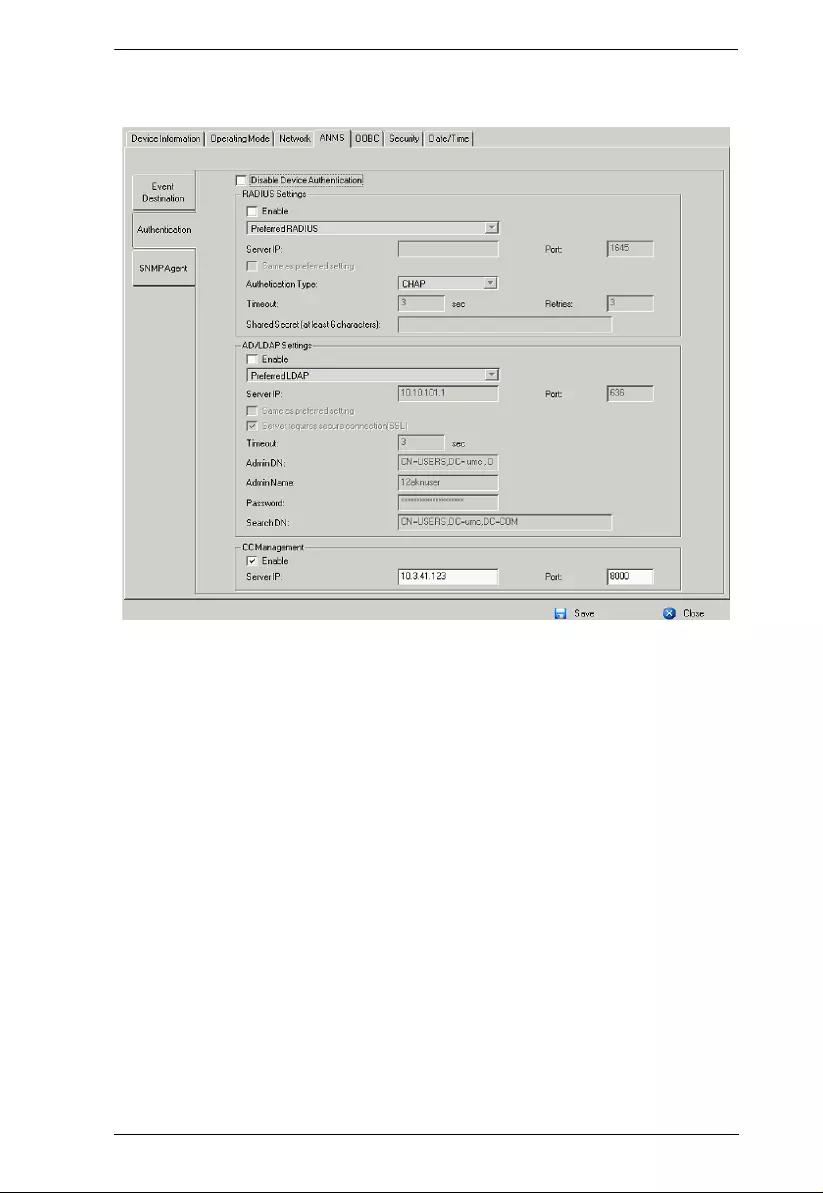
Chapter 8. Device Management
177
Authentication
Disable Local Authentication
Selecting this option disables login authentication on the KVM over IP
switch. The switch can only be accessed using LDAP, LDAPS, MS Active
Directory, RADIUS or CC Management authentication.
RADIUS Settings
To allow authentication and authorization for the KVM over IP switch
through a RADIUS server, do the following:
1. Check Enable.
2. Select Preferred or Alternate RADIUS server.
3. Fill in the IP addresses and service port numbers for the Preferred and
Alternate RADIUS servers. You can use the IPv4 address, the IPv6
address or the domain name in the IP fields.
4. Select the Authentication Type: PAP or CH AP.
5. In the Timeout field, set the time in seconds that the KVM over IP
switch waits for a RADIUS server reply befo re it times out.
6. In the Retries field, set the number of allowed RADIUS retries.

KVM over IP Switch User Manual
178
7. In th e Shared Secret field, key in the character string that you want to
use for authentication between the KVM over IP switch and the
RADIUS Server. A minimum of 6 characters is required.
8. On the RADIUS server, Users can be authenticated with any of the
following methods:
Set the entry for the user as su/xxxx
Where xxxx represents the Username given to the user when the
account was created on the KVM over IP switch.
Use the same Username on both the RADIUS server and the
KVM over IP switch.
Use the same Group name on both the RADIUS server and the
KVM over IP switch.
Use the same Username/Group name on both the RADIUS server
and the KVM over IP switch.
In each case, the user’s access rights are the ones assigned that were
assigned when the User of Group was created on the KVM over IP
switch. (See Adding Users, page 149.)
LDAP / LDAPS Authentication and Authorization Settings
To allow authentication and authorization for the KVM over IP switch via
LDAP / LDAPS, refer to the information in the table, below:
Item Action
Enable Put a check in the Enable checkbox to allow LDAP / LDAPS
authentication and authorization.
Type Click a radio button to specify whether to use LDAP or LDAPS.
LDAP Server IP
and Port Select Preferred or Alternate LDAP Server and fill in the IP
address and port number for the LDAP or LDAPS server.
You can use the IPv4 address, the IPv6 address or the
domain name in the LDAP Server field.
For LDAP, the default port number is 389; for LDAPS, the
default port number is 636.
Admin DN Consult the LDAP / LDAPS administrator to ascertain the
appropriate entry for this field. For example, the entry might
look like this:
ou=kn8132,dc=aten,dc=com
Admin Name Key in the LDAP administrator’s username.
Password Key in the LDAP administrator’s password.

Chapter 8. Device Management
179
Search DN Set the distinguished name of the search base. This is the
domain name where the search starts for user names.
Timeout Set the time in seconds that the KVM over IP switch waits for
an LDAP or LDAPS server reply before it times out.
Item Action

KVM over IP Switch User Manual
180
On the LDAP / LDAPS server, Users can be authenticated with any of the
following methods:
With MS Active Directory schema.
Without schema – Only the Usernames used on the KVM over IP switch
are matched to the names on the LDAP / LDAPS server. User privileges
are the same as the ones configured on the switch.
W ithout schema – Only Groups in AD are matched. User privileges are the
ones configured for the groups he belongs to on the sw itch.
Without schema – Usernames and Groups in AD are matched. User
privileges are the ones configured for the User and the Groups he belongs
to on the switch.
Note: For more information on configuring LDAP, you can download the
full LDAP instructional manual from our website.
CC Management Settings
To allow authorization for the KVM over IP switch through a CC (Control
Center) server, check Enable and fill in the CC Server’s IP address and Service
port in the appropriate fields. You can use the IPv4 address, the IPv6 address
or the domain name in the CC Server IP field.
Note: If this function is enabled, PO N devices do not appear in the Sidebar,
even if they are configured on the switch. This is because they are
managed via the CC server.
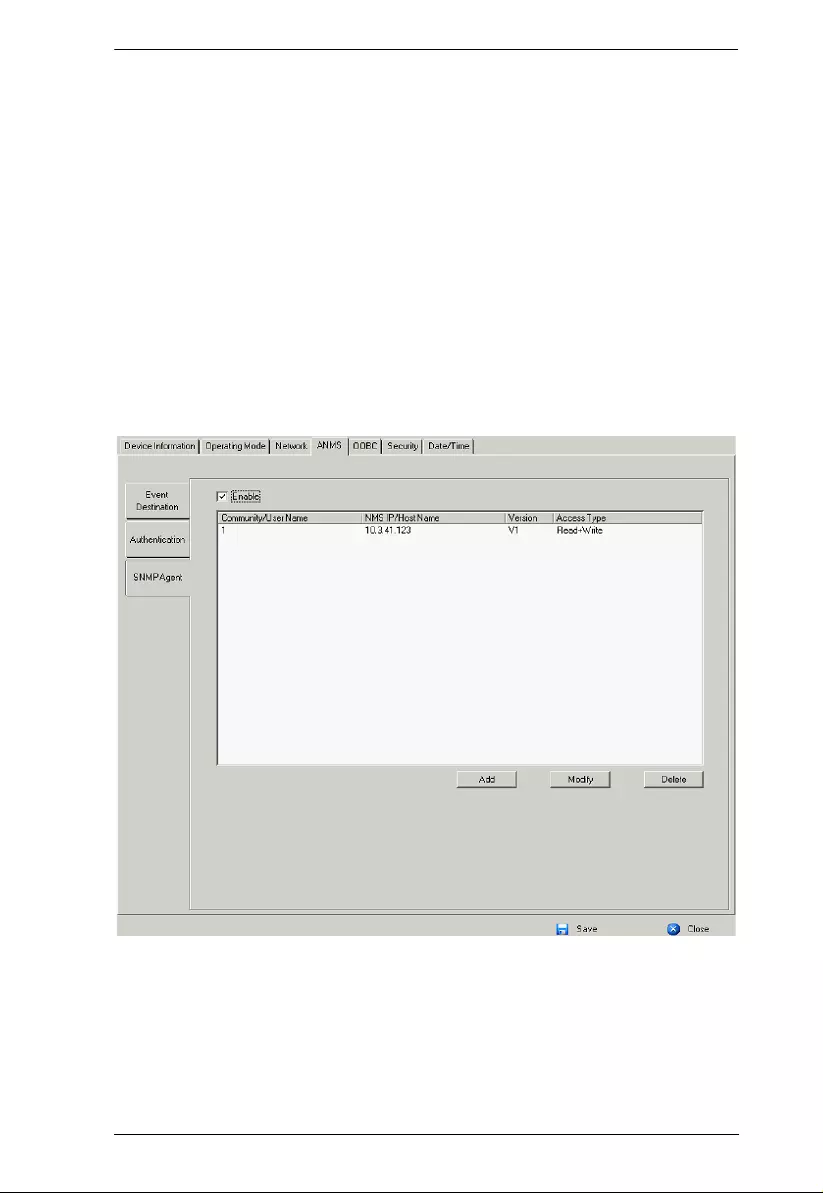
Chapter 8. Device Management
181
SNMP Agent
The SNMP Agent allows you to configure most Device Management settings
with a MIB browser using the MIB file downloaded from our website. The
MIB file imports into the MIB browser to configure the following Device
Management settings: Operating Mode: Mode, COM Settings; Network: IP
Installer, Service Ports, IPv4 Settings, IPv6 Settings; ANMS - Event
Destination: Log Server, SNMP Trap, Authentication: CC Management.
Download the KN MIB File on our website from any KN8 product page under
Support and Download.
To connect to the switch through an MIB browser, use the instruct ions below
to add an SNMP Agent to allow access from the computer you will use to
configure to the switch settin gs.
To add an SNMP Agent, do the following:
1. Check Enable.
2. Click Add. A window appears:

KVM over IP Switch User Manual
182
3. Select the Version.
4. Enter a Com munity Name.
5. Key in NMS IP/Host Name. Enter th e IP address of a computer that will
access the switch via a MIB browser.
6. Select the Access Type and click Save.
7. From a MIB browser, import the MIB file* and then enter the IP address
of the switch.
Note: Download the KN MIB File on our web site from any KN8 product
page, under Support and Download.
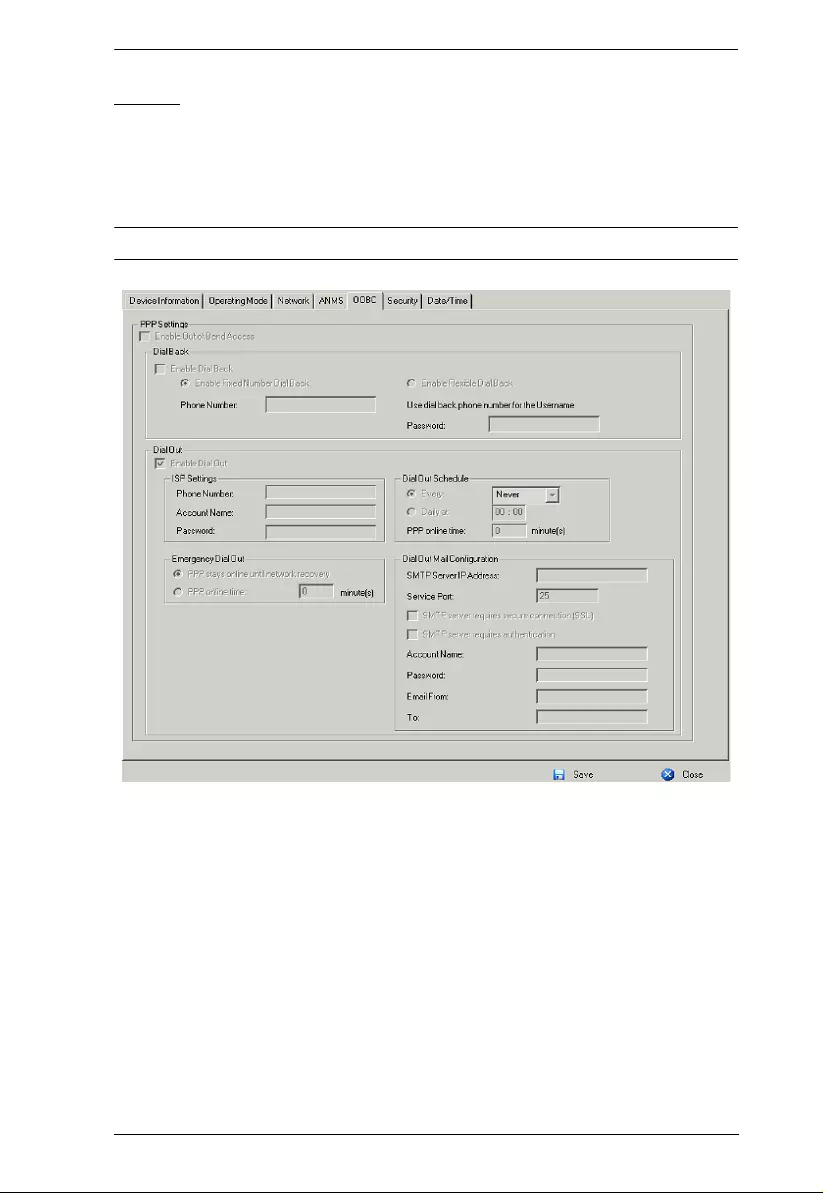
Chapter 8. Device Management
183
OOBC
In case the KVM over IP switch cannot be accessed with the usual LAN-based
methods, it can be accessed via the switch’s modem port. To enable support for
PPP (modem) operation, click to put a checkmark in the Enable Out of Band
Access checkbox.
Note: See PPP Modem Operation, page 274, for PPP setup and operation.
When you enable Out of Band Access, the Enable Dial Back, and Enable Dial
Out functions become available, as described in the sections that follow.

KVM over IP Switch User Manual
184
Enable Dial Back
As an added security feature, if this function is enabled, the switch disconnects
the calls that dial in to it, and dials back to one of the entries specified in the
table below:
Enable Dial Out
For the dial out function, you must establish an account with an Internet
Service Provider, and use a modem to dial up to your ISP account. An
explanation of the Enable Dial Out items is given in the table below:
Item Action
Enable Fixed
Number Dial
Back
If Fixed Number Dial Back is enabled, when there is an incoming call,
the KVM over IP switch hangs up the modem and dials back to the
modem whose phone number is specified in the Phone Number field.
Key the phone number of the modem that you want the KVM over IP
switch to dial back to in the Phone Number field.
Enable
Flexible Dial
Back
If Flexible Dial Back is enabled, the modem that the KVM over IP
switch dials back to doesn’t have to be fixed. It can dial back to any
modem that is convenient for the user, as follows:
1. Key the password that the users must specify in the Password field.
2. When connecting to the KVM over IP switch’s modem, users spec-
ify the phone number of the modem that they want the KVM over IP
switch to dial back to as their Username, and specify the password
set in the Password field for their password.
Item Action
ISP Settings Specify the telephone number, account n ame (username), and
password that you use to connect to your ISP.
Dial Out Schedule This entry sets up the times you want the KVM over IP switch to dial
out over the ISP connection.
Every provides a listing of fixed times from every hour to every
four hours.
If you select Every two hours (for example), the KVM over IP
switch will start dialing out every two hours beginning at
00:00.
If you don't want the KVM over IP switch to dial out on a fixed
schedule, select Never from the list.
Daily at will dial out once a day at a specified time. Use the hh:mm
format to specify the time.
PPP online time specifies how long you want the ISP connection
to last before terminating the session and hanging up the modem.
A setting of zero means it is always on line.

Chapter 8. Device Management
185
When you have finished making your settings on this page, click Save.
Emergency Dial
Out If the KVM over IP switch gets disconnected from the network, or the
network goes down, this function puts the switch on line via the ISP
dial up connection.
If you choose PPP stays online until network recovery, the PPP
connection to the ISP will last until the network comes back up or
the switch reconnects to it.
If you choose PPP online time, the connection to the ISP will
terminate after the amount of time that you specify is up. A setting
of zero means it is always on line.
Dial Out Mail
Configuration This section provides email notification of problems that occur on
the devices connected to the KVM over IP switch's ports (see SMTP
Settings, page 174).
Note: This email notification differs from the one configured under
SMTP Settings, page 174, in that it uses the ISP mail server rather
than the internal company’s mail server.
Key in the IPv4 address, IPv6 address, or domain name of your
SMTP server in the SMTP Server IP Address field.
Key in the email address of the person responsible for the SMTP
server (or some other equally responsible administrator), in the
Email From field.
Key in the email address (addresses) of where you want the
report sent to in the To field. If you are sending the report to more
than one email address, separate the addresses with a comma or
a semicolon.
If your server requires a secure SSL connection, put a check in
the SMTP server requires secure connection (SSL) checkbox
If your server requires authentication, put a check in the SMTP
server requires authentication checkbox, then key in the
appropriate account name and password in the fields, below.
Item Action

KVM over IP Switch User Manual
186
Security
The Security page is divided into 7 main panel s, as described in the sections
that follow.
Login Failures
For increased security, the Login Failures section allows administrators to set
policies governing what happens when a user fails to log in successfully.
To set the Login Failures policy, check the Enable checkbox (the default is for
Login Failures to be enabled). The meanings of the entries are explained in the
table below:
Note: If Login Failures is not enabled, users can attempt to log in an unlimited
number of times with no restrictions. For security purposes, we
recommend that you enable this function and enable the lockout
policies.
Entry Explanation
Allowed Sets the number of consecutive failed login attempts
that are permitted from a remote computer. The
default is 5 times.
Timeout Sets the amount of time a remote computer must
wait before attempting to login again after it has
exceeded the number of allowed failures. The
default is 3 minutes.
Lock Client PC If this is enabled, after the allowed number of failures
have been exceeded, the computer attempting to log
in is automatically locked out. No logins from that
computer will be accepted. The default is enabled.
Note: This function relates to the client computer’s
IP. If the IP is changed, the computer will no longer
be locked out.
Lock Account If this is enabled, after the allowed number of failures
have been exceeded, the user attempting to log in is
automatically locked out. No logins from the
username and password that have failed will be
accepted. The default is enabled.
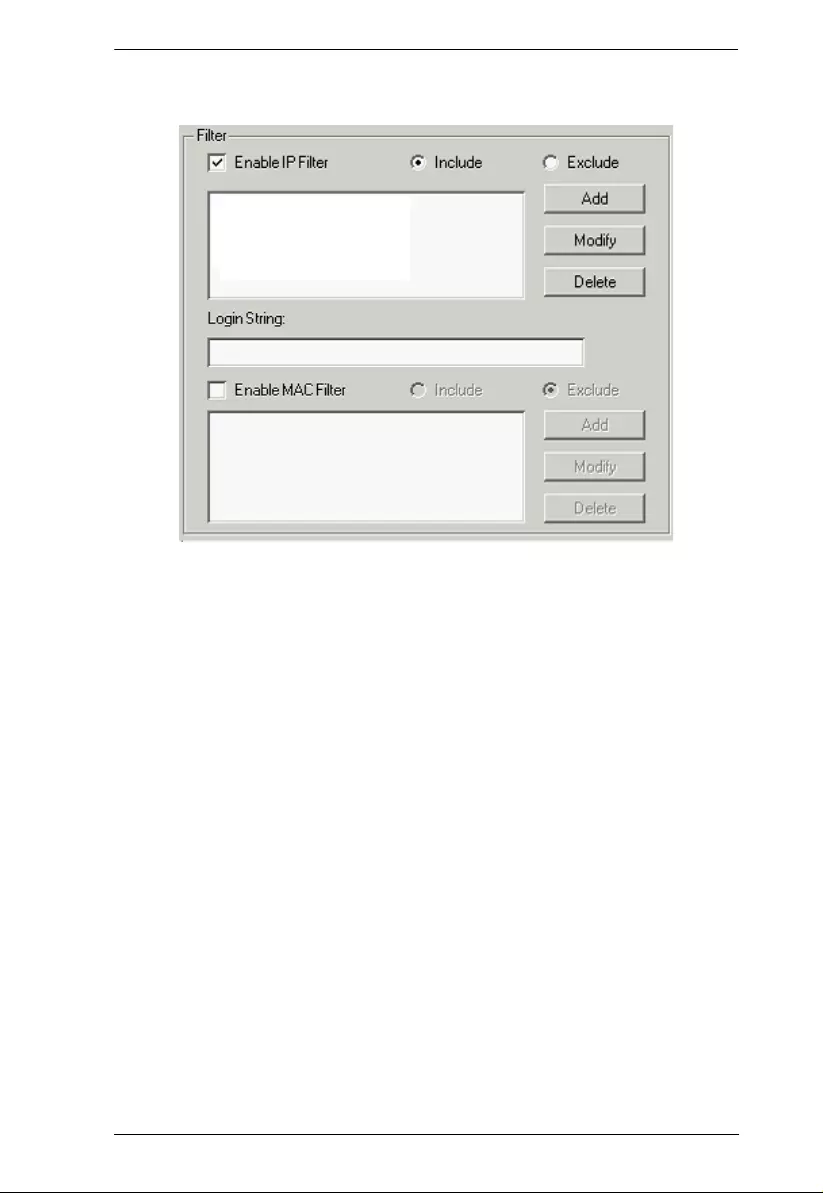
Chapter 8. Device Management
187
Filter
IP and MAC Filtering
IP and MAC Filters control access to the KVM over IP switch based on
the IP and/or MAC addresses of the client computers attempting to
connect. A maximum of 100 IP filters and 100 MAC filters are allowed. If
any filters have been configured, they appear in the IP Filter and/or MAC
Filter list boxes.
To enable IP and/or MAC filtering, Click to put a check mark in the IP
Filter Enable and/or MAC Filter Enable checkbox.
If the include button is checked, all the addresses within the filter range
are allowed access; all other addresses are denied access.
If the exclude button is checked, all the addresses within the filter
range are denied access; all other addresses are allowed access.
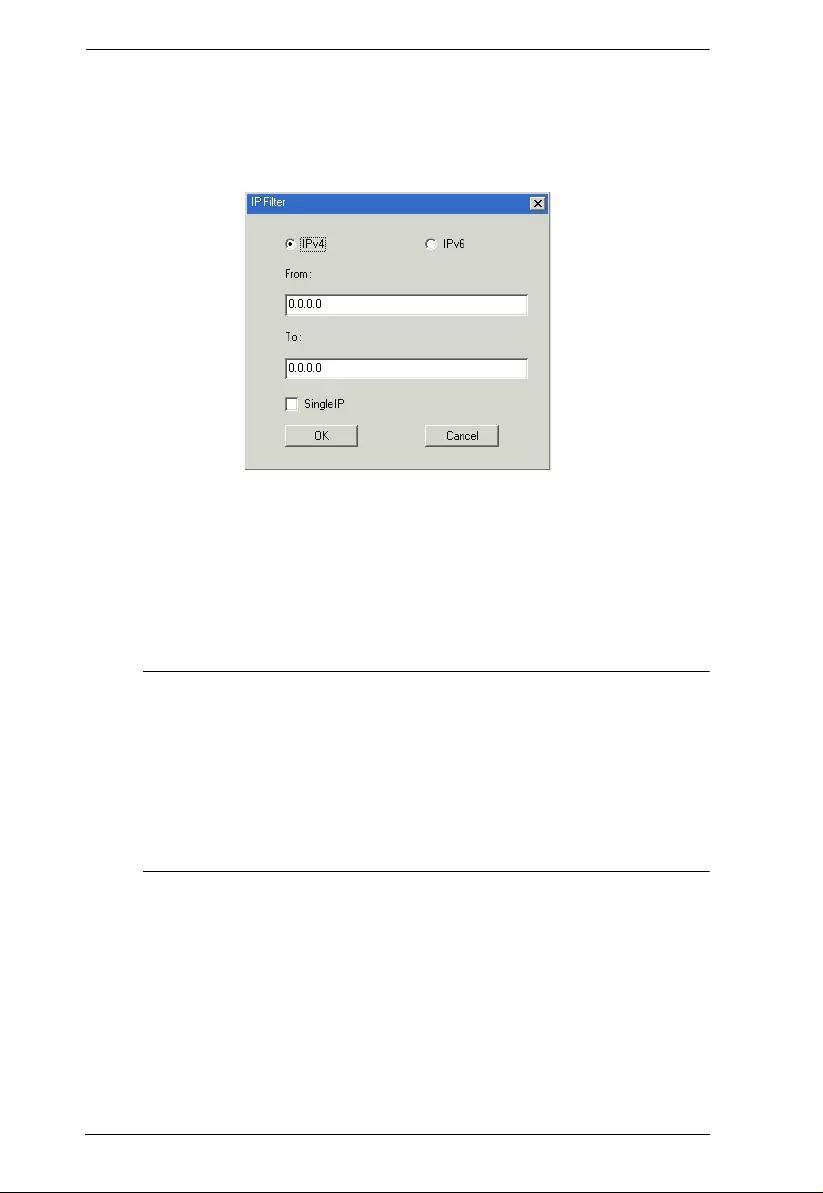
KVM over IP Switch User Manual
188
Adding Filters
To add an IP filter, do the following:
1. Click Add. A dialog box similar to the one below appears:
2. Specify whether you are filtering an IPv4 or IPv6 address.
3. Key the add ress you want to fil ter in the From: field.
To filter a single IP address, click to put a check in the Single IP
checkbox.
To filter a continuous range of addresses, key in the end number of
the range in the To: field.
Note: This description is for the AP GUI. The Browser GUI dif fers as
follows:
1. It doesn’t offer an IPv4 or IPv6 choice. It only has From and
To fields for IPv4 filtering.
2. It doesn’t have a checkbox to specify a single IP address. To
filter a single IPv4 address, key the same address in both the
From and To fields.
4. Aft er filling in the address, click OK.
5. Repeat these steps for any additional IP addresses you want to filter.

Chapter 8. Device Management
189
To add a MAC filter, do the following:
1. Click Add. A dialog box similar to the one below appears:
2. Specify the MAC address in the dialog box, then click OK.
3. Repeat these steps for any additional MAC addresses you want to filter.
IP Filter / MAC Filter Conflict
If there is a conflict between an IP filter and a MAC filter – in other words,
if a computer’s address is allowed by one filter but block ed by the other –
then the blocking filter takes precedence (the computer’s access is
blocked).
Modifying Filters
To modify a filter, select it in the IP Filter or MAC Filter list boxes and
click Modify. The Modify dialog box is similar to the Add dialog box.
When it comes up, simply delete the old address(es) and replace it with the
new one(s).
Deleting Filters
To delete a filter, select it in the IP Filter or MAC Filter list box and click
Delete.

KVM over IP Switch User Manual
190
Login String
The Logi n String entry field lets the super administrator specify a login string
(in addition to the IP address) that users must add to the IP address when they
access the KVM over IP switch with a browser.
For example, if 192.168.0.126 were the IP address, and abcdefg were the login
string, then the user would have to key in:
192.168.0.126/abcdefg
Note: 1. Users must place a forward slash between the IP address and the
string.
2. If no login string is specified here, anyone will be able to access the
KVM over IP switch login page using the IP address alone. This
makes your installation less secure.
The following characters are allowed in the string:
0–9 a–z A–Z ~ ! @ $ & * ( ) _ - = + [ ] .
The following characters are not allowed:
% ^ ” : / ? # \ ‘ { } ; ’ < > [Space]
Compound characters (É Ç ñ ... etc.)
For security purposes, we recommend that you change this string occasionally.
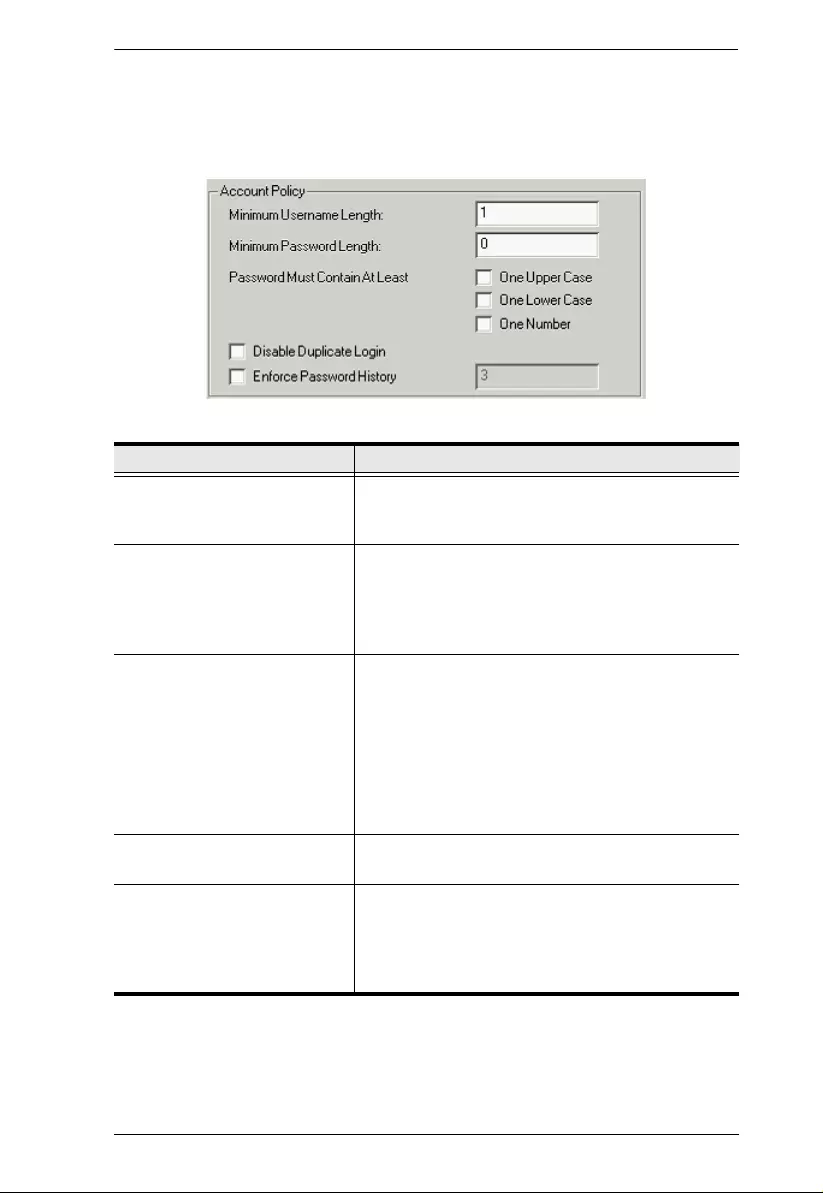
Chapter 8. Device Management
191
Account Policy
In the Account Policy section, system administrators can set policies governing
usernames and passwords.
The meanings of the Account Policy entries are explained in the tab le below:
Entry Explanation
Minimum Username Length Sets the minimum number of characters required for
a username. Acceptable values are from 1–16. The
default is 6.
Minimum Password Length Sets the minimum number of characters required for
a password. Acceptable values are from 0–16. A
setting of 0 means that no password is required.
Users can login with only a Username. The default is
6.
Password Must Contain At
Least Checking any of these items requires users to
include at least one uppercase letter, one lowercase
letter or one number in their password.
Note: This policy only affects user accounts created
after this policy has been enabled, and password
changes to existing user accounts. Users accounts
created before this policy was enabled, and there is
no change to the existing passwords, are not
affected.
Disable Duplicate Login Check this to prevent users from logging in with the
same account at the same time.
Enforce Password History This prevents users from using the same password
when they are required to recreate their password.
Enter the number of password changes that must
occur before a previous password can be used a
second time.

KVM over IP Switch User Manual
192
Encryption
These flexible encryptio n alternatives for keyboard/mouse, video, and virtual
media data let you choose any combination of DES; 3DES; AES; RC4; or a
Random cycle of any or all of them.
Enabling encryption affects system performance – no encryption offers the
best performance; the greater the encryption the greater the adverse effect. If
you enable encryption, the performance considerations are as follows:
RC4 offers the least impact on performance; DES is next; then 3DES or
AES
The RC4 + DES combination offers the least impact of any combination
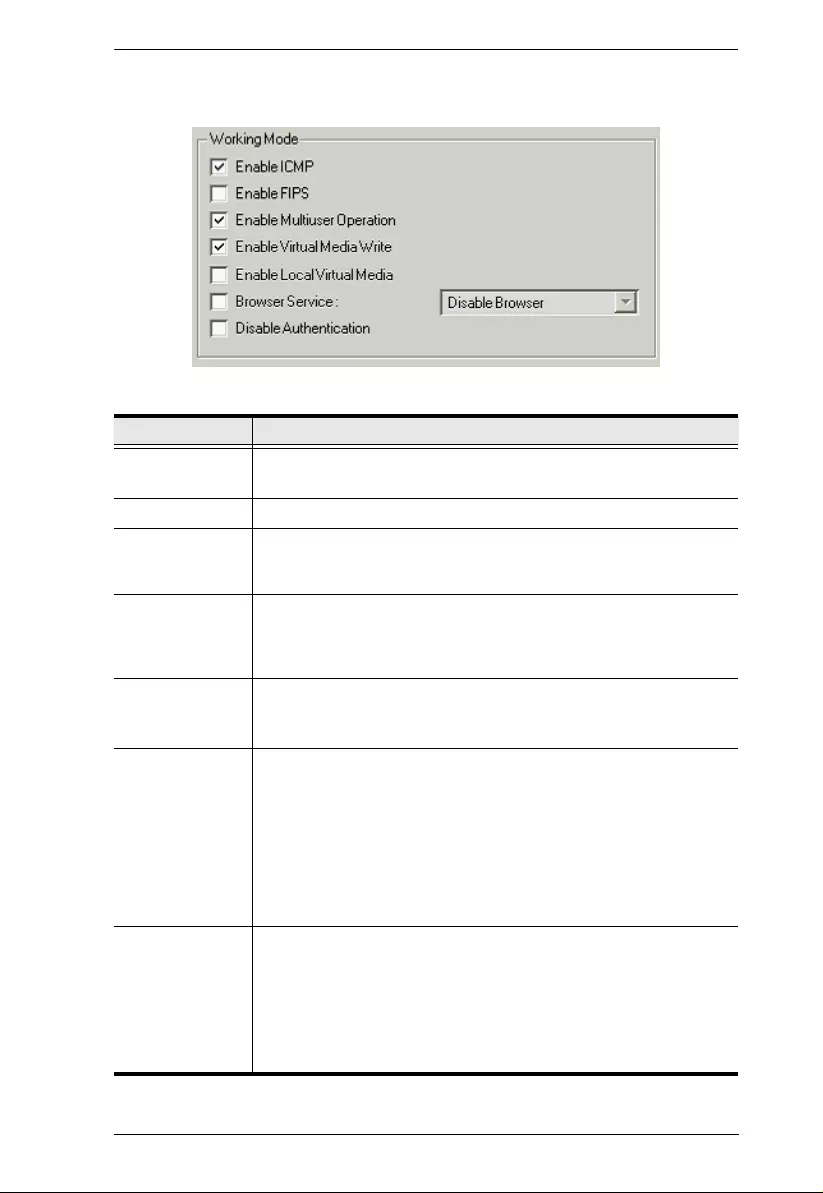
Chapter 8. Device Management
193
Mode
An explanation of the Mode items is given in the table, below:
Item Explanation
Enable ICMP If ICMP is enabled, the KVM over IP switch can be pinged. If it is
not enabled, the device cannot be pinged. The default is Enabled.
Enable FIPS Enables the FIPS security standard.
Enable Multiuser
Operation Enabling Multiuser operation permits up to 32 users to log in at the
same time to share the remote bus. If not enabled, only one user
can log in at a time. The default is Enabled.
Enable Virtual
Media Write
Operation
Enabling Virtual Media Write Operation allows redirected virtual
media devices on a user’s system to send data to a remote server ,
as well as being able to have data from the remote server written to
them.
Enable Local
Virtual Media Enabling Local Virtual Media allows USB storage peripherals (CD/
DVD, HD, flash drives, etc.) connected to the KVM over IP switch
to appear and act as if it were installed on a remote system.
Browser Service Enabling Browser Service allows the administrator to restrict
browser access to the KVM over IP switch. After checking Browser
Service, drop down the listbox to select the degree of restriction:
Disable Browser: means no browser access is permitted.
Disable HTTP: means browser access is permitted, but users
must access the switch with an HTTPS URL.
Disable HTTPS: means browser access is permitted, but users
must access the switch with an HTTP URL.
Disable
Authentication If Disable Authentication is checked, no authentication procedures
are used to check users attempting to log in. Users gain
Administrator access to the KVM over IP switch simply by entering
combination of username and password.
Note: Enabling this setting creates an extremely dangerous result
as far as security goes, and should only be used under very special
circumstances.

KVM over IP Switch User Manual
194
Private Certificate
When logging in over a secure (SSL) connection, a signed certificate is used to
verify that the user is logging in to the intended site. For enhanced security, the
Private Certificate section allows you to use your own private encryption key
and signed certificate, rather than the default ATEN certificate.
There are two methods for establishing your private certificate: generating a
self-signed certificate; and importing a third-party certificate authority (CA)
signed certificate.
Generating a Self-Signed Certificate
If you wish to create your own self-signed certificate, a free utility –
openssl.exe – is available for download over the web. See Self-Signed
Private Certificates, page 289 for details about using OpenSSL to generate
your own private key and SSL certificate.
Obtaining a CA Signed SSL Server Certificate
For the greatest security, we recommend using a third party certificate
authority (CA) signed certificate. To obtain a third party signed certificate,
go to a CA (Certificate Authority) website to apply for an SSL certificate.
After the CA sends you the certificate and private encryption key, save
them to a convenient location on your computer.
Importing the Private Certificate
To import the private certificate, do the following:
1. Click Browse to the right of Private Key; browse to where your private
encryption key file is located; and select it.
2. Click Browse to the right of Certificate; browse to wh ere you r
certificate file is located; and select it.
3. Click Upload to complete the procedure.
Note: 1. Clicking Restore Default returns the device to using the default
ATEN certificate.
2. Both the private encryption key and the signed certificate must be
imported at the same time.
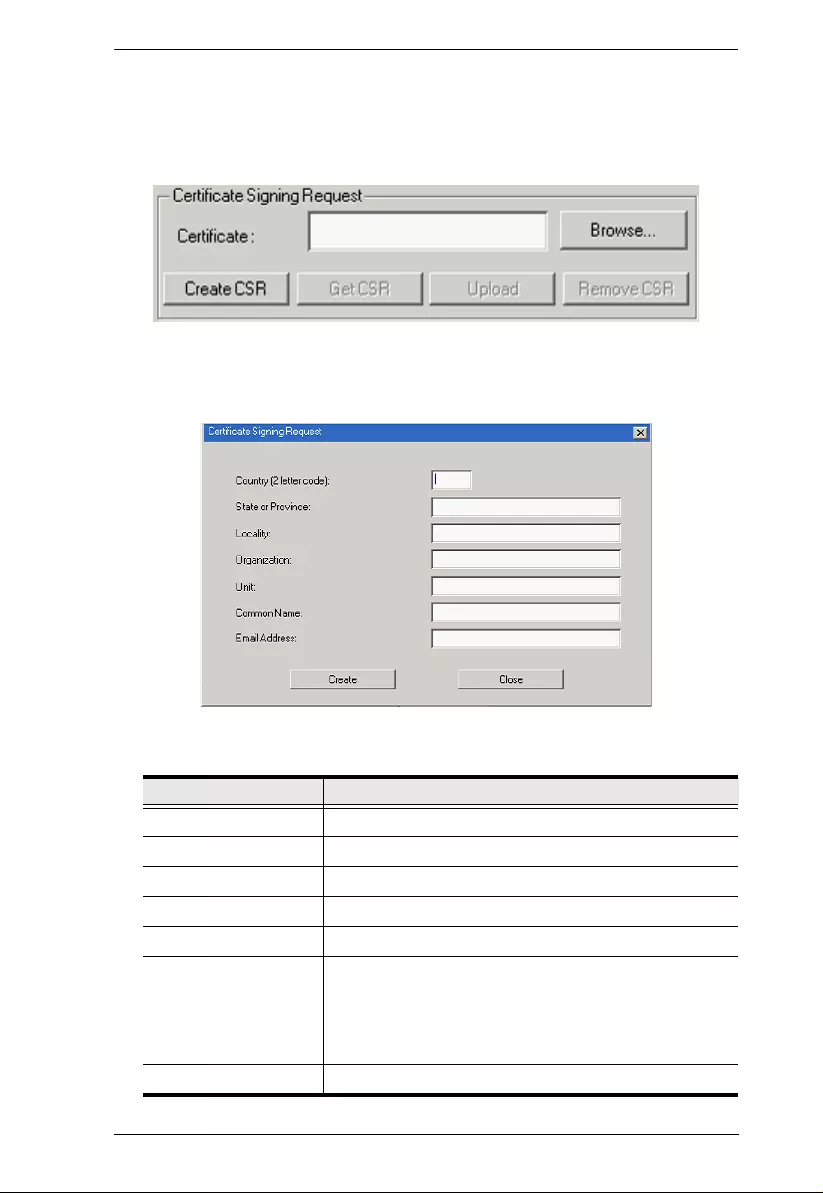
Chapter 8. Device Management
195
Certificate Signing Request
The Certificate Signing Request (CSR) section provides an automated way of
obtaining and installing a CA signed SSL server certificate.
To perform this operati on do the following:
1. Click Create CSR. The following dialog box appears:
2. Fill in the form – with entries that are valid for your site – according to the
example information in the following table:
Information Example
Country (2 letter code) TW
State or Province Taiwan
Locality Taipei
Organization Your Company, Ltd.
Unit Techdoc Department
Common Name mycompany.com
Note: This must be the exact domain name of the site
that you want the certificate to be valid for. If the site’s
domain name is www.mycompany.com, and you only
specify mycompany.com, the certificate will not be valid.
Email Address administrator@yourcompany.com

KVM over IP Switch User Manual
196
3. After fi lling in the form (all fields are requi red), click Create.
A self-signed certificate based on the information you just provided is now
stored on the KVM over IP switch.
4. Click Get CSR, and save the certificate file (csr.cer) to a convenient
location on your computer
This is the file that you give to the third party CA to apply for their signed
SSL certificate.
5. After the CA sends you the certi ficat e, save it to a conven ient locatio n on
your computer. Click Browse to locate the file; then click Upload to store
it on the KVM over IP switch.
Note: When you upload the file, the KVM over IP switch checks th e file
to make sure the specified information still matches. If it does, the
file is accepted; if not, it is rejected.
If you want to remove the certificate (to replace it with a new one because of a
domain name change, for example), simply click Remove CSR.
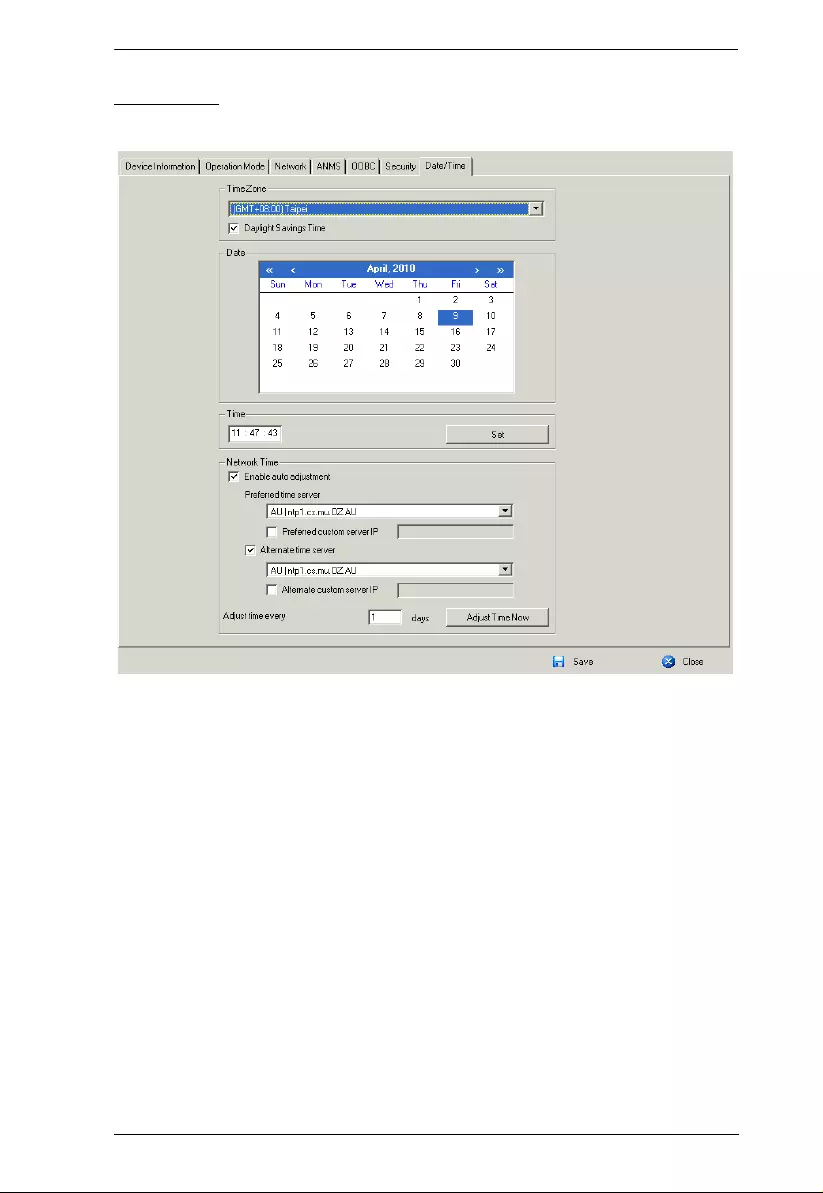
Chapter 8. Device Management
197
Date/Time
The Date/Time dialog page sets the KVM over IP switch time parameters:
Set the parameters according to the information below.
Time Zone
To establish the time zone that the KVM over IP switch is located in, drop
down the Time Zone list and choose the city that most closely corresponds
to where it is at.
If your country or region employs Daylight Saving Time (Summer Time),
check the corresponding checkbox.

KVM over IP Switch User Manual
198
Date
Select the month from the drop down listbox.
Click < or > to move backward or forward by one year increments.
In the calendar, click on the day.
To set the time, use the 24 hour HH:MM:SS format.
Click Set to save your settings.
Network Time
To have the time automatically synchronized to a network time server, do the
following:
1. Check the Enable auto adjustment checkbox.
2. Drop down the time server list to select your preferred time server
– or –
Check the Preferred custom server IP checkbox, and key in either the IPv4
address, IPv6 address, or domain name of the time server of your choice.
3. If you want to configure an alternate time server, check the Alternate time
server checkbox, and repeat step 2 for the alternate time server entries.
4. Key in your choice for the number of days between synchronization
procedures.
5. If you want to synchronize immediately, click Adjust Time Now.
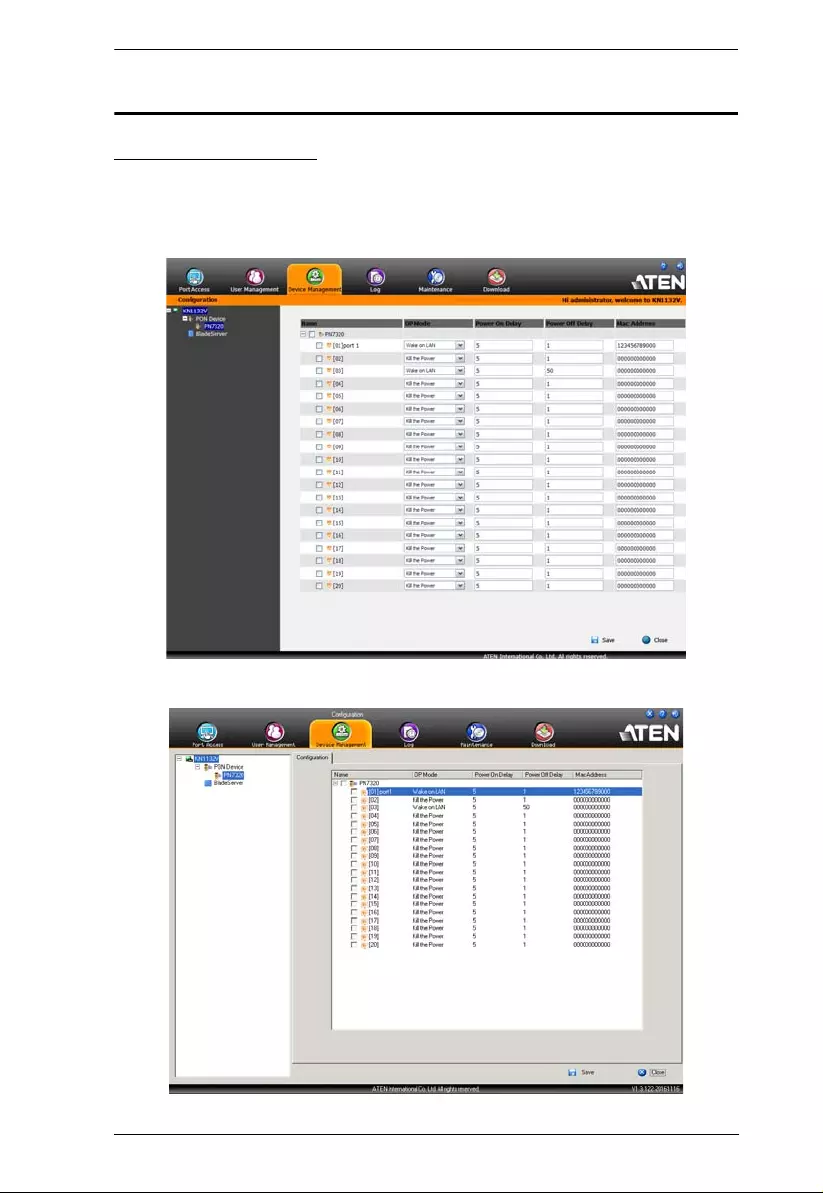
Chapter 8. Device Management
199
PON Devices
Configuration Page
When a PON device is selected in the Sidebar, its Configuration page comes
up:
Browser GUI
AP GUI

KVM over IP Switch User Manual
200
Outlet Configuration
The outlet configuration setting s that can be made on th is page are the same
ones described under Power Management, in the table on page 141.
Click on a setting to drop down the list of cho ices.
To give more than one outlet the same setting at the same time, click to put
a check mark in front of the outlets you want to configure. When you
change the setting for any one of the outlets, each of the selected outlets
will get the new setting.
To change the setting for all of the outlets at the same time, click to put a
check mark in front of the PON’s name. All of the outlets are selected.
When you change the setting for any one of the outlets, all of the outlets
will get the new setting.
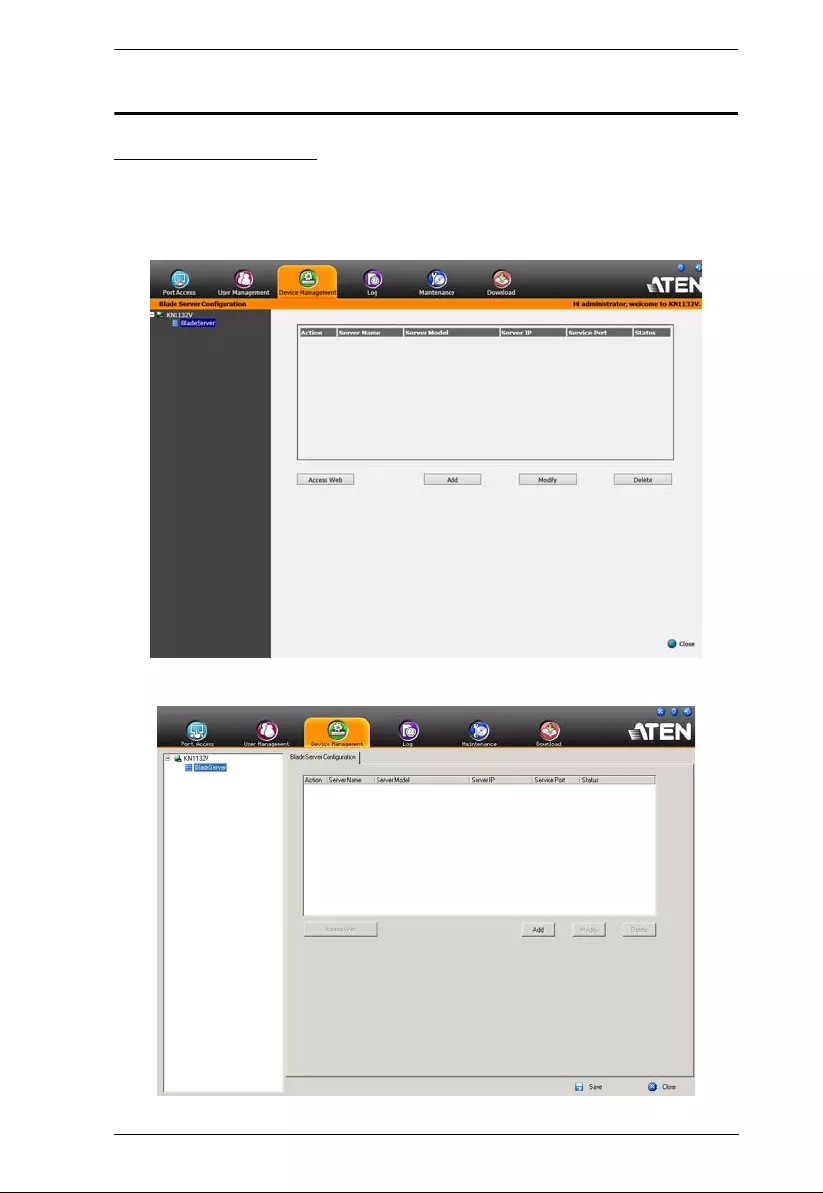
Chapter 8. Device Management
201
Blade Servers
Configuration Page
For Super Administrators, wh en a Blade Server is selected in the Sidebar, its
Configuration page comes up:
Browser GUI
AP GUI
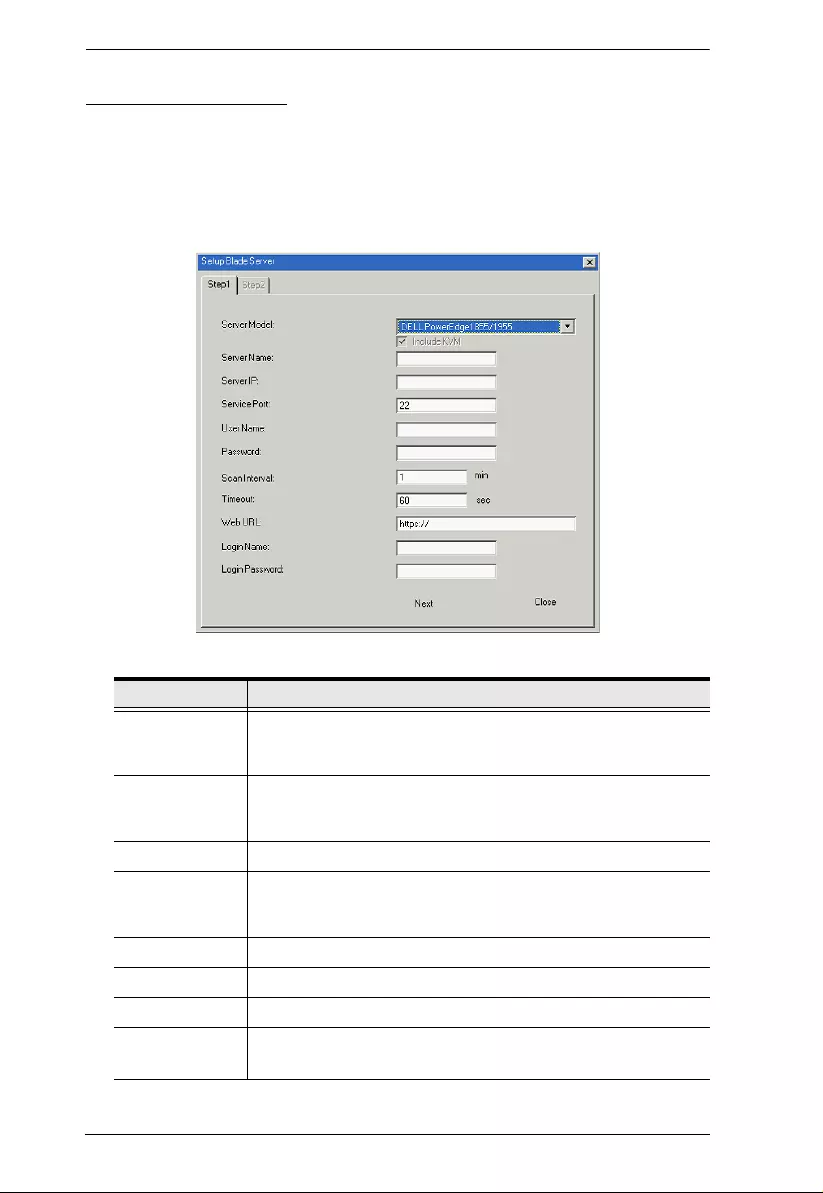
KVM over IP Switch User Manual
202
Blade Server Setup
Adding a Blade Server
To configure a new Blade server, do the following:
1. Select its icon in the Sidebar, then click Add in the main panel. The Setup
Blade Server dialog box comes up, with the Step 1 tab displayed:
2. Fill in the fields according to the information provided in the table, below:
Field Explanation
Server Model Drop down the list to select the blade server chassis model. If
your model isn’t included in the list of supported servers, contact
your dealer for help.
Include KVM This item is for information purposes and can’t be edited. If the
server supports a KVM function, this box is checked. Otherwise,
it is unchecked.
Server Name For convenience, you can give the server a name.
Server IP Key in the server’s IP address (IPv4, IPv6, or domain name)
used to access the server via a serial connection (Telnet or
SSH)
Service Port Key in the port number used for serial access.
User Name Key in the username required for serial access authentication.
Password Key in the password required for serial access authentication.
Scan Interval The interval between times that the KVM over IP switch scans
the server for information.

Chapter 8. Device Management
203
3. When you have finished confi guring the fields, click Next to bring up the
dialog box with the Step 2 tab displayed.
4. The Step 2 dialog presents a summary of the blade server’s configuration,
including the numb er of blades installed. Click Save to add the blades
server to the installation.
Modifying / Deleting a Blade Server
To modify a blade server’s configuration, first select it in the Sidebar , then
click Modify. Make your changes on the Setup Blade Server dialog box.
To remove a blade server, first select it in the Sid e bar, then click Delete.
Web Access
To access the blade server’s Web page, first select it in the Sidebar, then click
Access Web.
Timeout The amount of time that the KVM over IP switch waits for a
response from the server before it stops scanning for
information.
Web URL Key in the server’s IP address (IPv4, IPv6, or domain name)
used to access the server via a browser.
Login Name Key in the username required for browser authentication.
Login Password Key in the password required for browser authentication.
Field Explanation
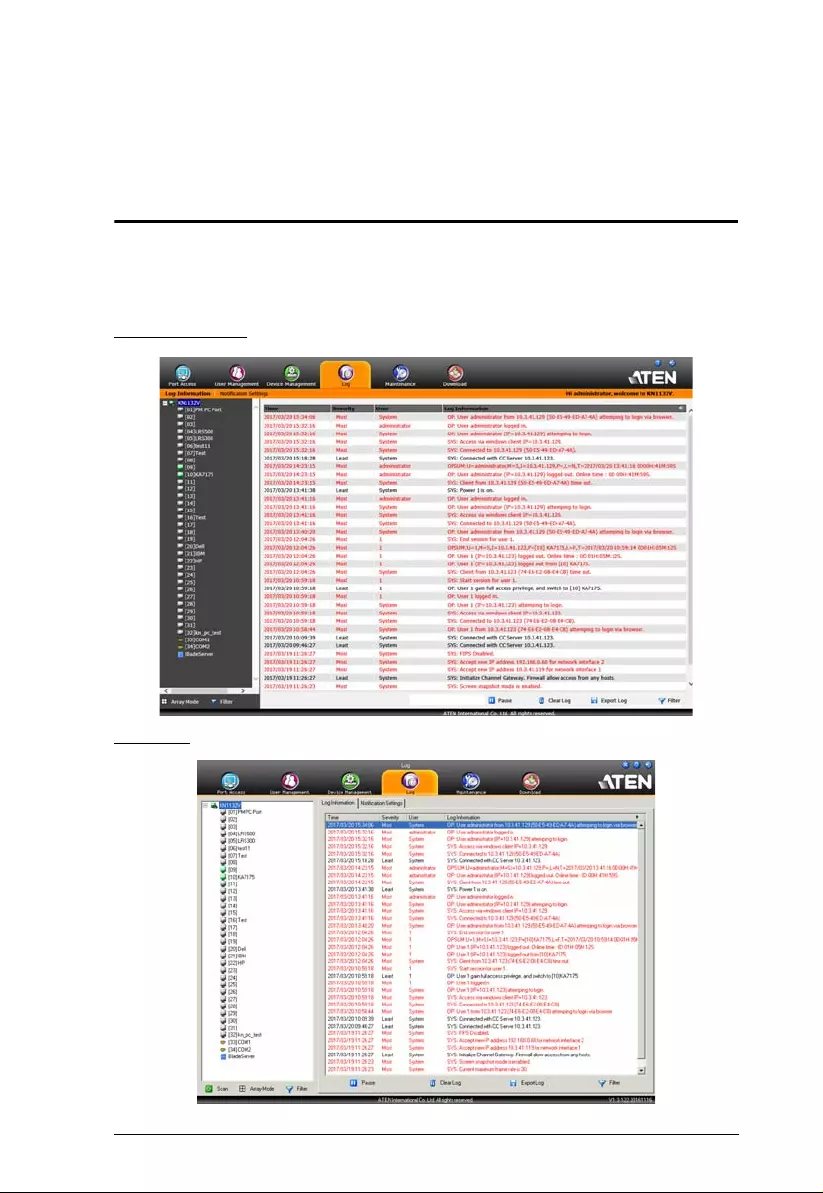
204
Chapter 9
Log
Overview
The KVM over IP switch logs all the events that take place on it. To view the
contents of the log, click the Log tab. The device’s Log Informatio n page,
similar to the one below, app ears:
Browser GUI
AP GUI
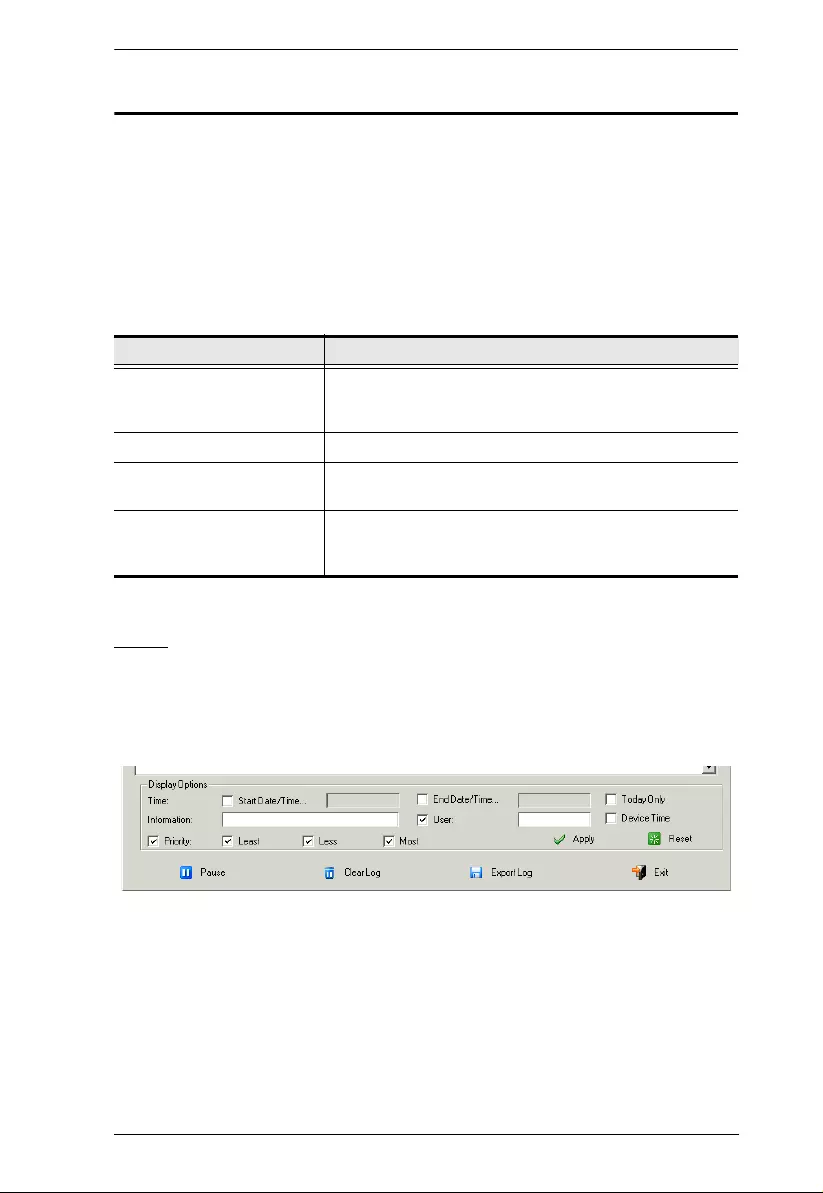
Chapter 9. Log
205
Log Information
The Log Information page displays events that take place on the KVM over IP
switch, and provides a breakdown of the time, the severity, the user, and a
description of each one. You can change the sort order of the display by
clicking on the column headings.
The log file tracks a maximum of 512 events. When the limit is reached, the
oldest events get discarded as new events come in. The purpose of the buttons
at the bottom of the page are described in the following table:
Filter
Filter lets you narrow the log event di splay to ones that occurred at specific
times; ones containing specifi c w ords or strings; or ones involving specific
users. When you access this function, the log filter dialog box appears at the
bottom of the page:
Button Explanation
Pause Clicking Pause stops the display of new events. When
the display is paused the button changes to Resume.
Click Resume to start displaying events again.
Clear Log Clicking Clear Log clears the log file.
Export Log Clicking Export Log lets you save the contents of the log
to a file on your computer.
Filter Clicking Filter allows you to search for particular events
by date or by specific words or strings, as described in
the next section.

KVM over IP Switch User Manual
206
A description of the filter items is giv e n in the table, below:
Item Description
Time This feature lets you filter for events that occurred at specific times,
as follows:
Today Only: Only the events for the current day are displayed.
Device Time: Shows the events according to the time configured on
the switch.
Start Date/Time: Filters for events from a specific date and time to
the present. Put a check in the checkbox to bring up a calendar. Set
the date and time that you want the filtering to start from. All events
from the Start date/time to the present are displayed.
For the Web Browser interface, after checking Start Date/Time, you
have to click inside the text box in order to bring up the calendar.
When you have made your calendar choices, click the A icon at the
lower right of the calendar panel.
End Date/Time: Filters for events from a specific date and time to a
specific date and time. First select the Start Date/Time (described
above); check End Date/Time to set the ending date and time.
For the Web Browser interface, after checking End Date/Time, you
have to click inside the text box in order to bring up the calendar.
When you have made your calendar choices, click the A icon at the
lower right of the calendar panel.
Information Filters for a particular word or string. Key the word or string into the
Information text box. Only events containing that word or string are
displayed. Wildcards (? for single characters; * for multiple
characters) and the keyword or are supported. E.g., h*ds would
return hands and hoods; h?nd would return hand and hind, but not
hard; h*ds or h*ks would return hands and hooks.
User Filters for specific users. First put a check in the User checkbox;
then key in the user’s Username; then click Apply. Only events
containing that Username are displayed.
Note: If the User checkbox is not checked here in the Filter panel,
the entire User column does not appear in the main panel.
Severity Filters based on the severity rating of the event. Least events
appear in black; Less events appear in blue; Most events appear in
red.
First put a check in the Severity checkbox; then check the severity
options you want to filter for (you can check more than one item).
Only events that match the severity ratings you specified appear in
the display.
Note: If the Severity checkbox is not checked here in the Filter
panel, the entire Severity column does not appear in the main panel.
Apply Click to apply the filter choices.
Reset Click this button to clear the entries in the dialog box and start with a
clean slate.
Exit Click this button to exit the log filter function.
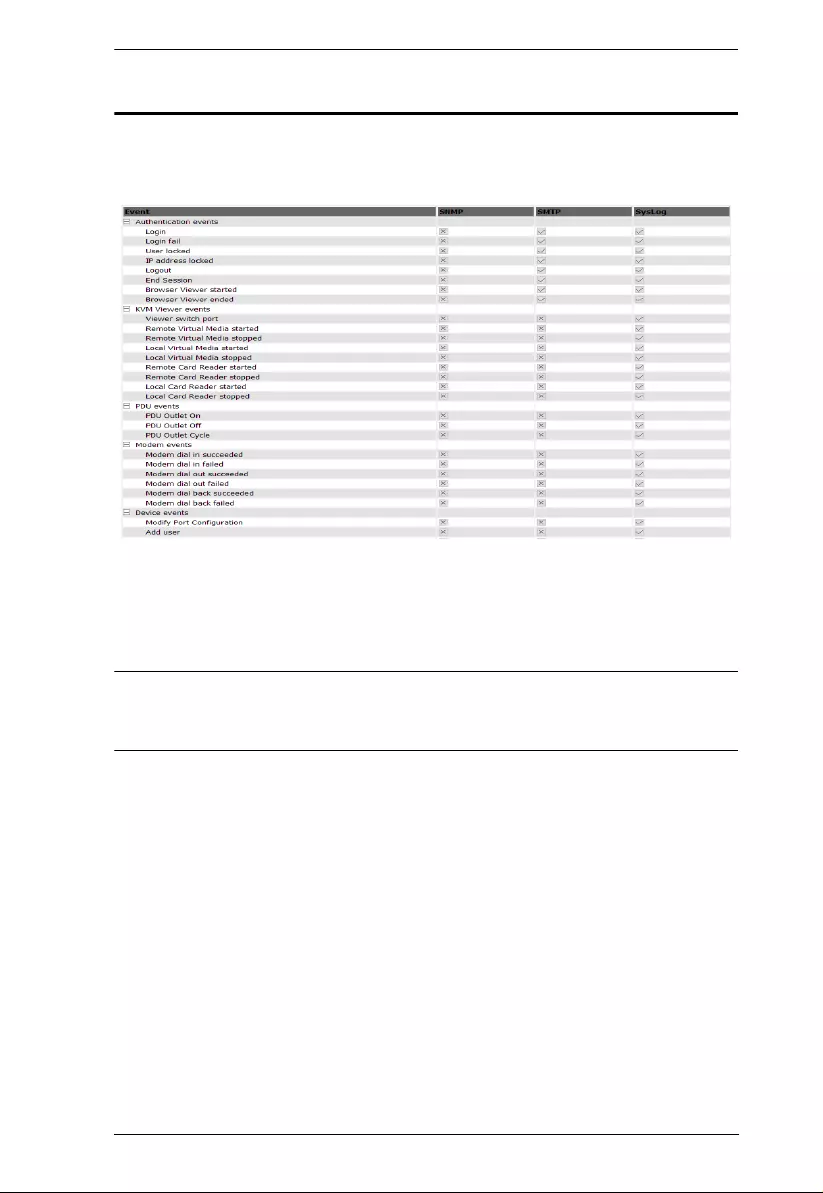
Chapter 9. Log
207
Log Notification Settings
The Notification Settings page lets you decide whi ch events trigger a
notification, and how the notificatio n are sent out:
Notifications can be sent via SNMP trap, SMTP email, written to the SysLog
file, or any combination of the three. A check mark ( ) indicates that
notification of the event is enab led for the method specified in the colu mn
heading; an X indicates that notification is not enabled.
Note: In any of the columns, you can use Shift-Click or Ctrl-Click to select a
group of events. Clicking to enable/disable any one of them causes all
of them to change in unison.
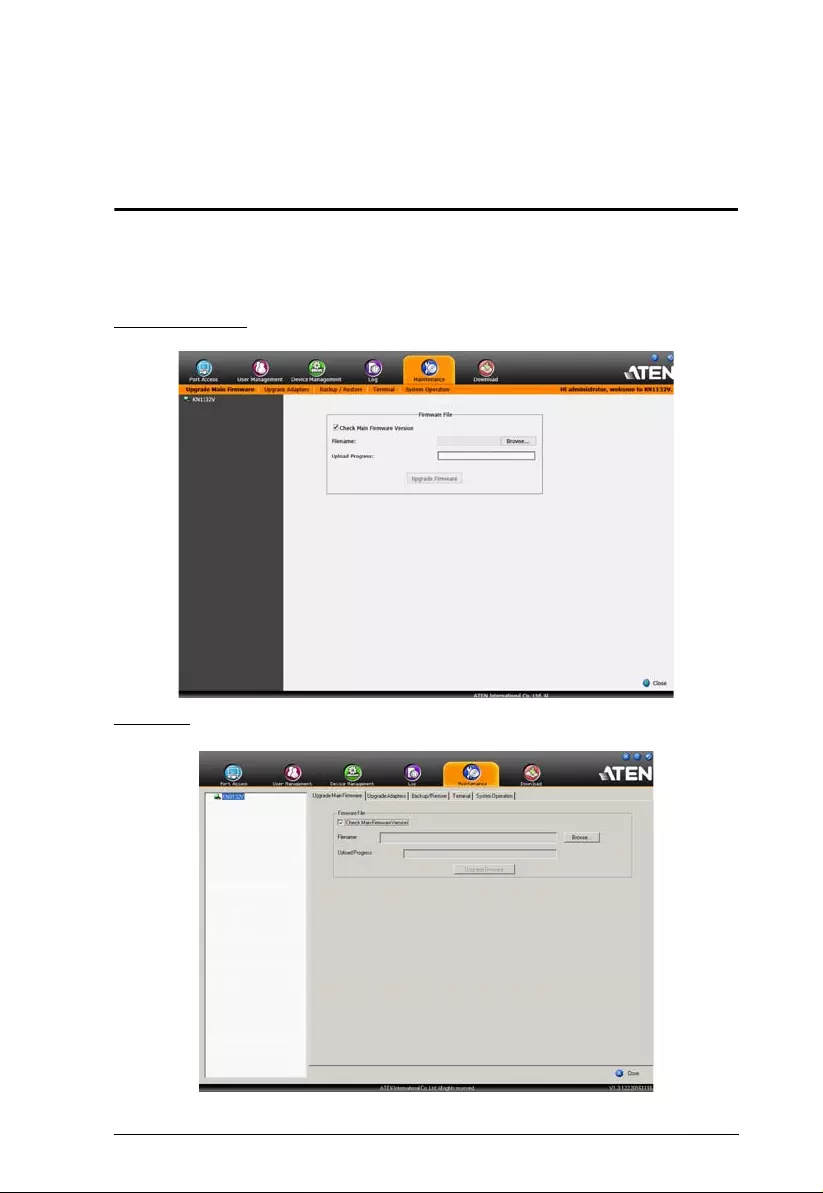
208
Chapter 10
Maintenance
Overview
The Maintenance function is used to upgrade firmware; backup and restore
configuration and account information; ping network devices; and restore
default values.
Browser GUI
AP GUI

Chapter 10. Maintenance
209
Main Firmware Upgrade
In addition to upgrading the KVM over IP switch’s m ain fi rm ware, this
function can also be used to upgrade any PON uni ts and Blade Servers
deployed on the installation. As new versions of the firmware become
available, they can be downloaded from our website. Check the website
regularly to find the latest information and packag es.
To upgrade the main firmware, do the follo wing:
1. Download the new firmware file (switch, PON or blade server module), to
your computer.
2. Log in to the KVM over IP switch; and click the Maintenance tab. The
Maintenance tab opens to the Upgrade Main Firmware pag e:
3. Click Browse; navigate to the directory that the new firmware file is in
and select the file.
4. Click Upgrade Firmware to start the upgrade procedure.
If you enabled Check Main Firmware Version th e curren t fir m ware
level is compared with that of the upgrade file. If the current version is
equal to or higher than the upgrade version, a popup message appears,
to inform you of the situation and stops the upgrade procedure.
If you didn't enable Check Main Firmware Version, the upgrade file is
installed without checking wh at its level is.
As the upgrade proceeds, progress information is shown in the
Progress bar.
Once the upgrade completes successfully, the switch resets itself.
5. Log in again, and check the firmware versi on to be sure it is the new one.
Note: To recover from a “failed upgrade” situation, see Firmware Upgrade
Recovery, page 210.

KVM over IP Switch User Manual
210
Firmware Upgrade Recovery
Should the switch’s main firmware upgrade procedure fail, and the switch
becomes unusable, the following firm ware upgrade recovery procedure will
resolve the problem:
1. Power off the switch.
2. Press and hold the Reset Switch in (see Reset Switch, page 13).
3. While holding the Reset Switch in, power the switch back on.
This causes the switch to use the original factory installed main firmware
version. Once the switch is operational, you can try upgrading the main
firmware again by logging on to the KVM over IP switch via web browser (see
Main Firmware Upgrade, page 209).
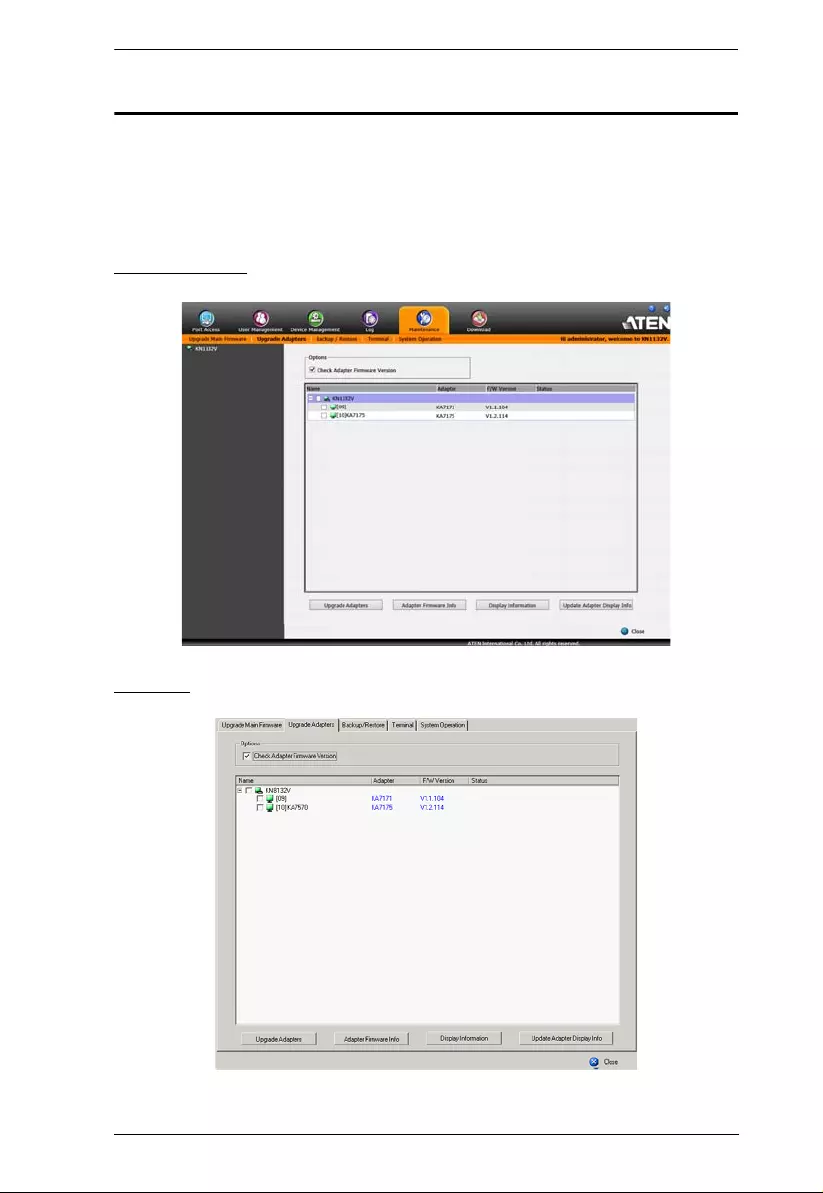
Chapter 10. Maintenance
211
Upgrade Adapters
The Upgrade Adapters page al lows you to view and update KVM adapter
firmware and display information. This section refers to the KVM adapter
cables that provide the EDID display information to the connected server,
which allow its video to be displayed on the local console monitor.
Browser GUI
AP GUI

KVM over IP Switch User Manual
212
Upgrade Adapters
The Upgrade Adapters button is used to upgrade the firmware of the KVM
Adapter Cables.
To perform the upgrades, do the following:
1. Click the Maintenance tab; select the Upgrade Adapters menu item.
2. Click Adapter Firmware Info to bring up a list of the adapter firmware
versions that are stored in the main firmware. If you upgraded the main
firmware, it may contain newer versions of the adapter firmware than the
versions currently on the adapters.
3. Compare the adapter firmware versions stored in the main firmware with
the versions listed in the F/W Version column of the Main Panel. If the
versions stored in the firmware are newer than the ones on the adapters,
you will probably want to perform the adapter upgrade.
4. In the Name column of the Main Panel, check the ports whose Adapters
you want to upgrade.
5. Click Upgrade Adapters to start the upgrade procedure.
If you enabled Check Adapter Firmware Version, the current firmware
level(s) are compared with that of the upgrade versions. If the current
version is equal to, or higher than the upgrade version, a message
appears in the adapters Progress column informing you that no
upgrade is available and stops the upgrade procedure.
If you didn't enable Check Adapter Firmware Version, the upgrade
files are installed without checking what their level is.
When the procedure completes the new adapter firmware version
displays.
Note: 1. The switch may work with older adapter firmware versions, but for
optimum compatibility we recommend upgrading your Adapter
Cable firmware to that stored with the sw itch’s Main firmware.
2. You can perform the upgrade procedure anytime you add an Adapter
to the installation to make sure it is working with the latest firmware
version.
3. To recover from a “failed upgrade” situation, see Adapter Firmware
Upgrade Recovery, page 215.
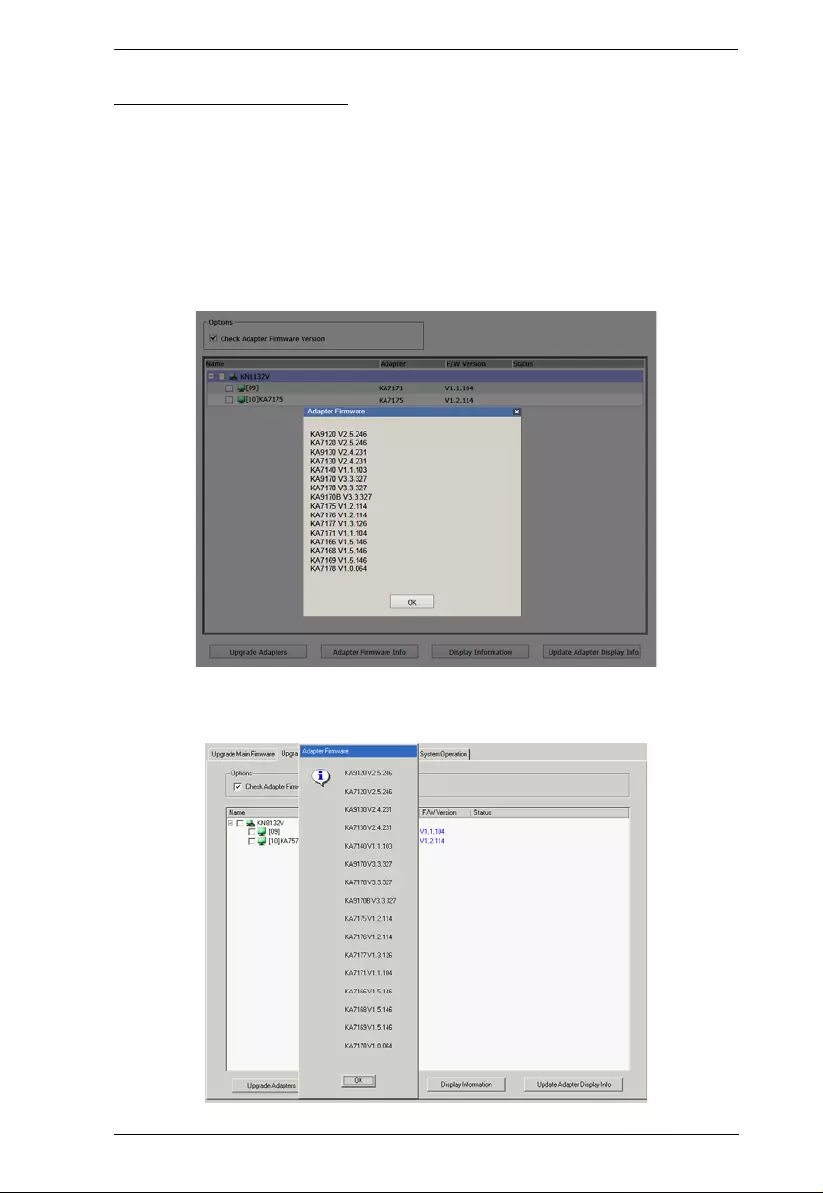
Chapter 10. Maintenance
213
Adapter Firmware Info
The Adapter Firmware Info button provides a list of the Adapter Cable
firmware stored on the switch’s Main firmware. You can use this information
to compare it to the F/W Version listed for the connected Adapter Cables. For
optimum compatibility we recommend upgrading your Adapter Cable’s
firmware to match that stored with the switch's Main firm ware.
Browser GUI
AP GUI
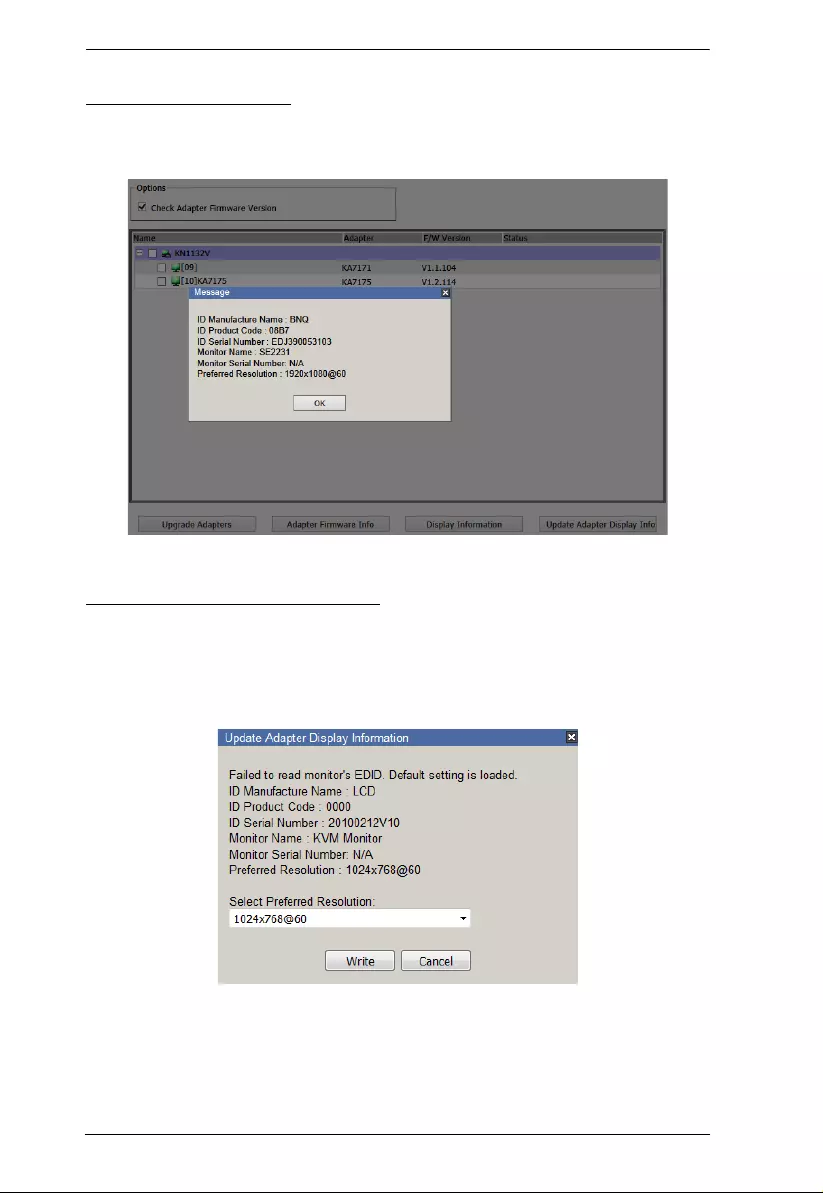
KVM over IP Switch User Manual
214
Display Information
The Display Information button will query and show the locall y connect ed
monitor’s EDID information, as shown here:
Update Adapter Display Info
The Update Adapter Display Info button will query the local monitor’s EDID
information and update it on the Adapter Cable. The EDID information tells
the server's video card about the hardware of the display it is connected to; in
this case the monitor connected to the KVM console.
Use the Display Information button to obtain the local monitor’s Preferred
Resolution (opti onal ), and apply it with the Select Preferred Resolution drop
down menu, then click Write. If the local console is not connected to a
monitor, the default EDID setting is load ed on the adapter cable.

Chapter 10. Maintenance
215
Adapter Firmware Upgrade Recovery
Should the adapter firmware upgrade procedure fail for one of the KVM
Adapter Cables and the adapter becomes unusable, the following adapter
firmware upgrade recovery procedure wi ll resolve the problem:
1. Unplug the Adapter from the server it is connected to.
2. Slide its Firmware Upgrade Recovery Switch (located next to the Cat 5e
connector) to the RECOVER position.
3. Plug the Adapter back into the server.
4. Repeat the Adapter upgrade procedure.
After the Adapter has been successfully upgraded, unplug the Adapter from the
server it is connected to; slide the Firmware Upgrade Recovery Switch back to
the NORMAL position; and plug the Adapter back in.
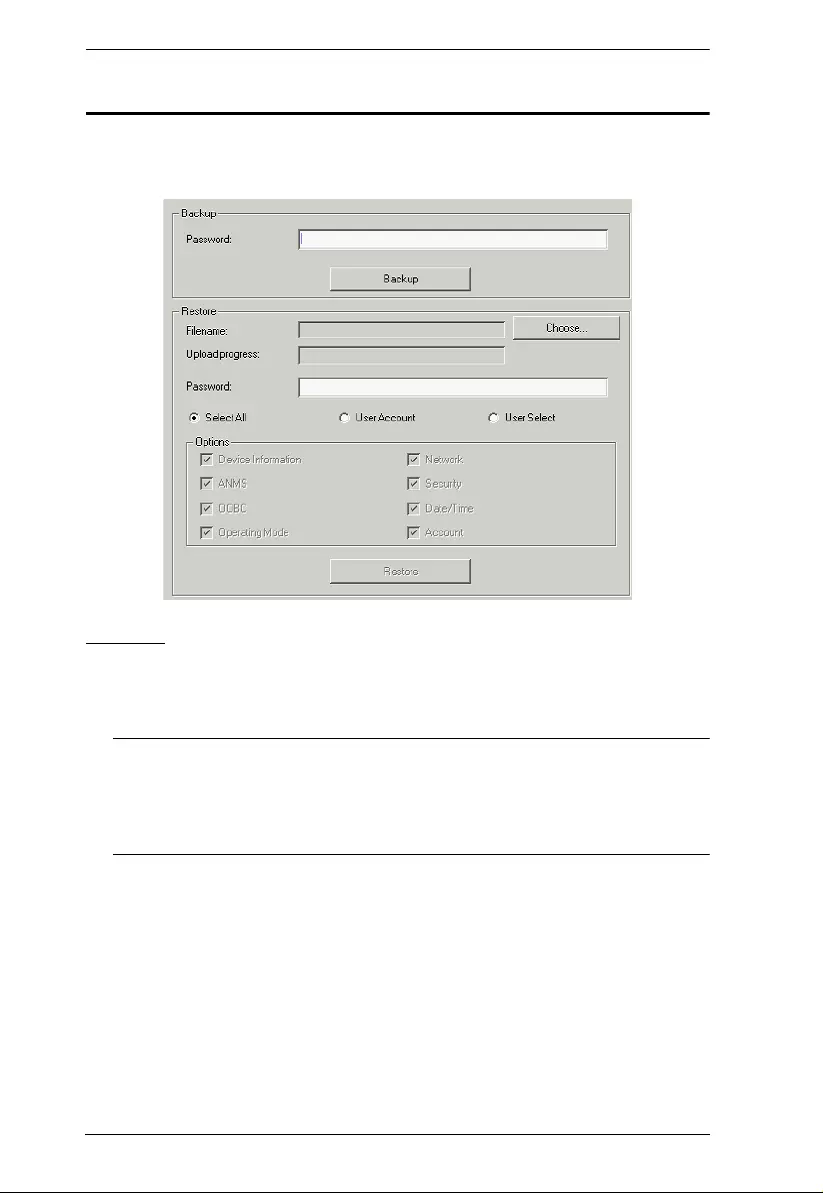
KVM over IP Switch User Manual
216
Backup/Restore
Selecting the Backup/Restore m enu item gives you the ability to back up the
switch’s configuration and user profile informati on:
Backup
To backup the device’s settings do the following:
1. In the Password field, key in a password for the file.
Note: 1. Setting a password is optional. If you do not set one, the file can
be restored without specifying a password .
2. If you do set a password, make a note of it, since you will need it
to be able to restore the file.
2. Click Backup.
3. When the browser asks wh at you wan t to do wi th the file, select Save to
disk; then save it in a convenient location.

Chapter 10. Maintenance
217
Restore
To restore a previous backup, do the following:
1. Click Browse; navigate to the file and select it.
Note: If you renamed the file, you can leave the new name. There is no
need to return it to its original name.
2. If you set a password when you create d the fi le, ke y it in th e Password
field.
3. Select as many of the options that are presented as you wish to restore.
4. Click Restore.
After the file is restored, a message appears to inform you that the
procedure succeeded.
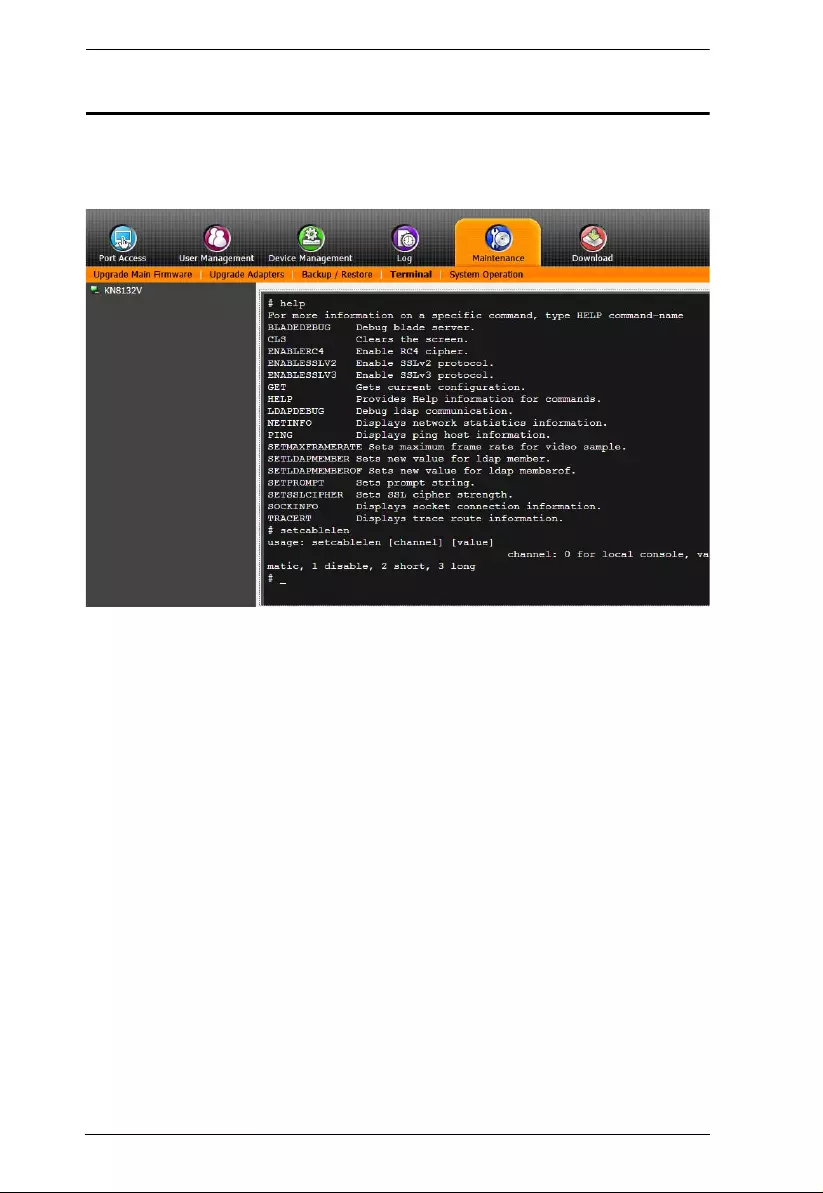
KVM over IP Switch User Manual
218
Terminal
Terminal provides a command line to execute options using a terminal
interface. Type a command in the window and hit [Enter] to execute it.
Available commands include:
BLADEDEBUG => Debug blade server.
CLS => Clears the screen.
ENABLERC4 => Enable RC4 cipher.
ENABLESSLV2 => Enables SSLv2 protocol.
ENABLESSLV3 => Enables SSLv3 protocol.
GET => Gets current configuration.
HELP => Provides Help information for commands.
LDAPDEBUG => Debugs ldap communication.
NETINFO => Displays network statistics information.
PING => Displays ping host information.
SETAMFRAMECOLOR \[RGB color code] => Sets the panel array
frame color. Any color can be set, RGB color code example:
Value: ff0000 = Red
Value: 00ff00 = Green
Value: 000ff = Blue

Chapter 10. Maintenance
219
SETCABLELEN [channel] [value] => Sets the cable length
Channel: 0 for local console; 01-08 for remote consoles
Value: 0 = Automatic, 1 = Disable, 2 = Short, 3 = Long
SETFORWARD [IP address] => Sets primary switch IP address on
secondary switch for Channel Forwarding
SETLDAPMEMBER => Sets new value for ldap member.
SETLDAPMEMBEROF => Sets new value for ldap memberof.
SETMAXFRAMERATE [frame rate] [mouse move option] => Sets
maximum frame rate and mouse moves optio n.
Frame Rate: 1-30
Mouse Move Option: 0 = Disable frame rate setting if mouse
moves. 1 = Keep frame rate setting if mouse moves.
SETPROMPT => Sets prompt string.
SETSSLCIPHER => Sets SSL cipher strength.
SETUSERINFOEXT [value] => Enables/Disables detailed user login
information for each port to be recorded in the event logs.
Value: 0 = Disable, 1 = Enable
SETVCHANNELMODE [value] => Enables Channel Forwarding
Value: 0 = Disable, 1 = Enable
SOCKINFO => Displays socket connection information.
TRACERT => Displays trace route information.

KVM over IP Switch User Manual
220
Restore Values
The Restore Values page lets you restore certain confi guration changes that
were made to the KVM over IP switch back to their original factory default
values.
]
The functions performed on this page are as follows:
Clear Port Names:
Clicking this button rem oves names that have been assigned to the ports
Restore Default Values:
Clicking this button und oes all Custom ization page changes that have been
made to the KVM over IP switch (except for the Port Names), as well as the
Network Transfer Rate (on the Network page), and returns the parameters to
the original factory default settings.
Reset on exit:
Place a check here and click Apply to have the KVM over IP switch reset itself
and implement all the new settings when you log out. (Following the reset, wait
approximately 30 to 60 seconds before logging back in .)
If you change the switch’s IP Address (see Network, page 169), the checkbox
is automatically checked and the KVM switch will reset when you log out. If
you clear the check mark before logging out, the changed IP settings will be
ignored and the original IP address settings wi ll rem a in in effect.
Note: Even though the changed IP settings are ignored, they still remain in the
network settings fields. Which means that the next tim e you open this
page the Reset on exit checkbox will automatically be enabled, and
when the switch resets, the new IP settings that you tho ught you
discarded will become the ones used by the switch. To avoid this
problem, you should go back to the network settings page and be sure
that the IP settings that appear in the fields are the ones you want to use.
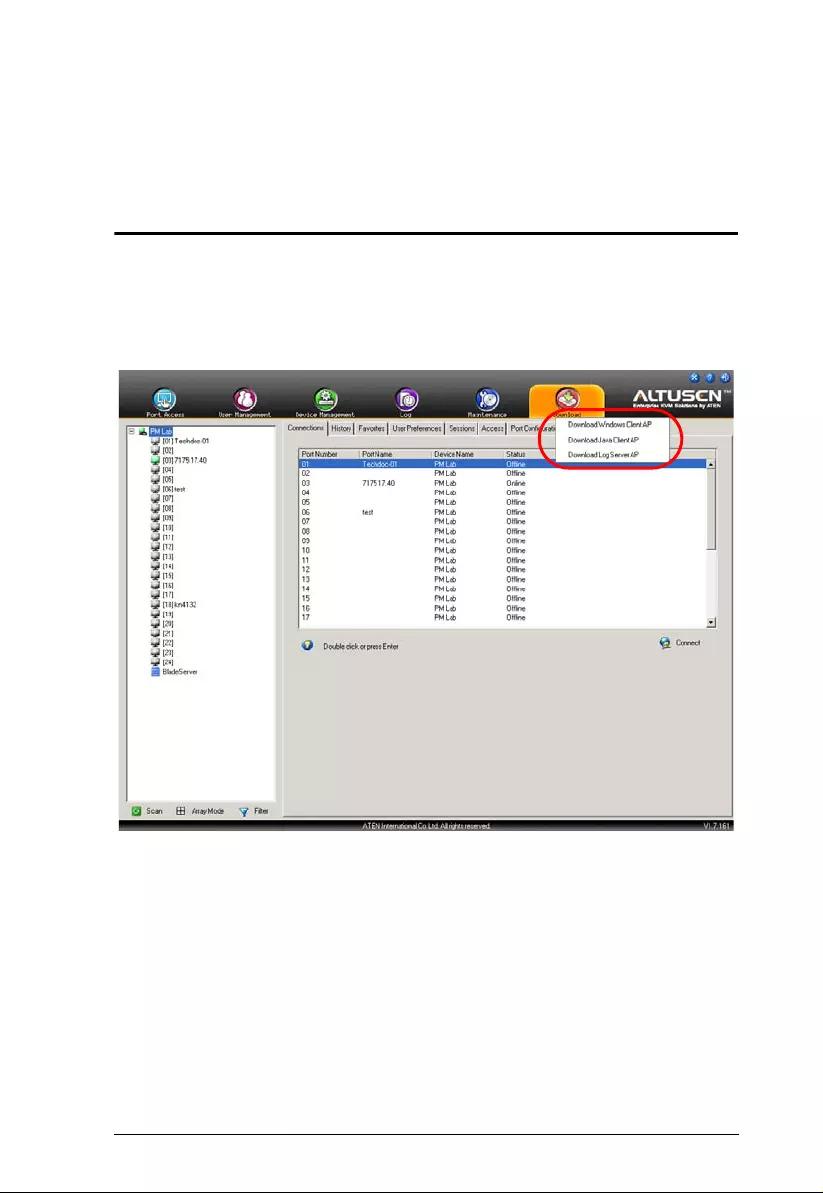
221
Chapter 11
Download
Overview
Download is used to download stand-alone AP versions of the Windows
Client, the Java Client, and the Log Server:
Browser GUI
Click the program you want to dow nload; save it to a convenient locatio n on
your hard disk, and run it from there.
(Continues on next page.)
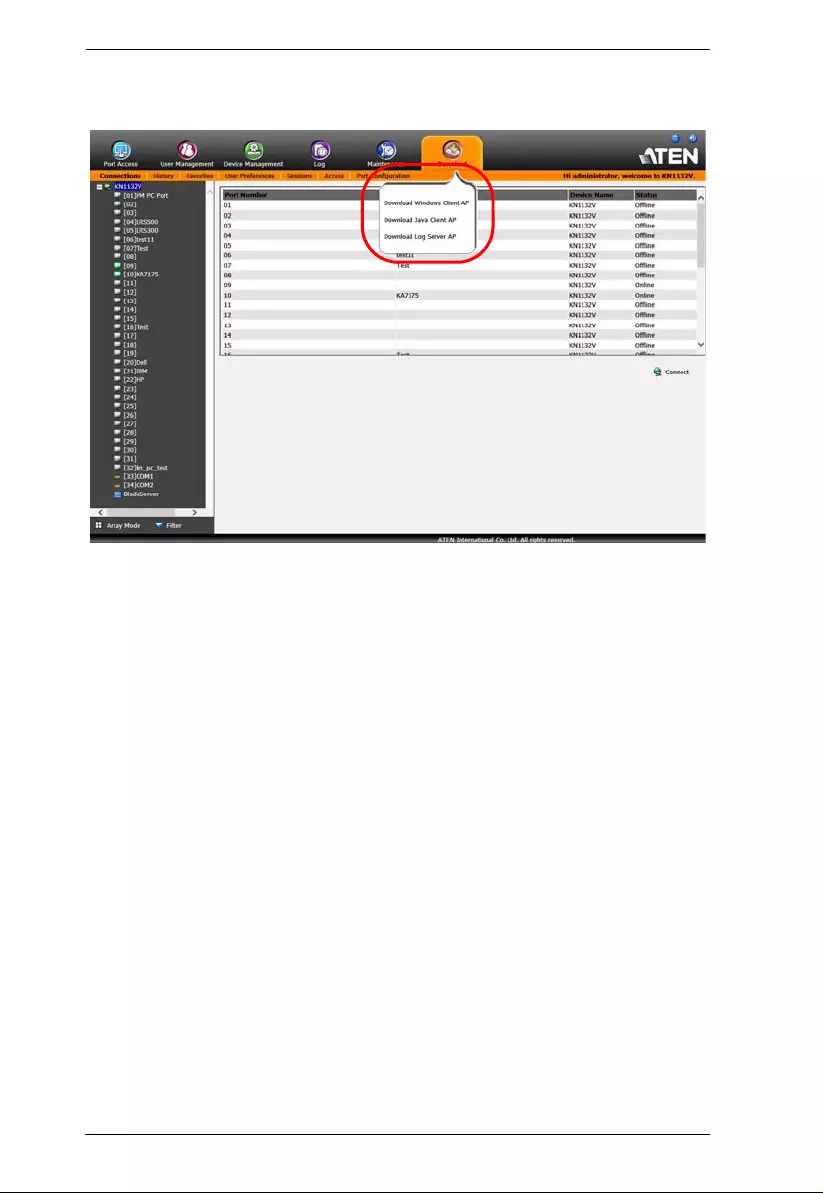
KVM over IP Switch User Manual
222
Browser GUI
Click the program you want to download; save it to a convenient location on
your hard disk, and run it from there.
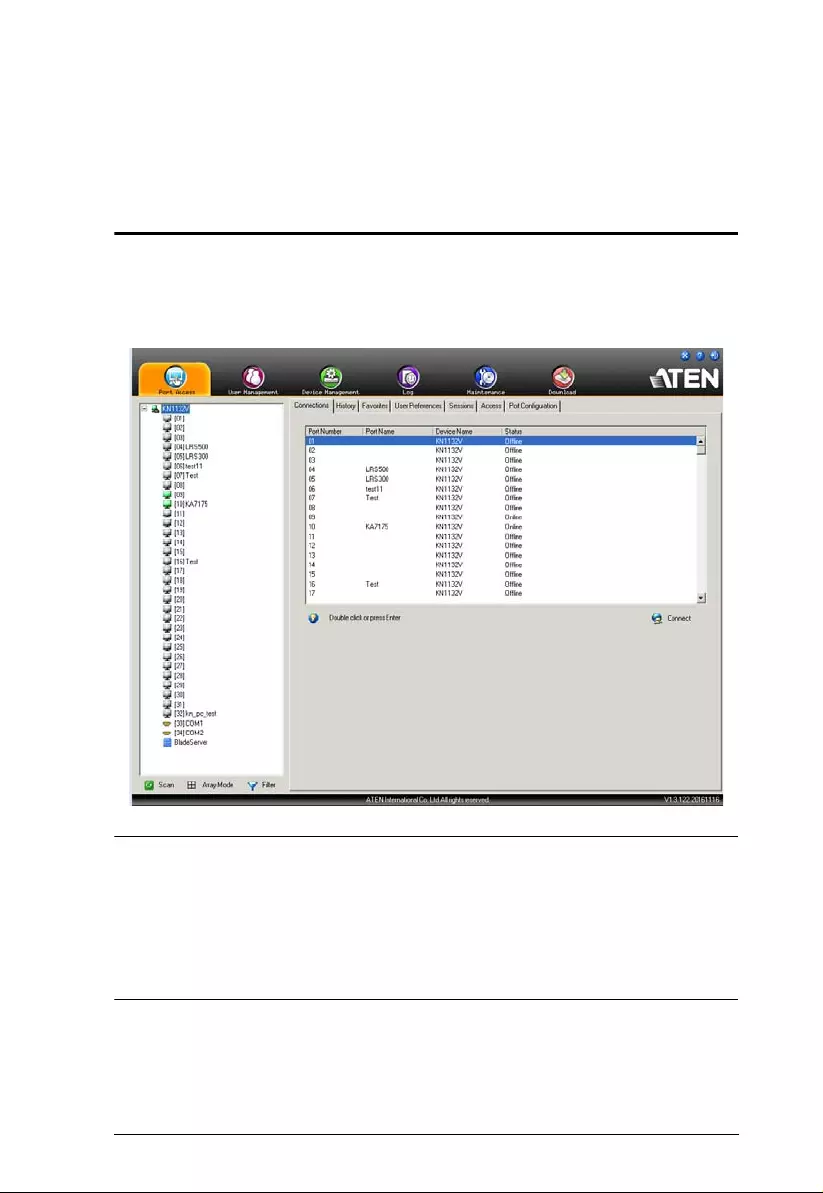
223
Chapter 12
Port Operation
Overview
After you have successfully logged in (see Logging In, page 47), the KVM
over IP switch opens to the Port Access tab’s Connections page, with the first
KVM over IP switch selected in the sidebar:
Note: 1. The WinC lient and Java Client AP programs have a hidden Control
Panel at the upper center of the screen that becomes visible when you
mouse over it. The Browser version’s Con trol Pan e l only appears
after you switch to a port. The Control Panel is discussed on page 64.
2. See KVM Devices and Ports – Connections Page, page 110 for details
about the Port Access Connections page.
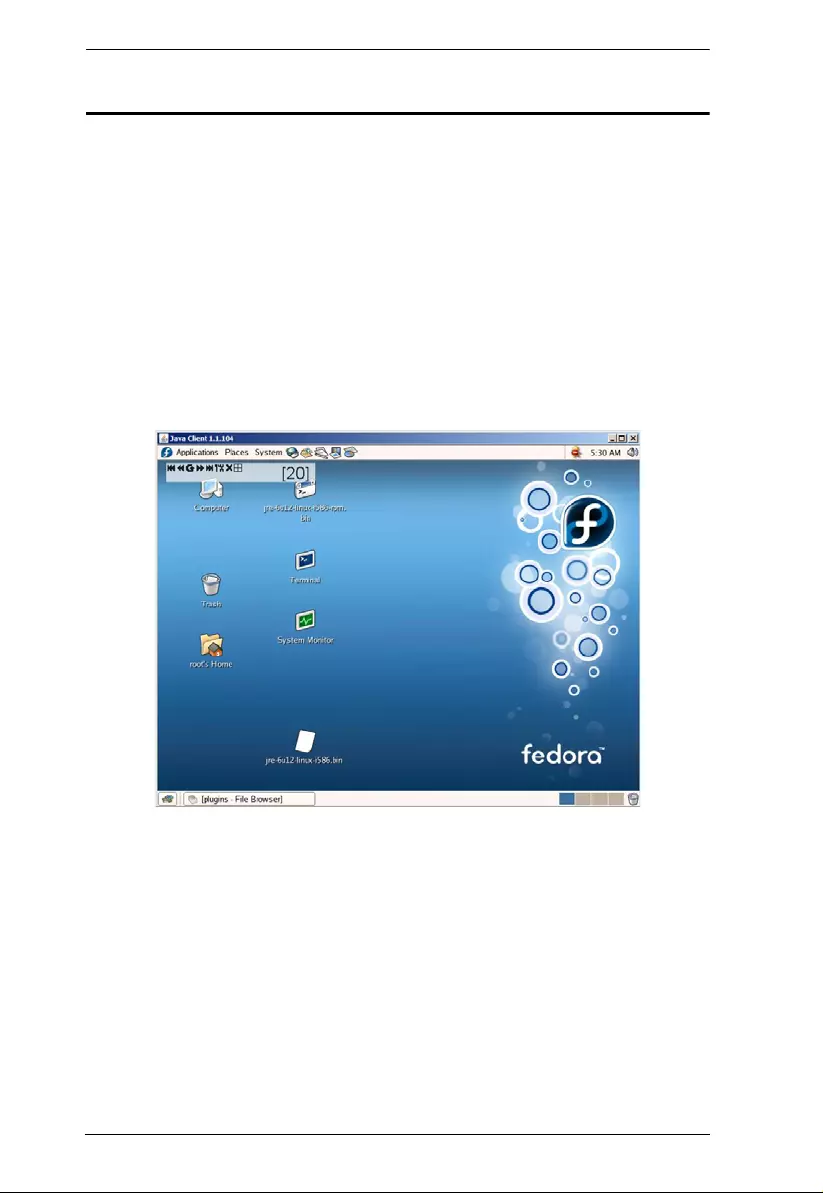
KVM over IP Switch User Manual
224
Connecting to a Port
All the devices, ports, and outlets that a user is permitted to access are listed in
the Sidebar at the left of the page.
To connect to a port when a device is selected in the Sidebar, double click
its icon in the Sidebar; or double click an ywhere on its line entry in the
main central panel; or select it in the main pan e l and click Connect at the
bottom right of the page.
To connect to a port when the port is selected in the Sidebar, click
Connect at the right of the Status panel (see Status, page 111).
Once you switch to a port, its screen displays on your monitor, and your
keyboard and mouse input affects the remote server:

Chapter 12. Port Operation
225
The Port Toolbar
The KVM over IP switch’s interface provides a toolbar to help you with port
switching operations from within the captured port. To bring up the toolbar, tap
the GUI Hotkey (Scroll Lock or Ctrl), twice. The toolbar appears at the upper
left corner of the screen:
Depending on the settings that were selected for ID Display (see page 126), the
Port Number and/or the Port Name display at the right of the toolbar. The
meanings of the toolbar icons are given in a table on page 226.
When the toolbar displays mouse and keybo ard input has no effect on the
server connected to the port. To carry out operations on the server, close the
toolbar by clicking its X icon.
To return to the Port Access Connections page, either click the appropriate icon
(see The Toolbar Icons, page 226), or tap the GUI hotkey again.
Note: 1. You can adjust the toolbar transparency (see Video Settings, page 78).
2. The toolbar functions and icons are also incorporated in the Control
Panel. If you choose to enable them in the Control Panel (see Control
Panel Configuration, page 99), you can disable the Toolbar (see User
Preferences, page 126 for details). To recall the Port Access
Connections page when there is no To olbar, simply tap the GUI
hotkey twice.

KVM over IP Switch User Manual
226
The Toolbar Icons
The meanings of the toolbar icons are explained in the table bel ow.
Icon Purpose
Click to skip to the first accessible port on the entire installation,
without having to recall the Port Access page.
Click to skip to the first accessible port previous to the current
one, without having to recall the Port Access page.
Click to begin Auto Scan Mode. The KVM over IP switch
automatically switches among the ports that were selected for
Auto Scanning with the Filter function (see Filter, page 106).
This allows you to monitor their activity without having to switch
among them manually.
Click to skip from the current port to the next accessible one,
without having to recall the Port Access page.
Click to skip from the current port to the last accessible port on
the entire installation, without having to recall the Port Access
page.
Click to recall the Port Access page.
Click to close the toolbar.
Click to invoke Panel Array Mode (see Panel Array Mode,
page 230).

Chapter 12. Port Operation
227
Toolbar Hotkey Port Switching
When the toolbar displays, you can use hotkeys to provide KVM focus to a port
directly from the keyboard. The KVM over IP switch provides the fol low ing
hotkey features:
Going directly to a port by keyin g in it s port number and clicking Enter.
Auto Scanning
Skip Mode Switching
The hotkeys are: A and P for Auto Scanning; and the Arrow Keys for Skip
Mode.
Note: 1. In order for hotkey operations to take place, the toolbar must be
visible (see The Port Toolbar, page 225).
2. To use the keys designated as hotkeys (i.e. A, P, etc.) for normal, non-
hotkey purposes, you must first close the toolbar.
3. Fo r issues affecting multiple user operation in Auto Scan Mode, see
Multiuser Operation, page 232.
Auto Scanning
The Scan function automatically switches among all the ports that are
accessible to the currently logged on user at regular intervals, so that the user
can monitor their activity automatically. Users can also limit the number of
ports scanned with the Filter function of the Sidebar. See KVM Devices and
Ports – Connections Page, page 110, and Filter, page 106, for furth e r details.
Setting the Scan Interval:
The amount of time Auto Scan dwells on each port is set with the Scan
Duration setting (see Sca n Durat ion, page 127).
Invoking Auto Scan
To start Auto Scanning, with the toolbar showing, tap the A key . The Auto
Scan function cycles through the ports in order – starting from the first
port on the installation. An appears in front of the Port ID Display to
indicate that the port is being accessed under Auto Scan Mode.
S

KVM over IP Switch User Manual
228
Pausing Auto Scan
While you are in Auto Scan Mode, you can pause the scanning in order to
keep the focus on a particular server by pressing P. During the time that
Auto Scanning is paused, the S in front of the Port ID blinks On and Off.
Pausing when you want to keep the focus on a particular server can be
more convenient than exiting Auto Scan Mode because when you Resume
scanning, you start from where you left off. If, on the other hand, you were
to exit and then restart Auto Scan Mode, the scanning would start over
from the very first server on the installation.
To Resume Auto Scanning after a pause, press any key except [Esc] or the
[Spacebar]. Scanning continues from where it left off.
Exiting Auto Scan
While Auto Scan Mode is in effect, ordinary keyboard functions are
suspended. You must exit Auto Scan Mode in order to regain normal
control of the keyboard. To exit Auto Scan Mode press [Esc] or the
[Spacebar]. Auto Scanning stops when you exit Auto Scan Mode.
Skip Mode
Skip Mode allows you to switch ports in order to monitor the servers manually.
You can dwell on a particular port for as long or as little as you like - as
opposed to Auto Scanning, which automatically switches after a fixed interval.
The Skip Mode hotkeys are the four Arrow keys. Their operation is explained
in the table below:
Arrow Action
Skips from the current port to the first accessible port previous to it.
Skips from the current port to the first accessible port that comes after it.
Skips from the current port to the very first accessible port on the
installation.
Skips from the current port to the very last accessible port on the
installation.

Chapter 12. Port Operation
229
Recalling the Port Access Page
To dismiss the toolbar and bring back the Port Access page, do one of the
following:
Tap the GUI Hotkey once.
From the toolbar, click the icon that recalls the Port Access page (see The
Toolbar Icons, page 226).
The toolbar closes, and the Port Access Page appears.
GUI Hotkey Summary Table
The following table presents a summary of the GUI Hotkey actions after you
have accessed a port. See User Preferences, page 126 to set the GUI Hotkey.
To... Do This...
Open the Toolbar Click the GUI Hotkey twice
Open the Port
Access Page The Toolbar is open Click the GUI Hotkey once
The Toolbar is not open Click the GUI Hotkey three times

KVM over IP Switch User Manual
230
Panel Array Mode
Clicking the toolbar's Panel icon invokes Panel Array Mode. Under this mode,
the screen divides into a grid of up to 64 panels:
Each panel represents one of the switch’s ports beginning with Port 1 at
the upper left, and going from left to right; top to bott om.
The number of panels in the array can be selected by clicking the Show
More Ports, and Show Fewer Ports symbols on the panel array toolbar
(see the following page for an explanation of the panel array toolbar).
When the Array is first invoked, it scans through each of the ports that
were selected for Auto Scanning with the Filter function (see Filter,
page 106). As it scans, the border of the panel that has the focus becomes
highlighted.
Only ports that are accessible to the user are displayed. For ports that are
not accessible, the panel is blank.
If the server connected to a port is on line, its screen displays in its panel,
otherwise the panel is blank.
Mousing over a panel displays information about the port (port name,
online status, port access status, and resolution).
You can access a server connected to a port by moving the mouse pointer
over its panel and clicking. You switch to the server exactly as if you had
selected it from the Port Access page.

Chapter 12. Port Operation
231
Panel Array Toolbar
The panel array toolbar provides shortcut navi gation and control of the panel
array. The toolbar can be dragged anywhere on the screen. Mousing over an
icon brings up a “tooltip” that provides a short description of the icon’s
function. The icon functions are described in the table below:
Note: For issues affecting multiple user operation in Panel Array Mode, see
Multiuser Operation, page 232.
Click and drag to move the toolbar.
Note: This icon is only available with the Windows Clients. To move the
Java Client toolbars, click on any empty space and drag.
Pause panel scanning, leaving the focus on the panel that currently has it.
Move back four panels.
Move to the previous panel.
Move to the next panel.
Move ahead four panels.
Show More Ports: Increase the number of panels in the array.
Show Fewer Ports: Decrease the number of panels in the array.
Toggle 4/3 aspect ratio.
Exit Panel Array mode.

KVM over IP Switch User Manual
232
Multiuser Operation
The KVM over IP switch supports multiuser operation . Wh en multiple users
simultaneously access the switch from client computers, the rules of
precedence that apply are shown in the following table:
Operation Rule
General Each bus is independent. For an explanation of the method
by which users are assigned to buses, see the next section,
Users and Buses. Each user can open his own independent
GUI Main Page.
Auto Scan Mode If a user has invoked Auto Scan Mode (see page 227), and
then another user logs on and gets assigned to the same
bus, at first the new user sees the GUI Main Page – but as
soon as he accesses any port, he automatically enters Auto
Scan Mode (since he is sharing the bus with the original
user).
Any user on the bus can halt Auto Scan Mode by recalling
the GUI Main Page. When this occurs, Auto Scan Mode
stops and all the other users on the bus are switched to the
port that was being accessed when Auto Scan Mode
stopped.
Panel Array Mode If a user has invoked Panel Array Mode (see page 230),
and then another user logs on and gets assigned to the
same bus at first user, the new user sees the GUI Main
Page – but as soon as he accesses any port, he
automatically enters Panel Array Mode (since he is
sharing the bus with the original user).
Panel Array Mode continues until the original user stops it.
(Administrators can override Panel Array Mode, however.)
Only the user who starts Panel Array Mode can use the
Skip Mode (see page 228), function.
Only the user who starts Panel Array Mode can switch
ports. Other users automatically switch to the ports that
the original user selects. However, if one of the other
users does not have access rights to the port that the
original user switches to, that user will not be able to view
the port.
Individual users can increase or decrease the number of
panels they wish to view in Panel Array Mode; however,
the picture quality may decrease as the number of panels
increases.

Chapter 12. Port Operation
233
Users and Buses
The KN8164V / KN8132V support eight remote buses. The first, ninth,
17th, etc., users are all on the first bus; the second, 10th, 18th, etc., users
are all on the second bus; the third, 11th, 19th etc., users are all on the third
bus; the fourth, 12th, 20th, etc., users are all on the fourth bus; the fi fth,
13th, 21st, etc., users are all on the fifth bus; the sixth, 14th, 22nd, etc.,
users are all on the sixth bus; the seventh, 15th, 23rd, etc., users are all on
the sixth bus; the eighth, 16th, 24th , etc., users are all on the eighth bus.
The KN41 16VA / KN4132VA / KN4164V support four remote buses. The
first, fifth, ninth, etc., users are all on the first bus; the second, sixth, 10th,
etc., users are all on the second bus; the third, seventh, 11th etc., users are
all on the third bus; the fourth, eighth, 12th, etc., users are all on the fourth
bus.
The KN2116VA / KN2132VA support two remote buses. The first, third,
fifth, etc., users are all on the first bus; the second, four th, sixt h, etc., users
are all on the second bus.
All KVM over IP switches support independent bus switching. With
independent bus switching, if a user switches to a port that is being utilized
by someone on a different bus, only the user that switched ports goes to the
new port and the new bus – the other users on the original bus remain on
the original port and original bus.
Note: 1. Independent bus switching does not work when Auto Scan Mode
or Panel Array Mode is being used by one of the members of the
bus.
2. If Enable First Rider Transfer is enabled (see page 168), only the
first user on a bus can switch to an un-accessed port. Other users
on the bus cannot switch ports unless there is a bus that is already
connected to the port they would like to access, or there is a free
bus available.
We recommend that the user who starts Panel Array Mode set it to display
at least four panels. Otherwise, it is possible that the other users may only
receive part of the picture.
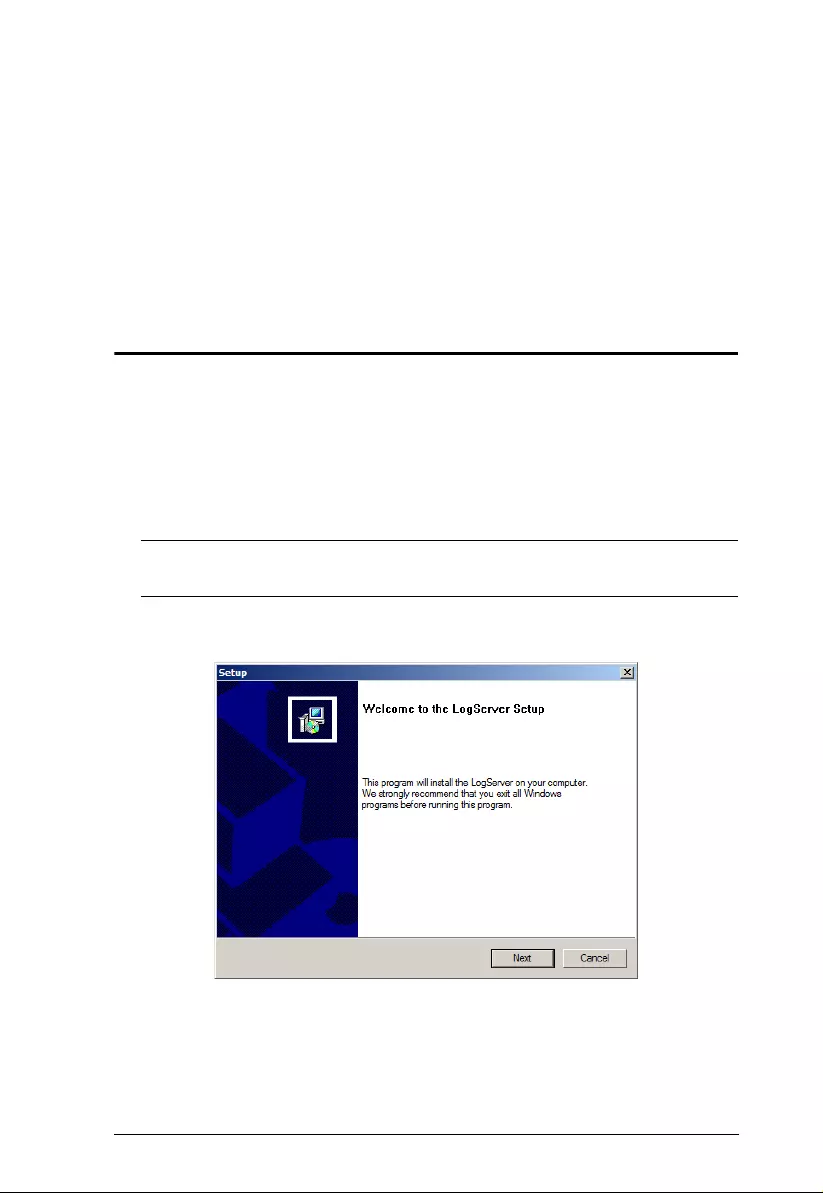
234
Chapter 13
The Log Server
The Windows-based Log Server is an administrative utility that records all the
events that take place on selected KVM over IP switches and writes them to a
searchable database. This chapter describes how to install and configure the
Log Server.
Installation
1. Log into the KVM over IP switch (see page 47).
2. Click the Download tab and do wnload the Log Server AP program.
3. Go to the location on your hard disk that you downloaded the Log Server
program to, and double click its icon (LogSetup.exe) to bring up the
Windows Client Connection Screen:
Note: If the browser cannot run the file, save it to disk, instead, and run the
file from your disk.
The Log Server installation screen appears:
4. Click Next. Then follow the on-screen instructions to complete the
installation and have the Log Server program icon placed on your desktop.

Chapter 13. The Log Server
235
Starting Up
To start the Log Server, either double click the program icon, or key in the full
path to the program on the command line. The first time you run it, a screen
similar to the one below appears:
Note: 1. The MAC address of the Log Server computer must be specified in
theANMS settings – see Log Server, page 175.
2. The Log Server requires the Microsoft Jet OLEDB 4.0 driver.
See The Log Server program does not run., page 264 if the program
doesn’t start.
The screen is divided into three components:
A Menu Bar at the top
A panel that will contain a list of KVM over IP switches in the middle (see
The Log Server Main Screen, page 240).
A panel that will contain an Events List at the bottom
Each of the components is explained in the sections that follow.
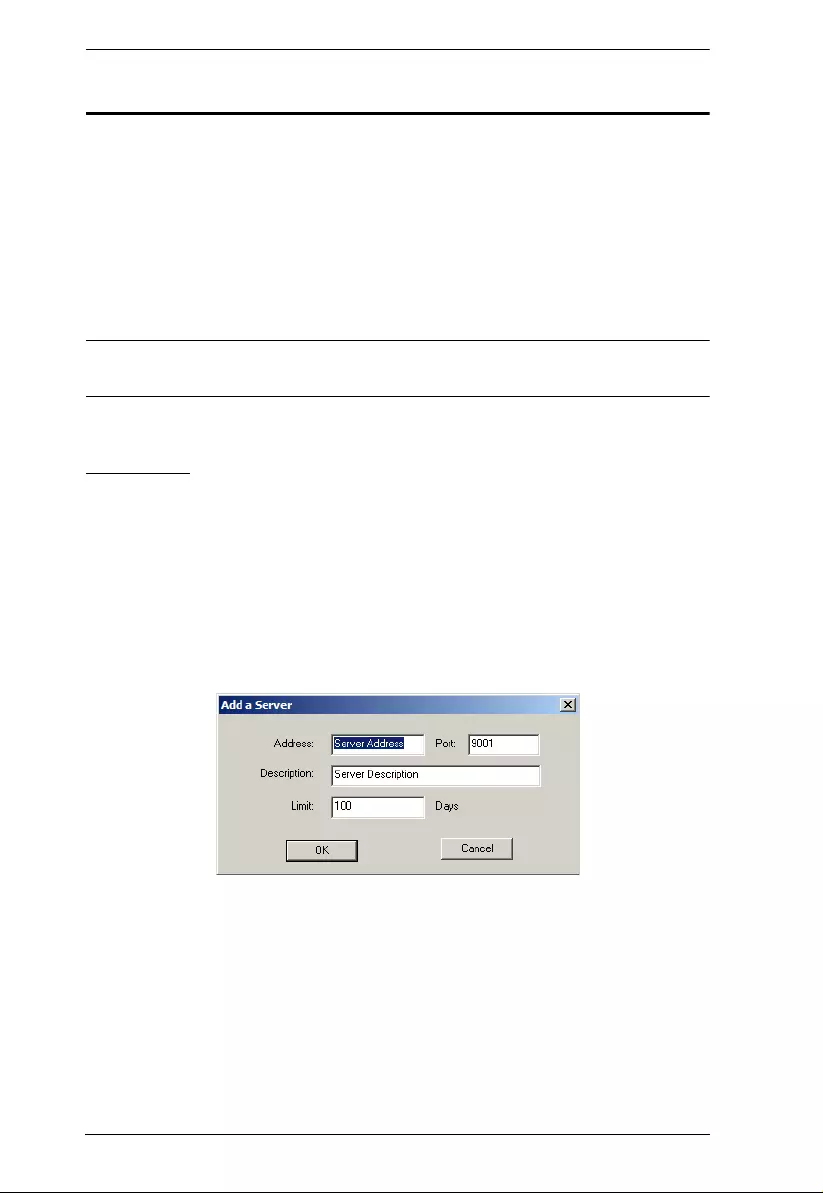
KVM over IP Switch User Manual
236
The Menu Bar
The Menu bar consists of four items:
Configure
Events
Options
Help
These are discussed in the sections that follow.
Note: If the Menu Bar appears to be disabled, click in the List window to
enable it.
Configure
The Configure menu contains three items: Add; Edit; and Delete. They are
used to add new units to the List ; edit the information for units already on the
list; or delete units from the list.
To add a unit to the list, click Add.
To edit or delete a listed unit, first select the target in the List window , then
open this menu and click Edit or Delete.
When you choose Add or Edit, a dialog box, similar to the one below, appears:
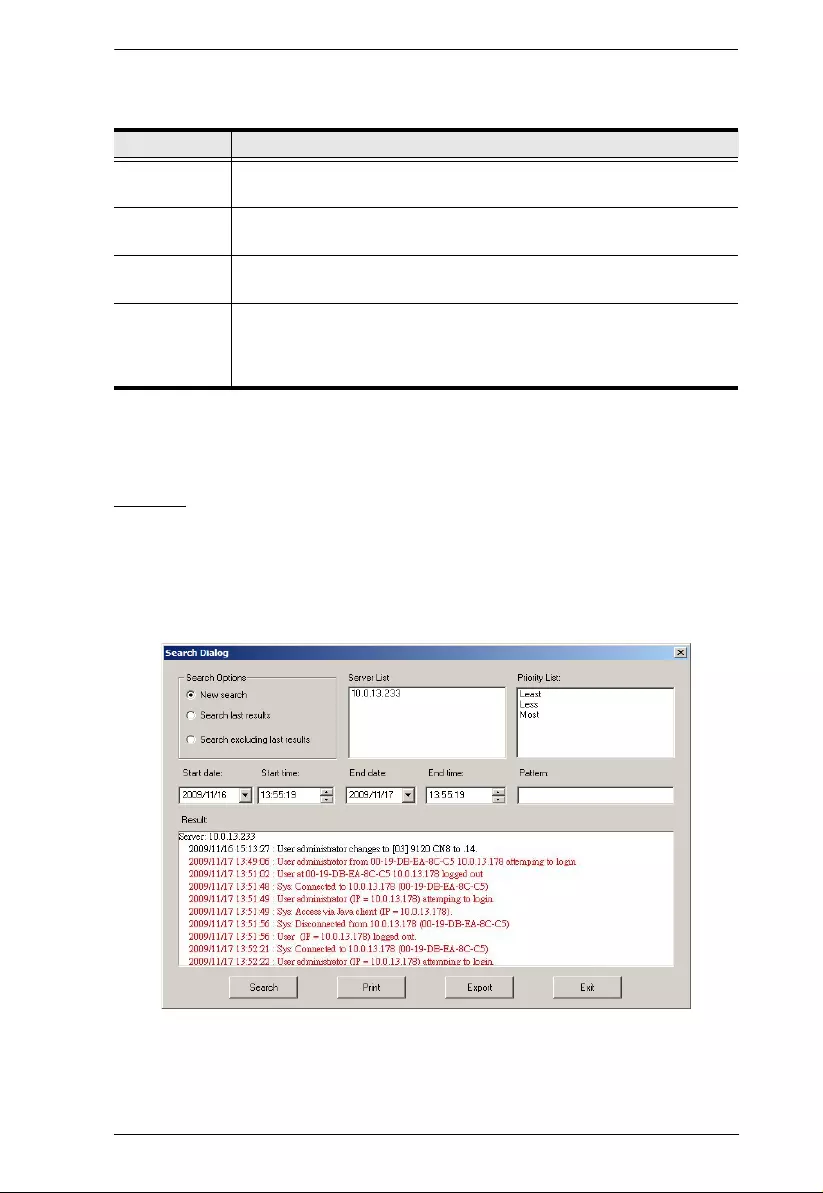
Chapter 13. The Log Server
237
A description of the fields is given in the tabl e, below:
Fill in or modify the fields, th en click OK to finish .
Events
The Events Menu has two items: Search and Maintenance.
Search:
Search allows you to search for events containing specific words or strings.
When you access this function, a screen, similar to the one below, appears:
Field Explanation
Address This can either be the IP address of the computer the Log Server is
running on, or its DNS name.
Port The port number that was assigned to the Log Server under Device
Management (see Log Server, page 175).
Description This field is provided so that you can put in a descriptive reference for
the unit to help identify it.
Limit This specifies the number of days that an event should be kept in the
Log Server's database. Events that exceed the amount of time
specified here can be removed with the Maintenance function (see
Maintenance:, page 238).

KVM over IP Switch User Manual
238
A description of the item s is given in the table, below:
Maintenance:
This function allows the administrat or to perform manual maintenance of the
database, such as erasing specified records before their expiration time is up.
Item Description
New search This is one of three radio buttons that define t he scope of the
search. If it is selected, the search is performed on all the
events in the database for the selected unit.
Search last results This is a secondary search performed on the events that
resulted from the previous search.
Search excluding last
results This is a secondary search performed on all the events in the
database for the selected unit excluding the events that
resulted from the previous search.
Server List KVM over IP switches are listed according to their IP address.
Select the unit that you want to perform the search on from this
list. You can select more than one unit for the search. If no
units are selected, the search is performed on all of them.
Priority Sets the level for how detailed the search results display
should be. Least is the most general; Most is the most specific.
Least results appear in black; Less results appear in blue;
Most results appear in red.
Start Date Select the date that you want the search to start from. The
format follows the YYYY/MM/DD convention, as follows:
2009/11/04
Start Time Select the time that you want the search to start from. The
format follows the HH:MM:SS convention.
End Date Select the date that you want the search to end at.
End Time Select the time that you want the search to end at.
Pattern Key in the pattern that you are searching for here. The multiple
character wildcard (%) is supported. E.g., h%ds would match
hands and hoods.
Results Lists the events that contained matches for the search.
Search Click this button to start the search.
Print Click this button to print the search results.
Export Click this button to save the search results to file.
Exit Click this button to exit the Log Server.

Chapter 13. The Log Server
239
Options
Network Retry allows you to set the number of seconds that the Log Server
should wait before attempting to conn ect if its previo us attempt to connect
failed. When you click this item, a dialog box, similar to the one below,
appears:
Key in the number of seconds, then click OK to finish.
Help
From the Help menu, click Contents to access the online Windows Help file.
The help file contains instructions about how to setup, operation and
troubleshoot the Log Server.
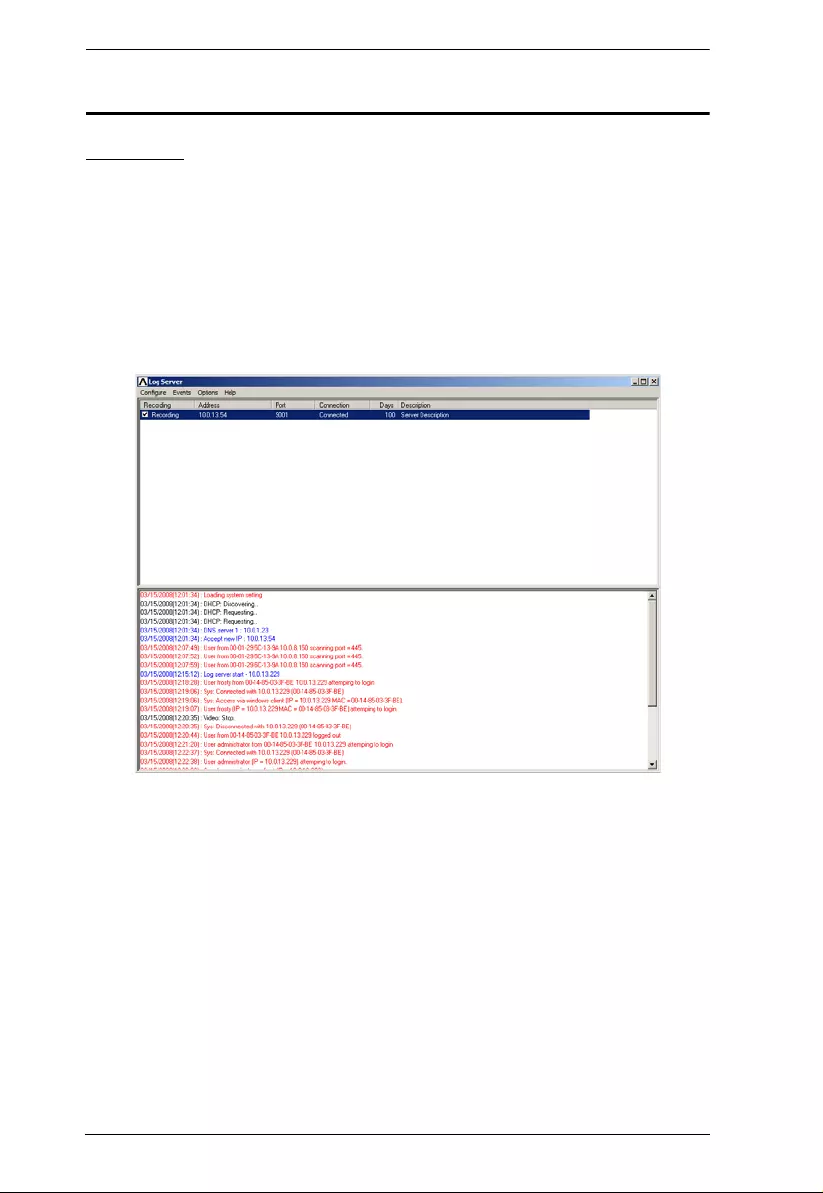
KVM over IP Switch User Manual
240
The Log Server Main Screen
Overview
The Log Server Main Screen is divided into two main pane ls.
The upper (List) panel lists all of the units that have been selected for the
Log Server to track (see Configure, page 236).
The lower (Event) panel displays the tick inform ation for the currently
selected unit. (If there are more than one unit, the selected unit is the one
that is highlighted).
To select a unit in the list, simply click on it.

Chapter 13. The Log Server
241
The List Panel
The List panel contains six fields:
The Event Panel
The lower panel displays log events for the currently selected unit. Note that if
there are more than one units, even though they aren't currently selected, if their
Recording checkbox is checked, the Log Server records their log events and
keeps them in its database.
Field Explanation
Recording Determines whether the Log Server records the ticks for this
unit, or not. If the Recording checkbox is checked, the field
displays Recording, and the ticks are recorded. If the
Recording checkbox is not checked, the field displays Paused,
and the ticks are not recorded.
Note: Even though a unit is not the currently selected one, if
its Recording checkbox is checked, the Log Server will still
record its ticks.
Address This is the IP Address or DNS name that was given to the unit
when it was added to the Log Server (see Configure,
page 236).
Port This is the Access Port number assigned to the unit (see
Configure, page 236).
Connection If the Log Server is connected to the unit, this field displays
Connected.
If the Log Server is not connected, this field displays
Waiting. This means that the Log Server's MAC address
has not been set properly. It needs to be set on the Device
Management Date/Time page (see page 197).
Days This field displays the number of days that the unit's log events
are to be kept in the Log Server's database before expiration
(see Configure, page 236).
Description This field displays the descriptive information given for the unit
when it was added to the Log Server (see Configure,
page 236).

242
Appendix
Safety Instructions
General
This product is for indoor use only.
Read all of these instructions. Save them for future reference.
Follow all warnings and instructions marked on the device.
Do not place the device on any unstable surface (cart, stand, table, etc.). If
the device falls, serious damage wi ll resul t.
Do not use the device near water.
Do not place the device near, or over, radiators or heat registers.
The device cabinet is provided with slots and openings to allow for
adequate ventilation. To ensure reliable operation, and to protect against
overheating, these openings must never be bl ocked or covered.
The device should never be placed on a soft surface (bed, sofa, rug, etc.) as
this will block its ventilation openings. Likewise, the device should not be
placed in a built in enclosure unless adequate ventilation has been
provided.
Never spill liquid of any kind on the device.
Unplug the device from the wall outlet before cleaning. Do not use liquid
or aerosol cleaners. Use a damp cloth for cleaning.
Avoid circuit overloads. Before conn ecting equipment to a circuit, know
the power supply’s limit and never exceed it. Always review the electrical
specifications of a circuit to ensure that you are not creating a dangerous
condition or that one does not already exist. Circuit overloads can cause a
fire and destroy equipment.
The device shoul d be oper ated from the type of power source indicated on
the marking label. If you are not sure of the type of power available,
consult your dealer or local power company.
To prevent damage to your installation it is important that all devices are
properly grounded.
The device is designed for IT power distribution systems with 230V
phase-to-phase voltage.
The device is equipped with a 3-wire grounding type plug. This is a safety
feature. If you are unable to insert the plug into the outlet, contact your

Appendix
243
electrician to replace your obsolete outlet. Do not attempt to defeat the
purpose of the grounding-type plug . Always follow your local/national
wiring codes.
Do not allow anything to rest on the power cord or cables. Route the
power cord and cables so that they cannot be stepped on or tripped over.
If an extension cord is used with this device make sure that the total of the
ampere ratings of all products used on this cord does not exceed the
extension cord ampere rating. Make sure that the total of all products
plugged into the wall outlet does not exceed 15 amperes.
To help protect your system from sudden, transient increases and
decreases in electrical power, use a surge suppressor, line condi tion e r, or
un-interruptible power supply (UPS).
Position system cables and power cables carefully; Be sure that nothing
rests on any cables.
When connecting or disconnecting power to hot-pluggable power
supplies, observe the following guidelines:
Install the powe r su pp ly before connecting the power cable to the
power supply.
Unplug the power cable before removing th e power supply.
If the system has multiple sources of power , disconnect power from the
system by unplugging all power cab les from th e power supplies.
Never push objects of any kind into or through cabin et slots. They may
touch dangerous voltage points or short out parts resulting in a risk of fire
or electrical shock.
Do not attempt to service the device yourself. Refer all servicing to
qualified service personnel.
If the following conditions occur, unplug the device from the wall outlet
and bring it to qualified service personnel for repair.
The power cord or plug has become damaged or frayed.
Liquid has been spilled into the device.
The device has been exposed to rain or water.
The device has been dropped, or the cabinet has been damaged.
The device exhibits a distinct change in performance, indicating a need
for service.
The device does not operate normally when the operating instructions
are followed.

KVM over IP Switch User Manual
244
Only adjust those controls that are covered in the operating instructions.
Improper adjustment of other controls may result in damage that will
require extensive work by a qualified technician to repair.
Additional protection to secure and fix the equip men t is ne eded if the
equipment is installed by stacking; by locking it to the rack, screwing it to
the frame, or other similar methods.
Keep the Cat 5e/6 cable as far away as possible from potential sources of
EMI, such as electrical cables, transformers, and light fixtures. Do not tie
the cables to electrical conduits or lay the cables on electrical fixtures.
Rack Mounting
Before working on the rack, make sure that the stabilizers are secured to
the rack, extended to the floor, and that the full weight of the rack rests on
the floor. In stall front and side stabilizers on a si ngle rack or front
stabilizers for joined multiple racks before working on the rack.
Always load the rack from the bottom up, and load the heaviest item in the
rack first.
Make sure that the rack is level and stable before extending a device from
the rack.
Use caution when pressing the device rail release latches and sliding a
device into or out of a rack; the slide rails can pinch your fingers.
After a device is inserted into the rack, carefully extend the rail into a
locking position, and then slide the device into the rack.
Do not overload the AC supply branch circuit that provid e s power to the
rack. The total rack load should not exceed 80 percent of the branch circuit
rating.
Make sure that all equipment used on the rack – including power strips and
other electrical connectors – is properly grounded.
Ensure that proper airflo w is provided to devices in the rack.
Ensure that the operating ambi ent temperature of the rack environment
does not exceed the maximum ambient temperature specified for the
equipment by the manufacturer
Do not step on or stand on any device when servicing ot her devices in a
rack.

Appendix
245
Consignes de sécurité
Général
Ce produit est destiné exclusivement à une utilisation à l’intérieur.
Veuillez lire la totalité de ces instructions. Conservez-les afin de pouvoir
vous y référer ultérieurement.
Respectez l’ensemble des avertissements et instructions inscrits sur
l’appareil.
Ne placez jamais l’unité sur une surface instable (chariot, pied, table, etc.).
Si l’unité venait à tomber, elle serait gravement endommagée.
N’utilisez pas l’unité à proximité de l’eau.
Ne placez pas l’unité à proximité de ou sur des radiateurs ou bouches de
chaleur.
Le boîtier de l’unité est doté de fentes et d’ouvertures destinées à assurer
une ventilation adéquate. Pour garanti r un fo ncti onnement fiable et
protéger l’unité contre les surchauffes, ces ouvertures ne doivent jamais
être bloquées ou couvertes.
L’unité ne doit jamais être placée sur une surface molle (lit, canapé, tapis,
etc.) car ses ouvertures de ventilation se trouveraient bloqu ées. De mêm e ,
l’unité ne doit pas être placée dans un meuble fermé à moins qu'une
ventilation adaptée ne soit assurée.
Ne renversez jamais de liquides de quelque sorte que ce soit sur l’unité.
Débranchez l’unité de la prise murale avant de la nettoyer. N’utilisez pas
de produits de nettoyage liquide ou sous forme d’aérosol. Uti lisez un
chiffon humide pour le nettoyage de l’unité.
Evitez toute surcharge du circuit. Avant de connecter l’equipement a un
circuit, verifiez la limite de l’alimentation et ne la depassez pas. Controlez
toujours les caracteristiques electriques d'un circuit pour vo us assurer de
ne pas creer de situation dangereuse ou qu’il n’y en a pas deja. Les
surcharges du circuit peuvent provoquer un incendie et detruire
l’equipement.
L’appareil doit être alimenté par le typ e de source ind iqué sur l’étiquet te.
Si vous n’êtes pas sûr du type d’alimentation disponible, consultez votre
revendeur ou le fournisseur local d’électricité.
Afin de ne pas endommager votre installati on, vérifiez que tous les
périphériques sont correctement mis à la terre.

KVM over IP Switch User Manual
246
L’unité est équipée d’une fiche de terre à trois fils. Il s’agit d’une fonction
de sécurité. Si vous ne parvenez pas à insérer la fiche dans la prise murale,
contactez votre électricité afin qu’il remplace cette dernière qui doit être
obsolète. N’essayez pas d’aller à l’encontre de l’objectif de la fiche de
terre. Respectez toujours les codes de câblage en vigueur dans votre
région/pays.
L’équipemen t doit être instal lé à prox imi té de la prise murale et le
dispositif de déconnexion (prise de courant femelle) doit être facile
d’accès.
La prise murale doit être installée à proximité de l’équipement et doit être
facile d’accès.
Veillez à ce que rien ne repose sur le cordon d’alimentation ou les câbles.
Acheminez le cordon d’alimentation et les câbles de sorte que personne ne
puisse marcher ou trébucher dessus.
En cas d’utilisation d’une rallong e avec cette unité, assurez-vous que le
total des ampérages de tous les produits utilisés sur cette rallonge ne
dépasse pas l’ampérage nominal de cette dern ière. Assurez-vous que le
total des ampérages de tous les produits branchés sur la prise mural e ne
dépasse pas 15 ampères.
Pour contribuer à protéger votre système cont re les augmentations et
diminutions soudaines et transitoires de puissance électrique, utilisez un
parasurtenseur, un filtre de ligne ou un système d’alimentation sans
coupure (UPS).
Placez les câbles du système et les câbles d’alimentation avec précaution ;
veillez à ce que rien ne repose sur aucun des câbles.
Lors du branchement ou du débranchement à des blocs d’alimentation
permettant la connexion à chaud, veuillez respecter les lignes directrices
suivantes:
Installez le bloc d’alimentation avant de brancher le câble d’alimentation à
celui-ci.
Débranchez le câble d’alimentation avant de retirer le bloc d'alimentation.
Si le système présente plusieurs sources d’alimentation, déconnectez le
système de l'alimentation en débranchant tous les câbles d'alimentation des
blocs d'alimentation.
N’insérez jamais d’objets de quelque sorte que ce soit dans ou à travers les
fentes du boîtier . Ils pourraient entrer en contact avec des points de tension
dangereuse ou court-circuiter des pièces, entraînant ainsi un risque
d’incendie ou de choc électrique.

Appendix
247
N’essayez pas de réparer l’unité vous-même. Confiez toute opération de
réparation à du personnel qualifié.
Si les conditions suivantes se produisent, débranchez l’unité de la prise
murale et amenez-la à un technicien qualifié pour la faire réparer:
Le cordon d’alimentat ion ou la fiche ont été endommagés ou éraillés.
Du liquide a été renversé dans l’unité.
L’unité a été exposée à la pluie ou à l’eau.
L’unité est tombée ou le boîtier a été endommagé.
Les performances de l’unité sont visiblement altérées, ce qui indique la
nécessité d’une réparation.
L’unité ne fonctionne pas normalement bien que les instructions
d’utilisation soient respectées.
N’utilisez que les commandes qui sont abordées dans le mode d’emploi.
Le réglage incorrect d’autres commandes peut être à l’origine de
dommages qui nécessiteront beaucoup de travail pour qu’un technicien
qualifié puisse réparer l’unité.
Tenez le câble de catégorie 5e/6 le plus éloigné possible des sources
potentielles d’interférences électromagnétiques, telles que les câbles
électriques, transformateurs et appareils d’éclairage. Ne nouez pas les
câbles à des conduits électriques et ne les faites pas passer sur des
installations électriques.

KVM over IP Switch User Manual
248
Montage sur bâti
Avant de travailler sur le bâti, assurez-vous que les stabilisateurs sont bien
fixées sur le bâti, qu’ils sont étendus au sol et que tout le poids du bâti
repose sur le sol. Installez les stabilisateurs avant et latéraux sur un même
bâti ou bien les stabilisateurs avant si plusieurs bâtis sont réunis, avant de
travailler sur le bâti.
Chargez toujours le bâti de bas en haut et chargez l’élément le plus lourd
en premier.
Assurez-vous que le bâti est à niveau et qu’il est stable avant de sortir une
unité du bâti.
Agissez avec précaution lorsque vous appuyez sur les loquets de libération
du rail d’unité et lorsque vous faites coulisser une unité dans et hors d’un
bâti ; vous pourriez vous pincer les doigts dans les rails.
Une fois qu’une unité a été insérée dans le bâti, étendez avec précaution le
rail dans une position de verrouillage puis faites glisser l’unité dans le bâti.
Ne surchargez pas le circuit de l’alimentation CA qui alimente le bâti. La
charge totale du bâti ne doit pas dépasser 80 % de la capacité du circuit.
Assurez-vous que tous les équipements ut ili sés sur le bâti, y-compris les
multiprises et autres connecteurs électriques, sont correctem ent mi s à la
terre.
Assurez-vous que les unités présentes dans le bâti bénéfi cie d’une
circulation d’air suffisante.
Assurez-vous que la température ambiante de fonctionnement de
l’environnement du bâti ne dépasse pas la température ambiante maximale
spécifiée pour l’équipement par le fabricant.
Ne marchez sur aucun appareil lors de la maintenance d’autres appareils
d’un bâti.

Appendix
249
Technical Support
International
For online technical support – including troubleshooting, documentation,
and software updates: http://eservice.aten.com
For telephone support, see Telephone Support, pag e iii
North America
When you contact us, please have the following information ready beforehand:
Product model number, serial number, and date of purchase.
Your computer configuration, including operating system, revision lev e l,
expansion cards, and software.
Any error messages displayed at the time the error occurred.
The sequence of operations that led up to the error.
Any other information you feel may be of help.
Email Support support@aten-usa.com
Online
Technical
Support
Troubleshooting
Documentation
Software Updates
http://eservice.aten.com
Telephone Support 1-888-999-ATEN ext 4988

KVM over IP Switch User Manual
250
Specifications
KN2116VA / KN4116VA
Function KN2116VA KN4116VA
Computer
Connections Direct 16
Max 256
Port Selection Pushbutton / GUI / Hotkey
Connectors Console
Port Keyboard 1 x USB Type A Female (White)
Video 1 x DVI-D Female (White)
1 x HDB-15 (Blue)
Mouse 1 x USB Type A Female (White)
Audio 2 x Audio Jack (Female)
LUC Port 1 x Mini-USB Female (Black)
Console
Ext. 1 x RJ-45 Female (Black)
KVM Port 16 x RJ-45 Female (Black)
Power 2 x IEC 60320/C14
LAN 2 x RJ-45 Female (Black)
PON 1 x RJ-45 Female (Black)
Modem 1 x RJ-45 Female (Black)
USB
(Console/Virtual
Media)
3 x USB Type A Female (White)
Switches Reset 1 x Semi-recessed Pushbutton
Power 2 x Rocker Switch
Port Selection 2 x Pushbutton
LEDs On Line 16 (Green)
Selected 16 (Orange)
Power 2 (Blue)
Link
10/100/1000 Mbps 2 (10 Mbps: Red; 100 Mbps: Orange; 1000 Mbps: Green)
Emulation Keyboard / Mouse PS/2 / USB (PC, Mac, Sun)
Video 1920 x 1200 @ 60Hz
Scan Interval 1–255 secs
I/P Rating 100–240 V AC; 50–60Hz; 1.0A

Appendix
251
Power
Consumption Single Power 110V/34.5W ; 220V/34.8W 110V/49.1W; 22 0V/50.5W
Dual Power 110V/17.7W; 220V/17.9W
(per input) 110V/24.9W; 220V/ 25.8W
(per input)
Environment Operating Temp. 0–40° C
Storage Temp. -20–60° C
Humidity 0–80% RH, Non-condensing
Physical
Properties Housing Metal
Weight 5.56 kg 5.69 kg
Dimensions
L x W x H 43.36 x 41.21 x 4.40 cm 43.36 x 41.21 x 4.40 cm
Function KN2116VA KN4116VA

KVM over IP Switch User Manual
252
KN1132V / KN2132VA / KN4132VA
Function KN1132V KN2132VA KN4132VA
Computer
Connections Direct 32
Max 512
Port Selection Pushbutton / GUI / Hotkey
Connectors Console
Port Keyboard 1 x USB Type A Female (White)
Video 1 x DVI-D Female (White)
1 x HDB-15 (Blue)
Mouse 1 x USB Type A Female (White)
Audio 2 x Audio Jack (Female)
LUC Port 1 x Mini-USB Female (Black)
Console
Ext. 1 x RJ-45 Female (Black)
KVM Port 32 x RJ-45 Female (Black)
Power 2 x IEC 60320/C14
LAN 2 x RJ-45 Female (Black)
PON 1 x RJ-45 Female (Black)
Modem 1 x RJ-45 Female (Black)
USB
(Console/Virtual
Media)
3 x USB Type A Female (White)
Switches Reset 1 x Semi-recessed Pushbutton
Power 2 x Rocker Switch
Port Selection 2 x Pushbutton
LEDs On Line 32 (Green)
Selected 32 (Orange)
Power 2 (Blue)
Link
10/100/1000 Mbps 2 (10 Mbps: Red; 100 Mbps: Ora nge; 1000 Mbp s: Green )
Emulation Keyboard / Mouse PS/2 / USB (PC, Mac, Sun)
Video 1920 x 1200 @ 60Hz
Scan Interval 1–255 secs
I/P Rating 100–240 V AC; 50–60Hz; 1.0A
Power
Consumption Single Power 110V/25.6W;
220V/26.5W 110V/43.2W;
220V/42.0W 110V/57.8W;
220V/56.7W
Dual Power 110V/15.46W;
220V/16.16W
(per input)
110V/22.0W;
220V/21.5W
(per input)
110V/29.3W;
220V/28.9W
(per input)

Appendix
253
Environment Operating Temp. 0–40° C
Storage Temp. -20–60° C
Humidity 0–80% RH, Non-condensing
Physical
Properties Housing Metal
Weight 5.54 kg 5.60 kg 5.73 kg
Dimensions
L x W x H 43.36 x 41.21 x
4.40 cm 43.36 x 41.21 x
4.40 cm 43.36 x 41.21 x
4.40 cm
Function KN1132V KN2132VA KN4132VA

KVM over IP Switch User Manual
254
KN8132V / KN4164V / KN8164V
Function KN8132V KN4164V KN8164V
Computer
Connections Direct 32 64 64
Max 512
Port Selection Pushbutton / GUI / Hotkey
Connectors Console
Port Keyboard 1 x USB Type A Female (White)
Video 1 x DVI-D Female (White)
1 x HDB-15 (Blue)
Mouse 1 x USB Type A Female (White)
Audio 2 x Audio Jack (Female)
LUC Port 1 x Mini-USB Female (Black)
Console
Ext. 1 x RJ-45 Female (Black)
KVM Port 32 x RJ-45
Female (Black) 64 x RJ-45
Female (Black) 64 x RJ-45
Female (Black)
Power 2 x IEC 60320/C14
LAN 2 x RJ-45 Female (Black)
PON 1 x RJ-45 Female (Black)
Modem 1 x RJ-45 Female (Black)
USB
(Console/Virtual
Media)
3 x USB Type A Female (White)
Switches Reset 1 x Semi-recessed Push button
Power 2 x Rocker Switch
Port Selection 2 x Pushbutton
LEDs On Line 32 (Green) 64 (Green) 64 (Green)
Selected 32 (Orange) 64 (Orange) 64 (Orange)
Power 2 (Blue)
Link
10/100/1000 Mbps 2 (10 Mbps: Red; 100 Mbps: Orange; 1000 Mbps: Green)
Emulation Keyboard / Mouse PS/2 / USB (PC, Mac, Sun)
Video 1920 x 1200 @ 60Hz
Scan Interval 1–255 secs
I/P Rating 100–240 V AC; 50–60Hz; 1.0A
Power
Consumption Single Power 110V/72.27W;
220V/70.4W 110V/64.24W;
220V/61.27W 110V/78.76W;
220V/77W
Dual Power 110V/36.54W;
220V/35.75W
(per input)
110V/32.52W;
220V/31.19W
(per input)
110V/39.5W;
220V/39.1W
(per input)

Appendix
255
Environment Operating Temp. 0–40° C
Storage Temp. -20–60° C
Humidity 0–80% RH, Non-condensing
Physical
Properties Housing Metal
Weight 5.80 kg 7.00 kg 7.07 kg
Dimensions
L x W x H 43.36 x 41.21 x
4.40 cm 43.36 x 41.26 x
8.80 cm 43.36 x 41.26 x
8.80 cm
Function KN8132V KN4164V KN8164V

KVM over IP Switch User Manual
256
Troubleshooting
General Operation
Problem Resolution
I am confused about which
equipment the terms Local and
Remote refer to.
See Terminology, page xvi for details
Erratic Operation The KVM over IP switch needs to be started before
any cascaded switches.
1. Make sure to power it on before powering on the
switch.
2. If the cascaded switch was started before the
KVM over IP switch, reset or restart the
cascaded switch.
Press and release the Reset switch (see Reset
Switch, page 13).
I have been given an account
but I am unable to log in. 1. Make sure that you have correctly specified your
Username and Password.
2. Make sure that the administrator has given you
the necessary permission to access the switch.
3. Ask your administrator to see if the switch is
under CC management. If it is, he will have to
resolve the situation either by disabling CC
management on the switch (see page 174), or by
deselecting it on the CC server (see the CC User
Manual for details).
I can’t access the switch, even
though I have specified the IP
address and port number
correctly.
If the switch is behind a router, the router’s Port
Forwarding (also referred to as Virtual Server)
feature must be configured. See Port Forwarding,
page 271, for details.
When logging in from a browser,
the following message appears:
404 Object Not Found.
If a login string has been set, make sure to include
the forward slash and correct login string when you
specify the KVM over IP switch’s IP address.
(See Login String, page 190.)
Sudden loss of network
connection. Close your connection to the KVM over IP switch.
Wait approximately 30 seconds, and log in again.
No remote server video display
on the client computer. Check that your KVM Adapter Cable’s firmware
version is the same as the version stored in the
switch’s Main firmware. See Upgrade Adapters,
page 211 for details
Set the remote server resolution to 1280 x 1024 or
less.

Appendix
257
No remote server video display
on the client computer, but
mouse movements appear on
the local console and mouse
clicks have no effect
Press and release the left Alt key, then press and
release the right Alt key
The display on the client
computer is distorted and
performing an Autosync doesn’t
resolve the problem.
Switch ports to a port with a different resolution, then
switch back.
If the above didn’t resolve the problem, change the
resolution and refresh rate for the system running on
the port. Afterward, you can either run at the new
resolution, or switch back to the original resolution.
The Lock Key LEDs on the
Control Panel don’t accurately
reflect the actual locked status of
my keyboard input.
When you first connect, the LED display may not
accurately reflect the LEDs on your keyboard. To
resolve the problem, click the LEDs on the Control
Panel until they match your keyboard. Afterward,
when you change them from the keyboard they will
change on the Control Panel.
When I log in, the browser
generates a CA Root certificate
is not trusted, or a Certificate
Error response.
The certificate’s name is not found on Microsoft’s list
of T rusted Authorities. The certificate can be trusted.
See Trusted Certificates, page 285, for details.
In multiuser operation I had
exclusive (or occupy) rights on
the port I was viewing. After I
recalled the Port Access page
and then came back to the port I
was occupying, it had been
taken over by another user . Why
did this happen?
If you try to return to the port by selecting again in
the tree, the switch acts as if you are accessing the
port for the first time. If another user was waiting on
the port, he takes precedence and gets the port. The
correct way to return to the port is to click the Close
icon at the top right of the Port Access page.
Problem Resolution

KVM over IP Switch User Manual
258
Mouse Problems
Problem Resolution
Mouse and/or Keyboard not
responding. Check that your KVM Adapter Cable’s firmware version
is the same as the version stored in the switch’s Main
firmware. See Upgrade Adapters, page 211 for details
Unplug the cable(s) from the console port(s), then plug it/
them back in.
Mouse movement
extremely slow There is too much data being transferred for your
connection to keep up with. Lower the video quality (see
Video Settings, page 78) so that less video data is
transmitted.
There are two mouse
pointers after the remote
server is accessed.
You can select another pointer type. See Mouse Pointer
Type, page 94 for details
When the mouse pointer is
in Single Pointer mode, I
can’t access the Control
Panel.
Recall the Control Panel and immediately change the
pointer to Dual mode.
Why is there a Dual Pointer
mode? When you are not in Mouse DynaSync Mode, you need
the two pointers so that you know the remote server
pointer is actually at the location you think it is at.
Otherwise, you might perform a mouse operation and
because of net lag the remote server pointer may not be
at the location that your client computer pointer is at.
Mouse pointer confusion If you find the display of two mouse pointers (local and
remote) to be confusing or annoying, you can use the
Toggle Mouse Display function to shrink the non-
functioning pointer. See Toggle mouse display, page 70,
and Mouse Pointer Type, page 94.
When I log in with my
Windows system, the local
and remote mouse pointers
do not sync.
1. Check the status of the Mouse Sync Mode setting
(see Mouse DynaSync Mode, page 97). If it is set to
Automatic, change the setting to Manual and refer to
the information for Manual Mouse Synchronization on
page 98.
2. If you are in Manual mode, use the AutoSync feature
(see Video Settings, page 78), to sync the local and
remote monitors.
3. If that doesn't resolve the problem, use the Adjust
Mouse feature (see Adjust mouse, page 70) to bring
the pointers back in step.
4. If the above fails to resolve the problem, refer to
Additional Mouse Synchronization Procedures,
page 282, for further steps to take.

Appendix
259
When I log in with my Mac
system, the local and
remote mouse pointers do
not sync.
There are two automatic Mouse DynaSync settings: the
default, and Mac2. If mouse synchronization is not
satisfactory with the default, try the Mac 2 setting. See
the Note on page 98 for details.
When I log in with my Sun
system, the local and
remote mouse pointers do
not sync
Automatic Mouse DynaSync sync only supports USB
mice on Windows and Mac (G4 or higher) systems. You
must sync the pointers manually. See Mouse DynaSync
Mode, page 97, and Manual Mouse Synchronization,
page 98, for further details.
After doing the above, refer to Sun / Linux, page 283,
under Additional Mouse Synchronization Procedures for
further steps to take.
When I log in with my Linux
system, the local and
remote mouse pointers do
not sync.
Automatic Mouse DynaSync sync only supports USB
mice on Windows and Mac (G4 or higher) systems. You
must sync the pointers manually. See Mouse DynaSync
Mode, page 97, Manual Mouse Synchronization,
page 98, and Mac and Linux Considerations, page 98,
for further details.
After doing the above, refer to Sun / Linux, page 283,
(under Additional Mouse Synchronization Procedures),
for further steps to take.
Problem Resolution

KVM over IP Switch User Manual
260
Virtual Media
Web Browser
Problem Resolution
Virtual Media doesn’t
work. The remote server’s mainboard does not support USB. If
there is a newer firmware and BIOS version for the remote
server’s mainboard – one that supports USB – get it from
the manufacturer and upgrade the server’s mainboard
firmware and BIOS.
There is no Virtual Media
icon on my Control
Panel.
1. Virtual Media only supports devices connected with
KA7166, KA7168, KA7169, KA7175, KA7176 or
KA7177 KVM Adapter Cables with V-Series KVM over
IP switches.
2. Y ou must be have Administrator privileges on your client
computer. (This is a Windows limitation.)
I can’t boot my remote
server from my Virtual
Media drive.
Your remote server’s BIOS doesn’t support booting from a
USB drive. Get the latest firmware and BIOS version for
your mainboard from the manufacturer and upgrade your
mainboard BIOS.
If I connect a USB floppy
drive to a remote server,
it can boot the remote
server. But, if I map it to
the remote server as a
Virtual Media drive, it
cannot boot the remote
server.
USB floppy drives have two types of format: UFI and CBI.
Both can be used for OS level virtual media functions, but
currently only UFI is supported for BIOS level (such as
boot) functions.
I cannot mount a Folder
as a Virtual Media
device.
If the actual Folder is formatted with the FAT16 file system,
it cannot be mounted if its size exceeds 2GB.
Problem Resolution
After upgrading the
firmware, after logging in
with my web browser , the
switch appears to still be
using the old firmware
version.
The switch is using the new firmware version but the
browser is displaying a page that is stored in its cache.
Simply log out and clear your browser’s cache.
IE: Tools Internet Options Temporary Internet
Files Delete Files
Firefox: Tools Clear Private Data
Firefox only opens the
Java Client Viewer. It
doesn’t open the
WinClient ActiveX
Viewer.
The WinClient ActiveX Viewer requires ActiveX. Since
Firefox doesn’t support ActiveX only the Java Client Viewer
is available.

Appendix
261
The WinClient ActiveX Viewer and the WinClient AP
Problem Resolution
My KVM over IP units
don’t show up in the
Server List window when
I start the WinClient AP
program.
Only units whose Access Port settings for Program (see
page 169) match the number specified for Port in the
Server area of this dialog box appear in the Server List
window. Make sure that your entry for Port matches the
entry you have specified for Program on the Device
Management Network page.
The WinClient ActiveX
Viewer and the WinClient
AP won't connect to the
KVM over IP switch.
DirectX 8.0 or higher must be installed on your client
computer.
After upgrading the
firmware, the WinClient
ActiveX Viewer or
WinClient AP do not run.
The old version of your .ocx file was not deleted. You must
delete the old file. There are two methods to delete the file.
1. For the ActiveX Viewer: Open IE Tools Manage
Add-ons. Delete or disable all occurrences of WinClient.
2. For the WinClient AP: Open Explorer and search for
WinClient.ocx. Delete all occurrences.
Part of the remote
window is off my monitor. 1. Perform an Auto Sync (see WinClient Control Panel
Functions, page 66 for details).
2. If Keep Screen Size is not enabled (see Screen Options,
page 100), use the AutoSync feature (see Video
Settings, page 78), to sync the local and remote
monitors.
3. If Keep Scre en Size is enabled, you can scroll to the
areas that are off screen.
The remote screen is
rotated 90 degrees. Enable Keep Screen Size (see Control Panel
Configuration, page 99).
I cannot run Net Meeting
when the WinClient is
running.
Enable Keep Screen Size (see Control Panel
Configuration, page 99).
After logging in I can’t
open the WinClient
ActiveX viewer.
1. You don’t have the authority to install the WinClient Con-
trol add-on on your client computer. Have the person
with administrator privileges on your client computer run
the program the first time to get it installed. It will open
for you after that.
2. Under Vista, you must also add the switch’s URL
address to the list of trusted sites: Tools Internet
Options Security Trusted Sites Sites.

KVM over IP Switch User Manual
262
The Java Web Start and Java Client AP
Under Vista, after I open
the WinClient ActiveX
viewer and try to mount a
driver or removable disk, I
get a “Driver not ready”
message.
This is a result of Vista’s UAC (User Account Control).
There are two methods to resolve this problem:
1. If you are your client computer’s administrator, open
your browser by right clicking its icon and choosing Run
as... then choose to run the browser with the administra-
tor account.
2. If you are not your client computer’s administrator, you
must ask your client computer’s administrator to disable
UAC.
Problem Resolution
I can't connect to the KVM
over IP switch.
1. The latest Java version must be installed on your cli-
ent computer.
2. Check if you need to specify the Program port along
with the IP address. See Java Client AP Login,
page 53 for details
3. Close Java reopen it, and try again.
I have installed the latest
Java JRE, but I am having
performance and stability
problems.
There may be issues with the latest version because it is
so new. Try using a Java version that is one or two
versions earlier than the latest one.
After upgrading the
firmware, after logging in
with the Java Client Viewer
or the Java Client AP, the
switch appears to still be
using the old firmware
version.
Log out. Delete your Java temporary internet files as
follows:
1. Open Control Panel Java.
2. In the Temporary Internet Files section, click Settings.
3. In the Disk Space section, click Delete Files.
4. In the dialog box that comes up, click OK.
The national language
characters that I input do not
appear.
Change the keyboard language of your client computer to
English-UK.
Use the KVM over IP switch’s On-Screen Keyboard and
set the on-screen keyboard to the same language that the
other system is using. (See The On-Screen Keyboard,
page 92.)
Java performance
deteriorates. Exit the program and start again.
Pressing the Windows Menu
key has no effect. Java doesn't support the Windows Menu key.
When I try to Add a folder to
be mounted as a virtual
media drive, I can’t select
the folder. My only choice is
Desktop.
In the folder selection entry field, enter the root directory
of the folder you want to add. After that, the folders
contained under the root directory will display. You can
now navigate to the folder you want to select.
Problem Resolution

Appendix
263
Sun Systems
*These solutions work for most common Sun VGA cards. If using them fails
to resolve the problem, consult the Sun VGA card's manual.
Mac Systems
Problem Resolution
Video display problems with
HDB15 interface systems
(e.g. Sun Blade 1000
servers).*
The display resolution should be set to 1024 x 768 @
60Hz:
Under Text Mode:
Go to OK mode and issue the following commands:
setenv output-device screen:r1024x768x60
reset-all
Under XWindow:
1. Open a console and issue the following command:
m64config -res 1024x768x60
2. Log out
3. Log in
Video display problems with
13W3 interface systems
(e.g. Sun Ultra servers).*
The display resolution should be set to 1024 x 768 @
60Hz:
Under Text Mode:
Go to OK mode and issue the following commands:
setenv output-device screen:r1024x768x60
reset-all
Under XWindow:
1. Open a console and issue the following command:
fbconfig -res 1024x768x60
2. Log out
3. Log in
Problem Resolution
When I log in to the KVM
over IP switch with my
Safari browser, it hangs
when I use the Snapshot
feature.
Force close Safari, then reopen it. Don’t use the
Snapshot feature in the future.
To use the Snapshot feature with Safari, upgrade to Mac
OS 10.4.11 and Safari 3.0.4.

KVM over IP Switch User Manual
264
Redhat Systems
The Log Server
Panel Array Mode
Problem Resolution
With Redhat 9.0 (2.4.20-8) installed as
a server, the keyboard and mouse
aren’t working normally with the
KA7175/KA7176 console modules.
Choose the AS3.0 setting for your mouse
synchronization mode. See Mac and Linux
Considerations, page 98 for details
With Redhat 9.0 (2.4.20-8) installed as
a desktop system, the keyboard and
mouse aren’t working normally with the
KA7175/KA7176 console modules.
First, plug your keyboard and mouse into a
USB 2.0 hub, then plug the hub into the
Redhat 9.0 server.
Problem Resolution
The Log Server program
does not run. The Log Server requires the Microsoft Jet OLEDB 4.0
driver in order to access the database.
This driver is automatically installed with Windows ME,
2000 and XP.
For Windows 98 or NT, you will have to go to the
Microsoft download site:
http://www.microsoft.com
and do a search for MDAC to retrieve the driver file:
MDAC 2.7 RTM Refresh (2.70.9001.0)
Since this driver is used in Windows Office Suite, an
alternate method of obtaining it is to install Windows
Office Suite. Once the driver file or Suite has been
installed, the Log Server will run.
Problem Resolution
Low resolution video – the
screens don’t display clearly. This sometimes occurs due to the screens being scaled
to fit in the panels. Decrease the number of panels that
are displayed.
When multiple remote users
are logged in, some of them
only receive a partial image.
The first user to invoke Panel Array Mode should set it to
display at least four panels.
When I try to move forward
or backward one port, the
display sometimes moves
forward two ports or remains
on the original port.
This occurs occasionally due to a net lag problem. The
array automatically moves through the ports at a pre-
selected time. By the time it gets your input It has already
moved forward a port on its own - but that hasn’t shown
up on your display as yet.
So, when it moves ahead or back due to your input it
appears to have moved two ports (from its own
movement plus your “forward one port” command), or
remains on the original port (from its own forward
movement plus your “back one port” command).

Appendix
265
Q1: When I open a viewer, the web page does not display or work correctly,
and I receive an error message that is similar one of the following:
1. Reset the Internet Explorer security settings to enable Active Scripting,
ActiveX controls, and Java Web Start.
By default, Internet Explorer 6 and some versions of I nter net Ex plo rer 5. x
use the High security level for the Restricted sites zone and Microsoft
Windows Server 2003 uses the High security level for both the Restricted
sites zone and the Internet zone. To enable Active Scripting, ActiveX
controls, and Java Web Start, follow these steps:
a) S tart Internet Explorer.
b) On the Tools menu, click Internet Options.
c) In the Internet Options dialog box, click Security.
d) Click Default Level.
e) Click OK.
2. Verify that Active Scripting, ActiveX , and Java are not blocked
If some client computers work but others do not, verify that Intern et
Explorer or another program on your client computer such as an anti-virus
program or a firewall are not configured to block scripts, Acti veX
controls, or Java Web Start.
3. Verify that your anti-virus program is not set to scan the Temporary
Internet Files or Downloaded Program Files folders

KVM over IP Switch User Manual
266
4. Delete all the temporary Internet-related files
To remove all the temporary Internet related files from your client
computer, follow these steps:
a) Start Internet Explorer.
b) On the Tools menu, click Internet Options.
c) Click the General tab.
d) Under Temporary Internet files, click Settings.
e) Click Delete Files.
f) Click OK.
g) Click Delete Cookies.
h) Click OK.
i) Under History, click Clear History, and then click Yes.
j) Click OK.
5. Make sure that you have the latest version of Microsoft DirectX installed
For information about how to install the latest versi on of Micro so ft
DirectX, visit the following Microsoft Web site:
http://www.microsoft.com/windows/directx/default.aspx?url=/windows/
directx/downloads/default.htm
6. Make sure that you have th e latest version of the Java JRE installed.
For information about how to install the latest version of the JRE visit the
Java Web site: www.java. c om.
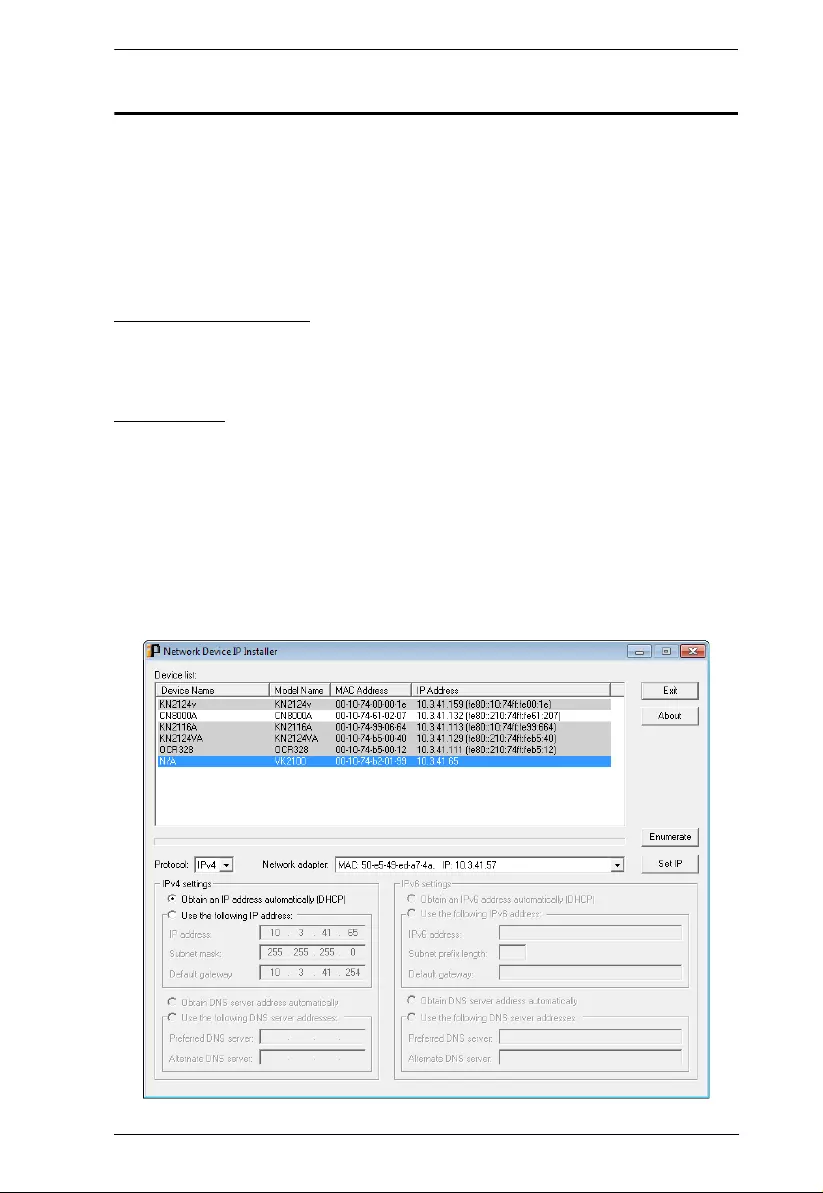
Appendix
267
IP Address Determination
If you are an administrator logging in for the first time, you need to access the
KVM over IP switch in order to give it an IP address that users can connect to.
There are three methods to choose from. In each case, your client computer
must be on the same net w ork segment as the KVM over IP switch. After you
have connected and logged in you can give the KVM over IP switch its fixed
network address. (See Network, page 169.)
The Local Console
The easiest way to assign an IP address is from the local console. Refer to First
Time Setup, page 41, for details on the procedure involved.
IP Installer
For client computers running Windows, an IP address can be assigned with the
IP Installer utility. The utility can be obtained from the Download area of our
website. Look under Driver/SW, and the model of your switch. After
downloading the utility to your client computer, do the following:
1. Unzip the contents of IPInstaller.zip to a directory on your hard drive.
2. Go to the directory that you unzipped the IPInstaller program to and run
IPInstaller.exe. A dialog box similar to the one below appears:

KVM over IP Switch User Manual
268
3. Select the KVM over IP switch in the Device List.
Note: 1. If the list is empty, or your device doesn't appear, click
Enumerate to refresh the Device List.
2. If there is more than one device in the list, use the MAC address
to pick the one you want. The KVM over IP switch’s MAC
address is located on its bottom panel.
4. Select either Obtain an IP address automatically (DHCP), or Specify an
IP address. If you chose the latter, fill the IP Address, Subnet Mask, and
Gateway fields with the information appropriate to your network.
5. Click Set IP.
6. After the IP address show s up in the Devi ce List, click Exit. See IP
Installer, page 170 for more information.
Browser
1. Set your client comput er's IP address to 192.168.0.XXX
Where XXX represents any number or numbers except 60. (192.168.0.60 is
the default address of the KVM over IP switch.)
2. Specify the switch's default IP address (192.168.0.60) in your browser , and
you will be able to connect.
3. Assign a fixed IP address for the KVM over IP switch that is suitable for
the network segment that it resides on.
4. After you log out , reset your client computer's IP address to its original
value.

Appendix
269
IPv6
At present, the KVM over IP switch supports three IPv6 address proto cols:
Link Local IPv6 Address, IPv6 Stateless Autoconfiguration, and Stateful
Autoconfiguration (DHCPv6).
Link Local IPv6 Address
At power on, the KVM over IP switch is automatically configured with a Link
Local IPv6 Address (for example, fe80::210:74ff:fe61:1 e f). To find out what
the Link Local IPv6 Address is, log in with the KVM over IP switch’s IPv4
address and open the Device Management Device Information page. The
address is displayed in the General list box (see page 166).
Once you have determined what the IPv6 address is, you can use it when
logging in from a browser or the Win and Java Client AP programs.
For example:
If you are logging in from a browser, you would key in
http://[fe80::2001:74ff:fe6e:59%5]
for the URL bar.
If you are logging in with the AP program, you would key:
fe80::2001:74ff:fe6e:59%5
for the IP field of the Server panel (see Windows Client AP Login, page 49).
Note: 1. To log in with the Link Local IPv6 Address, the client computer must
be on the same local network segment as the KVM over IP switch
2. The %5 is the %interface used by the client computer. To see your
client computer’s IPv6 address: from the command line issue the
following command: ipconfig /all. The % value appears at the
end of the IPv6 address.

KVM over IP Switch User Manual
270
IPv6 Stateless Autoconfiguration
If the KVM over IP switch’s network environment contains a device (such as
a router) that supports the IPv6 Stateless Autoconfiguration function, the KVM
over IP switch can obtain its prefix information from that dev ice in order to
generate its IPv6 address. For example, 2001::74ff:fe6e:59.
As above, the address is displayed in the General list box of the Device
Management Device Information page (see page 166).
Once you have determined what the IPv6 address is, you can use it when
logging in from a browser or the Win and Java Clien t AP program s.
For example:
If you are logging in from a bro wser, you would key in
http://[2001::74ff:fe6e:59]
for the URL bar.
If you are logging in with the AP program , you w ould ke y:
2001::74ff:fe6e:59
for the IP field of the Server panel (see Windows Client AP Login, page 49).

Appendix
271
Port Forwarding
For devices located behi nd a router, port forwarding allows the ro uter to pass
data coming in over a specific port to a specific device. By setting the port
forwarding parameters, you tell the router which device to sen d the data th at
comes in over a particular port to.
For example, if the KVM over IP switch connected to a particular router has an
IP address of 192.168.1.180, you would log into your router’s setup program
and access the Port Forwarding (sometimes referred to as Virtual Server)
configuration page. You would then specify 192.168.1.1 80 for the IP address
and the port number you want opened for it (9000 for Internet access, for
example).
Since configuration setup can vary somewhat for each brand of router, refer to
the router’s User Manual for specific information on configuring port
forwarding for it.

KVM over IP Switch User Manual
272
Keyboard Emulation
Mac Keyboard
The PC compatible (101/104 key) keyboard can emul ate the fu nctions of the
Mac keyboard. The emulation mappings are listed in the table below.
Note: When using key combinations, press and release the first key (Ctrl),
then press and release the activation key.
PC Keyboard Mac Keyboard
[Shift] Shift
[Ctrl] Ctrl
[Ctrl] [1]
[Ctrl] [2]
[Ctrl] [3]
[Ctrl] [4]
[Alt] Alt
[Print Screen] F13
[Scroll Lock] F14
=
[Enter] Return
[Backspace] Delete
[Insert] Help
[Ctrl] F15

Appendix
273
Sun Keyboard
The PC compatible (101/104 key) keyboard can emulate the functions of the
Sun keyboard when the Control ke y [Ctrl] is used in conjunction with other
keys. The corresponding functions are shown in the table below.
Note: When using key combinations, press and release the first key (Ctrl),
then press and release the activation key.
PC Keyboard Sun Keyboard
[Ctrl] [T] Stop
[Ctrl] [F2] Again
[Ctrl] [F3] Props
[Ctrl] [F4] Undo
[Ctrl] [F5] Front
[Ctrl] [F6] Copy
[Ctrl] [F7] Open
[Ctrl] [F8] Paste
[Ctrl] [F9] Find
[Ctrl] [F10] Cut
[Ctrl] [1]
[Ctrl] [2]
[Ctrl] [3]
[Ctrl] [4]
[Ctrl] [H] Help
Compose
Meta
-
+
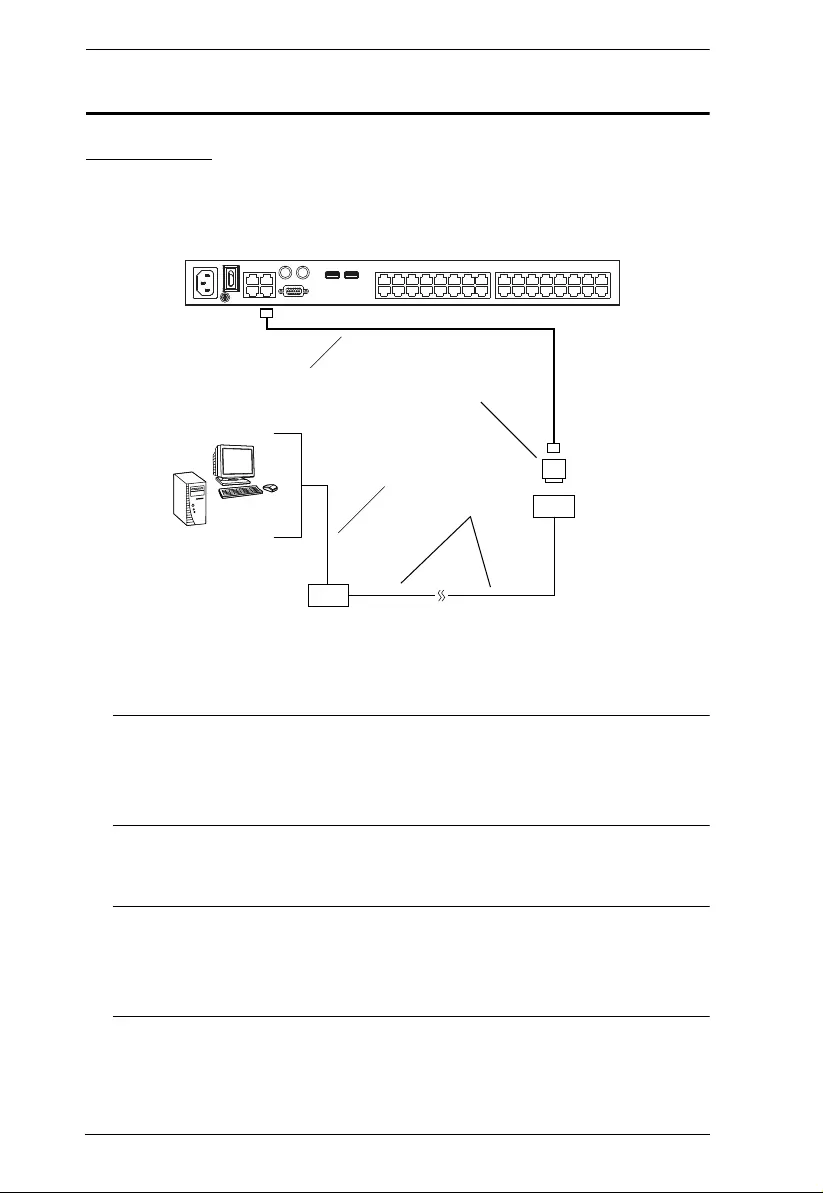
KVM over IP Switch User Manual
274
PPP Modem Operation
Basic Setup
The KVM over IP switch can be accessed through its RS-232 port using a PPP
dial-in connection, as follows:
1. Set up your hardware configuration to match the diagram, below:
:
2. From your client compu ter, use your modem dial-in program to dial into
the KVM over IP switch’s modem.
Note: 1. If you don’t know the KVM over IP switch modem’s serial
parameters, get them from th e KVM over IP admini strator.
2. An example of setting up a modem dial-in program under
Windows XP is provided on the next page.
3. Once the connection is established , open your browser, and specify
192.168.192.1 in the URL box.
Note: 1. The default username and password are blank.
2. For the modem session, the KVM over IP switch has an IP
address of 192.168.192.1; the user side has an IP address of
192.168.192.101.
From here, operation is the same as if you had logged in from a browser or with
the AP programs.
Remote
Operator
Modem
Modem
Phone Line
Serial Modem Cable
Cat 5e Cable SA0142
(DB9-M, DTE - DCE)

Appendix
275
Connection Setup Example (Windows XP)
To set up a dial-in connection to the KVM over IP switch under Windows XP,
do the following:
1. From the Start menu, select Control Panel Network Connections
Create a New Connection.
2. When the Welcome to the New Connection Wizard dialog box appears,
click Next to move on.
3. In the Network Connection Type dialog box, select Connect to the network
at my workplace, then click Next.
4. In the Network Conn ection dialog box, select Dial-up connection, then
click Next.
5. In the Connection Name dialog box, key in a name for the connection (for
example, TPE-KN8132-01), then click Next.
6. In the Connection Availability dialo g box, you can select eit her Anyone’s
use or My use only, depending on your preferences, then click Next.
Note: If you are the only user on this client computer, this dialog box won’t
appear.
7. In the Phone Number to dial dialog box, key in the phone number of the
modem connected to the KVM over IP switch (be sure to include country
and area codes, if necessary), then click Next.
8. In the Compl e tin g the New Connection Wizard dialog box, check Add a
shortcut to this connection on my desktop, then click Finish.
This completes the connection setup. Double click the desktop shortcut icon to
make a PPP connection to the KVM over IP switch.
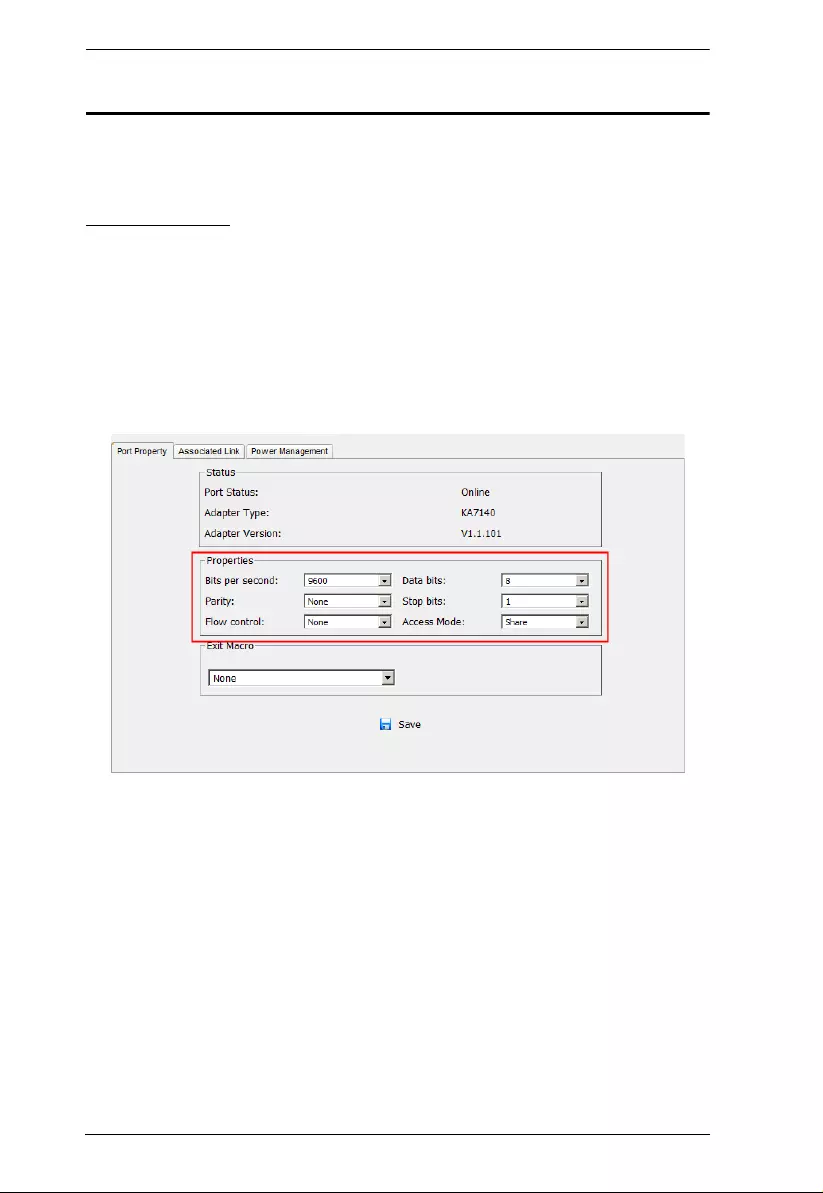
KVM over IP Switch User Manual
276
KA7140 Configuration and Operation
The KA7140 Adapter Cable connects a serial device to the KVM over IP
switch.
Configuration
To configure the KA7140 to interact with the connected device, you need to set
its serial parameters to match the parameters of the device, as follows:
1. In the Port Access page Sidebar, select the port that the KA7140 is
connected to.
2. Select Port Configuration on the menu bar.
The page comes up with the Port Properties tab selected:

Appendix
277
3. In the Properties section, drop down each of the lists to select the port
property values that match the ones used by the connected serial console
device. The port property settings that the KA7140 supports are given in
the following table:
4. When you have finished making your selections, click Save.
Operation
To operate the device connected to the port, in the Port Access page double
click the port to establish a serial connection to the device.
Setting Meaning
Bits per second
(Baud Rate) This sets the port’s data transfer speed. Choices are from
300—38400 (drop down the list to see them all). Set this to
match the baud rate setting of the serial console device.
Default is 9600 (which is a basic setting for many serial console
devices).
Data Bits This sets the number of bits used to transmit one character of
data. Choices are: 7 and 8. Set this to match the data bit setting
of the serial console device. Default is 8 (which is the default for
the majority of serial console devices).
Parity This bit checks the integrity of the transmitted data. Choices
are: None; Odd; Even. Set this to match the parity setting of the
serial console device. Default is Odd.
S top Bits This indicates that a character has been transmitted. Set this to
match the stop bit setting of the serial console device. Choices
are: 1 and 2. Default is 1 (which is the default for the majority of
serial console devices).
Flow Control This allows you to choose how the data flow will be controlled.
Choices are: None, Hardware, and XON/XOFF. Set this to
match the flow control setting of the serial console device.
Default is None.
Note: None is only supported for baud rates of 9600 and lower .
For baud rates greater than 9600, you must choose Hardware
or XON/XOFF.
Access Mode This allows you to set the serial console device’s access mode.
Choices are: Share, Occupy, and Exclusive. Default is Share.
See Access Mode, page 137 for information regarding this
function.
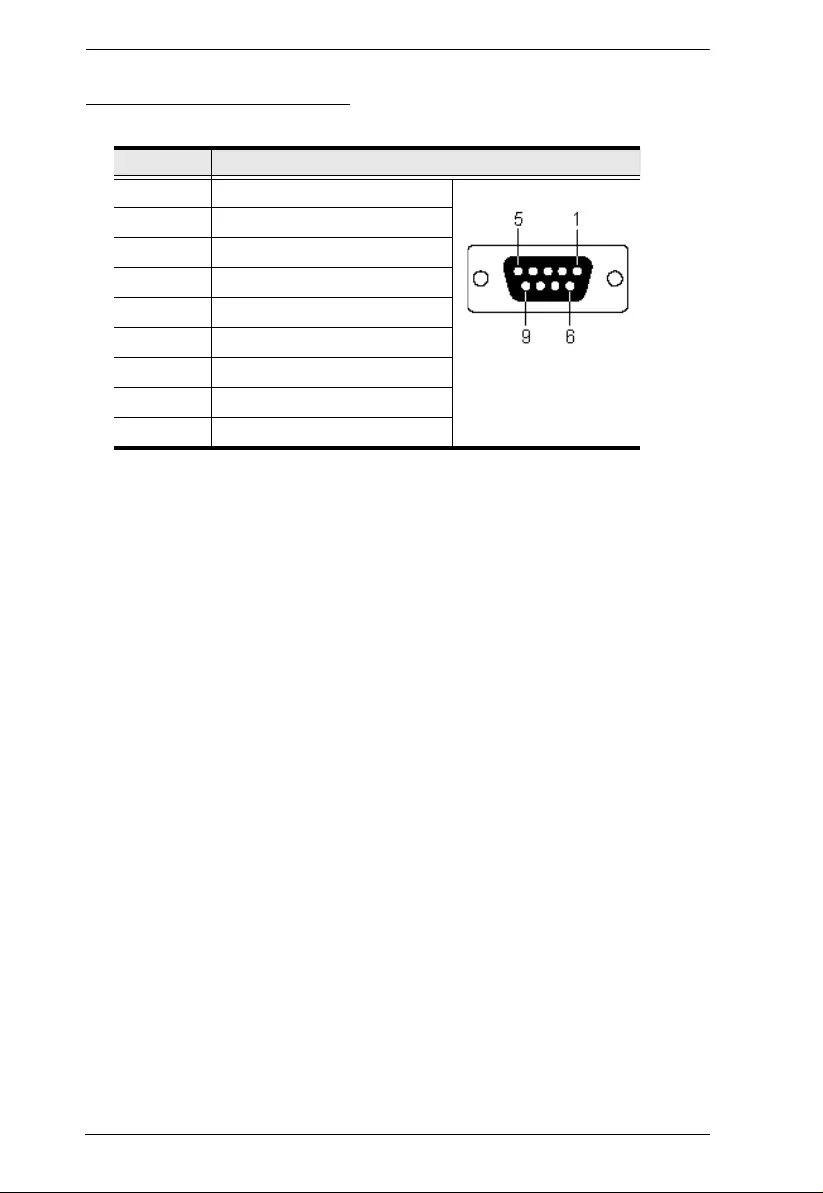
KVM over IP Switch User Manual
278
KA7140 Pin Assignments
Pin assignments for the KA7140 Adapter are given in the table, below:
Pin Assignment
1DCD
DB9 Female
2RXD
3TXD
4DTR
5GND
6DSR
7RTS
8CTS
9N/A
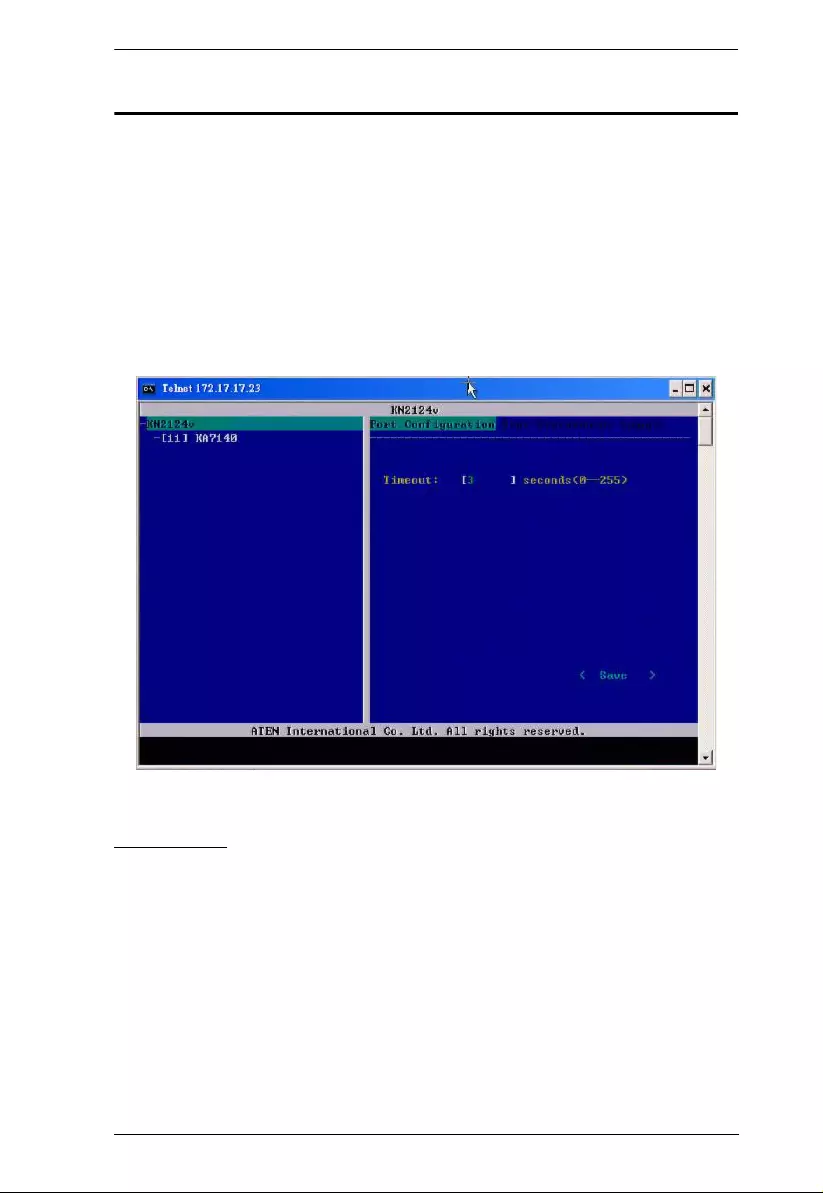
Appendix
279
Internal Serial Interface Configuration
The KVM over IP switch provides a functio n that let s you configure an
attached device’s serial interface parameters from within any accessed server.
To do so:
1. From the accessed server , open a command line (terminal) session or third
party serial application such as HypterTerminal or PuTTY.
2. Telnet or SSH to the KVM over IP switch’s IP address.
3. Log in with your usual Username and Password to bring up the access
screen:
Navigation
The left panel shows the KVM over IP switch at the top, and all the serial
interface devices connected to it listed below. The right panel shows the
configuration parameters at the top, with the configuration settings in the area
below.
Use the Left and Right Arrow keys ( and ) to move the highlight bar
between the right and left panels, and to select the parameter to configure.
Use the Up and Down Arrow Keys ( and ) to select among the switch
and the serial devices in the left panel; use them to select the configuration
items in the right panel.

KVM over IP Switch User Manual
280
Operation
Use the Up and Down Arrow Keys ( and ) to highlight a device in the
left panel, then press [Enter] to open a command line (terminal) session on
the accessed device.
When you have finished with your session, press the hotkey (see page 280
and 281) that brings you back to the access page.
To finish with this function, move the highlight bar to Logout in the right
panel of the access page; Press the Down Arrow key to highlight Exit, then
press [Enter].
Switch Level Configuration
The right panel configuration settings that can be made when the KVM over IP
switch is selected in the left panel are described in the tab le, below:
Setting Description
Port Configuration When Port Configuration is selected, press the Down
Arrow key to highlight the current timeout figure. Key in a
new timeout figure to overwrite the current one.
Note: There is no way to erase the figure you key in. If
you want to change it, use the Up Arrow key to leave the
field, then, use Down Arrow to come back to it. After you
come back, key in the new figure.
When you have finished, use Down Arrow to highlight
Save, then press [Enter].
User Preferences User Preferences lets you set a hotkey that brings you
back to the access screen from the session you are
working in.
When User Preferences is selected, press the Down
Arrow key to highlight the current hotkey letter . Key in the
new letter to overwrite the current one.
When you have finished, use Down Arrow to highlight
Save, then press [Enter].
Logout When Logout is selected, press the Down Arrow key to
highlight Exit, then press [Enter].
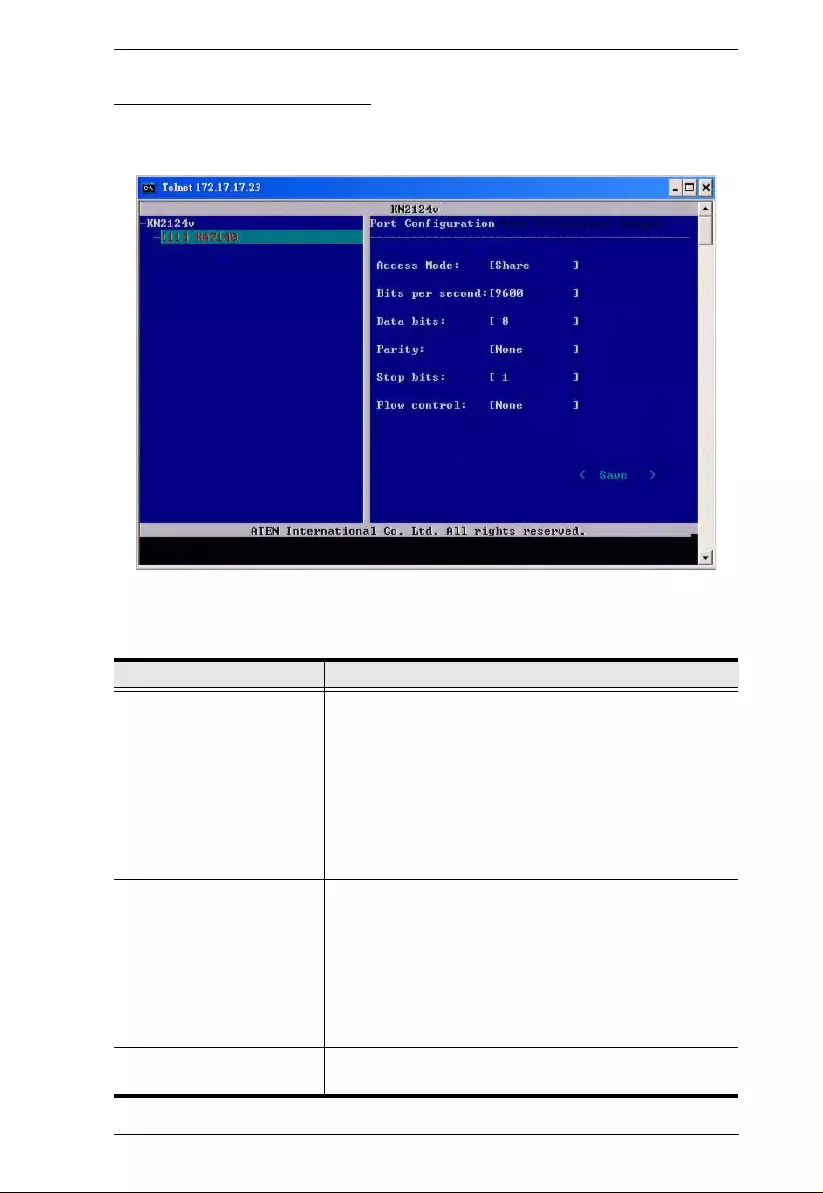
Appendix
281
Port Level Configuration
When a serial interface device is selected in the left panel, The screen looks
similar to the one below:
The configuration settings that can be made when a serial interface device is
selected are described in the table, below:
Setting Description
Port Configuration To configure the serial parameters:
1. Use the Up and Down Arrow keys to highlight the tar-
get item.
2. Press [Enter] to bring up the list of choices.
3. Use the Up and Down Arrow keys to highlight your
choice, then press [Enter].
When you have finished, press the Down Arrow key to
highlight Save, then press [Enter].
User Preferences User Preferences lets you set a hotkey that brings you
back to the access screen from the session you are
working in.
When User Preferences is selected, press the Down
Arrow key to highlight the current hotkey letter . Key in the
new letter to overwrite the current one.
When you have finished, use Down Arrow to highlight
Save, then press [Enter].
Logout When Logout is selected, press the Down Arrow key to
highlight Exit, then press [Enter].
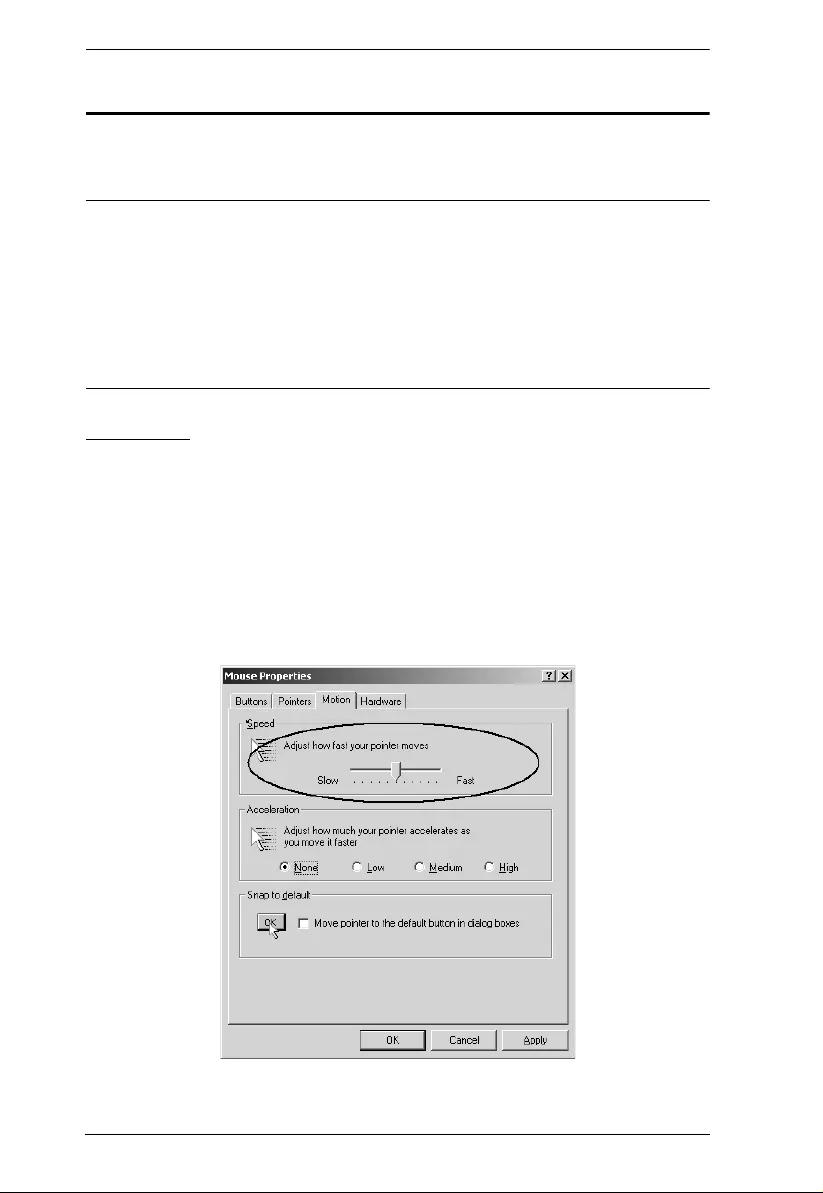
KVM over IP Switch User Manual
282
Additional Mouse Synchronization Procedures
If you use Manual Mouse Synchronization, you should perform the following
operations on the servers that connect to the switch.
Note: 1. These procedures are to be performed on the servers attached to the
switch’s ports - not on the client computer you are using to access the
KVM over IP switch.
2. In order for the local and remot e mice to synch ron ize, you must use
the generic mouse driver supplied with the Window s operating
system. If you have a third party driver installed - such as one
supplied by the mouse manufacturer - you must remove it.
Windows:
1. W indows 2000:
a) Open the Mouse Properties dialog box (Control Panel Mouse
Mouse Properties)
b) Click the Motion tab
c) Set the mouse speed to the middle position (6 units in from the left)
d) Set the mouse acceleration to None
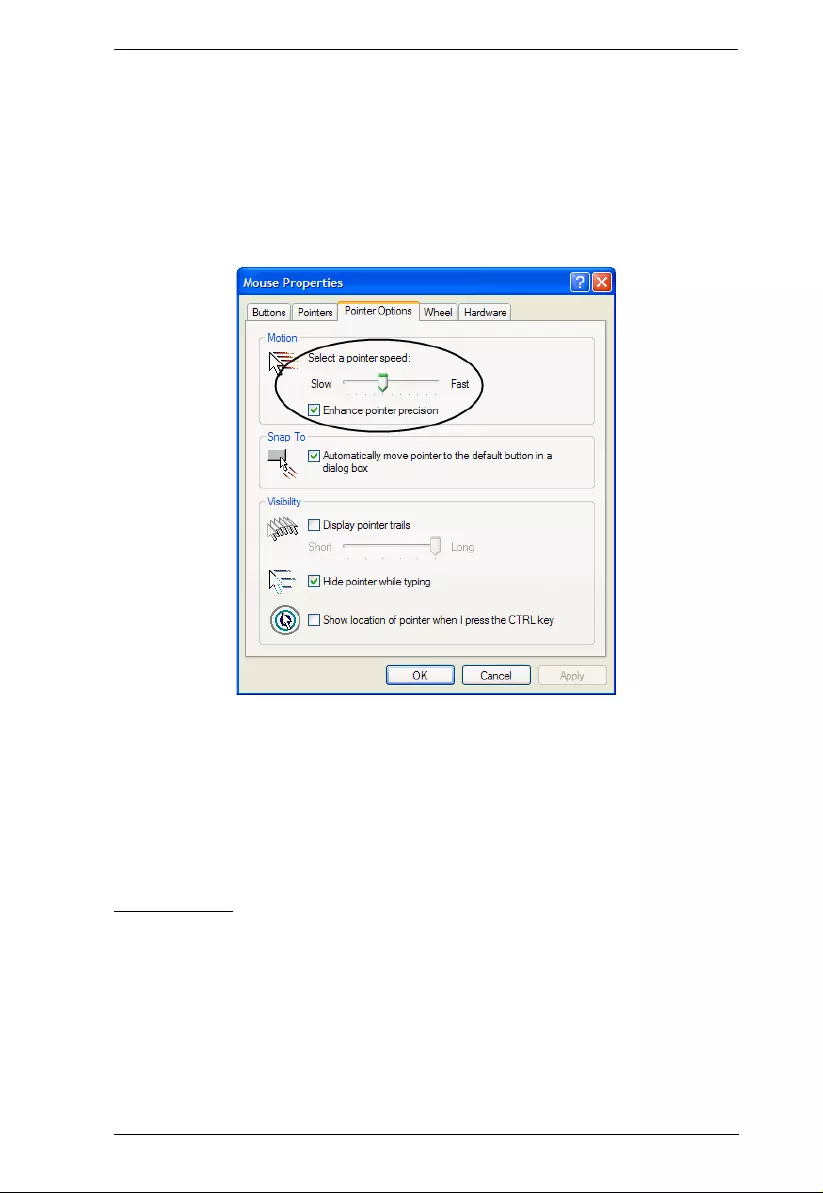
Appendix
283
2. Windows XP / Windows Server 2003:
a) Open the Mouse Properties dialog box (Control Panel Mouse)
b) Click the Pointer Options tab
c) Set the mouse speed to the middle position (6 un its in from the left)
d) Disable Enhance Pointer Precision
3. Windows ME:
Set the mouse speed to the middle position; disable mouse acceleration
(click Advanced to get the dialog box for this).
4. Windows NT / Windows 98 / Windows 95:
Set the mouse speed to the slowest posi tion.
Sun / Linux
Open a terminal session and issue the following command:
Sun: xset m 1
Linux: xset m 0
or
xset m 1
(If one doesn’t help, try the other.)
Linux using the Redhat AS3.0 mouse mode: xset m 1
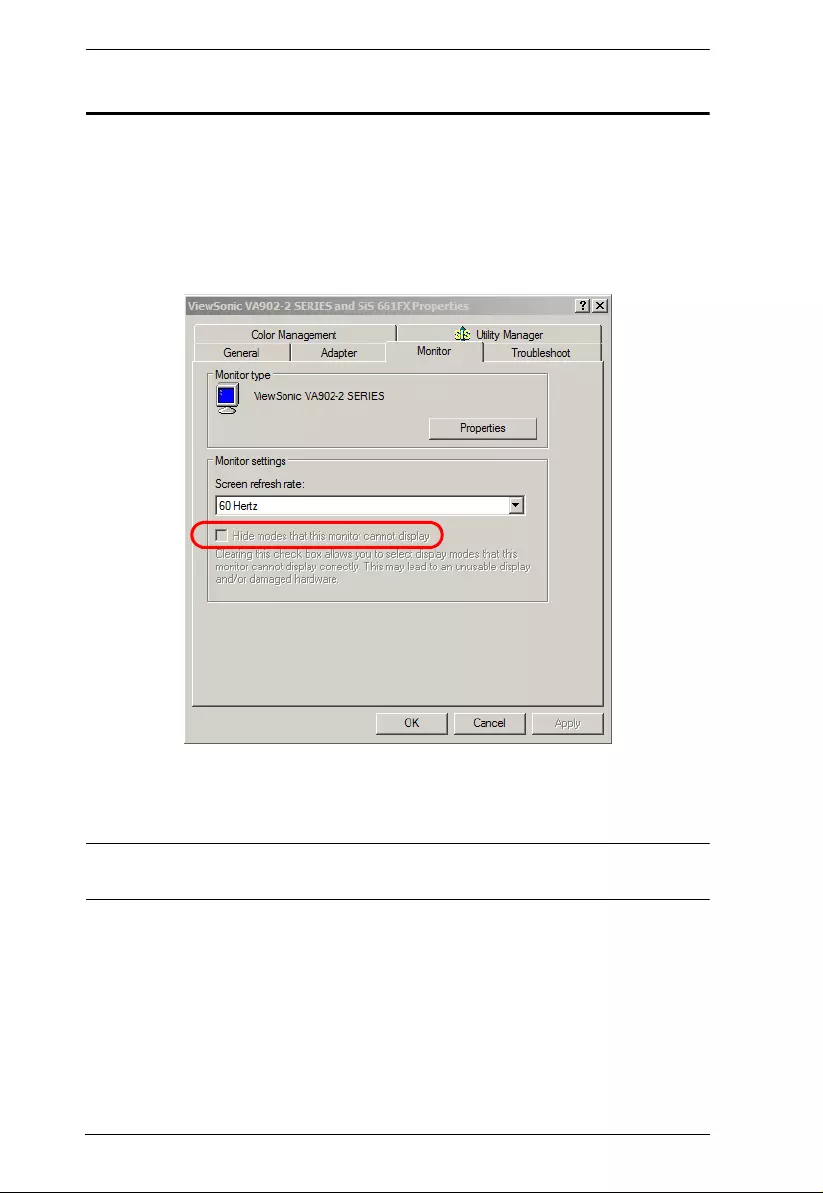
KVM over IP Switch User Manual
284
Additional Video Resolution Procedures
If you are running Windows, and wish to use new refresh rates, do the
following:
1. Open Control Panel Display Settings Advanced Monitor.
2. In the dialog box th at comes up, make sure that the Hide modes that this
monitor cannot display checkbox is unchecked.
3. Click the arrow at the right of the Screen refresh rate listbox, and select
the refresh rate you want from the list that appears.
Note: Make sure that your monitor supports the refresh rate you choose – if
not, you may seriously damage your monitor.
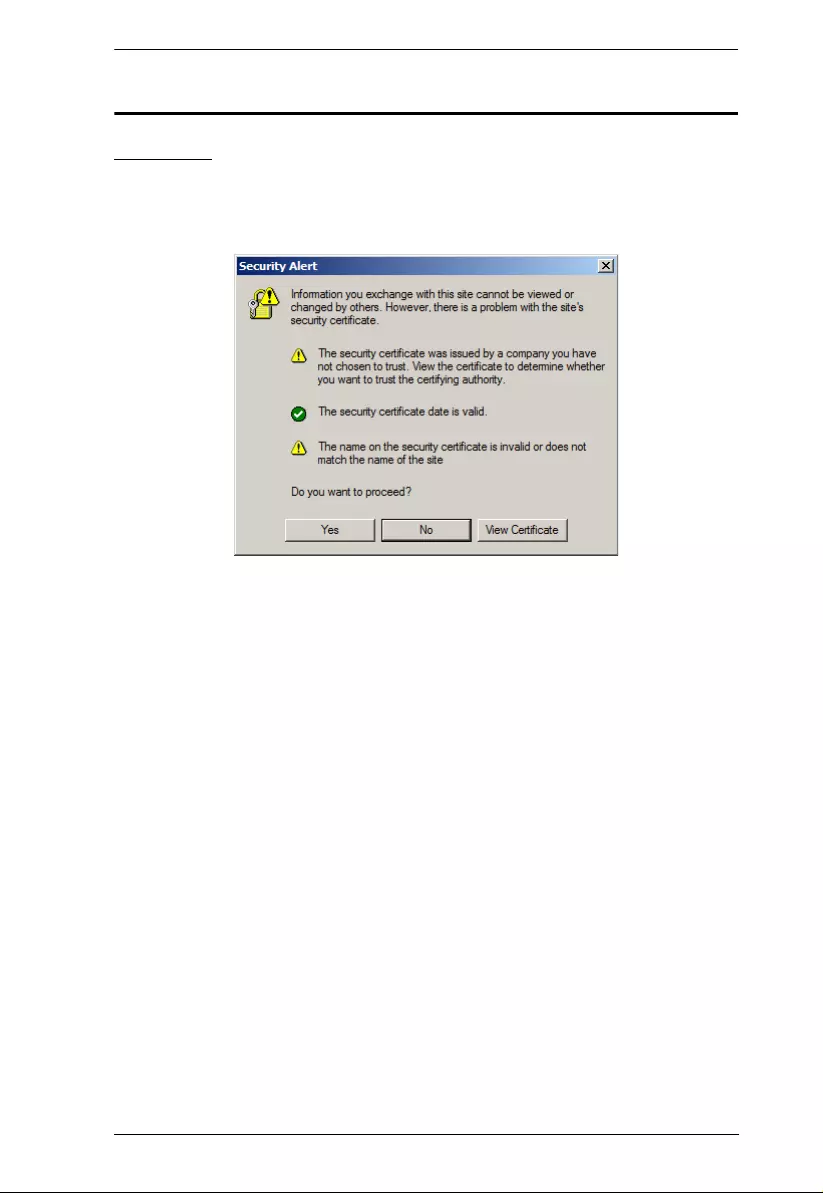
Appendix
285
Trusted Certificates
Overview
When you try to log in to the device from your bro wser, a Security Al ert
message appears to inform you that the device’s certificate is not trusted, and
asks if you want to proceed.
The certificate can be trusted, but the alert is triggered because the certificate’s
name is not found on Microsoft list of Trusted Authorities. You have two
options: 1) you can ignore the warning and click Yes to go on; or 2) you can
install the certificate and have it be recognized as trusted.
If you are working on a client computer at another location, accept the
certificate for just this session by clicking Yes.
If you are working at your own client computer, install the certificate on
your client computer (see below for details). After the certificate is
installed, it will be recognized as truste d.
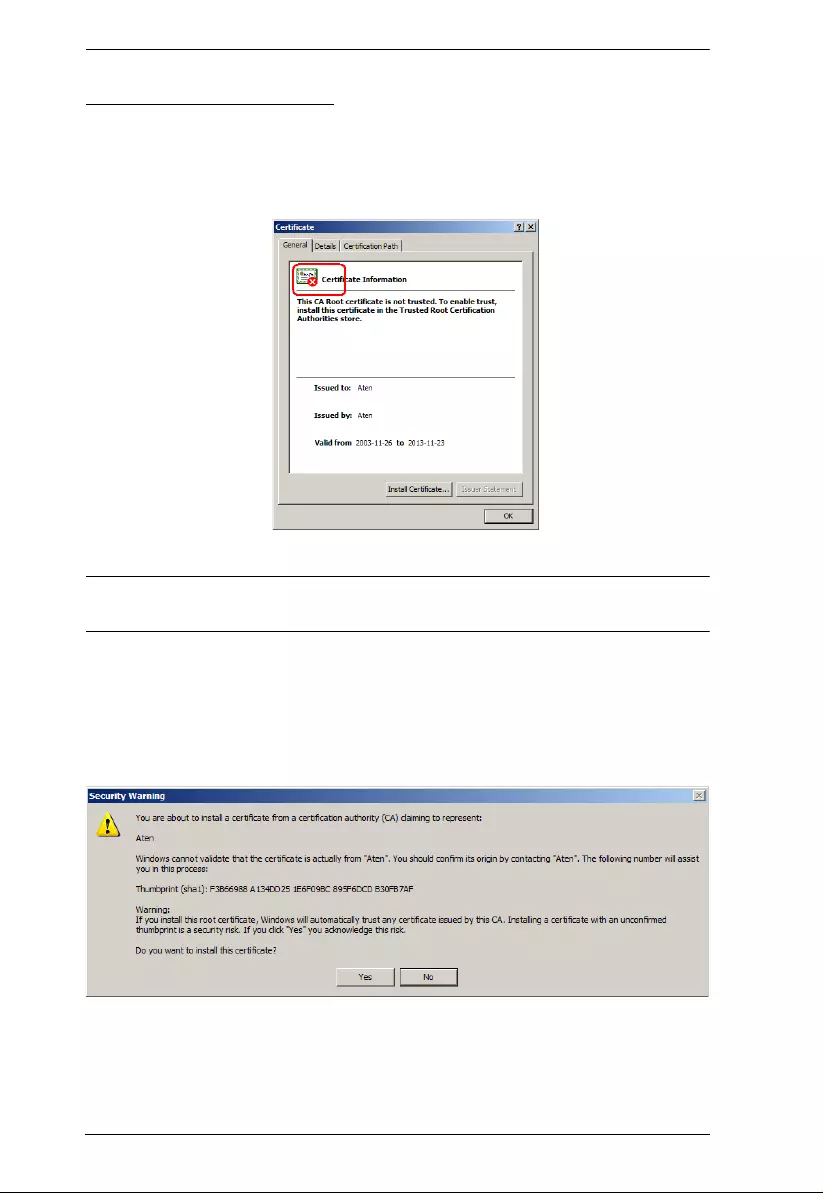
KVM over IP Switch User Manual
286
Installing the Certificate
To install the certificate, do the following:
1. In the Security Alert dialog box, click View Certificate. The Certificate
Information dialog box appears:
Note: There is a red and white X logo over the certifica te to indicate that it is
not trusted.
2. Click Install Certificate.
3. Follow the Instal lation Wizard to complete the installati on. Unless you
have a specific reason to choose otherwise, accept the default options.
4. When the Wizard presents a caution screen, click Yes.:
5. Click Finish to complete the installation; then click OK to close the dialog
box.
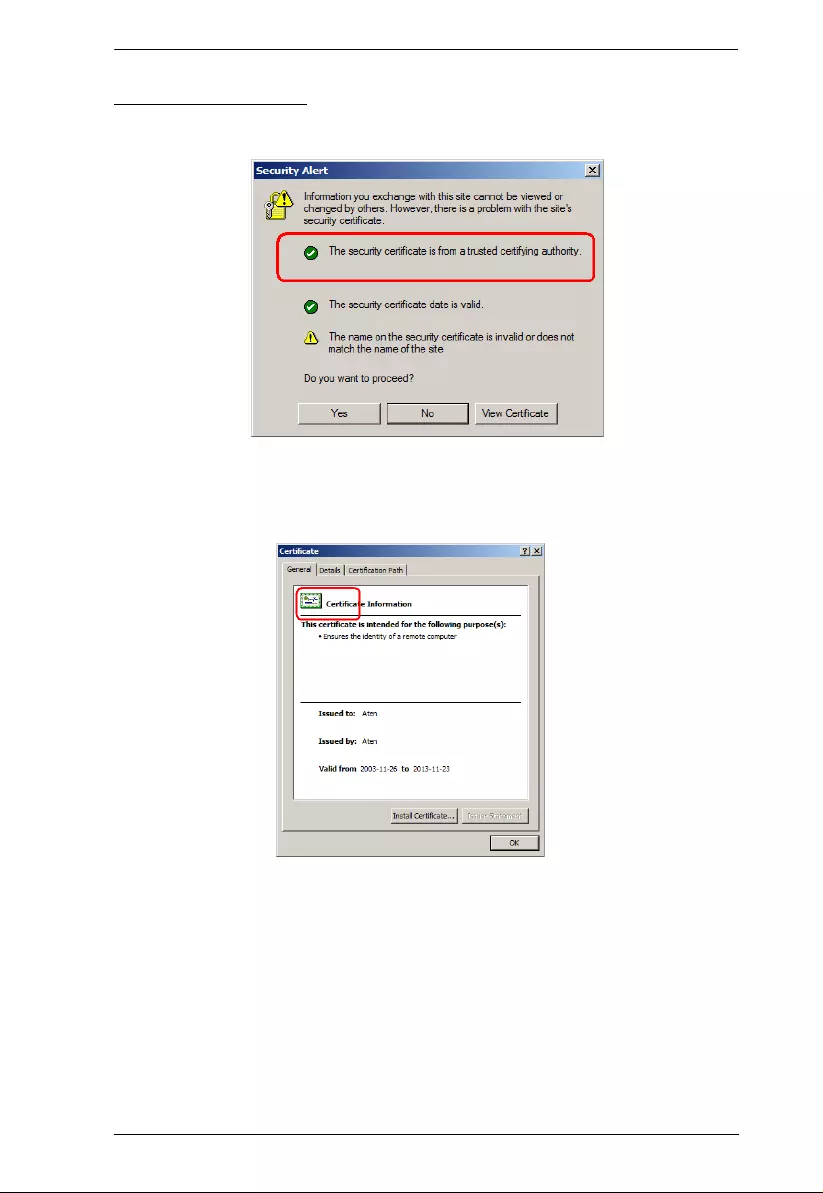
Appendix
287
Certificate Trusted
The certificate is now trusted:
When you click View Certificate, you can see that the red and white X logo is
no longer present – further indication that the certificate is trusted:
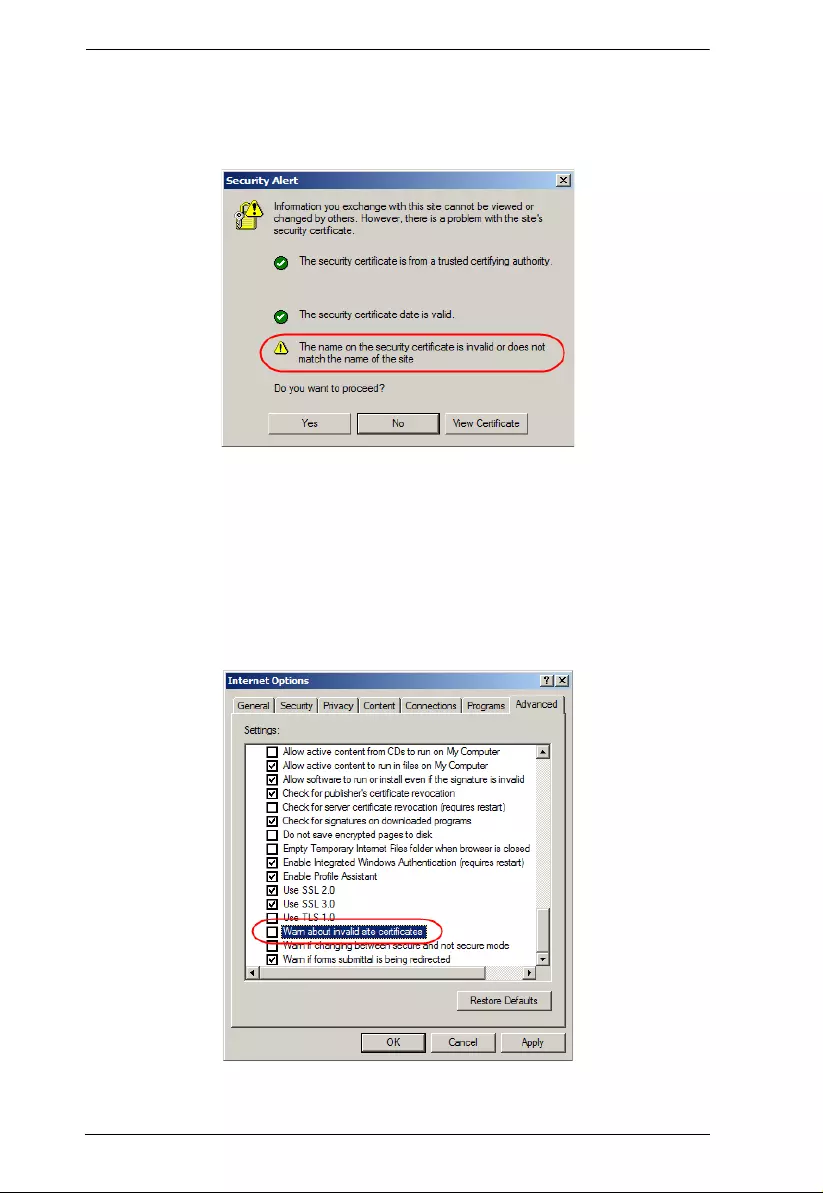
KVM over IP Switch User Manual
288
Mismatch Considerations
If the site name or IP address used for generating the certificate no longer
matches the current address of the switch a mismatch warning occurs:
You can click Yes to go on, or you can disable mismatch checking.
To disable mismatch checking, do the followi ng:
1. After the pag e you are logging in to comes up open the browser’s Tools
menu; Select Internet Options Advanced.
2. Scroll to the bottom of the list and uncheck Warn about trusted
certificates:
3. Click OK. The next time you run the browser the change will be in effect.

Appendix
289
Self-Signed Private Certificates
If you wish to create your own self-signed encryption key and certificate, a free
utility – openssl.exe – is available for download over the web at
www.openssl.org. To create your private key and certificate do the following:
1. Go to the directory where you downloaded and extracted openssl.exe to.
2. Run openssl.exe with the following parameters:
openssl req -new -newkey rsa:1024 -days 3653 -nodes -x509
-keyout CA.key -out CA.cer -config openssl.cnf
Note: 1. The command should be entered all on one line (i.e., do not press
[Enter] until all the parameters have been keyed in).
2. If there are spaces in the input, surround the entry in quotes (e.g.,
“ATEN International”).
To avoid having to input information during key generation the following
additional parameters can be used:
/C /ST /L /O /OU /CN /emailAddress.
Examples
openssl req -new -newkey rsa:1024 -days 3653 -nodes -x509
-keyout CA.key -out CA.cer -config openssl.cnf -subj
/C=yourcountry/ST=yourstateorprovince/L=yourlocationor
city/O=yourorganiztion/OU=yourorganizationalunit/
CN=yourcommonname/emailAddress=name@yourcompany.com
openssl req -new -newkey rsa:1024 -days 3653 -nodes -x509
-keyout CA.key -out CA.cer -config openssl.cnf -subj
/C=CA/ST=BC/L=Richmond/O="ATEN International"/OU=ATEN
/CN=ATEN/emailAddress=eservice@aten.com.tw
Importing the Files
After the openssl .exe program complet es, two files – CA.key ( the private key)
and CA.cer (the self-signed SSL certificate) – are created in the directory that
you ran the program from. These are the files that you upload in the Private
Certificate panel of the Security page (see Security, page 186, and Private
Certificate, page 194).

KVM over IP Switch User Manual
290
Fan Location and Speed Information
Fan Location
The KVM over IP Switch has 3 fans that feed real-time fan speed information
to the WinClient / Java Client Device Managem e nt pag e .
KN2116VA / KN4116VA / KN2132VA / KN4132VA / KN8132V
KN4164V / KN8164V
The speed of each of the fans in the above image are shown on the Device
Information web page. See page 165 for detai ls.
1
2
3
1
2
3
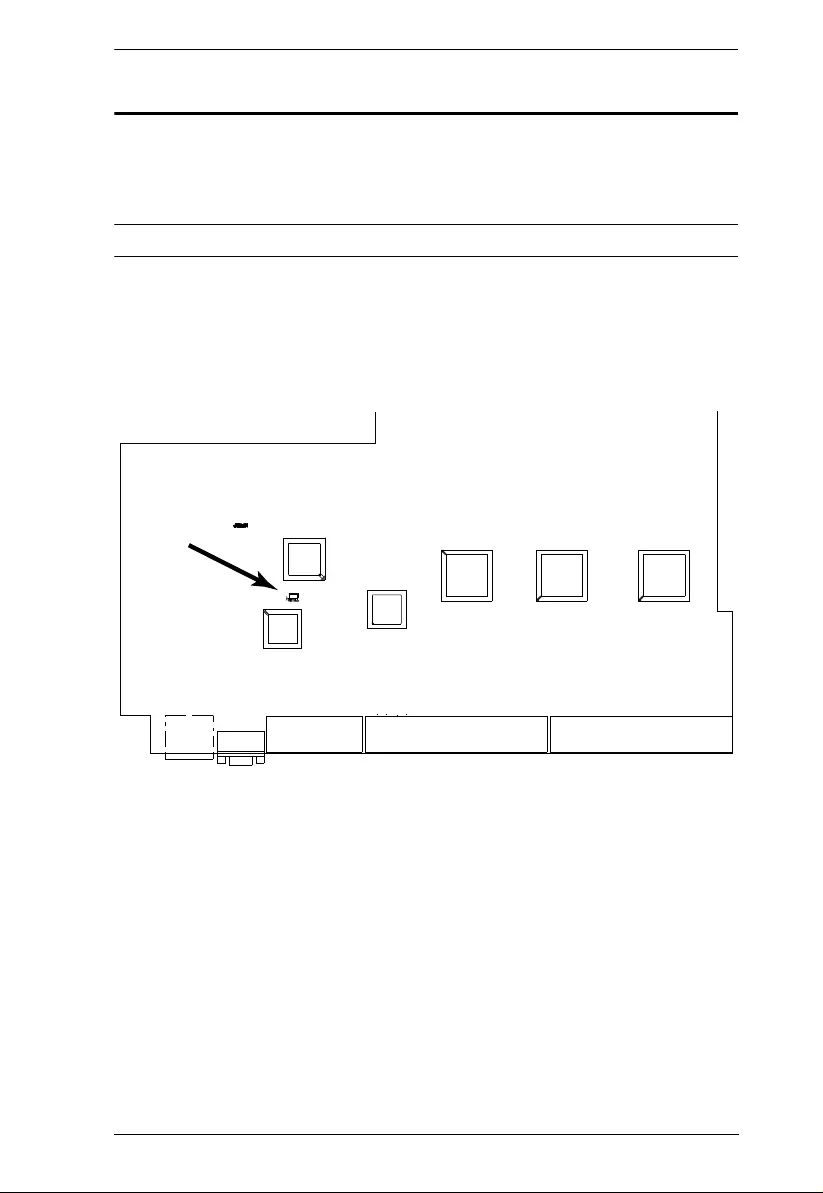
Appendix
291
Clear Login Information
If you are unable to perform an Administrator login (because the Username and
Password information has become corrupted or you have forgotten it, for
example) you can clear the login information with the following procedure.
Note: Performing this procedure also returns all settings to their defaults.
To clear the login information (and return all settings to their defaults), do the
following:
1. Power off the KVM over IP switch and remove its housing.
2. Use a jumper cap to short the mainboard ju mper labeled J25.
3. Power on the switch.
4. When the Link and 10/100Mbps LEDs flash, power off the switch.
5. Remove the jumper cap from J25.
6. Close the housing and start the KVM over IP switch.
After powering on the unit, you can use the default Super Administ rator
Username and Password (see First Time Setup, page 41), to log in.

KVM over IP Switch User Manual
292
Factory Default Settings
The default settings are as follows:
Serial Adapter Pin Assignments
SA0142: RJ45-F to DB9-M (Black Connector) DTE to DCE
Setting Default
Language English
GUI Hotkey [Scroll Lock] [Scroll Lock]
Port ID Display Port Number + Name
Port ID Display Duration 3 Seconds
Scan Duration 5 Seconds
Screen Blanker 0 Minutes (disabled)
Beeper On
Viewer Auto Detect
Welcome Message Hide
Accessible Ports Super Administrators – Full for all ports
All other users – None for all ports.
KVM over IP
(RJ45) Pins (8) Modem/Device
(DB9)
RTS 1 <————————> 7
DTR 2 <————————> 4
TXD 3 <————————> 3
CTS 4 <————————> 8
GND 5 <————————> 5
RXD 6 <————————> 2
DCD 7 <————————> 1
DSR 8 <————————> 6
9 NC not used

Appendix
293
Supported KVM Switches
The following is a list of fully supported KVM switches that can be used in a
cascaded installation:
KH1508A
KH1516A
CS1308
CS1316
CS9134
CS9138
Note: 1. Some of the KVM over IP switch’s features may not be supported,
depending on the functionality of the cascaded KVM switch. (For
example, some switches do not supp ort virtual media.)
2. The installation cannot be cascaded beyond the second level.
Supported Power Over the Net™ Units
The following is a list of supported Power Over the Net™ units that can be
connected to the KVM over IP switch:
PN0108
PN5212
PN5320
PN7212
PN7320
Supported Power Distribution Units
The following is a list of fully supported PDU devices that can be connected to
the KVM over IP switch:
PE8r Series
PE9r Series

KVM over IP Switch User Manual
294
Virtual Media Support
WinClient ActiveX Viewer / WinClient AP
IDE CDROM/DVD-ROM Drives – Read Only
IDE Hard Drives – Read Only
USB CDROM/DVD-ROM Drives – Read Only
USB Hard Drives – Read/Write*
USB Flash Drives – Read/Write*
USB Floppy Drives – Read/Write
Smart Card Readers – Read/Write (KA7166, KA7168, KA7169, KA7177
Adapter Cable only)
*These drives can be mounted either as a Drive or as a Removable Disk
(see Virtual Media, page 86). Removable disks allow the user to boot the
remote server if the disk contains a bootable OS. In addition, if the disk
contains more than one partition, the remote server can access all the
partitions.
ISO Files – Read Only
Folders – Read/Write
Java Client Viewer / Java Client AP
ISO Files – Read Only
Folders – Read/Write

Appendix
295
Limited Warranty
ALTUSEN warrants this product against defects in material or workmanshi p for a period of one
(1) year from the date of purchase. If this product proves to be defective, contact ALTUSEN's
support department for repair or replacement of your unit. ALTUSEN will not issue a refund.
Return requests can not be processed without the original proof of purchase.
When returning the produ ct, you must ship the pr oduct in its original packagin g or packaging that
gives an equal degree of protection. Include your proof of purch ase in the packaging and the RMA
number clearly marked on the outside of the package.
This warranty becomes invalid if the factory-supplied serial number has been removed or altered
on the product.
This warranty does not cover cosmetic damage or damage due to acts of God, accident, misuse,
abuse, negligence or modification of any part o f the product. This warranty does not cover damage
due to improper operation or maintenance, connection to improper equipment, or attempted repair
by anyone other than ALTUSEN. This warr an t y does not cover products sold AS IS or WITH
FAULTS.
IN NO EVENT SHALL ALTU SEN'S LIAB ILITY EXCEED THE PRICE PA ID FOR THE
PRODUCT. FURTHER, ALTUSEN SHALL NOT BE RESPONSIBLE FOR DIRECT,
INDIRECT, SPECIAL, INCIDENTAL OR CONSEQUENTIAL DAMAGES RESULTING
FROM THE USE OF THE PRODUCT, ITS ACCOMPANYING SOFTWARE, OR ITS
DOCUMENTATION. ALTUSEN SHALL NOT IN ANY WAY BE RESPONSIBLE FOR,
WITHOUT LIMITATION, LOSS OF DATA, LOSS OF PROFITS, DOWNTIME, GOODWILL,
DAMAGE OR REPLACEMENT OF EQUIPMENT OR PROPERTY, AND ANY EXPENSES
FROM RECOVERY, PROGRAMMING, AND REPRODUCTION OF ANY PROGRAM OR
DATA.
ALTUSEN makes no warranty or representation, expressed, implied, or statutory with respect to
its products, contents or use of this documentation and all accompanying software, and specifically
disclaims its quality, performance, merchantability, or fitness for any particular purpose.
ALTUSEN reserves the right to revise or update its product, software or documentation without
obligation to notify any individual or entity of such revisions, or update.
For details about extended warranties, please contact one of our dedicated value added resellers.
